

The 20 best things to do in Munich, Germany
A local’s list of the top tourist attractions, highlights, and things to do in munich..
Are you planning a trip to Bavaria’s capital? And now you are wondering about the best things to do in Munich? What to see and what to skip?
Well, then I got you covered. I have been living in Munich for the past 20 years and I love exploring my hometown. So, in this guide, I am going to show you the absolute must-sees and top tourist attractions . But I also mixed in some insider tips along the way so you get a memorable experience beyond the beaten tourist tracks, so you can plan your perfect Munich itinerary (<- click to read mine)

Munich has a history of more than 800 years and is now the third-largest city in Germany. It’s also the most affluent region of my country, which sadly means you’ll face higher prices than in Berlin or Cologne. But let that not deter you – there are plenty of bargains to be had and I’m going to reveal some of them to you in this travel guide.

You will probably need around 3-4 days to see it all. There are some beautiful day trip options from Munich , so you could basically stay a week or more. But I also prepared a one day Munich itinerary , for those in a hurry. Anyways, let’s get started with my favorite Munich highlights, shall we?
1. Marienplatz

Start your Munich tour at the heart of the city. The Marienplatz (Square of our Lady) with its imposing neo-gothic city hall (“ Neues Rathaus “) is one of the best photography spots in the city . Every day at 11 a.m. and 5 p.m. the gigantic carillon comes to life. The Munich Glockenspiel is the largest in Germany and you’ll find the square particularly crowded around these times (for a reason).
You’ll find many traditional restaurants and shops around the Marienplatz, but it’s not exactly the place where locals hang out or enjoy their dinner (but you might enjoy the Rathaus Keller right below the city hall for lunch). As it is also the start of the Munich pedestrian area , you should definitely consider walking all the way up to Stachus, as there are a couple of beautiful churches along the way and many shops to get a nice souvenir.
The station underneath Marienplatz is also quite famous. I listed it among the 10 most beautiful subway stations in Munich . So, if you are a fan of modern architecture, don’t miss it. You can read more about Marienplatz here .
Note: You can actually climb the tower of the city hall for a small fee of 4.00 euros per person. You’ll get the best view, however, from the Alter Peter church tower (see below). It’s featured in my list of the 20 best photo locations in Munich .
2. Munich Residence Palace

The Münchner Residenz has been the seat of the Bavarian kings, prince-electors, and dukes for almost 400 years. From the Renaissance to Neoclassicism, you’ll find nearly every style and epoche represented in one of the 130 staterooms you can visit on the extended tour. The magnificent Antiquarium and the Ancestor Gallery are probably the most popular parts.

I do have to warn you, however, that the Residence Palace is a true maze and you’ll need around 4 hours to see it all. Mind you, that is time well spent, as each and every flight of stairs brings you to another amazing apartment, festival hall, church or throne room. It’s easy to visit the fantastic Nibelung halls on the ground floor, but if you see the sign, definitely go downstairs and they will blow your mind! Check out my list of the 15 best castles near Munich for further inspiration.
Note: Definitely make sure to visit the outstanding Treasury on the ground floor where you can see the Bavarian crown jewels and other outstanding artwork made from gold, silver, and diamonds. It’s not covered by the standard ticket, but worth to pay the extra 5 Euros. Find more information here .
3. Church of Our Lady

The Frauenkirche is the symbol of Munich and you’ll basically find the cathedral on every postcard and brochure in my hometown. And you are lucky, 2020 is the first year the towers are free of scaffolding (after nearly 10 years of restoration work). It’s still not possible to climb them, though.
The cathedral is not only the biggest but also one of the oldest in town. It was consecrated in 1494 and remained virtually unchanged ever since – at least from outside. During World War II the church was hit by a bomb and much of the interiors got destroyed. But the bigger loss occurred 90 years older. Back then and all over Europe, it was popular to purify the baroque churches and bring them back to a “virgin” (neo-)gothic state. What you see inside now is largely a reconstruction from the 1980ies (using historic original parts).
4. Alte Pinakothek

Did you know? Munich is one of the top art metropoles on this planet. You’ll find almost 100 museums in and around Bavaria’s capital . Not all of them are world-renowned, but you definitely need to the Alte Pinakothek in Munich’s art quarter ( Kunstareal ; find a list of the best museums in Munich here ). It is Munich’s oldest museum and home to an outstanding collection of German, Italian and Flemish old masters.

So, expect pictures by Albrecht Dürrer, Leonardo Da Vinci, Raphael, Rembrandt, Rubens, and other master painters. They usually have a spectacular special exhibition on the ground floor worth checking out. So, definitely look it up on the official website before you visit. You’ll also find the New Pinakothek next door, but it will be closed until at least 2022 (which is the reason it does not appear on this list).
Note: The entrance fee is only 1 euro on Sundays. Also, don’t forget the Alte Pinakothek is closed on Mondays.
5. BMW World & museum

Munich is not only famous for its beer, fairy tale castles, and leather trousers. You’ll also find the BMW headquarters in the north of the city . Why is this important? Well, as a tourist you can’t visit the famous cylindrical BWM towers, but you can visit the BWM world and museum right next to it.
The BMW Welt is an architectural masterpiece and actually one of the few free things to do in Munich. It’s, more or less, one big car saloon where you can few all the current (and some past) models, futuristic innovations, and racing cars. If you are a car lover, you shouldn’t miss it. The adjacent museum is not free, but equally amazing as it takes you through the whole history of the Bayerische Motorenwerke .
Note: There is a 3-star Michelin restaurant on the third floor of the BMW Welt called Esszimmer . The Museum is closed on Mondays, while the showrooms are open all week, except on Sundays (closes at noon). Also, be aware that the Olympic Park is right next to it.
6. Nymphenburg Palace

Wondering about my personal favorite place to visit in Munich? It’s the Nymphenburg Palace. T he summer residence of the Bavarian kings and prince-electors is just beautiful beyond words. You’ll find imposing staterooms and a gigantic hall with a beautiful ceiling fresco inside.

While beautiful, I love the park behind the palace even more. You’ll find a couple of smaller palaces scattered across the landscape and each of them is a true gem worth visiting. Pagodenburg, Amalienburg, and Badenburg (a bathing palace, can you believe it?) are what you need to see, but simply strolling around the English landscape park is a treat in and by itself.

There are three museums in the wings of Nymphenburg Palace that you might want to check out if you got some spare time. The carriage museum is probably the most impressive (sounds a bit dull, I know, but I promise you won’t regret it), but the Nymphenburg porcelain collection is just as beautiful. If you are traveling with kids, the Museum Mensch and Natur will be a special place.
Note: Don’t skip the adjacent Botanical Garden. Even in winter, the huge greenhouses will invite you to explore plants from all over the world. And it’s one of my favorite places to visit in autumn .
7. Bavarian National Museum

Bavaria has a long and spectacular history. The Wittelsbacher family ruled my home country for as long as people can remember. And over the centuries they amassed quite some wealth which all become the property of the Bavarian State after World War I. If you want to delve into the fascinating history of Bavaria, then you absolutely have to visit the Bavarian National Museum.
It’s far from a boring history museum with dusty cabinets, but more an arts & design collection. Ivory, porcelain, furniture and other outstanding artworks from the past 1,000 years are on display in lovely & modern exhibition halls. It’s actually my favorite museum in Munich, as it is so diverse.
Tip: Visit on Sundays, as the entrance fee is only 1 euro (except for the special exhibitions) and take some extra time as the museum is huge and there’s quite a lot to see. And don’t skip the amazing nativity scene collection in the cellar.
8. English Garden

Looking for a beautiful escape in the middle of the city? Then head straight to the Englische Garten right behind the Munich Residence Palace. This is the place where most locals will hang out in summer (so expect it to be quite crowded on weekends). For most, it’s a popular park to go for a walk, jogging, or playing sports.

Right in the middle of it, you’ll find the Chinese Tower ( Chinesische Turm ). The wooden pagoda is the center of a beautiful and lively beer garden where you can enjoy a traditional stein of beer and some authentic local food. On weekends, there is even live music (typically a bavarian brass band). As an alternative, you could also walk even further to the artificial lake Kleinhesselohe where you’ll find another beer garden. Here, you could even rent a pedal boat for a little romantic outing on the water. You can also book a ride in a horse-drawn carriage if you want to add a little romantic time to your visit in Munich
Note: The Englische Garten several kilometers long. No need to explore it all, but don’t limit yourself to the tiny Hofgarten right behind the palace. At least try to see the Monopteros temple, which is a particularly scenic viewpoint.
9. Pinakothek der Moderne

I already mentioned the Alte Pinakothek, but there is actually a fantastic museum for lovers of modern art as well. I personally love the building of the Pinakothek der Moderne, as it offers o many viewpoints and fantastic lines of sight. The collection is quite amazing as well. Gerhard Richter, Picasso, Salvador Dali, Joseph Beuys – there are notable artworks from all the famous artists of the 20th century on display.
In the basement, you will find a beautiful design collection . There’s not only Art Nouveau but also contemporary industrial design. So, you’ll find the first apple pc, game boys, and smartphones there, along with outstanding cars and modern furniture.
Tip: If you like contemporary art, then you should visit the Museum Brandhorst is right behind the museum.
10. Königsplatz

For most of its history, Munich wasn’t a large city. It only started to really grow at the beginning of the 19th century. But as the city gained prominence, there came a need for further representation and the Königsplatz ist the best example of this burgeoning importance. Here, King Ludwig of Bavaria had a neoclassical ensemble built to house two ancient greek museums.
It all looks a bit like a mixture of an ancient Egyptian temple and the Acropolis, which probably was the intended effect. Famous architect Leo von Klenze is responsible for the eclectic mix. Fans of classical greek sculptures will love the Glypthotek Museum on the right side, while lovers of ancient Greek pottery, bronze, and jewelry should definitely visit the Antikensammlung on the left side.
11. Hofbräuhaus

Hofbräuhaus – no other place is as deeply connected with the Bavarian beer culture than the most popular restaurant among tourists. You’ll find it in the heart of the Munich old town, with an endless mass of souvenir shops nearby. The place dates to 1589 when a new brewery was built to supply the court, but the current building was only finished in 1897.
I do have to warn you, however, that it is a place for tourists and it always was. Locals really don’t go there, because even in the 19th century it was already extremely popular among visitors . So, popular, they had to move the actual brewery on the outskirts (to Maxweberplatz) to make room for more tables. But then again, if you want to see a big Bavarian beer hall with live music and authentic food, it’s probably one of the best places to visit in Munich. The beer is actually quite good as well. The place is huge, so try to go a bit further to the back (or on the second floor) to escape the crowds.
Note: Hofbräuhaus is by far the only beer hall in the city center. Augustinerbräu or Schneider Bräuhaus are viable alternatives that are actually a bit more authentic.
12. Lenbachhaus

Munich became very popular among artists in the second half of the 19th century. So, popular, in fact, that a few artists were celebrated like pop stars . Franz von Lenbach was one of them. He was famous for his portraits among the aristocracy and heads of state, and made a fortune painting them. His oeuvre is basically a who-is-who of the late 19th century. He built himself a huge villa which is now home to a museum, and you can even tour his old apartment.
The majority of the museum is dedicated to the artist from the Blue Rider (Der Blaue Reiter). If you love Wassily Kandinsky, Franz Marc, August Macke, Gabriele Münter, Paul Klee, Marianne von Werefkin, then you won’t find a better place to enjoy their works on this planet. They also acquired some important installations by Joseph Beuys, so it’s really worth visiting. Here’s the official website .
13. Viktualienmarkt

There are many wonderful restaurants in the inner city, but if you want to sample authentic bavarian food it really doesn’t get any better than the Viktualienmarkt. You’ll find the gourmet farmers market right behind the central square, and it’s full of booths selling cheese, sausages, vegetables, and fruits. And the far back, there are also a couple of smaller street food stalls and juice bars.
Most importantly, there is a beer garden in the middle of it all. So, why is this important? According to the Bavarian beer garden law, you are allowed to bring your own food to your table. You only need to buy the trinks (if you can’t handle a stein full of beer, get a Radler , which is beer mixed with lemonade). I recommend you to browse the market, buy yourself some snacks, and then sit down and eat them while enjoying a cold blond bavarian beer (it’s self-service, so you have to go to the counter).
Interesting to note: The beer garden serves a different kind of beer each day on a rotating basis. There is a sign above the counter which tells you which brewery is being served on that particular day)
14. Theatinerkirche & Odeonsplatz

There is a third major square in Munich you cannot miss: Odeonsplatz. Most tourist guides will tell you the story about how the Feldherrnhalle is the place where Adolf Hitler failed in his first putsch . While we should never forget the grizzly parts of our past, I urge you to focus on the beautiful Theatiner church instead. To me, it’s the most beautiful church in Munich.

Why? Well, while all the other churches got either purged of their baroque splendor or are Bavarian fantasy kitsch, this one is pure elegance. The impressive stucco works inside are definitely baroque, but as the interiors are all white, it’s a sort of timeless beauty hard to escape.
Insider tip: Every Sunday morning they celebrate a Latin high mass accompanied by a classic church concerto and choir. Find out more here .
15. Day trip to Neuschwanstein Castle

Munich is a beautiful city, but you should definitely consider doing at least one day trip. There are around 50 (I am not even joking!) beautiful UNESCO World Heritage sites, landmarks, and national parks close-by, but most tourists will probably want to see Neuschwanstein Castle. This is the castle that inspired Disney’s Sleeping beauty castle , and it is a true must-see.
It takes about 2 hours to get there by train , but you can also book a guided bus tour which I actually recommend. It is the only way you can ensure to get tickets to go inside, otherwise you have to try to book it via the official website at least 2 days in advance using a weird pdf form. Schloss Neuschwanstein is the last castle King Ludwig II built during his short lifetime, but certainly not the last. Linderhof palace or Herrenchiemsee are just as beautiful.
Note: Please be aware that the most beautiful viewpoint (i.e the Marienbrücke) might be closed in winter. There is another castle, Hohenschwangau Castle, right next to it, you could also visit!
16. Alter Peter

The Church of St. Peter is the oldest church in Munich and was probably founded around 1225 AD. You’ll find it about 50 meters away from Marienplatz. It’s a prime example of late bavarian baroque, and you’ll find a marvelous fresco on the ceiling and a beautiful high altar made, so it seems, from pure silver and gold.

The clock tower, called “old Pete” among locals, is one of the most spectacular things to see in Munich. The platform at the top is around 80 meters high and from here you can see the whole inner city . Whether it’s the neogothic city hall, the old city hall or the Church of our Lady – you can breathe it in from the lofty heights. And don’t be afraid – there is a cage around the platform, so even people suffering from vertigo will feel reasonably safe.
Note: There is no elevator and you have to climb all the way to the top. The tower in the city hall does have an elevator so it might be the better choice for physically impaired people.
17. Deutsche Museum

The Deutsche Museum (‘The German Museum’) is the most visited museum in Germany . You might picture cabinets full of dusty books and pictures, but it is in fact a technical museum. Astronomy, geology, physics, chemistry, mathematics, aviation – you’ll find a huge section for nearly every part of the technology that defines our modern life.
Most of the exhibitions are very interactive (with lots of buttons to press for kids), video installations, and even a planetarium at the very top. But it’s also one gigantic complex covering the biggest island on the river Isar in the city center. You probably need a full day to see it all. So, either bring a lot of time or focus on only two or three sections.
18. Friedensengel & Art Nouveau houses

Did you know that there are way over a hundred beautiful Art Nouveau houses in Munich ? Most Munich travel guides don’t even mention this fascinating part of my hometown, yet it’s certainly nothing you should miss. The famous Friedensengel marks the beginning of this movement, but certainly not its end. You can easily go on a fantastic free walking tour through either Bogenhausen (start at Prinzregentenplatz) or in Schwabingen (Ainmillerstrasse) and explore the many Art Nouveau city villas and mansions there.

The Müller’sche Volksbad is a prime example of the Jugendstil and you can actually still go swimming inside. If you got the time, you should definitely tour the historic rooms inside the Villa Stuck (actually a fantastic contemporary art museum) if you are a big fan of this period. The Bavarian National Museum also has a section dedicated to Art Nouveau, and so does the Pinakothek der Moderne.
19. Cuvilliés Theatre

Munich has a very active theater culture. The Bavarian State Opera actually counts among the top 10 opera houses in the world , so you should definitely consider seeing a performance (no worries, there are English subtitles). If you are reasonably fluent in German, you could also check out one of the twenty-odd theatres in Munich. My favorite is the Residenztheater.
Even if opera or theater is not your thing, you should definitely make time to tour the fantastic Cuvilliés Theatre inside the Munich Residence Palace. It’s not part of the standard tour and you need an extra ticket for it. But again, it’s so worth it. The rococo style theather is one of the very few surviving historic court theaters from this period , and one of Munich’s hidden gems.
20. Asamkirche

The last item on this list of places to see in Munich might just be the best: The tiny Asamkirche is barely 8 meters wide and 22 long. Walking past it in the pedestrian area, you might not even notice it as it is nestled in between two regular houses. The baroque masterpiece built by Cosmas Damian Asam and Qgid Quirin Asam, was originally meant as a private church. But after protests from the citizens, it was opened to the public.
The two brothers were famous for their frescos and stucco work, and they defined the Bavarian late baroque like no other artists. The Asamkirche counts among their most important and beautiful work . Every inch is covered with gold, silver, and (fake) marble.
[Bonus] Oktoberfest

If you are visiting Munich in the last weeks of September, you could attend the world-famous Oktoberfest. The biggest folk festival in the world started in October 1810, but the Bavarians soon moved it to September, as the weather is more favorable then. While there are certainly a lot of tourists, it’s particularly popular among locals. There are even special days for kids, so it really is a place for the whole family.
You should know, however, that is not the only festival in Munich . There are the winter and summer Tollwood and the Spring Festival (Frühlingsfest), and of course the famous Kocherlball. Why do I mention these? Hotel prices are insane during Oktoberfest – often three times the normal costs. Yes, it’s fun as hell, but you also have to pay for it.
Other things to do in Munich

I tried to limit this list to the highlights and top tourist attractions in Munich you simply have to see. But don’t believe for a second, that it’s all there is to see. In fact, I could easily add another 20 points of interest in Munich alone (like the amazing Bavaria Statue ) – and that does not account for all the beautiful day trips.
The Dachau Concentration camp instantly comes to mind ( read my guide here ) – quite the grizzly site, but one of such historic significance. There is also a Nazi Documentation Center museum in the middle of the city if that part of our darkest history interests you. You could even go on a Third Reich walking tour. Other wonderful museums you could visit are the Kunsthalle München, the Haus der Kunst, or the Egyptian Museum.
Then there are three other castles within the city limits : Alter Hof, Schleissheim Palace and Blutenburg you might want to check out. And of course, there are quite a lot of wonderful churches to check out. Fürstenfeld Abbey should be at the top of your list, but there are actually two stellar churches in the pedestrian area: St. Michael’s Church and the Bürgersaalkirche.
M unich also has a very lovely zoo , a safari park (Wildpark Poing), and a Sealife aquarium, if that is something you are interested in. Or you could watch a soccer match with FC Bayern München at the Allianz Arena. There are also quite a couple of walking tours available: Like Third Reich tour, or a medieval midnight tour. The sheer diversity is why I’d recommend visiting Munich and not Berlin if time is short.
Try to stay at least 3 days in Munich , so you got enough time to see the most important highlights ( check out different itinerary options here ). Do know, however, that München could easily occupy you for a month or more. Also, I heard some people being concerned about their safety. Munich is very safe . In fact, the safest city in Germany, so no need to worry.
Best time to visit Munich

The best time to visit Munich is probably September . Favorable weather and the Oktoberfest make it ideal for first-timers. Other than that, Munich will be beautiful all year round. There are beautiful Christmas markets in December, July and August are the best months to play your day trips, while January to March will often transform my hometown into a winter wonderland.
Summer, Oktoberfest, and December are usually the most crowded and most expensive times to visit , which is why I’d recommend you to come in June. You should know that Munich is also quite popular among German tourists, and you will want to arrive before the summer holidays start in July.
If you just want to visit the city itself, it basically does not matter when you visit. The weather only starts to be a relevant factor if you plan day trips to Regensburg, Salzburg, Bamberg, or Neuschwanstein Castle. As a rule of thumb, weekends are usually a lot busier (lots of local day tourists) than weekdays. Just try to avoid Mondays , as this is when most museums are closed.
Here’s a post where I break down the best time to visit Munich month by month .
So, this was my detailed guide to the best things to do in Munich. I hope I was able to give you a good overview. Feel free to ask any questions in the comments below

1 thought on “The 20 best things to do in Munich, Germany”
Great list. I’ve been before but learned plenty of new things from this post!
Leave a Comment Cancel reply
* Checkbox GDPR is required
Save my name, email, and website in this browser for the next time I comment.
Awesome, you're subscribed!
Thanks for subscribing! Look out for your first newsletter in your inbox soon!
The best things in life are free.
Sign up for our email to enjoy your city without spending a thing (as well as some options when you’re feeling flush).
Déjà vu! We already have this email. Try another?
By entering your email address you agree to our Terms of Use and Privacy Policy and consent to receive emails from Time Out about news, events, offers and partner promotions.
Love the mag?
Our newsletter hand-delivers the best bits to your inbox. Sign up to unlock our digital magazines and also receive the latest news, events, offers and partner promotions.
- Things to do
- Attractions
- Restaurants
- Los Angeles
Get us in your inbox
🙌 Awesome, you're subscribed!

20 essential travel tips for every first-time Munich visitor
Everything first-timers need to know to get around Munich, from transport tips to top attractions to Bavarian etiquette
Sure, you might know about Munich’s great museums, foodie scene and the ridiculous amount of beer on offer. But did you know about having to carry cash? Or that shops are always closed one day of the week?
Did you know you can surf here on the side of the street? Or that you can get into a museum for a euro? Well, if any of this is news to you, it sounds like you need this list. Our local writer has compiled the 20 essential things you need to know before you visit Munich. This is your holy grail. Enjoy!
RECOMMENDED: 📍 The best things to do in Munich 🍴 The best restaurants in Munich 🍻 Best places to drink beer in Munich 🏺 The best museums in Munich 🏛️ The best attractions in Munich
Naomi Kaye is a writer based in Munich. At Time Out, all of our travel guides are written by local writers who know their cities inside out. For more about how we curate, see our editorial guidelines .
An email you’ll actually love
Essential tips for every first-time Munich visitor

1. Prepare for the ‘Millionendorf’ atmosphere
Munich isn’t just any city. The word to describe the vibe here is gemutlich, which means cosy, and let us tell you, it lives up to the name. And that’s what’s behind the term Millionendorf - Munich is the kind of place where you say hello on the street, you know your local shopkeepers, and you always make space for bikes. It’s not a skyscraper city, more like a little village. Take it in.

2. Carry cash
While major supermarket chains and shopping outlets are likely to accept your credit card, most restaurants and stores in Munich will only accept cash or EC-cards (like debit cards). Make sure you have enough euros with you for everyday use. The COVID-19 pandemic has dented the German love of cash, but hard currency remains king in these parts.

3. We’re pretty direct
Germans have a reputation for being very direct, and Bavarians are no exception. If you walk into the bike lane by accident or commit some other faux pas, chances are someone will let you know. This honesty also has some pay-offs, though – if you leave your wallet at a restaurant, someone may well run after you to return it, or if you lose a mitten on the sidewalk, you could find it hanging from a fence or tree near where you left it.

4. The Bavarian dialect can be tough
Pleased you’ll have no issue with dialect because you’re fluent in German? We’ve got bad news. The Bavarian dialect can be tricky to understand even for native Germans. Need a couple starters? Pfiade (goodbye), Rozgloggn (a stuffy nose), Fraibialädschn (a person who’s a big taker but not a very generous giver). That should do you.

5. You can surf here sans ocean
At the Eisbach on the Isar river, you’ll see people catching waves whatever the weather – there are other points where the river converges to create a surf wave, but the Eisbach is the most notable and attracts a lot of onlookers. Admittedly, people are more warmly dressed for surfing here than in Hawaii.
Check out more of the best things to do in Munich .

6. We’re bananas for Boazn
Want the ultimate local drinking experience? Hit up one of the city’s boazn , Munich’s equivalent of dive bars. They’re mostly quite cosy, with slot machines, neighbourhood drunks and effusive bartenders who can offer you not just a freshly tapped beer but also some life advice.
While you’re at it, check out our guide to the best bars in Munich .

7. Sometimes museum visits are just one euro
A museum tour is well worth your time in Munich, as the city is home to many world-class art galleries, science museums and even some obscure offerings including the Kartoffelmuseum (Potato Museum) and the Jagd- und Fischerei-Museum (the Hunting and Fishing Museum). On Sundays, a visit to many of the city’s finest costs only one euro.
Check out more of the best museums in Munich .

8. Peruse the outdoor markets
Munich’s famous year-round produce market, the Viktualienmarkt , is where to head for fresh food and brews in a gigantic beer garden. All around the city, other farmers’ markets draw the locals in – check neighbourhood listings to find out what’s closest to you. And in winter, don’t forget to explore the numerous Christkindlmarkts , Munich’s Christmas markets… perhaps a Glühwein (mulled wine) or a Lebkuchen (gingerbread) is in order.

9. A car is unnecessary in Munich
Locals do love their BMWs and Mercedes, but you can totally get by without a car in Munich (and frankly, given the cost of petrol and prevalent rush-hour traffic, this is a good idea). Public transport is comprehensive and excellent, most of central Munich is walkable and bike lanes (and rentals) are everywhere and widely used.

10. No Sunday shopping
Before you plan out your week (or weekend) in Munich, make sure you make note of the fact that most stores (supermarkets included) are closed on Sundays. Stock up on those groceries and plan your vintage shopping trip for another day, folks. Oh and don’t worry, there are emergency supermarkets and a bunch of pharmacies that stay open, so you won’t be stranded.

11. You might actually see trachten (traditional German garments)
Yes, Munich locals do really wear lederhosen and dirndls (as well as janker , and other classic Bavarian clothing) on special occasions like weddings or going to church. You’re welcome to sport your own tracht if you like – just be aware that a proper, well-made piece is costly. That said, a really good set of trachten can last for generations.

12. Take a hike
A huge perk of Munich life is the city’s quick and convenient access to the mountains. Hop on a train and you’ll be at a trailhead in less than an hour. Paths are well marked, and most of them feature Almhütte where you can enjoy a beer surrounded by the mountain air, adorable cows and breathtaking scenery.

13. Keep an eye out for street art
Sometimes Munich comes off as a bit staid and conservative, but the city definitely has an edgy side – which often manifests itself through street art. Local graffiti artists’ work can be found primarily in bike and pedestrian tunnels that run throughout the city centre. You might have to search a little while, but the hunt pays off.

14. All about that bread
This is not the city for a low carb diet; the bread in Munich is unbeatable. Salty pretzels, dark rye bread, yeast buns with raisins and sourdough are just some of the excellent baked goods you can get in this city. Bakeries abound – so you’ll never lack options. Better yet, find out how to eat like a local in Munich (pretzels included).

15. Try a group tour
Munich has a wide array of city tours you can take to help explore the city and understand its history and culture. Bike tours are particularly popular, as the city is so cycle-friendly, though also worthwhile are walking tours on topics as diverse as the local food scene, the Second World War and Bavaria’s former royalty. And if you’re that way inclined, why not try one of the brewery tours – or another around the BMW manufacturing plant?

16. Check out a castle
Munich and its surroundings have several castles that are worth a visit if you want to see how former Bavarian royalty lived. Schloss Nymphenburg, in particular, makes for a decent day trip, as it also features beautiful gardens, a neighbouring science museum, a river brimming with hungry carp, and indoor botanical gardens.

17. Don’t stop at Oktoberfest
Sure, the city is famous for Oktoberfest, but that’s hardly the only festival worth attending in Munich. The popular Tollwood festival occurs twice yearly (summer and winter) with international food, a circus and live music. Opera, music, theatre and comedy festivals are well attended and often sell out quickly. Just about every neighbourhood also has its own annual street festival, usually with hot food, live music and kids’ activities.

18. Don’t overlook the airport
It’s true that most of the time when you arrive at your destination, you want to get ‘there’ as quickly as possible – which means getting out of the airport. But the Munich airport has quite a bit going on: it has its own brewery, and there’s a giant observation area where you can watch the planes take off, play mini-golf or check out an exhibit on air travel. It also has one of the only supermarkets open in Munich on a Sunday.

19. Music is everywhere
Munich has something for every kind of music lover, from opera (your ticket even includes public transport there and back) and jazz – try catching a show in an unfinished underground station – to huge rock and pop arena gigs. Check out the university offerings as well; there are countless talented student-run orchestras, bands and choral groups.

20. Treat yourself at an Apotheke
Whether you’ve come down with a cold in Munich or are just looking for some fancy French body lotion, the city’s many Apotheken are here to help. Pharmacists are familiar with the most common ailments and can provide advice as to what sorts of over-the-counter medications might help. At many Apotheken , you can also stock up on all sorts of high-end European skincare products.
[image] [title]
Discover Time Out original video
- Press office
- Investor relations
- Work for Time Out
- Editorial guidelines
- Privacy notice
- Do not sell my information
- Cookie policy
- Accessibility statement
- Terms of use
- Modern slavery statement
- Manage cookies
- Advertising
- Time Out Market
Time Out products
- Android app
- Time Out Worldwide

19 Top-Rated Tourist Attractions in Munich
Written by Barbara Radcliffe Rogers Updated Dec 26, 2023 We may earn a commission from affiliate links ( )
Munich, the capital of Bavaria and the third largest city in Germany, lies on the River Isar on the fringes of the Bavarian Alps. It began as a monastery, growing into a settlement when the Duke of Bavaria allowed the monks to establish a market at the crossing of the route from Salzburg and the river.
You can still follow the lines of Munich's medieval walls in a ring of curving streets and see three of its impressive old city gates. The focal point of Munich's historic inner city is the large, open square, the Marienplatz , where visitors and locals pause to watch the animated clock play out its legend two or three times daily.
Munich is a fun-loving city, known for its seasonal festivals and rich cultural calendar, so along with visiting the beautiful churches and outstanding museums and palaces, you should spend some time enjoying life with the locals at a festival, a colorful market, or over a slice of one of Munich's famous cakes in a konditorei.
Munich residents also enjoy their many public parks and gardens, in particular, the lovely 900-acre English Garden (Englischer Garten). Spend at least a few days exploring the city, planning your time with the help of this handy list of the top tourist attractions and things to do in Munich
1. Marienplatz and the Neues Rathaus
2. walk or bike in the englischer garten (english garden), 3. nymphenburg palace and gardens, 4. munich residenz, 5. the olympic park, 6. bmw museum, 7. bmw welt, 8. viktualienmarkt, 9. tierpark hellabrunn (hellabrunn zoo), 10. shop at christmas markets (christkindlmarkts), 11. art museums in the kunstareal district, 12. peterskirche (st. peter's church), 13. hofgarten, 14. deutsches museum, 15. asamkirche (asam church), 16. frauenkirche, 17. michaelskirche (st. michael's church), 18. cuvilliés theater, 19. the theatine church of st. cajetan, where to stay in munich for sightseeing, recommended day trip tours from munich, munich, germany - climate chart.
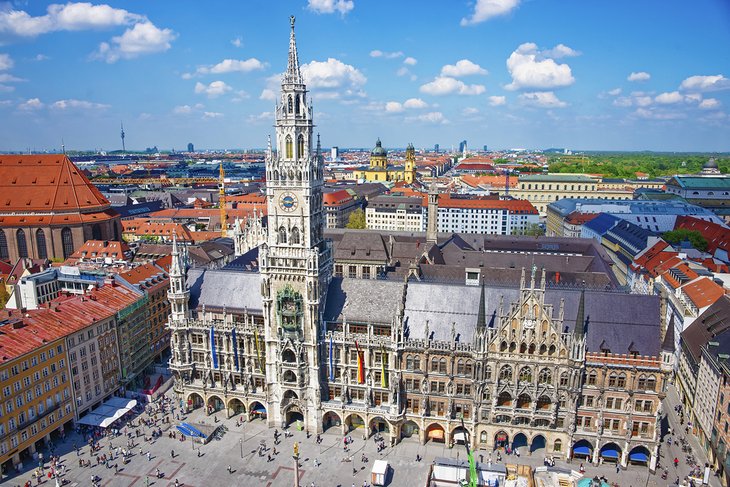
Marienplatz has been Munich's central square since the city's foundation; the site of medieval jousting tournaments; and until 1807, where markets were held. In addition to the massive Neues Rathaus (New City Hall) that fills one entire side of the square, you'll find the Altes Rathaus (Old Town Hall) forming a gate at the far end.
In the large open square are the Mariensäule , a tall column to the Virgin Mary erected in 1638, and the Fischbrunnen , a newer fountain that includes bronze figures rescued from an earlier 19th-century fountain. Popular with shoppers for its stores, boutiques, and restaurants, Marienplatz is the focus of festivals and scene of a large Christmas Market , one of several in the city. During the Fasching carnival, the Narren-Lindwurm (dragon) dances over the square.
Daily at 11am and noon, and at 5pm from March through October, everyone stops to watch the famous Glockenspiel on the front of the Neues Rathaus, as its mechanical figures dine, joust, and dance. It's one of the city's best-loved traditions, and something you shouldn't miss. Take some time to appreciate the intricate stonework on the Neo-Gothic façade.
It's hard to remember that this building dates only from the late 19th century, completed in 1892. You can ride the elevator to the middle gallery of the building's 85-meter tower for views over the city. The Tourist Information Center is in the Rathaus, and in the back of the building is a restaurant serving traditional Bavarian dishes.
Address: Marienplatz, 80331 München
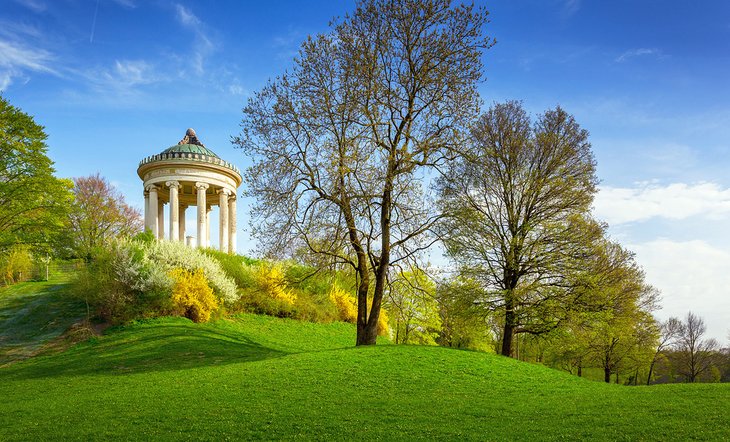
Munich's English Garden is not only the largest city park in Germany - it covers an area of 910 acres - it's also one of the most beautiful. Naturally arranged groups of trees and plants offer ever-changing vistas, and nine kilometers of winding streams and an artificial lake complete the impression of a natural landscape.
Designed in 1785 as a military garden, the English Garden attracts walkers, joggers, and cyclists to its 78 kilometers of pathways and bridle paths. It's also a pleasant place to sunbathe and picnic, and you can stop for a snack or drink at the Chinesischen Turm (Chinese Tower), a 25-meter-tall pagoda.
In 1972, a Japanese garden was created on an island at the southern end of the garden to house an authentic teahouse, a gift in honor of the 1772 Olympics. The park also contains the Bavarian National Museum, with its fine collection of medieval German sculptures and tapestries, and the Bavarian State Archaeological Collection , which displays local prehistoric artifacts.
A curiosity in the park is the Eisbachwelle , a wave created by the emergence of the Eisbach river from its underground course. Crowds gather to watch surfers' stunts; except for experienced surfers, it's a spectator sport and not for beginners.
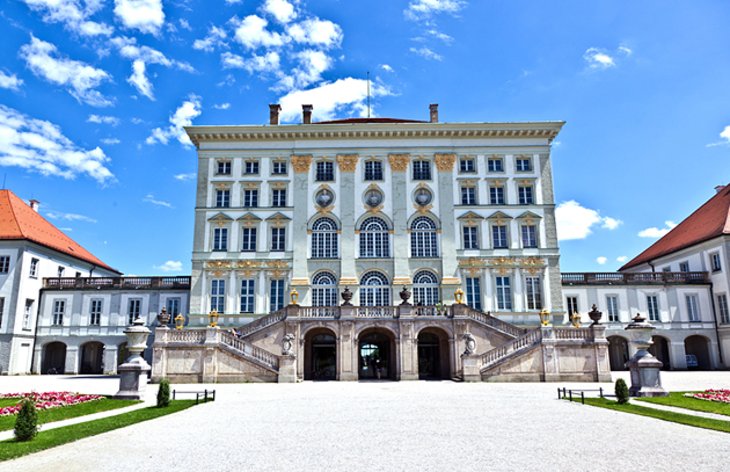
The large Baroque palace of Nymphenburg, in the northwest outskirts of the city, was originally the summer residence of the Wittelsbach Electors in the 17th century. Extending more than 600 meters from wing to wing, this vast palace is surrounded on each side by the Nymphenburg Canal, which splits as it passes around the main buildings before reuniting again in a fountain-adorned pool in front of the main façade.
Your first stop should be the Central Pavilion , a cube-shaped palace in the style of an Italian villa, completed in 1674 and home to the lavishly decorated three-story Stone Hall (Steinerner Saal) and a number of private chambers with fine furnishings and artwork. In the Palace Chapel, notice the expressive ceiling painting illustrating the life of Mary Magdalene. Beside the palace in the former Court Stables, the Marstallmuseum displays a collection of beautiful state coaches.
In the magnificent 17th-century gardens of Nymphenburg Park stands the Amalienburg , a palatial hunting lodge known for its famous Hall of Mirrors. Elsewhere in the gardens are a maze with the Heckentheater (Hedge Theater); marble statues of Greek gods; a large fountain; and a number of hothouses, including the Palm House, which has Germany's first hot-water heating system.
Address: Schloss Nymphenburg 1, 80638 München
Official site: www.schloss-nymphenburg.de/englisch/palace/index.htm
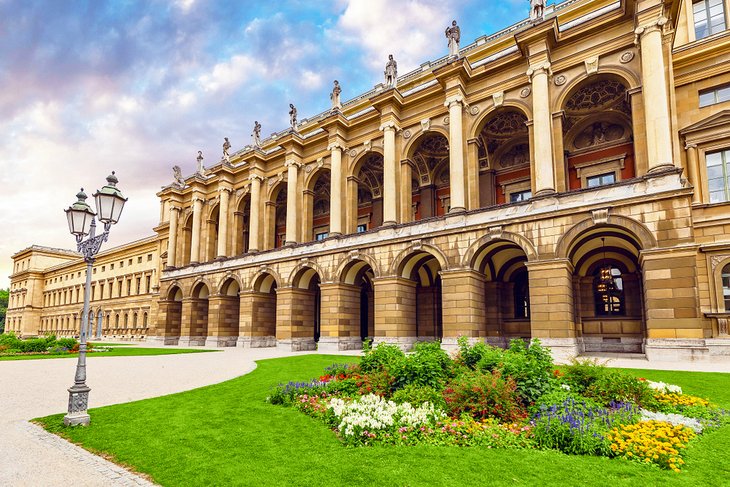
For centuries the seat of the dukes, electors, and kings of Bavaria, the Munich Residenz is one of Europe's most spectacular palaces. Laid out around seven large courts, the vast Residenz complex comprises three main sections: the Königsbau , fronting onto Max-Joseph-Platz; the Alte Residenz , facing Residenzstrasse; and the Festsaalbau (Banqueting Hall), overlooking the Hofgarten .
The earliest section of this huge complex was the magnificent Antiquarium, built in 1579 and now part of the outstanding Residenz Museum . The Alte Residenz, a masterpiece of the late Renaissance and testimony to the growing power of Bavaria, followed soon after, and the final components - the Neoclassical Königsbau, the Festsaalbau, and the Court Church - were completed in 1848.
Today, the Residenz houses a number of monuments and museums, including the Residenz Museum, the Treasury, the Court Church of All Saints (Allerheiligen-Hofkirche), and Cuvilliés-Theater. Be sure to explore the palace grounds, too, with its many wonderful old courtyards and arcades.
Address: Residenzstrasse 1, 80333 München
Official site: www.residenz-muenchen.de/englisch/residenc/index.htm
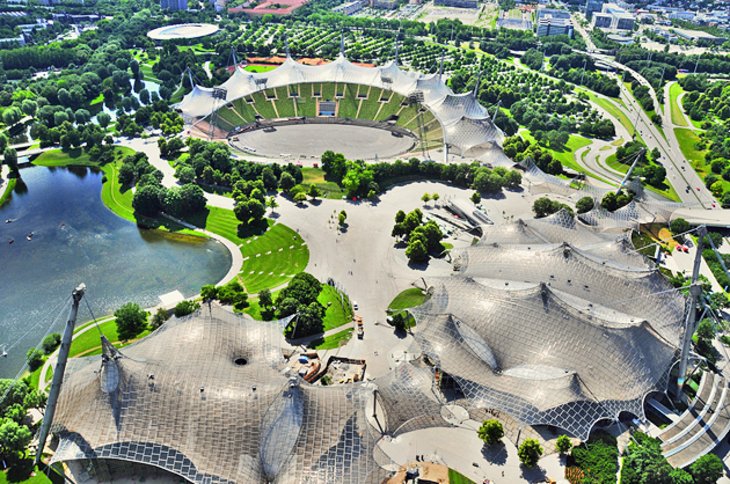
Home to the 1972 Summer Olympics, Munich's spectacular Olympic Park covers an area of some 2.7 million square meters on the Oberwiesenfeld, a former training ground for the Royal Bavarian army. Now a major recreational center, this huge facility hosts a variety of major concerts and events, including the summer Tollwood Festival (the winter Tollwood is held at Theresienhöhe, home of the Oktoberfest).
A number of family activities have been added since the Olympics, so you'll find plenty of things to do here. These include a stadium roof climb, ziplining, and behind-the-scenes tours showcasing the facility's splendid architecture and design. The Olympic Tower , a 290-meter-high television tower built in 1968 that was renamed in honor of the games, has viewing platforms in the Aussichtskorb offering breathtaking views over the city.
Address: Spiridon-Louis-Ring 21, 80809 Munich
Official site: http://www.olympiapark.de/en/olympiapark-munich/
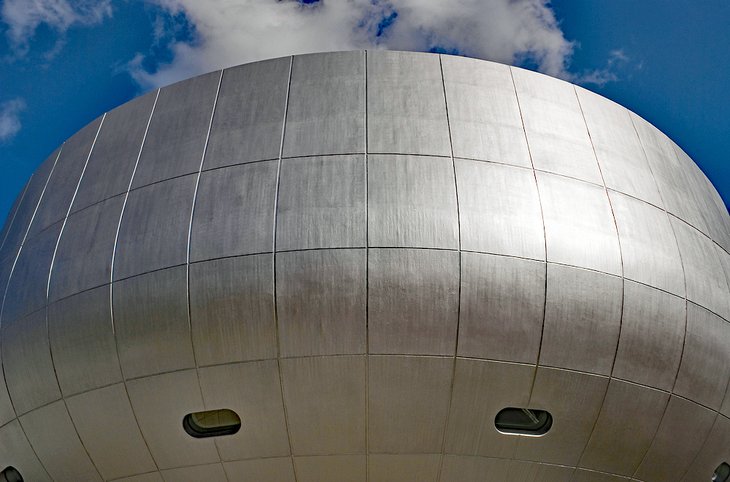
Next to BMW's soaring headquarters and factories at the Olympic Park is a round contemporary building with a metal shell, housing BMW's museum. Here, car fans will find examples of nearly all the models the company has made, including sports cars, racing models, and motorcycles.
You can see current models and learn about the technology of modern automobile construction, as well as get glimpses of future propulsion technologies and designs the company is exploring. Those who think cars are just for getting from point A to point B might want to skip this one, but for fans of things automotive, it's a must.
Address: Am Olympiapark 2, 80809 München
Official site: https://www.bmw-welt.com/en.html
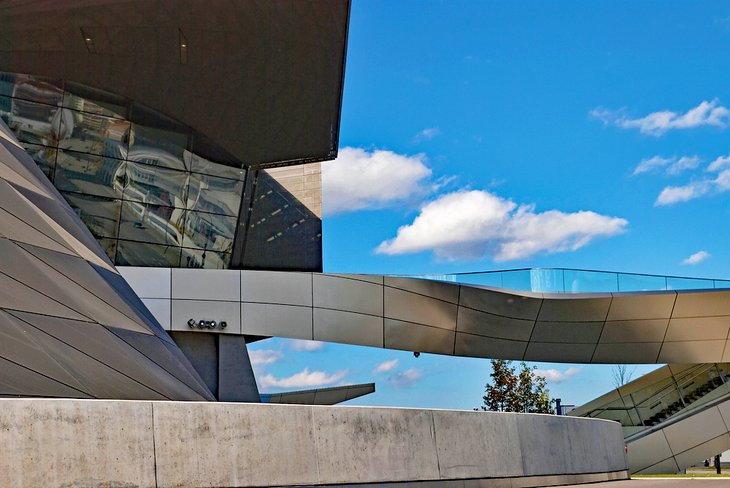
Not to be confused with the BMW Museum (above), although it's on the same huge manufacturing complex near the Olympic Park, BMW Welt is a gigantic showroom. Here, you can see every vehicle the company makes, sit inside them, and learn what the future cars and motorcycles may look like.
Whereas the BMW Museum is more about past models and history, the Welt is all about now, with an exhibition area and a three-dimensional media façade with immersive visions of the future of mobility. Interactive exhibits consider sustainability and offer insights into the design process. You can take tours of the BMW Group Plant to see the production process.
Opened in 2007, the BMW Welt is the most visited tourist attraction in Bavaria. The building's futuristic steel-and-glass architecture is part of the allure, plus the fact that admission is free.
Address: Am Olympiapark, München
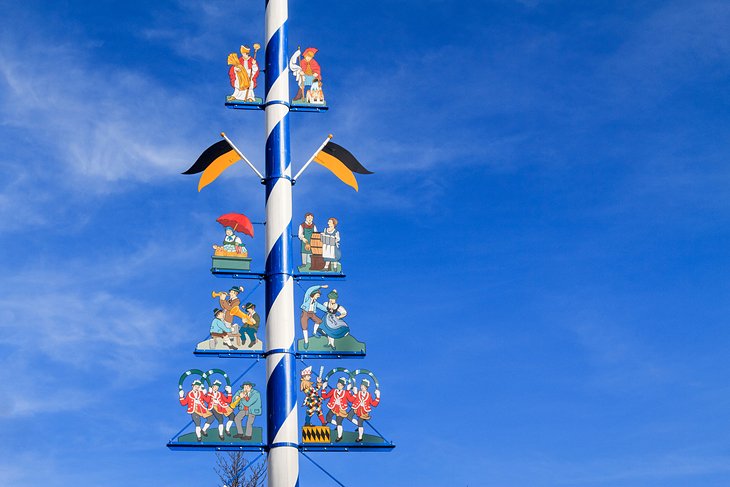
In 1807, when the farmers market outgrew Marienplatz, it was moved to the nearby square, where it thrived and expanded, until today it covers 22,000 square meters and includes a butchers' hall, bakery, fish hall, and flower market in addition to its fruit and vegetable vendors.
It's not just a place for locals to buy items for the night's dinner. Fresh breads and pastries, wheels of cheese, and cured meats are good picnic makings, and tables and benches provide a place for shoppers and visitors to sit while they eat sizzling sausages, hot pretzels, and other foods prepared in mobile kitchens.
Above the market stands a colorful maypole , with traditionally dressed figures representing the various crafts and trades that were practiced in this part of town.
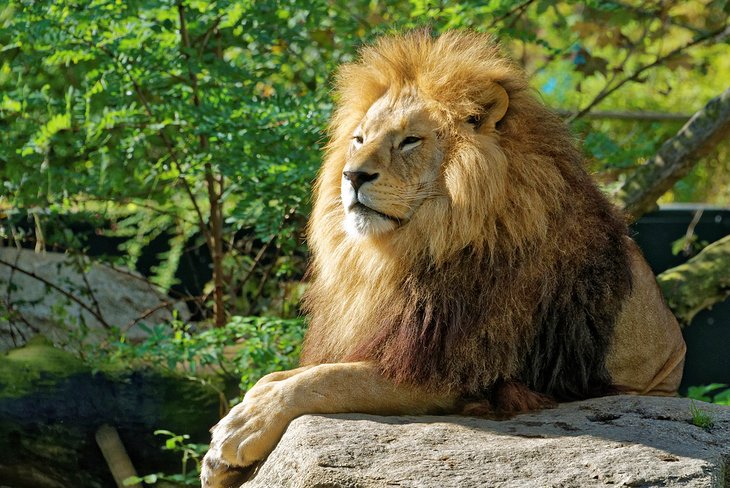
Spread across 89 acres, Hellabrunn Zoo is consistently ranked among the best zoos in Europe. Laid out in 1911, it was the first zoo in the world to have animals grouped according to where they came from.
Today, more than 19,000 animals from 757 species are held in open enclosures meant to replicate the conditions of the wild, with animals that normally share habitats kept together wherever possible.
Popular features include the Elephant House (now a listed building), the enormous 5,000-square-meter free-flight aviary, the Polarium, and ape houses. Located adjacent to the Isar River in a designated conservation area, the zoo has many delightful footpaths, playgrounds, and picnic spots.
Address: Tierparkstrasse 30, 81543 München
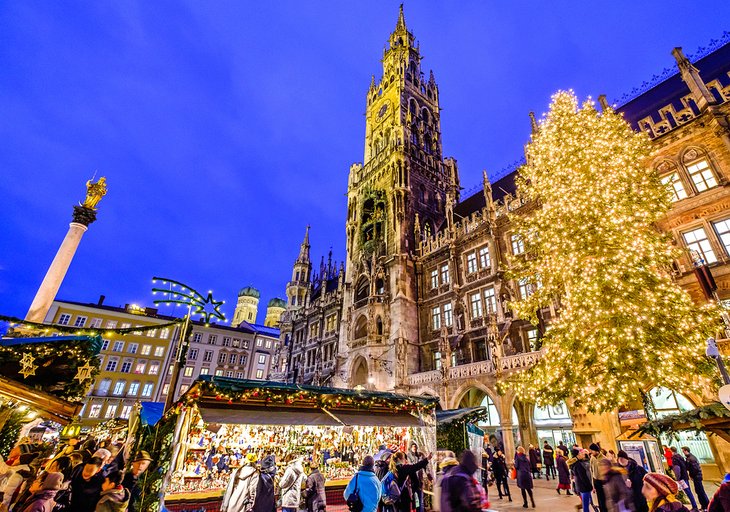
From the last week in November until December 24 , the parks and squares of Munich turn into a colorful, sparkling Christmas extravaganza of colored lights, evergreen boughs, and holiday music. Colorful frosted gingerbread hearts decorate little cabins filled with candies, cookies, wooden toys, Christmas tree ornaments, and holiday baubles, as well as local handcrafts in all mediums.
The largest market is in Marienplatz , where local chorales serenade shoppers with Christmas music. Two blocks away, at the Rindermarkt, the market is filled with figures and accessories for crèche scenes. Miniature shepherds, wisemen, angels, animals, and the holy family are in every imaginable media: delicate Alpine woodcarvings from nearby Oberammergau, ceramic, terra-cotta pottery, wax, and plastic.
One of the most charming is the Christmas village inside the courtyard of the Residenz, where a children's theater and bakers turning out hot treats add to the appeal. Not far away, an entire square turns into a Medieval Marketplace, where artisans and craftspeople dressed in costumes of the Middle Ages demonstrate and sell authentic period goods.
Wherever you go, you will find traditional lebkuchen (gingerbread) from Nuremberg - sold at Munich's first Christmas markets in the 1600s and still favorites today.
Read More: Top-Rated Christmas Markets in Germany
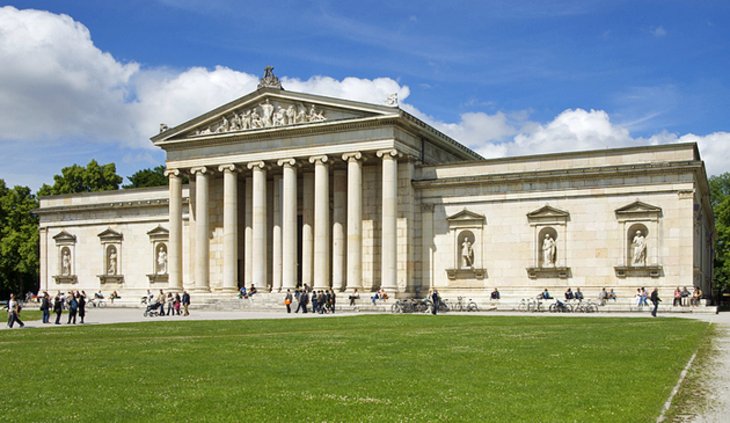
Königsplatz was laid out in Neoclassical style in 1862, and in the art district around it, you'll find one of the finest groups of art museums anywhere in Europe. First are the three Pinakothek art galleries: the Old Picture Gallery (Alte Pinakothek), with its fine collections of Dutch, Flemish, Italian, French, German, Spanish, and medieval paintings; the New Picture Gallery (Neue Pinakothek), with its displays of art ranging from Rococo to Art Nouveau; and the State Gallery of Modern Art (Pinakothek der Moderne), which includes works by Picasso and Warhol.
Other museums of note are the Glyptothek and the State Antiquities Collection (Staatliche Antikensammlung), with their large compilations of ancient sculptures and antiquities.
The latest addition to this treasury of art is Lenbachhaus , an Italianate villa that was the home and studio of artist Franz von Lenbach. The villa and its new extension house the world's foremost collection of works by the Blue Rider movement, a group of Expressionist painters led by Wassily Kandinsky and Franz Marc.
Address: Königsplatz 1, 80333 München
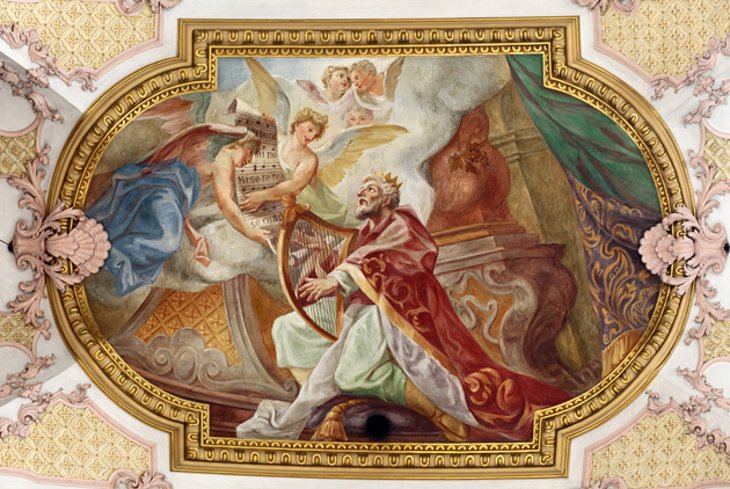
Known affectionately as Old Peter, St. Peter's Church (Peterskirche) is Munich's oldest parish church and stands on Petersberg, a small hill originally settled by monks. Built in Gothic style in 1386, the church was altered with the addition of a Baroque choir with three apses in 1636, while the tower was given a lantern dome in place of its earlier Gothic spires.
Interior highlights include the font by Hans Krumper, the red marble monuments by Erasmus Grasser, and the 15th-century Schrenk Altar with its sculptures of the Crucifixion and the Last Judgment. Also of note is the 20-meter-tall 18th-century high altar with its figures of the Four Fathers of the Church and St. Peter.
The panel-paintings on the choir walls by Jan Polack are also worth seeing, as is the highly regarded Altar of the Virgin of Mercy (Mariahilf-Altar) from 1756. Finally, the 299-step tower - famous for its eight clock faces matched by eight bells - reaches a height of 91 meters and offers panoramic views as far as the Alps for those with the stamina to climb the 306 steps.
Address: Rindermarkt 1, 80331 München
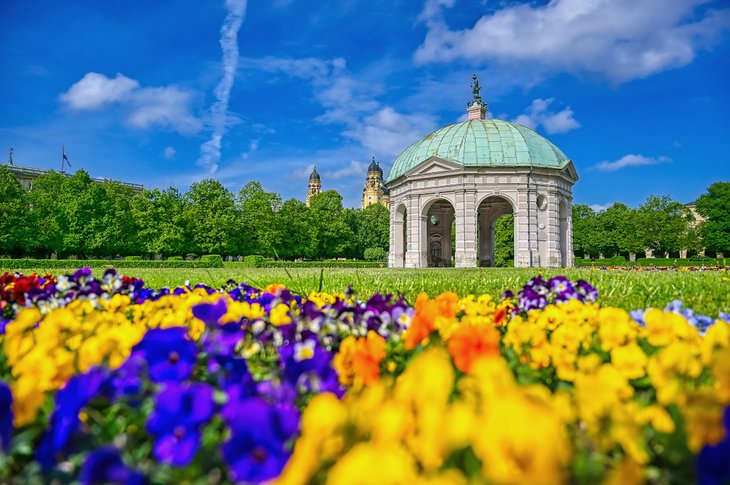
In the center of Munich, just off Odeonsplatz, the Hofgarten (Court Garden) was built between 1613 and 1617 , adjoining the Residenz and for the sole use of the court. It remained a private preserve for more than 160 years, opening to the public in 1780.
Since then this peaceful sanctuary with its intersecting paths, fountains, beds of bright flowers, and shaded arcades have been a favorite place for locals and visitors to stroll and relax. The focal point is the central pavilion, featuring eight arches, with paths radiating from each one to form beds for lawns and flowers. Fountains mark the points where the paths intersect.
Modeled on Italian Renaissance gardens when it was designed, the Hofgarten became more like the then-popular landscape gardens during the 19 th century. After its destruction in World War II, it was rebuilt to more resemble the original.
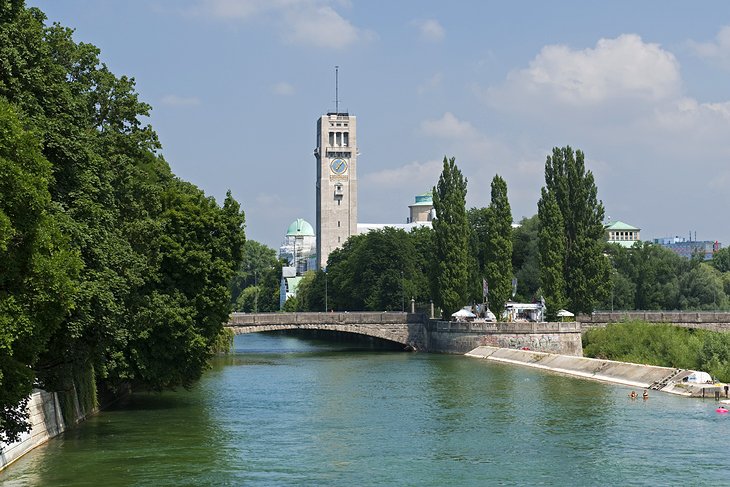
The Deutsches Museum is the world's largest museum of technology, and its 17,000 artifacts illustrate exhibits that range from the polished wood and brass of early astronomical instruments to the latest science on global warming. The museum is a constant time travel between early tech and high tech, as you follow the development of each scientific and technical discipline from its beginnings to the present.
The extensive collections relating to transport are astonishing, covering trains, aircraft, shipping, cars, even bicycles. You can see a replica of the Red Baron's biplane from the First World War, examine a Venetian gondola up close, and look inside a 19th-century wooden fishing boat. There's always something happening, from dramatic demonstrations of electricity to concerts showing how musical instruments work.
Kids' Kingdom is filled with clever hands-on activities designed for children ages three through eight, exploring light, music, ships, computers, water, sound, astronomy, and more. It is Germany's most popular museum and a favorite place to visit for families.
Address: Museumsinsel 1, 80538 München
Official site: www.deutsches-museum.de/en
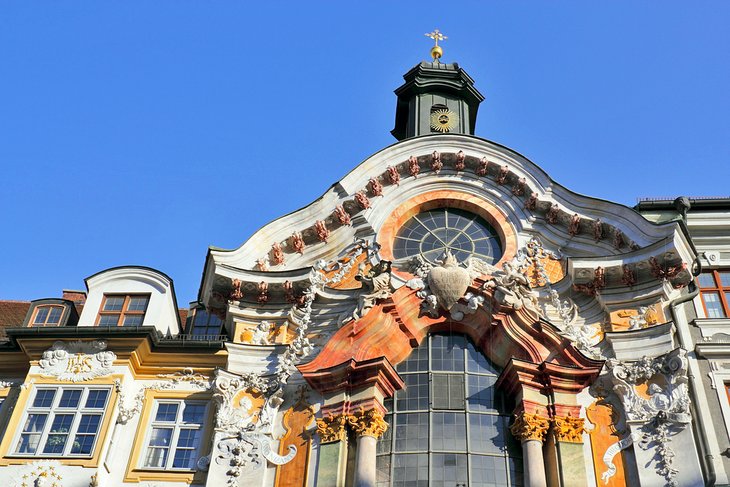
The beautiful Rococo Asam Church, dedicated to St. John of Nepomuk, was completed in 1746 by brothers Cosmas and Egid Asam and is richly decorated with stucco figures, frescoes, and oil paintings. While its exterior is impressive enough, particularly the large doorway flanked by massive columns and crowned by a figure of St. John kneeling in prayer, it's the interior that's most memorable.
Highlights include a wrought-iron grille from 1776 that separates the stucco figures of the saints from the long nave with its galleries. On the projecting cornice under the ceiling is a magnificent fresco depicting the life of St. John. The most notable feature of the interior, though, is the high altar, enclosed by four twisted columns and on which sits a glass shrine containing a wax figure of the church's patron saint.
Address: Sendlinger Straße 32, 80331 München
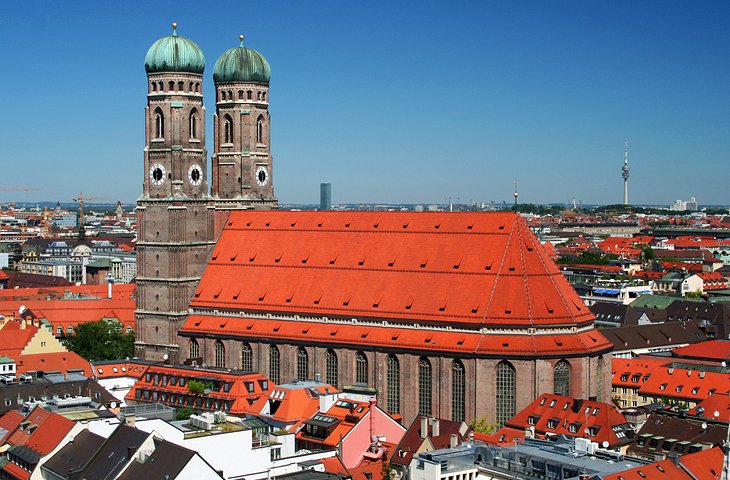
Munich's huge brick Frauenkirche - the Cathedral Church of Our Lady - was completed in 1488, a Late Gothic church that owes its impact to its great size. Massive twin 100-meter-tall towers, with their characteristic Renaissance domes, tower over a high building 109 meters long by 40 meters wide.
Highlights inside the cathedral include the 1622 Tomb of the Emperor Ludwig the Bavarian in black marble with bronze figures, a 1620 altarpiece of the Assumption by Peter Candid, and the Baroque red marble font in the Baptistery with its early 14th-century Sorrowing Christ.
A popular curiosity is the strange footprint in the floor of the porch, said to have been left by the devil after he came to inspect the church. So delighted was he that the windows seemed to have been forgotten (the row of columns hides them when the church is viewed from the entrance), he stamped his foot, leaving the footprint that can still be seen today.
The twin towers of Frauenkirche are a good landmark for orientation, visible from all over the city. You can climb to the top for views across the city to the Bavarian Alps.
Address: Frauenplatz 12, 80331 München
- Read More: Exploring Munich's Frauenkirche (The Cathedral of Our Lady)
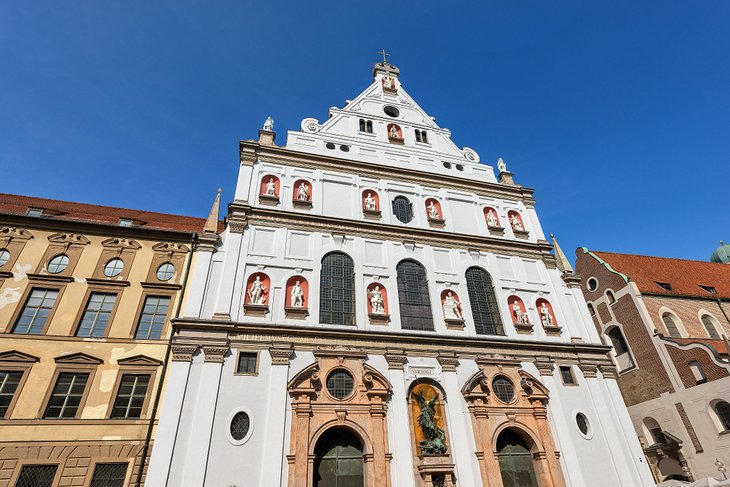
The largest Renaissance church north of the Alps, St. Michael's was completed in 1597, with a high barrel-vaulted roof in the nave. The pattern of the triumphal arch at the entrance to the choir is continued in the arches of the transepts, side chapels, and galleries. The three-story-high altar has an altarpiece, St. Michael Fighting the Devil , from 1587.
The four bronze reliefs dating from 1595 were intended for the tomb of Duke William V, while in the side chapels are some fine paintings and a precious reliquary of Saints Cosmas and Damian from around 1400.
The church's historical importance is in the Royal Crypt (Fürstengruft) underneath the choir, where 41 members of the House of Wittelsbach - among them Duke Wilhelm V, the church's patron; Elector Maximilian I; and King Ludwig II - are buried.
Address: Neuhauser Straße 6, 80333 München
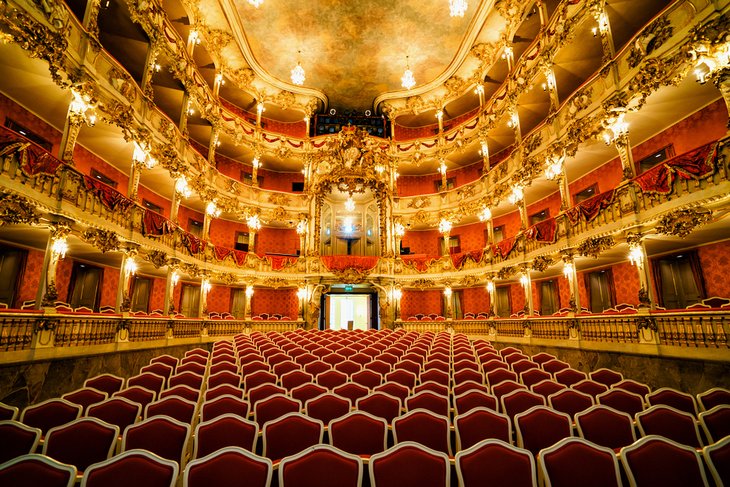
On the east side of the Residenz in Munich, the Cuvilliés Theater was built in 1755 and is the finest example of a Rococo theater with tiered boxes in Germany. The magnificent carved woodwork of the auditorium, with its four tiers of boxes, including one built especially for the electors, was safely stored away during WWII, thus allowing its reconstruction in 1958.
Architecturally stunning, the rare elegance and rich hues of its intimate Rococo interior makes it a truly unique setting for operas such as Mozart's Idomeneo, which premiered here in 1781, and which, along with many other Late Baroque period operas, is still performed on occasion. You can visit the theater separately or on a combined ticket with the Residenz and its museums.
Address: Residenzstraße 1, 80539 München
Official site: http://www.residenz-muenchen.de/englisch/cuv/
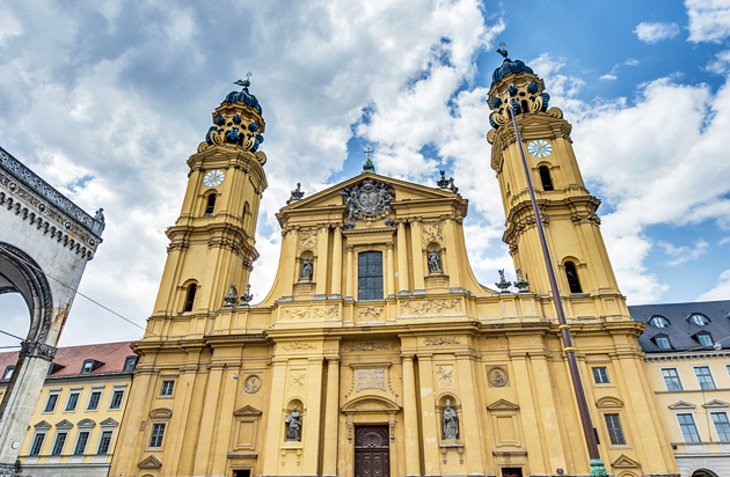
The Theatine Church of St. Cajetan (Theatinerkirche St. Kajetan), a basilica built in the style of the Italian High Baroque, was completed in 1690, with a stunning façade, twin towers, a massive 71-meter-high dome, and richly decorated interior. Exterior highlights include numerous marble statues of saints and the lantern with a lion weathervane atop the dome.
The interior, dominated by the tall round-headed arches of the barrel vaulting and the dome over the crossing, is washed in white, with rich stucco ornamentation. Other interior highlights include the high altar, with its picture of The Virgin Enthroned with Angels from 1646 by Caspar de Crayer (a pupil of Rubens), and the Altar of the Virgin, with a painting of the Holy Kinship from 1676. In the Ducal Burial Vault, you'll see the tombs of members of the House of Wittelsbach, long-time rulers of Bavaria.
Address: Salvatorplatz 2a, 80333 München
All that remains of the medieval walls that once enclosed Munich's Altstadt (old town) are the impressive gates at Karlstor, Sendlinger Tor, and Isartor, but the broad, curving streets that replaced them still define the historic center. It's here that you'll find most tourist attractions, with Marienplatz at its center. Major museums lie just outside the compact center. Most of these highly rated hotels in Munich are an easy walk from Marienplatz:
Luxury Hotels :
- Near the Isartor and 10 minutes from Marienplatz, Hotel Torbraeu has nicely furnished rooms in a historic building.
- In the heart of the old city overlooking Viktualienmarkt, near the daily food and flower market, Louis Hotel offers spacious, stylish rooms and a sauna/fitness area.
- A pool and sauna are added benefits at Hotel Vier Jahreszeiten Kempinski Munchen , set amid high-end shops on the uber-fashionable Maximilianstrasse, a five-minute walk from Marienplatz.
Mid-Range Hotels:
- Locations simply don't get any better than Platzl Hotel , next to the Residenz palace and museums and a few steps from Marienplatz and shopping streets. Breakfast is included, and the beautifully furnished rooms have thoughtful amenities. Two blocks from the Residenz palace and museums and close to Marienplatz,
- Maximilian Munich is on a quiet street, with some rooms overlooking a garden courtyard.
- The hospitable Hotel Mirabell offers well-furnished rooms in a neighborhood beside the main train station, just off Karlsplatz and the entrance to the old town.
Budget Hotels:
- Family-friendly Hotel Biederstein is opposite the English Garden in the lively Schwabing neighborhood; a buffet breakfast is included.
- Breakfast is included at Jedermann Hotel , a 15-minute walk from the old town but on a tram line to its center.
- Near Sendlinger Tor and the Rococo-style Asamkirche and a ten-minute walk from Marienplatz, Acanthushotel has small, comfortable rooms.
- Contemporary guest rooms at Schwan Locke are large, some with kitchenettes. The hotel is close to the main train station and within walking distance of Karlsplatz and Marienplatz.
- Just two hours by train from Munich is the beautiful city of Salzburg; birthplace of Mozart and the setting of the film The Sound of Music. If you have time to add this city to your itinerary, the Salzburg Small Group Day Tour from Munich is a hassle free, comfortable, and fun way to see Salzburg in a day. This tour includes a scenic rail journey, a walking tour of Salzburg, and free time to wander the historic streets on your own.
Castle Tours:
- To see some of Germany's beautiful castles, there are a couple of options: The Royal Castles of Neuschwanstein and Linderhof Day Tour from Munich takes you on a full-day tour to the Bavarian Mountains to see the Neuschwanstein Castle, used as a model for Disney's Sleeping Beauty, and the Linderhof hunting lodge castle. The slightly shorter Neuschwanstein Castle Small Group Day Tour includes just one castle. Note that both of these tours exclude entrance fees to the castles.
Dachau Concentration Camp Memorial Site :
- The Dachau Concentration Camp Memorial Small Group Tour from Munich is a five-hour trip with a professional guide to this memorial site, set on the grounds of the former concentration camp. The tour includes round-trip transportation and a guide.
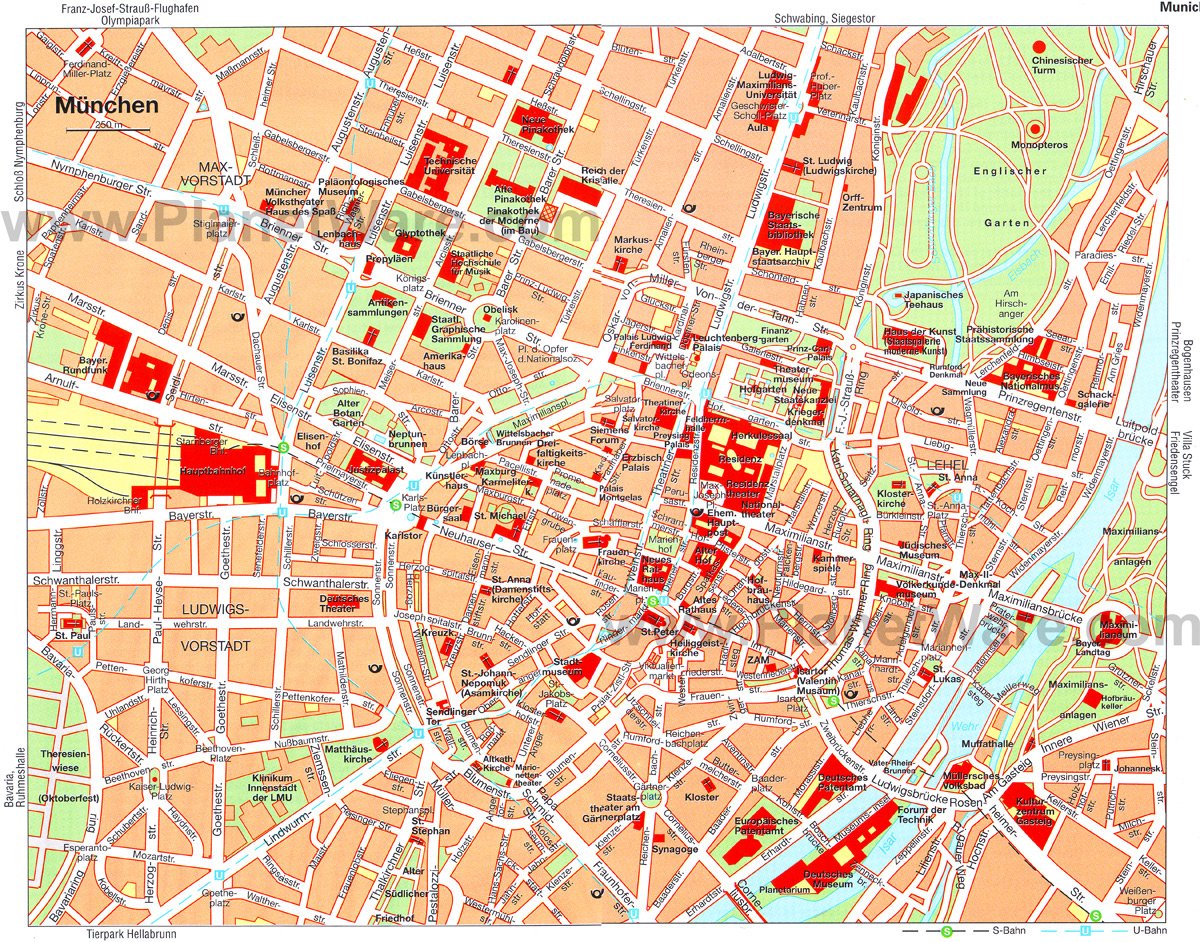
More on Germany


Home » Travel Guides » Germany » 25 Best Things to Do in Munich (Germany)
25 Best Things to Do in Munich (Germany)
Bavaria’s capital is a cocktail of beloved sights, opulent Baroque churches and museums of the highest order. Munich’s Kunstareal is a cluster of art museums with so many masterpieces it’s difficult to know where to begin. A week would never be enough to see all of them, and these invaluable collections were assembled by the Wittelsbach monarchs who ruled Bavaria up to the 20th century.
Their palaces in the city are two of the many glorious monuments to take in, and you’ll catch sight of Alps from the top of the Rathaus and St Peter’s Church. Munich is also the city of some world-famous German exports like BMW, FC Bayern and the incomparable Oktoberfest, more than two weeks of beer-fuelled merrymaking every Autumn.
Let’s explore the best things to do in Munich :
1. Alte Pinakothek

Dating to 1836, the Alte Pinakothek is one of the world’s oldest art galleries.
The museum’s Neo-Renaissance design would be a model for galleries that sprouted in Brussels, Rome and St Petersburg.
It was all ordered by King Ludwig I to house the Wittelsbach dynasty’s exceptional collection, started by Duke Wilhelm IV back in the 1500s.
The upshot is 800 German, French, Dutch, Flemish, Italian and Spanish paintings from the 1200s to the 1800s, of superlative quality.
The masters who take the spotlight are Peter Paul Rubens, Albrecht Dürer and van Dyck, all represented by multiple paintings.
And on your way, Leonardo da Vinci, Titian, Hans Baldung Grien, Hieronymous Bosch and Rembrandt are just a few of the many prestigious names you’ll encounter.
2. Munich Residenz

What began as a 14th-century castle for the Wittelsbach monarchs on the northern edge of the city burgeoned over the course of several hundred years into a sublime palace complex of ten courtyards and 130 rooms.
Successive dukes, emperors, princes and kings all made grand statements in the Renaissance, Baroque, Rococo and Neoclassical styles.
Given the size of the palace and the richness of its art, the Munich Residenz is a sight to do in several visits if you can.
But a few musts to tick off are the Italian Renaissance Grotto Courtyard, the lavishly adorned Antiquarium banquet hall and the gilded mouldings in the Baroque Ancestral Gallery.
3. Neues Rathaus

A postcard favourite, Munich’s town hall on Marienplatz is a Gothic Revival wonder, a monument worthy of the city.
The facade is festooned with pinnacles, niches with little trefoil arches and statues of the first four Bavarian kings on the bay of the tower.
Munich’s population doubled in less than 20 years between 1880 and 1900, and the Neues Rathaus, which was originally completed in 1874 had to be expanded barely 20 years after it was finished.
That facade is 100 metres long and the building was extended to 400 rooms, and you can go in to scale the 85-metre where you can see to the Alps on cloudless days.
Since 1908 the Glockenspiel has chimed each day at 11:00 and 12:00, and then 17:00 (from March to October), with automatons acting out episodes from the 1600s.
4. Englischer Garten

Scanning a map of the city, you’ll be struck by the size of the Englischer Garten.
Created in the 18th century, the park begins on the left bank of the Isar in the north behind the Residenz and just seems to go on and on.
At 370 hectares this expanse of lawns, tree groves, pasture, waterways and a lake is one of the world’s largest urban parks, bigger than New York’s Central Park.
There are some neat little sights to take in, like a Japanese teahouse added for the Olympics in 1972 and the Chinese Tower based on Kew Gardens’ pagoda and first erected in 1790. But something you may not have expected to come across is surfing: Yes, the man-made Eisbach River has a strong current, forming a static wave that experienced boarders ride for up to a minute at a time.
5. Neue Pinakothek

King Ludwig I also had an eye for the contemporary art of the 19th century and amassed many invaluable pieces from the period.
Some 400 paintings from the 1800s are on show in the Neue Pinakothek, and they tick off all of the influential movements from the century.
There are German Romantics like Caspar David Friedrich and Karl Friedrich Schinkel, French Realists such as Delacroix and Courbet, and Impressionist Art by Degas, Cézanne, Monet, Gauguin and Renoir.
After that you can go slow and study each movement in detail, or scoot across periods to the other masterpieces by Goya, Rodin, Klimt, Munch and Turner.
6. Marienplatz

In any season, Marienplatz in front of the Neues Rathaus will be brimming with locals and tourists out shopping, sightseeing or just watching the city go by.
The square has been at the centre of the city since the 12th century and is named for a Marian column that was raised here in the 17th century.
The monument is from 1638 and celebrates the withdrawal of Swedish troops from Munich during the 30 Years’ War.
The golden statue at the top is older, sculpted in 1590 and showing Mary on a crescent moon as the Queen of Heaven.
This was the first Marian column north of the Alps, and the forerunner for a host of similar monuments in Bavaria and Central Europe.
Come in December, when the Christmas market is in full swing.
7. St Peter’s Church

Munich’s oldest church was first built at the end of the 1100s but destroyed by fire in 1347. The reconstruction was in the Gothic style and down the years there have been many extensions, leaving the St Peter’s with Renaissance and Baroque elements.
That fusion of styles applies to the art, as 15th-century Gothic paintings by Jan Polack sit below a marvellous Late Baroque ceiling fresco by Johann Baptist Zimmermann.
Go in for a closer look at the high altar, which has a figure of St Peter sculpted by Erasmus Grasser at the turn of the 16th century.
St Peter’s church rests atop the hillock, Petersbergl and it’s worthwhile tackling the tower’s 299 steps to spend a few minutes pointing out Munich’s landmarks with the help of a telescope.
8. Deutsches Museum

Like the Alte Pinakothek the Deutsches Museum could easily keep you occupied for an entire day.
The museum sits on an island in the Isar (the Museumsinsel) and maps the development of Science and Technology in Germany.
What will keep you engrossed is the sheer variety of fields dealt with in these galleries, from nanotechnology to reproduction, aerospace and astronomy to hydraulic engineering.
If you only have a couple of hours to spare you’ll need to plan ahead and focus on one or two things.
Every field has well-presented and fully interactive exhibits, inviting kids to push buttons, crank wheels and pull levers.
And while younger minds are catered for and there’s even a fun kids’ zone, the museum never shies away from the complicated details.
9. Pinakothek der Moderne

Although it’s known locally as the “Dritte” (third), after the Alte and Neue Pinakothek, Munich’s modern art museum is just as essential.
As with its neighbours in the Kunstreal, the galleries are comprehensive and stocked with art by the most celebrated names of the last 100 years.
The best bit is the Expressionism exhibition from both the Brücke and Blaue Reiter groups, and artists like Kirchner, Kandinsky, Klee, Franz Marc and Emil Nolde will be familiar to all.
In rest of the Modernism galleries you’ll come across Francis Bacon, Braque, Otto Dix, Picasso, Magritte, Max Ernst and Joan Miró.
And then bringing you from the 1960s to the present day are the contemporary galleries abounding with art by Sigmar Polke, Andy Warhol, David Hockney and Lucio Fontana among others.
And beyond all this there are exhibitions for applied art/industrial design, photography, drawings and architecture.
10. Lenbachhaus

At the dawn of the 20th century Munich had a vibrant and influential art scene, when the Blaue Reiter (Blue Rider) group shook up the old academies.
Many leading Expressionists were members, including Kandinsky, Franz Marc, Gabriele Münter and August Macke, and the Lenbachaus brims with their paintings.
There’s also great deal of contemporary art by the likes of Gerhard Richter, Andy Warhol and Jenny Holzer.
The museum’s roll-call of Munich-based artists goes back to the Gothic painter Jan Polack and including the portrait painter Georg Desmarées, the landscape artists Carl Anton Joseph Rottmann and the Biedermeier luminary Carl Spitzweg.
The Lenbachhaus is named for the portrait painter Franz von Lenbach who commissioned the building in the 1880s.
In 2013 a new wing was added, clad with copper and aluminium tubes.
11. Asam Church

An easy walk from the Sendlinger Tor at the southern tip of old Munich is an extravagant Late Baroque church wedged in a confined space between neighbouring buildings.
The Asam Church is named after its mid-18th-century designers, the brothers Asam, one a painter and the other a sculptor.
An interesting thing about the church is that it was a private chapel, unattached to any religious order.
This, along with the narrow space, gave the brothers freedom to break a few Baroque rules for layout and interior decoration.
The church faces west for instance, and the crucifix opposite the pulpit is hung unusually low.
These quirks and the skill of the radiant ceiling frescos and workmanship in the stuccowork lining the nave add up to one of the foremost buildings in the German Late Baroque style.
12. Frauenkirche

Although there are prettier churches in Munich, none possess the 15th-century Frauenkirche’s sense of scale.
Its pair of towers, crowned with onion domes are a Munich landmark, and no new building is permitted to exceed their 109-metre height.
The church’s design is famously discreet, with few window openings and unadorned walls that inspire awe.
The Frauenkirche suffered in the war, but there’s still a lot of restored or original art to seek out inside.
The choir stalls from the start of the 16th century are sculpted with busts of prophets and apostles, and some of the stained glass windows are from the medieval church that stood on the site before this one.
There’s also a tomb monument to Louis IV the 14th-century Holy Roman Emperor, and see a shoe-shaped impression at the entrance, supposedly left by the devil!
13. Theatine Church

At Odeonplatz you’ll be greeted by the splendid yellow facade of the 17th-century Theatine Church.
This monument was designed by Italian architects in the Baroque style and took cues from Rome’s Sant’Andrea della Valle.
Give yourself time to marvel at the painted facade, rich with niches, reliefs, Doric columns and Ionic pilasters.
It’s all the product of a holy vow given by Henriette Adelaide of Savoy, if she could give birth to a crown prince for the Elector Ferdinand Maria.
Through the doors, keep an eye out for the altar with images of the evangelists from 1722, the black wooden pulpit dating to 1688 and the crypt, resting place of several members of the Wittelsbach family.
14. Bavarian National Museum

Inaugurated by King Maximilian II in 1855, the Bavarian Museum is another cultural attraction that needs a lot of time.
In store here are more than 40 rooms of decorative items, dating from antiquity to Art Nouveau at the start of the 20th century.
There’s faience, weapons, armour, porcelain, oil paintings, musical instruments, furniture, clocks, costumes tableware and a whole lot more besides.
The high points are the Bollert Collection, a trove of Late Gothic and Renaissance and sculpture from religious buildings around Bavaria, and the set of Rococo Nymphenburg porcelain figures by the Swiss modeller Franz Anton Buselli.
The Historicist museum building also deserves a mention as it was purpose-built to complement the collections at the end of the 1890s.
15. BMW Museum

Karl Schwanzer, the man who designed the famous BMW Headquarters also drew up the plans for the futuristic museum building in front, often described as the “salad bowl”. The building was completed in 1973 and its galleries are on a Guggenheim-esque spiral.
The showrooms are air, spacious and effortlessly cool, as you go on a journey through the brand’s technological development.
There are vintage cars, aircraft, motorcycles, turbines, engines as well as outlandish concept vehicles from the last two decades, all accompanied with information via multimedia.
Did you know Elvis Presley owned a BMW? Well he did and it’s on show here.
16. BMW Welt

After learning about BMW’s past you can be brought up to date with the present at the stylish exhibition hall next door.
BMW Welt is free to enter and the best explanation is that it’s the world’s most spectacular car dealership showroom.
People come to pick up their new BMWs, which is a spectacle in its own right as their car is lifted up to them by elevator into a glass hall.
You can take a close look at all of the BMW models currently on the market, get behind the wheel and even book a test drive.
If one steals your heart you can order it here for delivery to most parts of the world, or shop for BMW souvenirs and accessories at the shop.
17. Glyptothek

Our final museum in the Kunstareal would be a priority in almost any other city, which testifies to the volume of art and history in this quarter.
The Glyptothek is a Neoclassical temple ordered by King Ludwig I as a repository for his Greek and Roman sculpture collection.
The building was completed in 1830, making it the oldest museum in Munich.
There’s more than 1,000 years of sculpture within, spanning the Archaic, Classical and Hellenistic Periods as well as the Roman Empire.
The Hellenistic Barnerini Faun is one to look out for, depicting a life-sized faun and sculpted around the turn of the 2nd Century BC. From Roman times there’s an assortment of busts of emperors like Emperor Augustus, Nero, Caligula and Traian, and the statesmen Sulla and Gaius Marius.
18. Olympiapark

While many former Olympic venues around the world tend to be forgotten, Munich’s 1972 Olympic Park is still a popular day out.
The park is a massive activity centre where you can ride a zip-line over the iconic stadium, take part in watersports on the lake and ski on the hill in winter.
There are also fairground amusements in summer, and no lack of places to grab a snack or meal.
The park has also witnessed some historic events, one grim, like the Munich massacre of 11 Israeli team members in 1972, and you can still visit Building 31 where the Israeli team was staying.
On a lighter note the Olympic stadium was also the scene of one of the most memorable World Cup finals in 1974, when Beckenbauer’s Germany came from behind to defeat Johan Cruyff’s Netherlands 2-1.
19. Allianz Arena

Even if you only have a passing interest in football, a visit to the home of FC Bayern has to be on the agenda.
That’s not just because they’re Germany’s top team and have a special place in the nation’s culture, but they also moved into an awesome new home just over a decade ago.
The 66,000-seater stadium is clad with 2,874 luminous panels, which light up with the club’s colours on match-days.
The Allianz Arena’s hour-long tour is an all-access experience, guiding you in to the dressing rooms, player’s tunnel, mixed zone where post-match interviews are given and the press conference room.
After that you can spend some time in the museum acquainting yourself with Bayern’s greatest players like Franz Beckenbauer, Gerd Müller and Lothar Matthäus, and reliving the club’s five Champions League/European Cup victories.
Recommended tour : FC Bayern München Football and Allianz Arena Tour
20. Munich National Theatre

The Neoclassical National Theatre on Max-Joseph-Platz is one of Europe’s top opera houses and the home venue of the Bavarian State Ballet, Bavarian State Orchestra and the Bavarian State Opera.
The current design and its majestic portico is from 1825, and although the building was devastated in the war it was rebuilt to the architect Karl von Fischer’s 19th-century plans in the 1960s.
Opera fans who aren’t able to get tickets could still arrange a German language tour to see the stunning multi-storey backstage area, and find out more about the people who have graced this building: A number of Richard Wagner’s operas debuted at the National Theatre, like Die Meistersinger von Nürnberg, Das Rhengold and Die Walküre.
21. Müller’sches Volksbad

If a swimming pool sounds a bit anticlimactic, the Müller’sches Volksbad on the right bank of the Isar is anything but a disappointment, especially if you have a taste for Art Nouveau design.
The pool is also the closest thing to a secret, in-the-know experience on our list.
There’s no equivalent in Germany, and every step of the banal activity of going for a swim and sauna session is made exciting by Carl Hochede’s Classical motifs, patterned stucco flourishes on the ceilings, whimsical lamp holders and wrought iron banisters.
22. Hofbräuhaus

If you’re up for a beer, a carefree atmosphere and helping of traditional Bavarian fare a beer hall or Wirtshaus would be just the ticket.
There are dozens to choose from around Munich and with a little research you’ll find an authentic one near you.
And even though you won’t find many locals in the Hofbräuhaus, it’s still one of those things you have to do in Munich.
It’s an annexe of the Staatliches Hofbräuhaus brewery, which was located here from 1589 until 1897 when it relocated to the suburbs.
One of the many eminent regulars at the beer hall was Mozart, who lived just around the corner in the 18th century.
On the wall you’ll notice beer steins belonging to regulars, which are kept under lock and key.
Order a litre glass of lager, malty dark beer or Weißbier to go with a Wienerschnitzel or Weißwurst.
Tip : Included in the Munich Third Reich Tour
23. Viktualienmarkt

The city’s food market was relocated here in 1807 when it grew too big for Marienplatz.
First and foremost is Viktualienmarkt is somewhere for people to do their grocery shopping, made up of 140 indoor and outdoor stalls and shops selling fresh fruit and vegetables, sausage, cheese and fancier specialty foods like olive oil, wine and tea.
But that is only half the story, as there’s a big biergarten in the centre of the marketplace, and one of Munich’s favourites.
If you’re peckish there’s a tantalising choice of food stalls or you could pick up a schnitzel or wurst from the biergarten’s own self-service restaurant.
Suggested tour : Viktualienmarkt 2-Hour Gourmet Food Tour: Munich
24. Hellabrunn Zoo

In 40 hectares on the meadow-covered right bank of the Isar in the south of the city, Hellabrunn Zoo rarely ranks outside the top five in Europe.
Established in 1911, it was one of the first in world to adopt moats and ditches as barriers instead of cages, but also introduced the concept of the Geo-Zoo, where animals are located according to their geographical regions.
If you’re concerned about the zoo’s humane credentials, it takes part in breeding programs for endangered species like silvery and drill baboons, as well as elephants, Arctic foxes and gorillas.
Alpacas, polar bears, South American sea lions and giraffes are a few of the 760-odd species.
And little ones can come and feed pygmy goats and Damara goats at two separate petting zoos.
25. Oktoberfest

Some of the figures associated with the world’s biggest beer festival are mind-blowing.
We’re talking seven million visitors and more than 7.5 million litres of beer consumed.
The 16-18-day festival begins on the third Saturday of September and goes back to 1810, when Prince Ludwig married Therese of Sachsen-Hildburghausen.
In 1896 the city’s breweries built gigantic beer tents for the celebration, and since then beer-drinking has been the main activity! There are 14 tents permanently set up at Theresienwiese in the west of the city, holding up to 8,500 revellers each.
Despite the capacity these tents fill up fast, so get there early in the day if you want a seat.
Also have a ball at the amusements and funfair rides, and be sure to soak up that alcohol with pretzels, bratwurst and schnitzel.
Book online : Munich: Oktoberfest
Suggested day trips from Munich :
- Day Trip to Neuschwanstein and Linderhof Castles
- Dachau Concentration Camp Half-Day Tour from Munich
- Salzburg Day Trip from Munich by Train
- Romantic Road and Rothenburg from Munich
25 Best Things to Do in Munich (Germany):
- Alte Pinakothek
- Munich Residenz
- Neues Rathaus
- Englischer Garten
- Neue Pinakothek
- Marienplatz
- St Peter's Church
- Deutsches Museum
- Pinakothek der Moderne
- Lenbachhaus
- Asam Church
- Frauenkirche
- Theatine Church
- Bavarian National Museum
- Olympiapark
- Allianz Arena
- Munich National Theatre
- Müller'sches Volksbad
- Hofbräuhaus
- Viktualienmarkt
- Hellabrunn Zoo
- Oktoberfest
Everything you need to know before you travel to Munich

May 1, 2024 • 6 min read
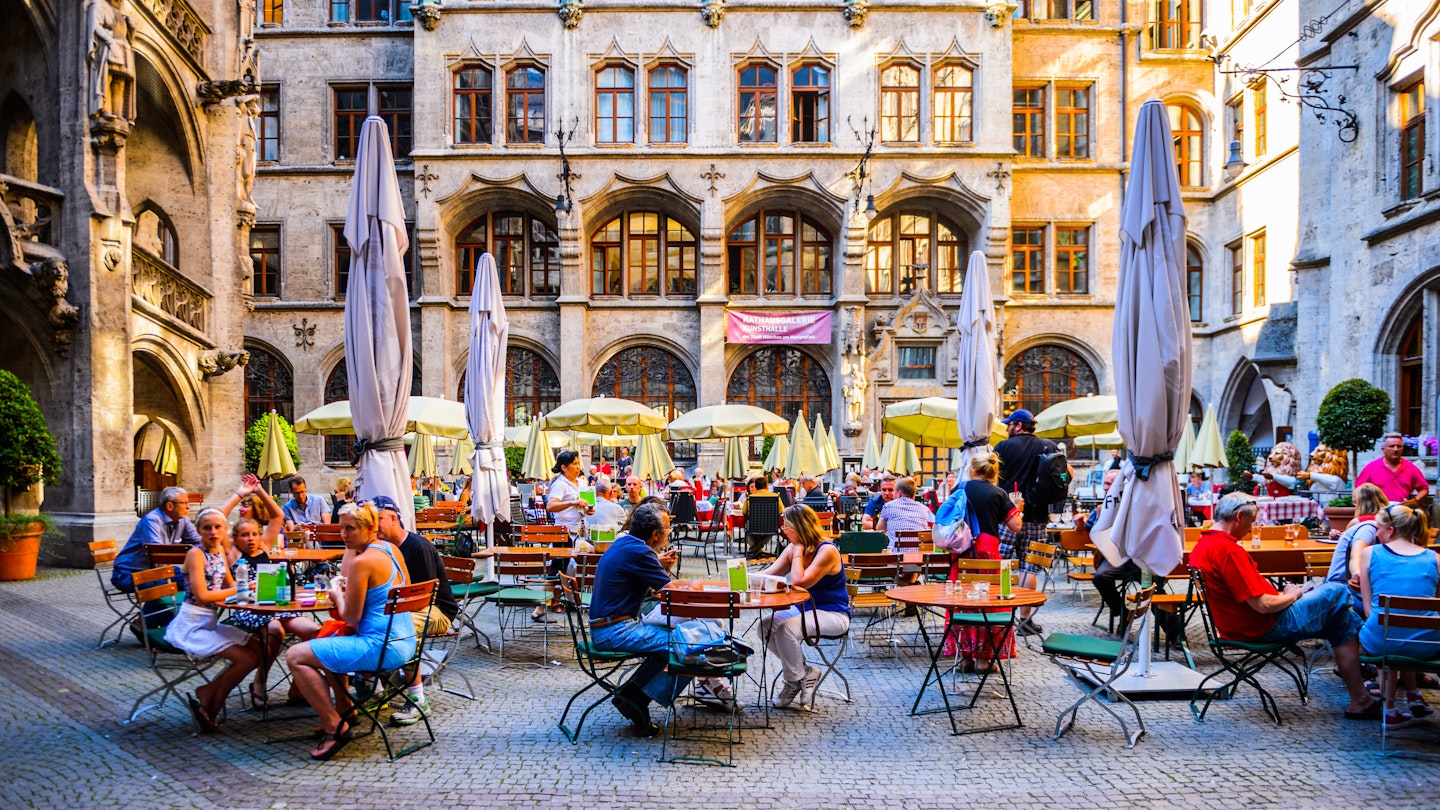
Follow this easy advice from a Munich adoptee to make the most of your trip © Anton_Ivanov / Shutterstock
Munich, Germany’s third-largest metropolis, is a city of tankards and tech, artworks and eccentricity. It's generally a safe place to visit, and few travelers have problems.
While you can get by using common sense and street smarts, following our tips will make your trip to Munich go even more smoothly.
Be aware of store closing times
Germany has strict rules on business operating hours, and most stores are closed on Sundays. For locals, Sunday is a day for rest or for spending time with friends and family. For basic groceries, you can head to gas stations and kiosks, as well as supermarkets in major train stations and at the airport, all of which are excluded from this regulation. These places are also open later in the evening during the week, when other shops must close by 8pm. Some bakeries and museum gift shops are also open on Sunday.
The same opening hours apply to public holidays; if a holiday falls on a Saturday, stores will be closed all weekend. Make sure you plan accordingly.

Always carry some cash
Although many places in Munich accept cards, smaller stores, market stalls and local food shops such as bakeries and butchers still run on cash. You may also encounter coin-only ticket machines on public transport. To avoid having to make a hasty tram exit or missing out on an irresistible baked good, it’s best to have some euros in your pocket at all times.
Reserve restaurants ahead of your trip
If you want to eat at a particular restaurant during your trip, it's worth booking a table before you travel. Whether local favorites, such as Broeding , or big names, such as Tantris and EssZimmer , popular eateries fill up fast. This is especially the case on Friday and Saturday nights, you may be turned away if you don't have a reservation.

Pack clothes for all kinds of weather
The weather in Munich can change quickly and requires a diverse selection of accessories. Hot summer afternoons can bring sudden downpours or thunderstorms, while crisp winter mornings often call for gloves and sunglasses. Check the forecast before you travel but then pack for all eventualities.
Acquaint yourself with the local accent
Munich is a thoroughly international city and you'll find plenty of people can speak English, but some German phrases will help you get by in places that are less frequented by tourists. In some spots, you may be greeted with a strong local accent.
Note that " Servus " and " Gruß Gott " are more common greetings than " Hallo " or " Guten Tag " in some areas.
Respect the green man
It’s not unusual to see people waiting patiently at pedestrian crossings in Munich, even in the absence of traffic. Jaywalking is illegal in Germany and can result in a (small) fine; however, this rule is hardly needed considering the local respect for regulations. Those who dare to cross when the light is still red should reckon with judgmental glares, indiscreet muttering or perhaps some stern words from others patiently waiting at the side of the road – particularly when children are around.

Be prepared to announce your tip to your whole table
In bars and restaurants, the bill will be brought to the table, and this is where you pay – tip and all. Before handing over your cash or card, you'll need to work out the full amount you wish to pay (rounding up to include a tip of around 10%) and announce this total to the waiter and anyone else in earshot. Tips are typically rolled into the bill; money left on the table after paying may not reach the staff.
There may be a mark-up on your drink purchases
If a grocery store bill or a round of drinks seems more expensive than you anticipated, this could be because of the Pfand (deposit). In places such as beer gardens or Christmas markets, a few euros are normally added per glass to encourage you to return your empties to a designated area once you’re finished. Deposits are often returned in exchange for a token handed out when you pay.
In grocery stores, kiosks and drinks shops, a smaller deposit often applies to bottles and cans. To get your money back, you can return empty containers to the same store – or others that accept them. Some shops have machines that scan the empty bottles and give you a receipt to take to the cash desk for reimbursement.
Be diligent about buying tickets on public transport
Rather than employing ticket barriers at stations, Munich’s public transport system relies on stringent spot-checks. These are often carried out by groups of plain-clothed staff, and riding without a ticket on buses, trams and trains can result in hefty, non-negotiable fines. You can find full details of the fine system on the Münchner Verkehrs- und Tarifverbund (MVV) website.
When traveling, you should buy a ticket at the earliest opportunity, either at the station or – if that’s not possible – from an onboard machine as soon as you get on. Sometimes you’ll still need to validate ( entwerten ) your ticket after you purchase it. Look out for the little blue boxes in stations or on public transport that you can use to stamp your ticket.

Ding ding! Watch out for speedy cyclists
Munich has an excellent and well-used system of bike lanes, and you can download maps online. These lanes are either located on the side of the road or on part of the sidewalk. In the latter case, it is quite easy to accidentally wander into the space allocated for bikes, but this is highly inadvisable.
Many cyclists, especially those on e-bikes, travel at high speeds and may not be able to stop in time. Family bikes with boxes for children, in particular, have quite some weight behind them. Luckily, all bikes are required to have bells by law, and riders aren’t afraid to use them – if you hear a ding, move out of the way quickly!
Yes, you can drink the water here
The beer is excellent, but the tap water is good too. Indeed, it pays to rehydrate if you've had a big evening on the Bavarian beer. The tap water in Munich is fine to drink and it helps reduce a hangover.

Munich is generally safe, but stay streetwise
Munich has a reputation for being a safe place to travel, and few travelers have any serious problems. Indeed, in some neighborhoods , it is not uncommon to spot bikes left unlocked or see notes pinned to lampposts optimistically inquiring about the whereabouts of missing phones or precious jewelry.
Having said that, Munich is still a big city, and you should watch your bag and pockets in busy areas and transport hubs. Take care at night and avoid poorly lit spaces or parks if you are alone.
Left something on the tram?
If you leave something on public transport, you have a couple of ways to try and locate your belongings. In the west of Munich, you can swing by the Munich Transport Company (MVG) Lost and Found Center ( Fundbüro ), where many lost items end up. Alternatively, you can try locating your items before you come via their online search function .
Save these numbers if things go really wrong…
If you get into serious trouble in Munich, dial 110 for the police or 112 for all emergency services. The police are generally friendly and helpful and often speak English.
Ready to plan your trip to Munich? Here are your next steps:
Start crafting your budget with these tips. These experiences don't cost a thing . Find out which neighborhood fits your vibe . Add these top experiences to your itinerary. Save this transportation guide to get around in Munich.
This article was first published Feb 10, 2022 and updated May 1, 2024.
Explore related stories
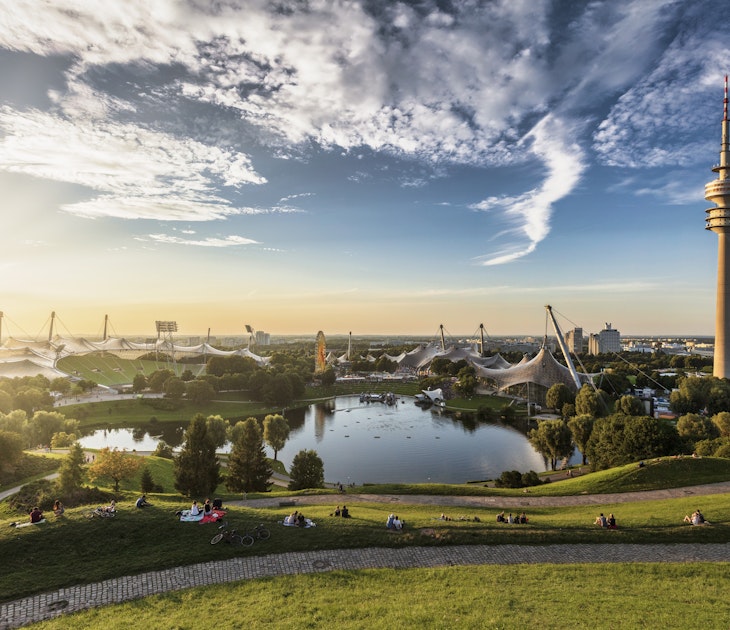
May 10, 2024 • 5 min read
From hearing live music to touring royal gardens, here are the very best free things to do in Munich.
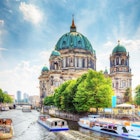
May 9, 2024 • 6 min read
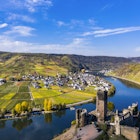
May 8, 2024 • 3 min read
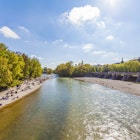
Apr 30, 2024 • 3 min read
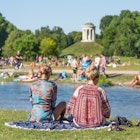
Apr 27, 2024 • 6 min read
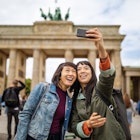
Apr 27, 2024 • 17 min read
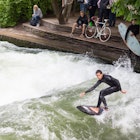
Jan 31, 2022 • 5 min read

May 19, 2024 • 5 min read

May 18, 2024 • 11 min read

25 Unique Things to Do in Munich (Plus 4 Day Munich Itinerary!)
If you’re reading this, you’re probably in the process of planning your Munich itinerary or perhaps wondering if you should visit Munich on your next trip to Europe.
The answer is simply YES. Munich is a stunning city with so much to see and experience. The city is one of the most beloved in all of Europe and despite the turmoil it has seen, it has stood strong as one of Europe’s center points for interest and tourism.
As someone with German heritage, I have spent myself thinking often about a visit to Germany, so our summer plans involving several weeks in Germany has ignited an inspiration in me to explore the stomping grounds of my ancestors and learn more about the history of a nation that has created so many waves in society.
I will be blunt in saying you need a week or more to really see Munich, but time is short and there is so much to see in the World, so we’re going to work with the typical visit time of 4 days.
Our mission is to give you a big enough taste to whet your appetite and leave your memories of Munich as magic. Not just a Munich City guide but and actual layout based on our own experiences in the city.
Don’t leave home without: Lonely Planet Germany (Travel Guide)
Things to do in Munich – Day 1
Table of Contents
Today is your first full day in Munich and it’s time for you to get acquainted with the city. While Munich may be one of Europe’s big cities, you’ll find the main area of the city is surprisingly small and easy to navigate.
We spent 3 weeks in Germany : Check out our Germany articles !
Take A Free Walking Tour of Munich

Grab yourself a hearty breakfast at your hotel in the morning before heading off to the Marienplatz main square to join up with the Free Walking Tour of Munich by Sandemans NewEurope.
Many people that we talk to are wary of joining up with these types of tours because they don’t understand how they work. The tours are literally free of charge.
They usually last 2-2.5 hours and take you to the most popular areas of the city by a knowledgeable and cheery guide. You’ll learn some of the history of the city, a bit about the Nazi Occupation and some pretty great stories about the people that lived in and built up Munich.
While you are under no obligation to do so, the guides work for tips, so at the end of the tour you just tip the guide and go along your way.
We have found this is the single best way to acquaint yourself with a new city on your first day and highly recommend looking into the free walking tours in every European city.
Don’t Miss the Rathaus-Glockenspiel
Your tour should end back at Marienplatz just in time to catch the 12pm showing of the famous Glockenspiel. Part of the second reconstruction of the new Town Hall, this Rathaus-Glockenspiel dates back to 1908 and performs every day at 11am. During the summer, it also performs at 12pm and 5pm.
Lasting 12-15 minutes, it is a beautiful feat of old-time entertainment and a depiction of a royal wedding. The square will be packed during the performance so be mindful of your belongings as it’s prime time for the pick pockets.
Lunch at the Hofbräuhaus
If you joined the first free walking tour around 10am, then you will be done around 12:30pm. Grab some lunch at one of the World’s most famous beer halls, the Hofbräuhaus .
Serving typical German fare and liter sized beer steins of their own brew, this place is all about the atmosphere as lederhosen clad staff sling beer steins across tables and sweet smiling ladies carry around baskets of freshly backed pretzels. Just remember not to have too many liters at lunch, you have a city to see!
Church of Our Lady Munich
This church is located slightly off the main square and has an interesting story regarding the building of the church. Back in the day, building a church of this size would take many years. Think, 80 years or more, so you can imagine the surprise of the people when this particular church was completed in just 20 years.
Legend has it that the devil himself assisted in the building of the church, giving the reason as to why it was completed so fast. He ordered a church to be built with no windows, so that he could enter the house of God and spread his vile teachings while being obstructed from the light of day.
Now, the builders were clever and constructed the back of the church without windows, so when the devil would enter, he would think the church was built without windows.
Much to his surprise, the day it was finished he decided to take a stroll to the front of the church where he discovered massive windows letting in the light from the heavens.
In a fit of rage he stamped his foot and disappeared leaving a large footprint in the back of the church. Whether you believe the story or not, it’s worth a visit to to place your foot in the print of the devil.
St Peter’s Church
After you’ve compared shoe size with the devil, head over to the St Peters Church, poke your head inside and then step out the back and climb the tower.
If you want to enjoy a view of the entire city center from the tower you must climb no less than 299 steps. Once you reach the top, the panoramic view of Munich’s center makes up for the effort. When the weather is very good you may even catch a glimpse of the Alps in the distance.
There is an entrance fee for the observation deck of 2 euro per person and it is worth it to spend a little loose change for the telescopes that allow many an interesting detailed look at the Old Town once you reach the top.
Read reviews and check prices with our Hotel Search Engine , that gives you the best hotel deals found on the web. Our search engine pulls results from all of the major booking places, including Expedia, Hotels, Booking and more. All the options, all the deals, all in one place and just for you.
What to do in Munich – Day 2
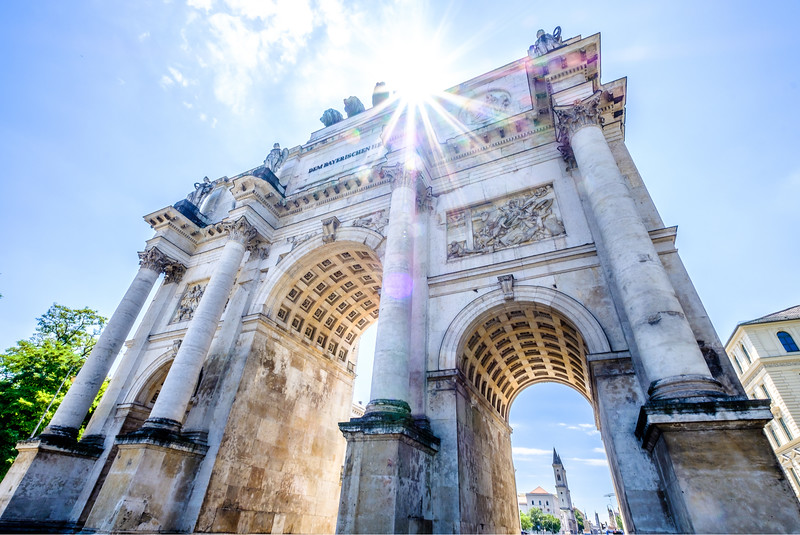
Now that you’ve had a taste for some of the old city, take a journey into history to learn more about the people that have lived and occupied Munich. Our Munich itinerary takes you first to the outskirts and then back to the city center.
Visit Nymphenburg Palace
Try to start your day early today by getting to breakfast at your hotel right when it starts. Then head outside and grab the local tram for a journey to the Nymphenburg Palace that is just outside the city center.
If you time it right, you will arrive right when the palace opens and you will have the place almost to yourself having beat the tour buses.
I recommend buying the ticket that gives you access to everything on offer, although if your budget is tight or you are short on time, then I wouldn’t miss the main museum exhibits and the stable.
No matter which ticket you buy, head straight into the main museum to get a good head start on the crowds. This should afford you an almost undisturbed visit.
Just as you make your way towards the stable, you’ll see the buses arrive and can smile enjoying the stable alone as well. The gardens can be visited without a ticket and are worth a stroll. After your visit, hop back on the tram and head back towards the city center.
Third Reich Afternoon Walking Tour
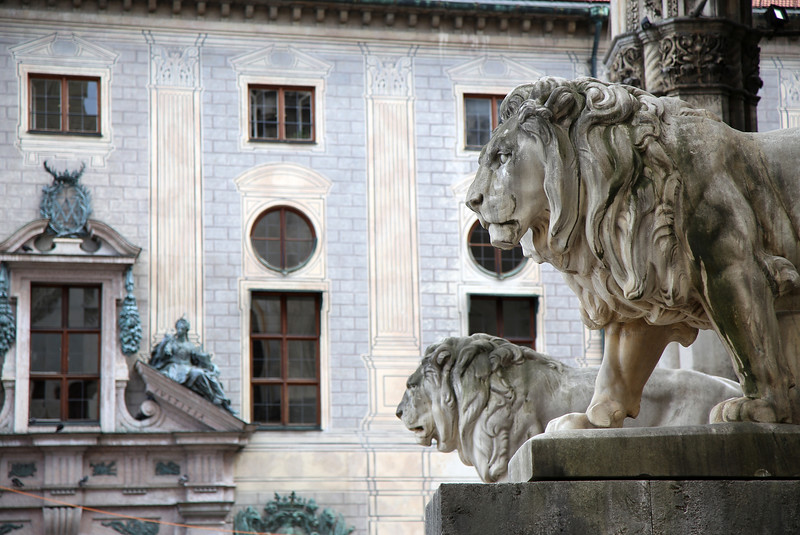
If the history of the Nazi occupation and rise interests you, then we can recommend that you take a Third Reich walking tour in the afternoon. Just make sure that it ends before 4pm so you have time to head over to the Royal Residenz.
Related Article: Vegan Guide to Munich
Royal Residenz
The secret to visiting this beautiful museum is to arrive late in the day. Most of the tour groups will have left and there will be very few people wandering inside the museum.
You won’t be able to take too much time, but if you arrive at 4pm, you’ll have 2 full hours to walk the museum before it closes during summer hours. We are not lying when we tell you that you’ll have the place to yourself with the exception of the odd audio guide listener.
Walking the hallways without tour groups is an almost haunting experience and something you will experience very few times in your life. Getting there late in the day is crucial if you want this experience. Be sure to buy the full ticket that gives you access to the main museum and the theater.
Dinner at Ratskeller München
Rest your weary feet after a day of exploring in the underbelly of the city. Located underneath the Marienplatz town hall, in the old beer cellars, is the delightful traditional German beer house and restaurant of Ratskeller .
Make reservations the day before and be prepared to enjoy local sausage specialties and a variety of top brewed German beers on your visit. I can personally recommend the German white sausage,
Wolwürst that comes with mashed potato salad and kraut. Start with a small beer because you may not get all the food and drink in your belly otherwise! As absolute must on your Munich itinerary.
Munich Itinerary – Day 3

You’ve spent 2 days in Munich and only scratched the surface yet it’s imperative that you visit some of the sites on the outskirts as well.
Dachau Concentration Camp
After your morning coffee, hop back on the local transport and take the train out to the Dachau Concentration Camp . It is a 30-minute ride and you don’t need a tour to visit.
The camp is well signed with easy walking directions from the train stop into the main camp. While this might seem like a disturbing visit for some people, it is incredibly important that you visit a concentration camp to learn about what happened there, how it happened and why it happened.
Each building is open and has been made a museum giving you an up close look into the life of the prisoners and guards that occupied Dachau during Nazi Germany.
It’s a moving experience and you will need the whole morning for the visit so be sure to arrive right when it opens. After your visit, take the train back to Munich. Read about our first hand account of Visiting Dachau Concentration Camp, Munich here.
English Gardens and River Surfing

When you return to the city from Dachau, grab a bite to eat and make your way to the English Gardens. This is the best way to follow up such a contemplative visit as the concentration camp and give you some time to process your thoughts. A great way to see this area and the neighboring historic center in a small group setting is by Segway tour .
This park is the epitome of nature in a big city and a fabulous way to get away from the hustle in Munich (it’s a very busy city). Be sure to take a few moments to watch the river surfers catch some waves. Yes, skilled and experienced surfers catch waves in the river that flows through the park.
Alternatively, you could head over to Olympic Park and the BMW manufacturer for a tour if you are looking for something a bit faster paced.
Things to do in Munich – Day 4

Munich is strategically places in South Germany leaving you many options for exploring outside the city. The only downside is that you can’t combine them all in one day.
Each takes a day and it can be very time consuming if you get caught up doing day trips outside the city. A solid week will allow you to take a couple day trips and see the heart of Munich. In 4 days, you really only have time for one of two day trips.
Take a Day Tour to Neuschwanstein Castle
Just 1.5 hours from Munich you can find yourself at the foothills of the Alps, wandering a tiny Bavarian village with pretzel in hand. The main draw to this area is the fabled castle of Neuschwanstein , built by the mad King Ludwig II and completed in 1886.
It was a respite for the withdrawn King and after being removed from the throne, he only spent 11 nights in his beloved castle before he was murdered.
Witness the fairy tale castles of Neuschwanstein and Linderhof, created by Germany’s 19th-century King Ludwig II, on a day trip from Munich .
The castle is spectacular, set in a mountain setting and it’s hard to visit without conjuring up thoughts of fairy tales and royal musings. There are several places to view the castle from and people wishing to capture great photos should arrive in the early hours to beat the hoards of tourists that visit the castle.
You can visit in one of two ways, take the bus from Munich on your own- it drops you in Hohenschwangau and you then walk up the hill to the castle or take a day tour that will also include a ticket to visit the inside. For a detailed guide, read our article How to Visit Neuschwanstein Castle from Munich .
Unless you are well planned in advance, getting at ticket to visit the inside without a tour or advanced reservation will be nearly impossible in the summer.
Opening hours of Neuschwanstein Castle
April to 15 October: 8 am-5 pm 16 October to March: 9 am-3 pm Closed 1 January and 24 / 25 / 31 December
Admission charges to tour Neuschwanstein Castle: 13 euros regular · 12 euros reduced Children and young people under 18 are free.
Königsticket (King’s ticket) for both Neuschwanstein Castle and Hohenschwangau Castle on the same day: 25 euros regular · 23 euros reduced
Kombiticket “Königsschlösser” (combination ticket King Ludwig II’s palaces): 24 euros The combination ticket is valid for six months; you can visit each of the places Neuschwanstein
Other Day Trips from Munich

Due to the location of Munich, you have access to some pretty amazing day trips during your visit. You could easily fill a week of travel with visiting the city and the surrounding area.
There are so many options that we wrote a dedicated article about the Best Day Trips from Munich , highlighting our favorites.
Just remember that each one of these will take a full day to experience, so choose wisely and based on your preferences. The only ones that combine are a visit to Dachau and Neuschwanstein on the same day but I personally feel Dachau deserves more time than you will get on a combined trip.
More on Things to Do in Munich
Seriously, this is why you visit Germany, right? We’re not big drinkers but we enjoyed sitting in the brew houses for the atmosphere. Imagine Bavarian music bouncing around the room from the acoustics while German waiters and waitresses serve you dressed in their best lederhosen. The pretzel seller walks around, you grab a bite and drink down some of Germany’s famous brews. It is all about the atmosphere and must not be missed.

Drinking beer in Munich should be accompanied by a visit to any of the BratwurstHause’s you can find. Throw your diet to the curb and try all of the sausage delights on offer with a little sauerkraut on the side. They also serve an interesting German potato salad if you can manage to squeeze that into your belly.
Attend Oktoberfest
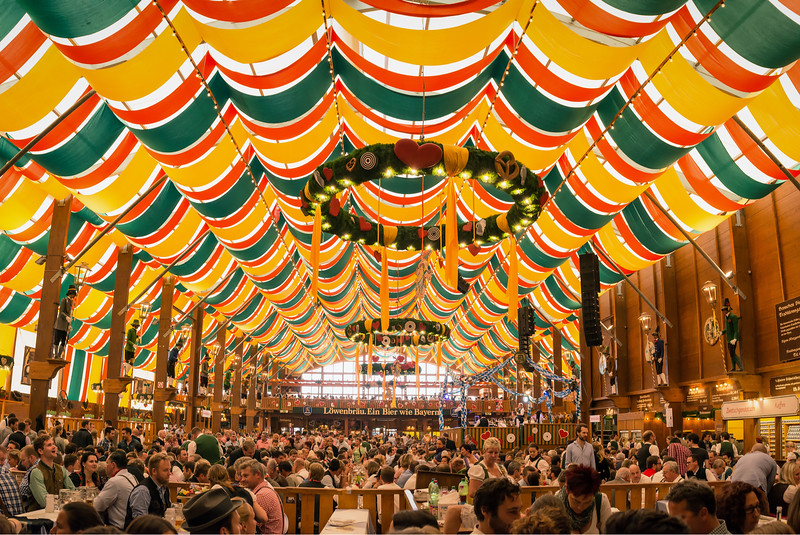
If you’re traveling Munich in the Fall, consider planning your trip around Oktoberfest. Arguably the biggest beer fest in the world, this is a cultural and entertainment event not to be missed. You can even pick up your own lederhosen and join in on the fun.
Basic Information for Visiting Munich
Accommodation.
Location is essential to maximize your time in the city. Personally, we prefer to stay near the train station so when we arrive, we can walk a short distance to our hotel and drop our bags. There is a variety of options in the city to suit every budget.
We stayed at the comfortable Hotel Jedermann , located within a 5 minute walk of the central Munich train station. The location was outstanding for us with a 10 minute walk to the city center and front door access to the tram and metro. Read reviews for Hotel Jedermann at TripAdvisor .
It made exploring the city very easy and the service was impeccable. We had a private double room with bathroom that included breakfast. The breakfast was a huge, beautiful buffet with any options.
Other top recommended hotels in Munich, Germany we recommend based on price, rating and location are Hotel Splendid-Dollmann , The Charles Hotel , and the Mandarin Oriental, Munich .
Transportation
The city is well connected with public transport, so reaching things that are outside the city center are very easy to do. Any of the day trips that I mentioned above can easily be done on your own by using the local train system as well. Alternatively, you can book group tours ad nauseam or even rent a car to explore outside the city. Perhaps Munich can be the start of a German road trip adventure for you?

Germany is on the Euro and you can access the Euro in a number of ways. If you are arriving at the airport, you’ll find a variety of ways to either exchange cash or withdraw from an ATM in local currency. Within the city and at your hotel you will be able to exchange cash but be careful of exchange rates.
Ripping off tourists on money exchange is an age old past time around Europe. Don’t sign anything until you have double checked the rate and sure you are getting the right exchange rate.
Planning to visit Munich as part of a Germany road trip? We use Discover Car Hire for comparing car prices to find the best deal. They search both local & international rental companies.
More on Germany:
- Driving in Germany? This is the Ultimate Germany Road Trip Guide
- 30 Germany Photos That Will Spark Your Wanderlust
- 13 Perfect Things to do in Hamburg, Germany
- Things to Do in Nuremberg-2 Day Nuremberg Itinerary
- Germany’s Romantic Road: The Only Guide You Need
- 20 Simply Unreal Castles in Germany to Visit
- 10 Best Day Trips from Munich Worth Doing
- How to Visit Neuschwanstein Castle from Munich
- Elegant Elbe River Cruise with Viking River Cruises
- Viking River Cruises in Europe-What to Expect
Did you like this story? Share it!
Travel planning resources, about lina stock.
Lina is an award-winning photographer and writer that has been exploring the world since 2001. She has traveled to 100 countries on all 7 continents. Member: SATW, NATJA, ATTA, ITWA
19 thoughts on “25 Unique Things to Do in Munich (Plus 4 Day Munich Itinerary!)”
Can anyone tell me what the weather in Neuschwanstein looks like in late March? Are the trees green or bare? Is it beautiful in this time of year? Is the scenery surrounding Neuschwanstein and other palaces nice at the end of March or is it better to visit them in summer? Thank you so much in advance.
I haven’t been to the south of Germany in March, so I can’t say for sure but based on the winter they get I would think you will be too early for spring bloom. Closer to May would probably be better if you are looking for green trees.
we will be in munich the week before Christmas to visit some of the Christmas markets. How is the weather this time of year if you know. We want to see some of the castles, but have concerns about road conditions in those areas. Would it be better to just spend 2 nights in Munich and then plan on staying in the other christmas market towns?
Thanks in Advance.
Hi Brooke, I would imagine the weather will be cold. Not sure they will have much snow, but it is possible for some. I highly recommend checking local forecasts about 2 weeks before your departure date to get a feel for how the weather will be. As far as road conditions, it will all depend on the weather. If they’re not getting a lot of snow or rain I would think travel to the castles you want to see would be perfectly fine. If you’re hesitant, you always have the option of taking a day tour or the train. Hard to say what will be better. 2 nights in Munich and then a couple of nights in some other towns (don’t miss Nuremberg!!!) is great too. It’s all a matter of preference of what you feel is right for you. No matter what, the Christmas markets should be epic. Safe travels, Lina
Hello! I’m looking to book a 4 day trip over New Years Eve as a surprise for my wife. Will attractions and shops/bars still be open to see and would you recommend Munich for new year? Thanks!
Hi Ross, that sounds like an amazing surprise for your wife! Munich will be cold then but there are plenty of museums to visit. It seems that Munich has quite the party in the center of town for New Year’s, so I imagine that would be fun to attend. Can’t tell you for sure on restaurants and shops, might be worth inquiring with one of the hotels in the city. Good luck with your planning, you’ll love Munich.
Hi! I’ll be in Munich in May! My first time to Germany! So we are in Munich 3 days, one for Munich, one is a day trip to Ludwigs castles, and can’t decide if the third day should be a trip to Nuremberg or Regensburg!? The gingerbread has me leaning towards Nuremberg. Haha. I have been trying to decide this for months! Thanks! Christina
Honestly, 1 day in Munich is not enough! I would spent that extra day in the city rather than trying to make a day trip to Nuremberg or Regensberg! Don’t get me wrong, Nuremberg is a great place to visit and we loved it, but it’s a long day trip. No matter what you decide though, you’ll love Germany. Enjoy!
Yeah, I was thinking that too…Munich looks amazing and I really want to absorb all of it! Thank you so much! I LOVE your blog and website, wow…you are my inspiration!! 🙂
Hey. I love your post. I’m planning to go in September for about 2 weeks. I’ll be traveling by myself, and I have penpals all over Germany. I was wondering traveling by train is easier, be a use I’m not able to get a car over there. Do you have any advice for trains/buses and lodging either hostel or Airbnb??
Hi Lindsay, You can easily take the train between cities instead of driving. They also have a great bus network if you prefer that. In terms of lodging, both of those are great options so it really depends on your budget! We use both when we travel. enjoy Germany, it’s a fantastic place to visit.
Very nice post. My wife and I will be there in March for 11 nights. As we will be taking at least 5 day trips is it best to buy train tickets a day at a time or is there a better option? Any other suggestions for day trips as we will have plenty of time?
Hi Tony! In March you should be fine purchasing your tickets the day before or same day as travel. As far as purchasing them all at once or one at a time, that will really depend on your travel schedule. We typically buy them one at a time so that if we end up somewhere we love, we can stay longer or the opposite, if we get bored, can move on sooner than we originally planned. There is one day trip that we thought would be interesting, a trip to the Eagle’s Nest, Hitler’s hideout in the mountains. We didn’t have the time for it on the last visit, but thought it would be a good one! Might want to look into it, not sure if it will be an option in March, will depend on how much snow they have. Cheers and enjoy!
Hi …i am lina and with my husband we will be going to Munich in March …looking forward to go and reading about Munich made it more interesting…so thank so much for your help …
Excellent! You’ll love Munich, if you have any questions don’t hesitate to ask. Cheers!
Your photos are stunning! They give Munich’s beauty justice. Headed there in two weeks to visit family, can’t wait!
Thank you!! I tried really hard to capture Munich in that light and it wasn’t easy! We had so much rain during our visit, I’m wishing better weather for you. 🙂 You’ll love Munich.
Beautiful pictures. Always wanted to go Germany.
Germany is stunning! Stay tuned for our post that contains stunning photos from all over the country. 🙂
Leave a Comment Cancel reply

Plan Your Trip to Munich: Best of Munich Tourism
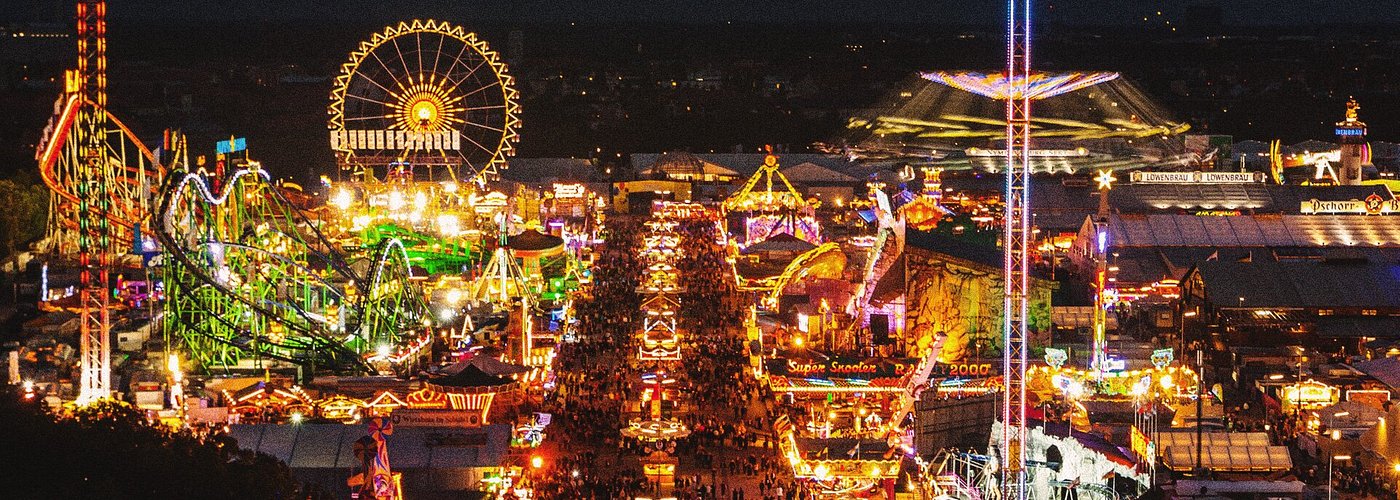
Explore Munich
Travel advice.

Embrace Europe’s great outdoors
Essential munich.
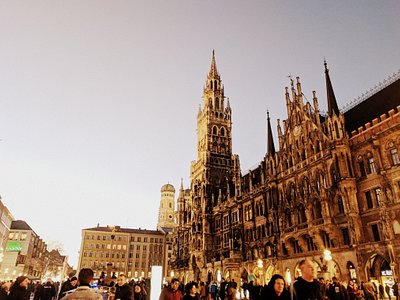
How to do Munich in 3 days

How to Enjoy Oktoberfest Year Round in Munich
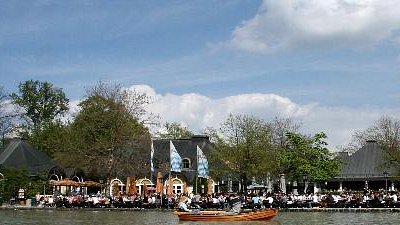
Browse collections

Munich Travel Guide
Travelers' pro tips or experiencing munich.

Eating out might get expensive in Munich. Remember the secret of Bavarian beer gardens, though: You are allowed to bring your own food!

Munich is a typically efficient German city. Follow the orderliness, and you'll blend in well.

While in Munich, a visit to the Viktualienmarkt, the local Farmers Market, is a must. But wear comfortable shoes for all the walking you do as you visit the various booths.

Rambling Lawyer
The Munich Christkindlmarkt is one of the largest in the world, but actually there are about two dozen Christmas Markets in Munich and its surroundings alone. A good source of information about what's coming up is muenchen.de.
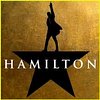
Basically, we can not predict the weather. Last year it was hot in the spring and rather cool in the summer. Could be the opposite this year. Best advice is to go with layers: T-shirt and shorts would usually be fine, but have a jacket with you in case of cooler nights.

Getting around Munich is easy on public transportation. If you are going to be in the city several days, you can get a 3-day pass for use on all trains, subways, buses, and trams.
One of the first reasons that many visitors come to Munich is the world-famous Oktoberfest, but while Munich beers are definitely excellent, the city offers much more to discover — both in winter and in summer — including the charming historical center, the beautiful green areas, and many art galleries.
According to polls, Munich is the German city that most Germans would like to live in, if they could. It actually is composed of several smaller towns, and since no buildings taller than the tallest church steeple are allowed according to building code, the center feels like a town.
One reason that more and more people move to Munich is the high quality of life you can enjoy here. Bavarians just know how to take good care of their environment! Take for example the beautiful urban parks where you can enjoy a variety of different sports, or just relax after work in clean, peaceful surroundings. Furthermore, Munich is only a 1-hour train ride away from the Alps and beautiful lake regions. In short, anybody who loves nature and outdoor activities is bound to love Munich!
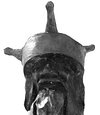
Munich is a well known and popular destination for people from all over the world. With a friendly relaxed living style, and plenty of attractions for visitors of all ages, Munich has it all.
What is the best way to get there?
Munich International Airport is located 18 miles (30 kilometers) northeast of Munich. The S1 and S8 S-Bahn trains depart for the city center every 20 minutes. The journey takes around 45 minutes.
Munich is well connected with other cities in Germany and Austria by the German autobahn network.
Munich Central Station (Hauptbahnhof) is conveniently located in the center of Munich and well connected to Munich's excellent public transport network.
Long-distance buses from other European cities (notably the Balkans and Central Europe) provide an inexpensive way to travel to Europe. Buses arrive at Munich Central Bus Station.
Do I need a visa?
If you’re visiting Munich from overseas, visit the Federal Foreign Office for information
When is the best time to visit?
Many visitors come to visit to celebrate the city’s famous Oktoberfest but, if you want to avoid crowds, between March and May is an ideal time. Fall’s crowds have long gone and summer's peak season hasn't yet begun. Average high temperatures are the high 40s °F (10 C) in March and high 60s °F (19 C) in May.
Munich’s largely traffic-free city center is best explored on foot.
public transit
The city’s dense public transportation system consists of suburban trains (S-Bahn), underground trains (U-Bahn), streetcars (Tram), and buses. There is only one ticket system, called MVV, which means you can use all modes of transportation with the same ticket. If you plan to use the system several times in one day, buying a day ticket can save you money
With its network of bike paths, Munich is a very cyclist-friendly city. The local dockless bike-sharing scheme is called Call-A-Bike.
Taxis are generally easy to find at ranks, train stations or on the street.
ridesharing
Uber is available in Munich on your smartphone.
On the ground
What is the timezone.
Central European Standard Time
What are the voltage/plug types?
In Germany, the standard voltage is 230 V and the standard frequency is 50 Hz. The plug type is F and has two round parallel pins.
What is the currency?
Are atms readily accessible, are credit cards widely accepted, how much do i tip.
A tip of around 10 percent is expected.
Are there local customs I should know?
The federal legal age for buying and drinking beer and wine is 16 years old. For other drinks, it is 18.
Cheers the right way
When you are toasting your companions with a drink, make eye contact and say a hearty “prost” as you clink glasses — clink with the bottom of your glass
Share table space
At many Munich restaurants, especially beer gardens, you are expected to share tables with other diners so don’t take up too much space.
Table manners
Wait for everyone in your party to get their food and say “Guten Appetit” before tucking in.
Germans are punctual and showing up late is considered rude.
Public transit
Let passengers off before boarding. Offer your seat to elderly and pregnant people and to those with disabilities.
Walk to the right of the sidewalk and step off to the side of the sidewalk if you want to stop to check your phone, look up directions, or want to take in a view.
- Sofitel Munich Bayerpost
- Platzl Hotel
- Hotel Torbraeu
- Hotel Metropol by Maier Privathotels
- Hilton Munich Airport
- Hofbräuhaus
- Little London Bar & Grill
- Ratskeller Munchen
- Steinheil 16
- Risotto Restaurant Munich
- Marienplatz
- English Garden
- Neuschwanstein Castle and Linderhof Palace Day Tour from Munich
- Third Reich Walking Tour Munich
- Dachau Concentration Camp Memorial Site Tour from Munich by Train
- Neuschwanstein Castle Tour from Munich
- Neuschwanstein and Linderhof Castle Day Trip from Munich

37 Of The Best Things to Do in Munich, Germany
Written By: The Planet D
Updated On: February 8, 2024
If you haven’t been to Munich you are missing out! The capital city of Bavaria is filled with history and beer halls, green spaces, and plenty of museums. Whether you are visiting Munich for its famed Oktoberfest or simply enjoying its beer gardens and upbeat energy, you are going to love your time in Munich. These are the best things to do in Munich, Germany that you cannot miss!
Table of Contents
Best Things to Do in Munich
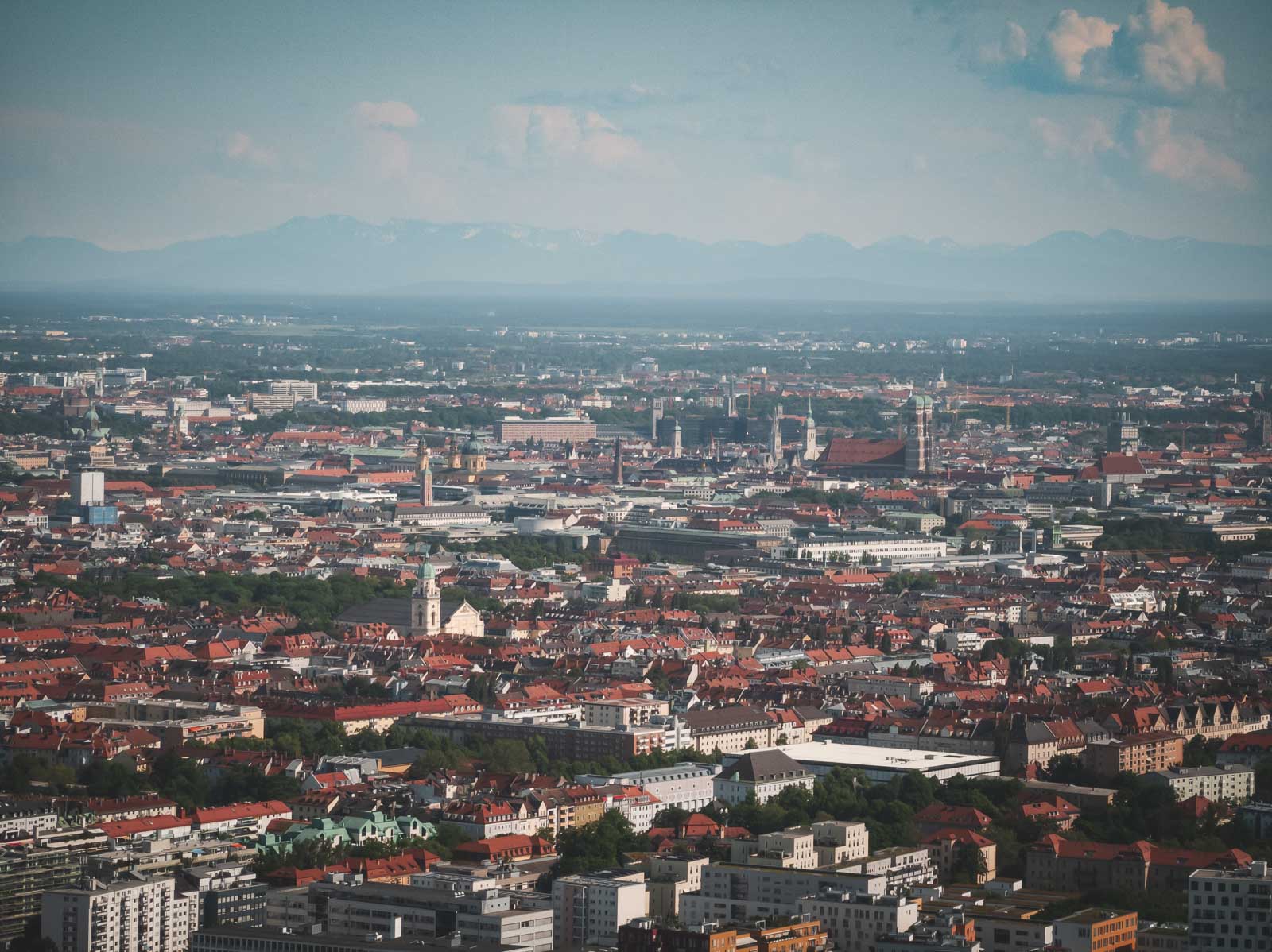
Munich is the capital and largest city of the German state of Bavaria, located in the southeastern part of the country. With a population of over 1.5 million people, it is the third-largest city in Germany after Berlin and Hamburg. Munich got its name from the monks who founded it. München means monk in German, hence the name Munich.
If you are planning a road trip through Bavaria or simply traveling around to see the best cities in Germany, you are going to love Munich. We are highlighting the best places to visit in Munich that you simply cannot miss! You may also like: The Essential Guide to Germany’s Romantic Road
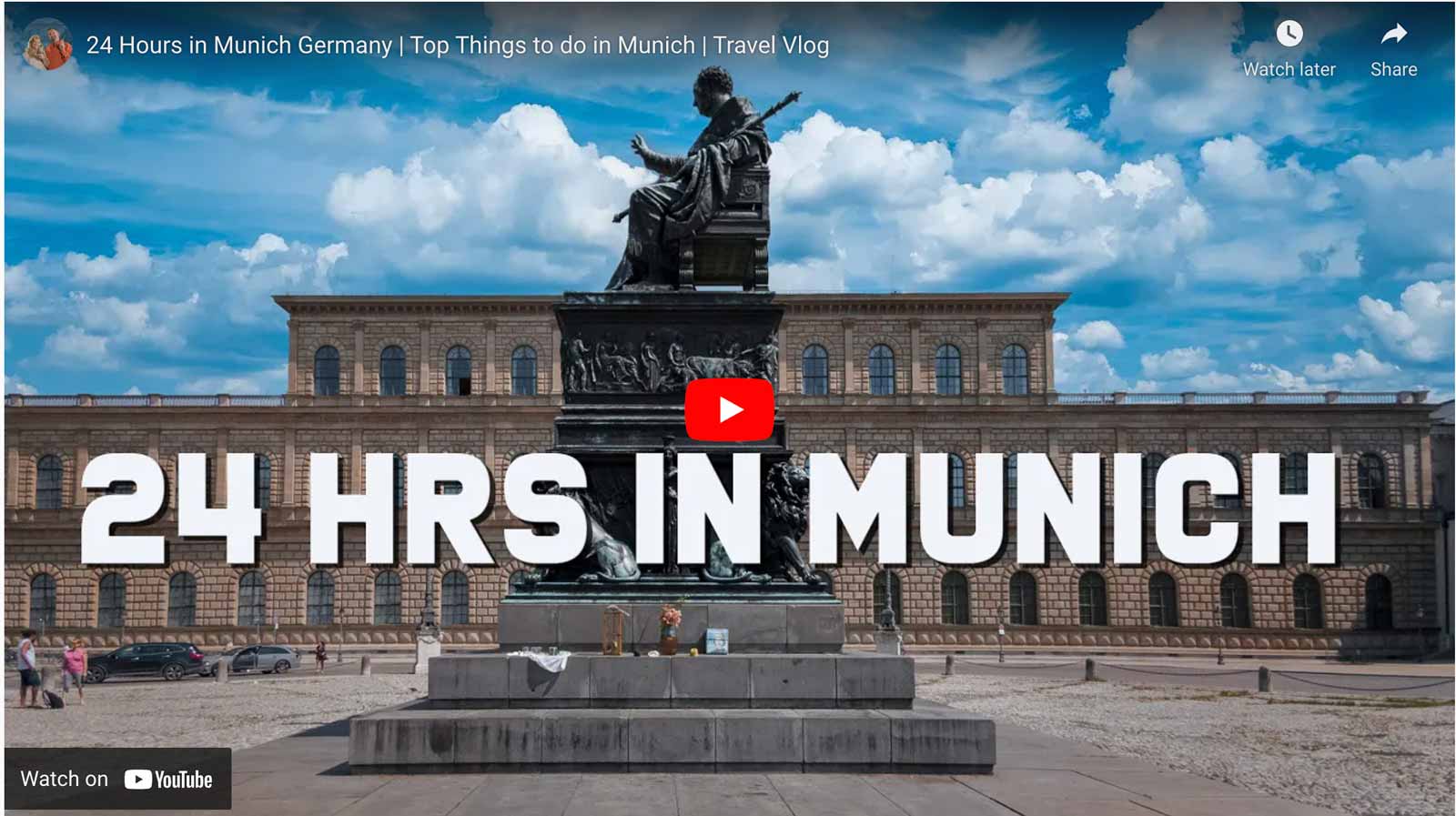
With its long history dating back to the middle ages to its modern achievements being a hub of innovation and technology, Munich blends the old and new with ease. The city is home to many international corporations, including BMW and Siemens, and is home to many world-class universities and research institutions.
Do you want easy access to all the top places to visit in Munich? Booking the hop-on-hop-off-bus lets you choose from a 1 or 2 day ticket to see the top attractions in Munich. The bus stops at attractions in the city center, Old Town, English Garden, and outside including Nymphenburg Palace and Olympic Park.
1. Marvel at Marienplatz
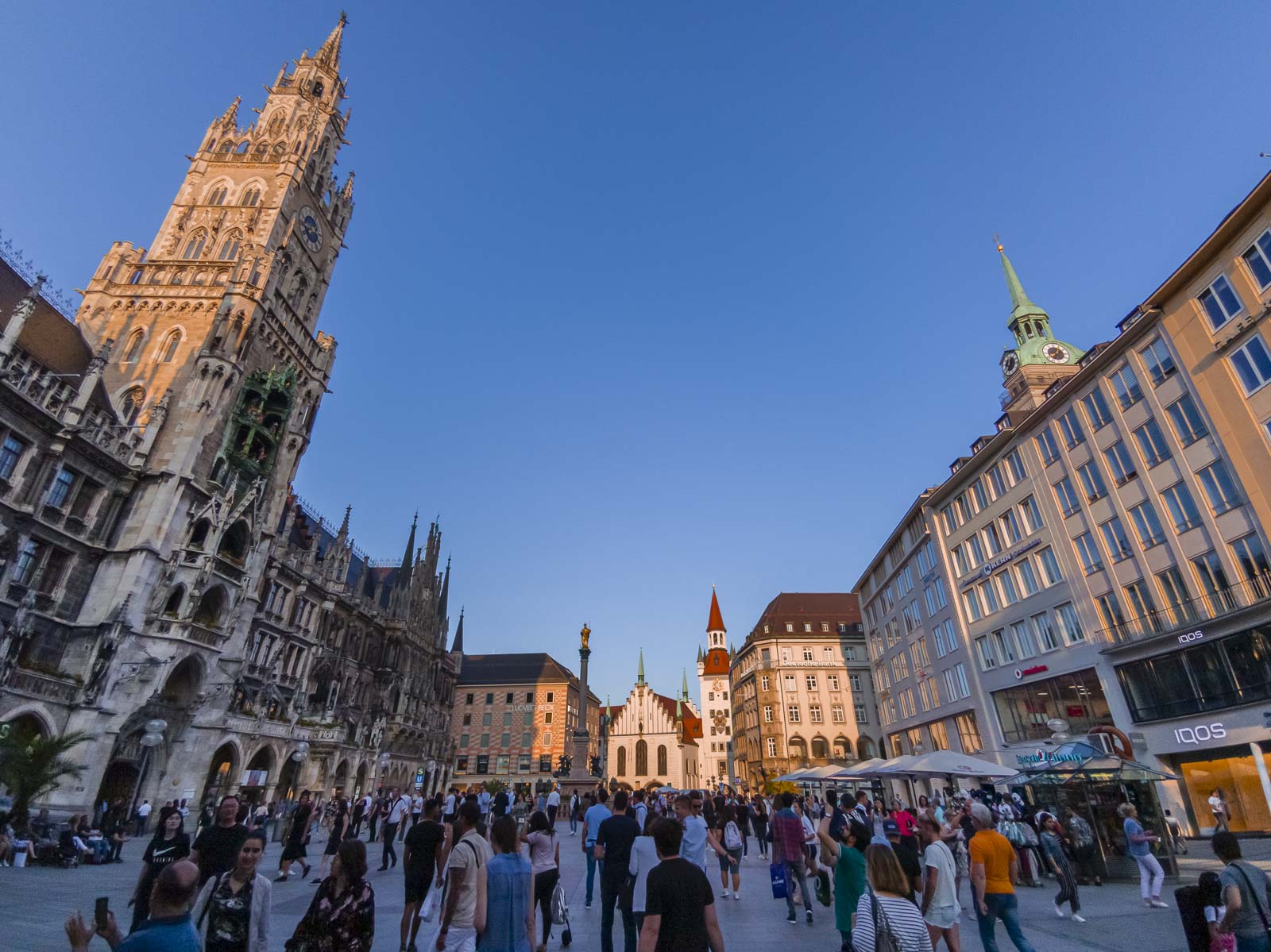
One of the first places you must visit in Munich is Marienplatz. It’s the heart of the city and the meeting point for most tours. Marienplatz got its name from the Marian column that was erected to celebrate the withdrawal of Swedish troops after the 30 Years’ War. You can see the golden statue of Mary at the top of the altar. It also houses the Old Town Hall (Altes Rathaus) and the New Town Hall (Neues Rathaus).
This is the place to be in the evening in search of shopping and cafes, but we suggest visiting in the morning when the crowds are at their least.
The best way get acquainted with a city is to take a walking tour, this highly rated Munich city walking tour starts in Marianplaz where you’ll see the old and new town halls before walking to see the city center highlights such as Frauenkirche and the Munich Residenz. You’ll then make your way to see some of Munich’s famous beer halls and the English Garden. You can book your tour in advance with easy cancellation (full refund) within 24 hours of activity.
2. Neues Rathaus (New Town Hall)
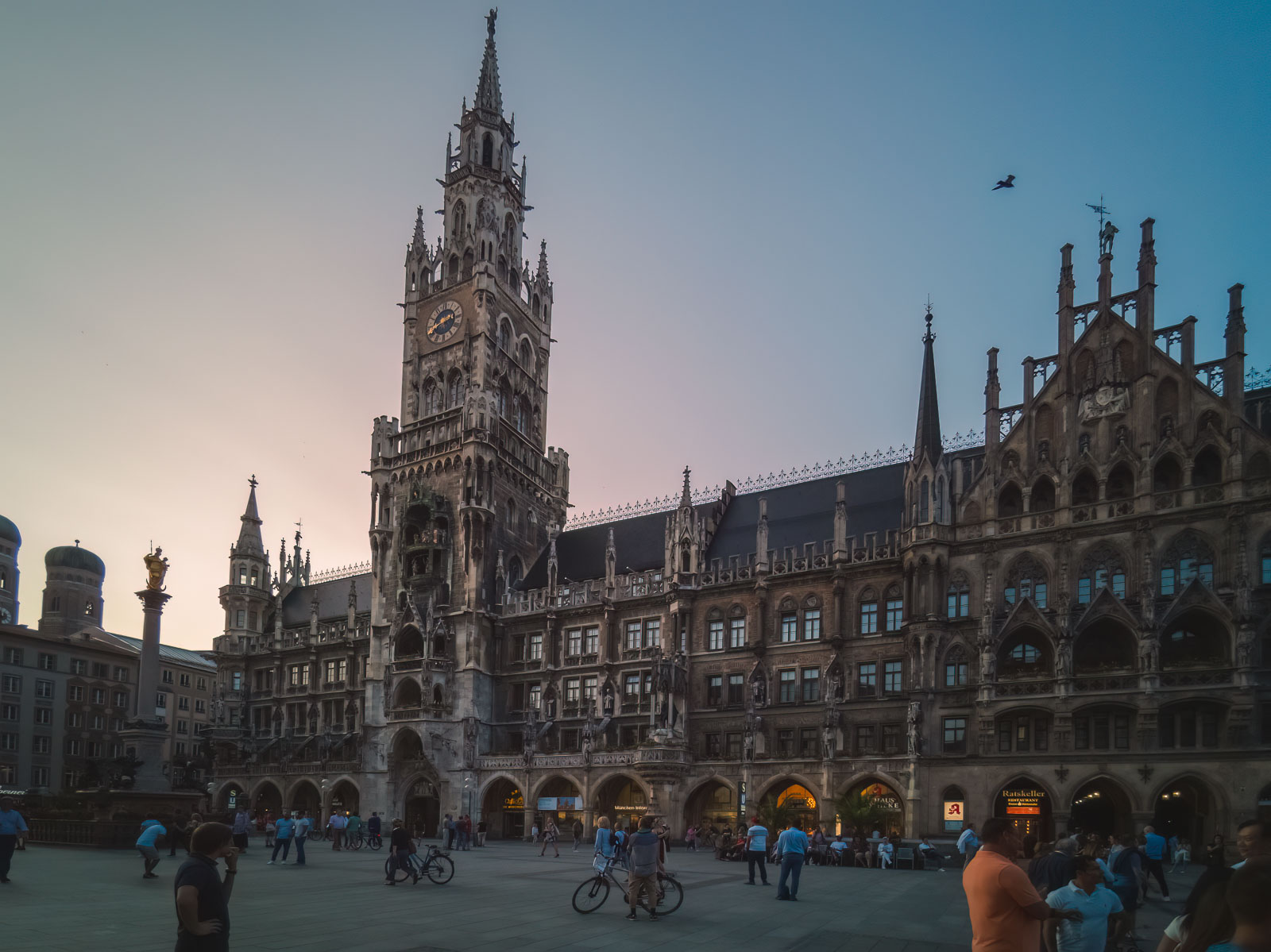
Neues Rathaus is a stand out of the square with its imposing Neo-Gothic facade standing front and center. Completed in 1905, it replaced the old city hall as the headquarters for local government when Munich’s population boomed during the final decades of the 1800s. Visitors can go inside to climb to the top of the observation tower for a panoramic view of the city.
The New Town Hall features a clock tower that stands at 85 meters tall. It serves as the seat of the Munich city council and the mayor’s office, and it houses various administrative offices. The building also includes a large ceremonial hall that is often used for public events and concerts.
This Old Town Guided Walking Tour takes you to the top attractions in Munich’s city center. You’ll see Neue Rathaus, Marienplatz and Frauenkirche plus, you walk along Maximilianstraße to the Residenz and you’ll end up at Viktualienmarkt to enjoy a coffee or wine with the new friends that you made.
3. The Glockenspiel
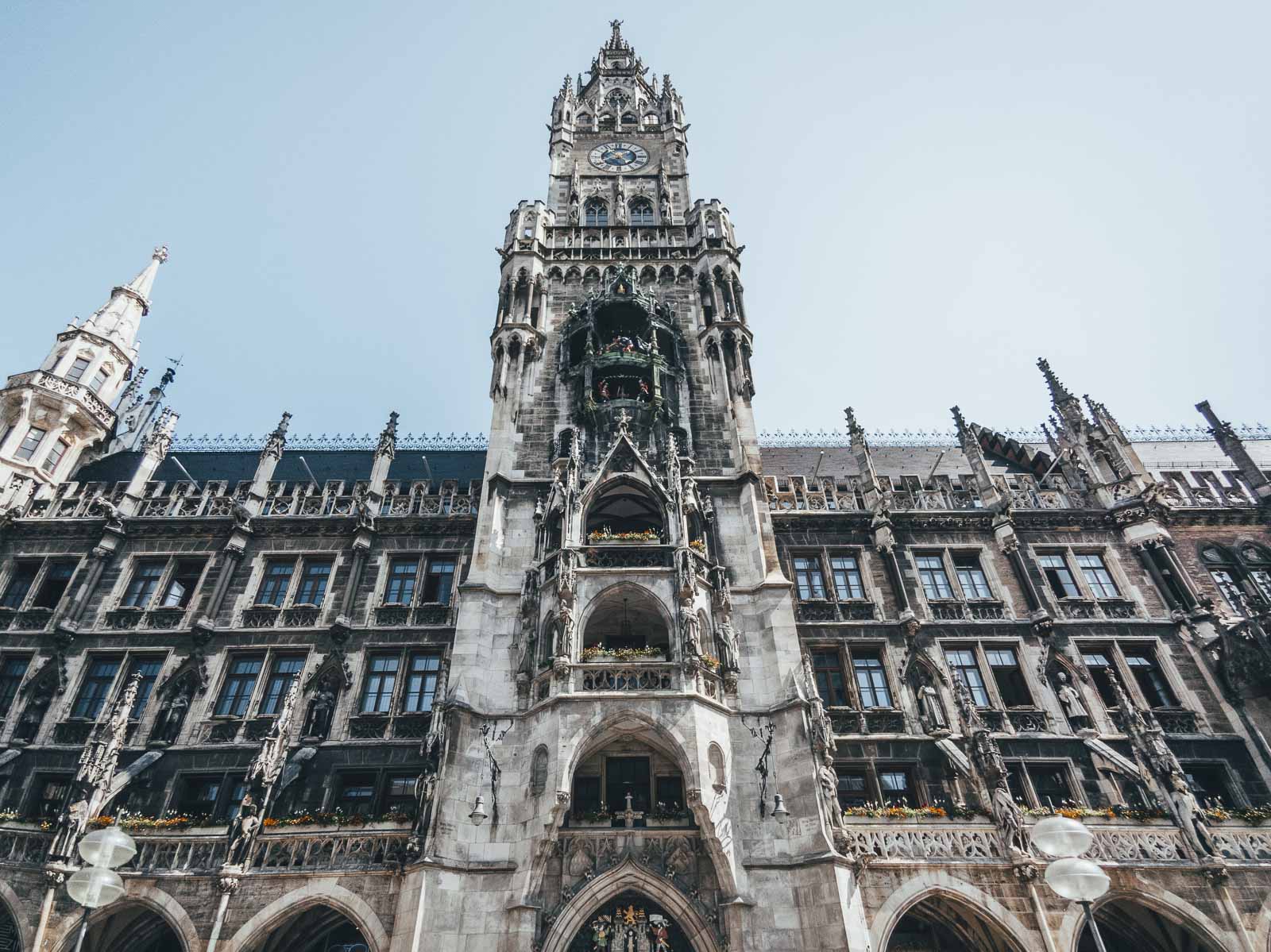
One of the most notable features of the New Town Hall is its Glockenspiel, which is a mechanical clock that plays music and features moving figures. The Glockenspiel chimes twice daily at 11 am and at 12 pm, and from March to October additionally at 5 pm . Every day at 9 pm the night watchman blows his horn while the angel blesses the Münchner Kindl.
Located in the tower of Neues Rathaus, the Glockenspiel is a set of 43 bells and 32 figures. The figurines tell stories from Munich’s history including the wedding of Duke Wilhelm V and the dance of the barrel makers who helped keep spirits alive during the plague.
While the New City Hall may be the largest building in Marienplatz, the most famous attraction in Marienplatz (and perhaps all of Munich) is certainly the Glockenspiel.
4. Old Town Hall
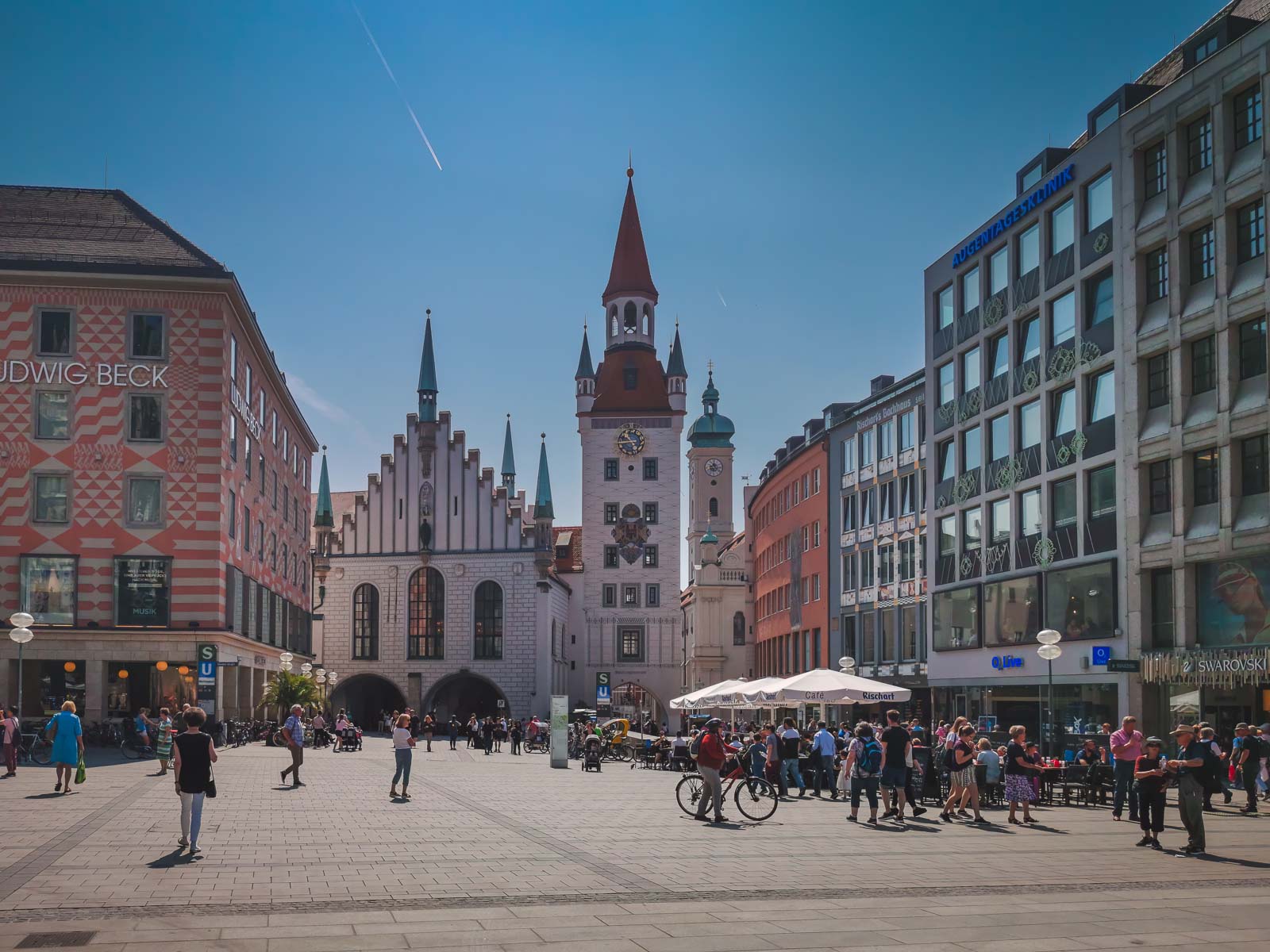
The Old Town Hall, or Altes Rathaus can also be found in the area and is worth checking out. Dating back to 1310 and is considered one of the most important landmarks in the city. It has undergone many renovations over the centuries landing at its current neo-gothic style in 1864.
Unique features of the building include the pass-throughs on the ground floor that were created in the late 19th and early 20th centuries to allow for traffic.
It was originally used as a meeting place for the city council and served as the center of political power in Munich for many years until 1874.
5. Christmas Markets
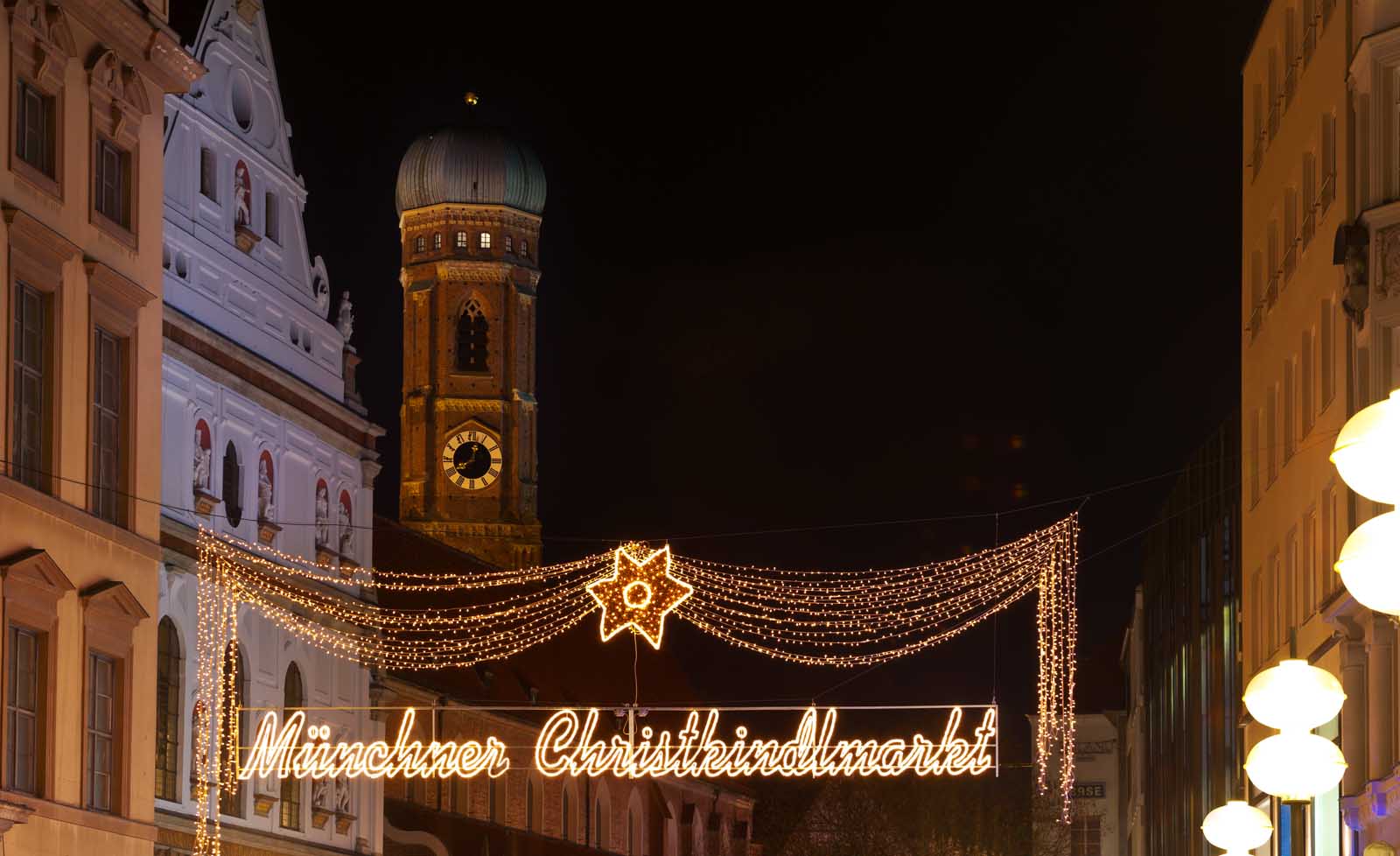
If you travel to Munich in December, you’ll experience the Christmas Markets of Marienplatz. It’s difficult to top the Christmas markets of Germany and Munich has some of the best. Marienplatz is the largest and most famous market to visit in Munich but there are Christmas markets throughout the city.
Others include Tollwood Winter Festival in the Theresienwiese area of Munich, Christmas Market at the Munich Residenz, the Christmas Market at the Chinese Tower and the Schwabing Christmas Market.
These markets are filled with vendors selling everything from mulled wine, to hand made toys, Bavarian gifts and crafts and Bavarian food and drink. Read: Christmas Markets and European River Cruise Tips
6. English Garden – Englischer Garten
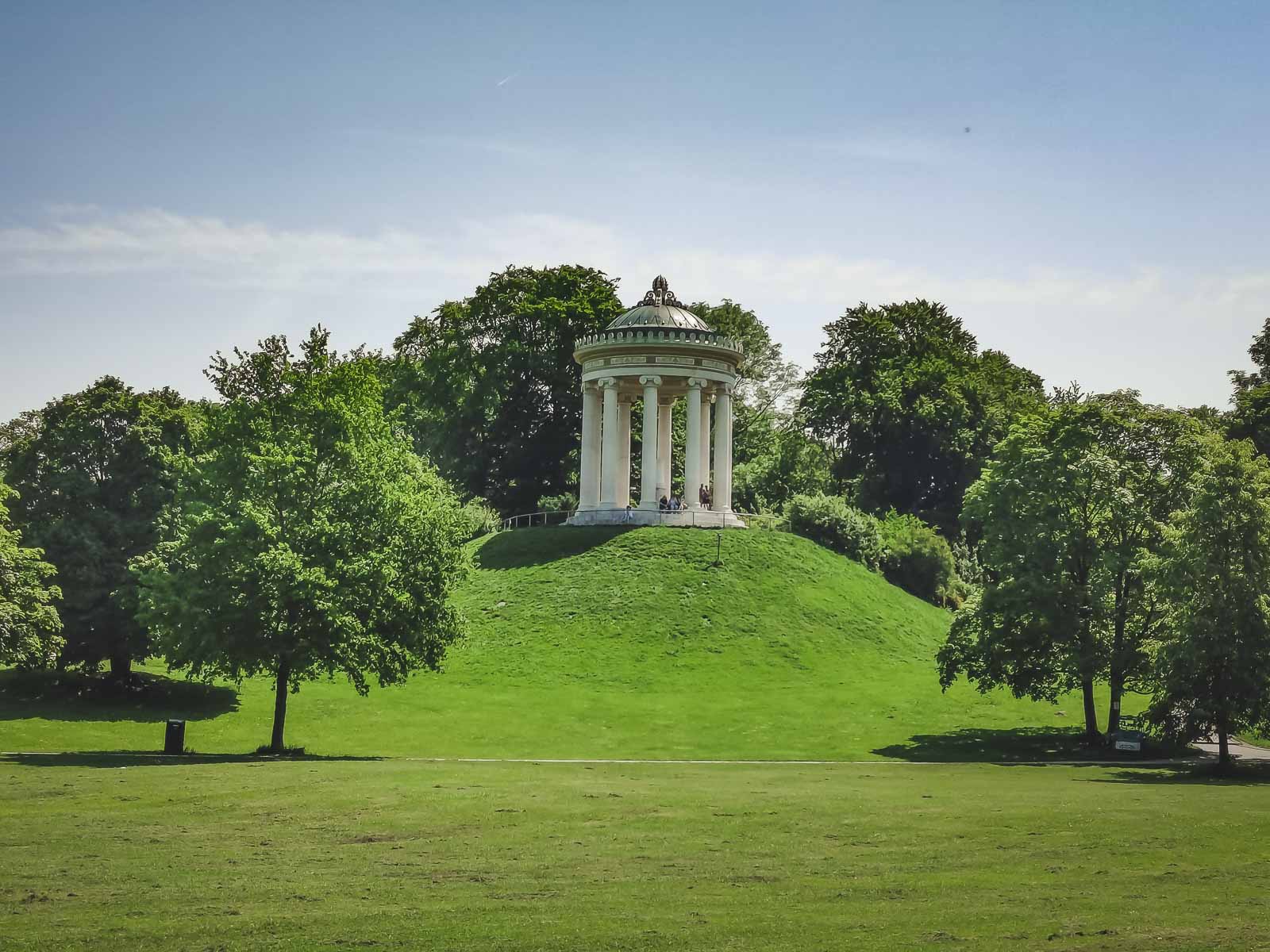
It is easy to get out to nature in Munich. Just on the edge of town is the English Garden (Englischer Garten) which is the largest garden in continental Europe. You can easily spend a day relaxing in the sun and taking in the scene. It was modeled after an English Garden to perfection.
Everything is handmade to create a sense of calm with manmade ponds, rivers, waterfalls, and hand-planted trees to recreate the royal English gardens. You can do everything from cycling the paved paths to playing football, and slacklining, and you can even sunbathe in the nude. Yes, Englischer Garten is a clothing-optional park.
7. Watch River Surfing on the Eisbach River
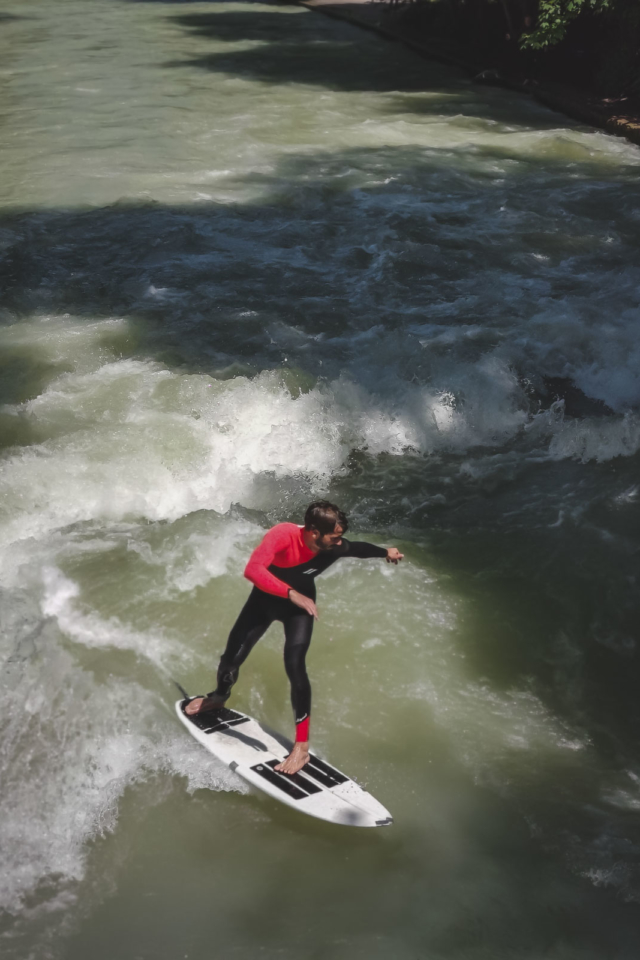
One of the coolest things to do in Munich is to make your way to the Eisbach River near the English Garden to watch river surfers. River surfing is very popular in Munich but be warned, do not attempt it if you don’t have experience. During the day you’ll see expert surfers riding the waves in downtown Munich.
The surfers have been doing this since 1972, but it only became legal in 2010 after Munich passed the Common Sense Law. The Ice River was formed by diverting the main river to clean up all rivers in the park.
Willy Wonka
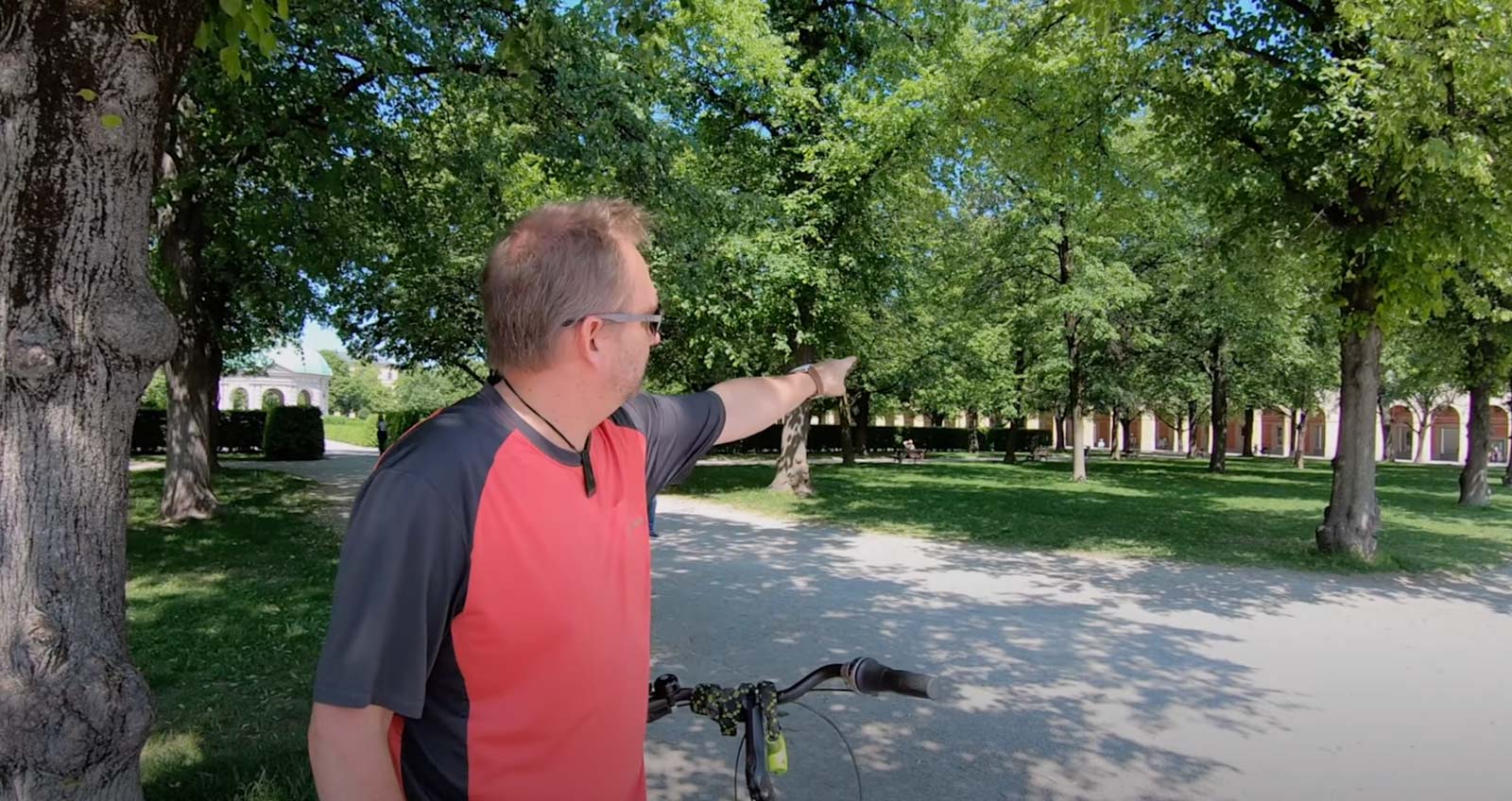
If you are a movie buff then you will want to check out some movie locations in Munich. The original Willy Wonka and the Chocolate Factory was filmed in Munich and there are several locations to visit in Munich where the famous movie was filmed. throughout the city where you can see film locations.
We stopped at several locations including the gates where Charlie is peering into the factory imagining the amazing thigns going on inside at München Gaswerk. Check out Reelstreets for locations and you can do your own self guided tour.
8. Hop on a Bike with Radius Tours
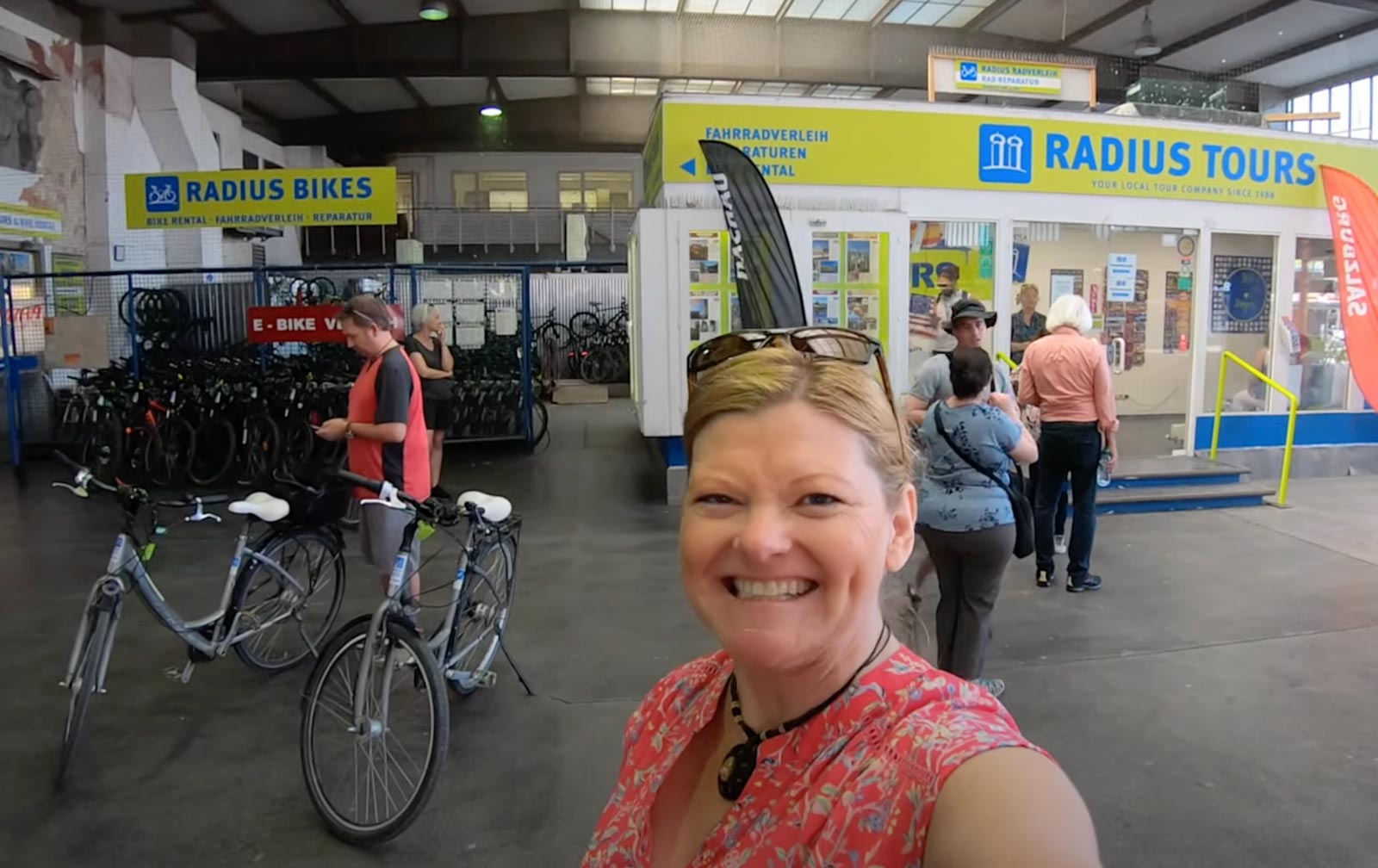
If you want to enjoy many of the best places to visit in Munich is a short time, a bicycle tour is the way to go. We took a cycling tour with Radius Tours and saw all of the highlights in a short half day trip. (ask for Tim!) Cycling is an excellent way to see the city of Munich as this city is very bike friendly.
It is easy to get around, the city center has a small downtown core and you can see a lot in a short amount. You can book your tour with them here.
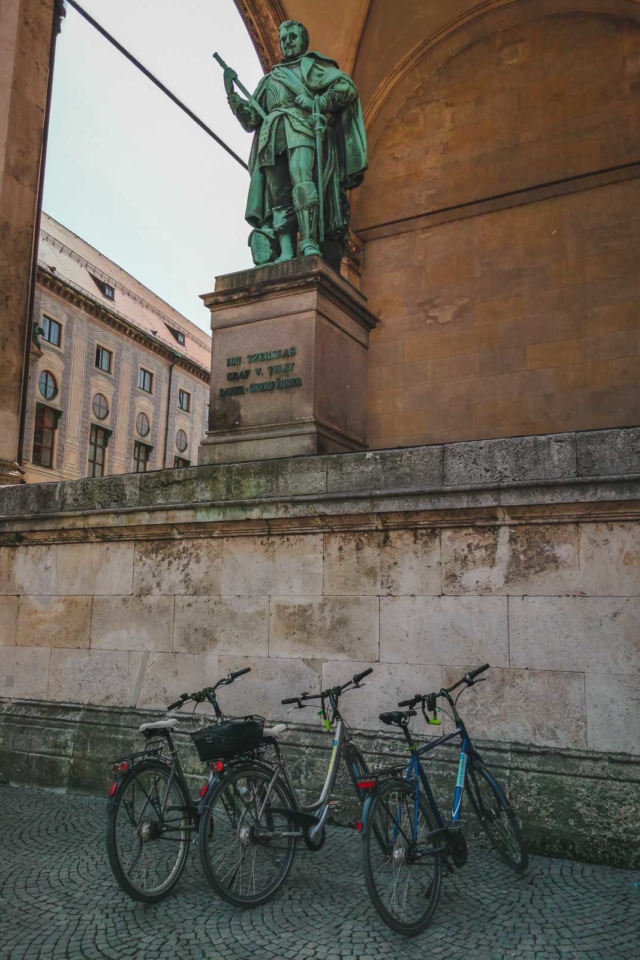
Munich has great cycling trails, and bike paths so don’t have to worry about traffic. You can rent bikes for about $30 USD to take a self-guided tour or book a guided tour with Radius Tour. We really loved the insight and information we got from our guided tour.
9. Royal Residenz
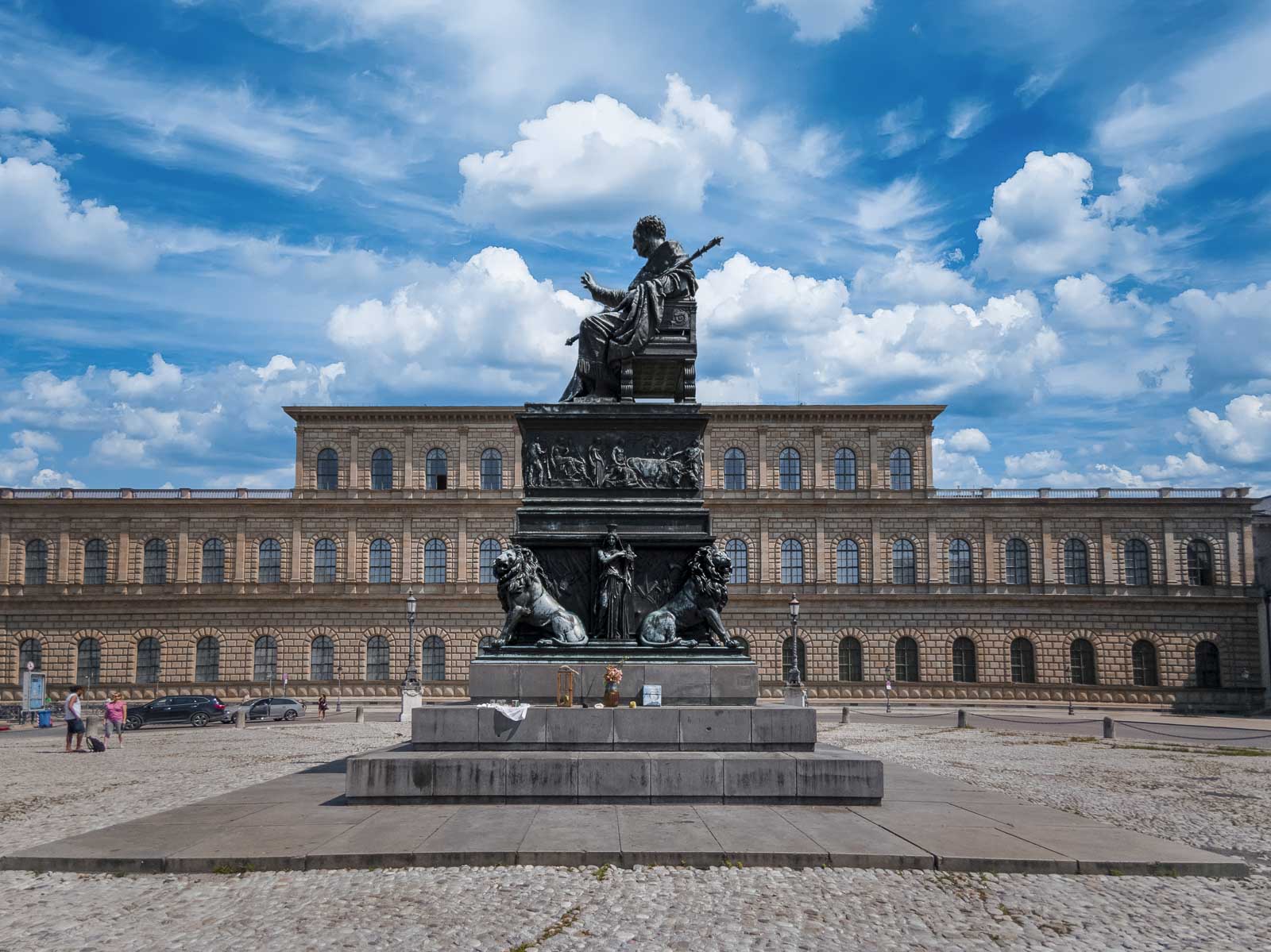
The Royal Residenz is one of Europe’s great residences and one of the largest museums in Bavaria. The Munich Residenz is a massive palace that houses 10 inner plazas filled with history.
The Residenz served as the seat of government and royal residence from 1508 to 1918. Spanning the centuries, this magnificent palace showcases rooms filled with art and furniture from the Renaissance through Baroque, and Neoclassicism.
One of the coolest things to do in Munich is to book a concert at Munich Residenz. Every Thursday and Saturday, members of the Munich Philharmonic play at the Munich Residenz. This is an iconic location where in the Hofkapelle where Wolfgang Amadeus Mozart once played. Get your tickets in advance here.
10. shop on Maximillianstrasse
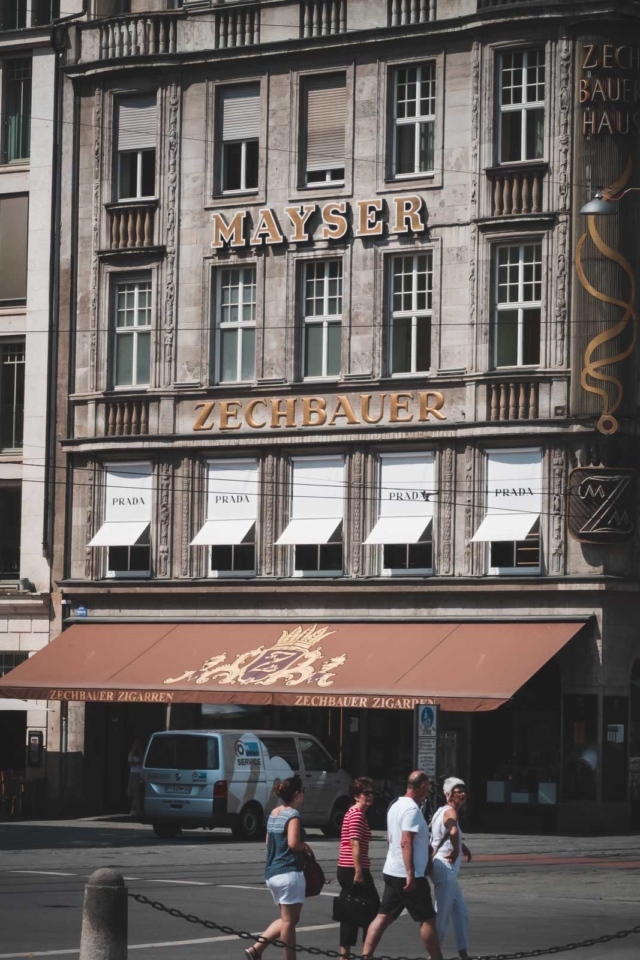
While exploring the Royal Residenz, make sure to take a stroll along the most expensive street in all of Germany. Maximillianstrasse has all of the high-end shopping, luxury boutiques, galleries, and designers. You’ll find Gucci, Chanel, Fendi..all the usual expensive brands.
It is here that you’ll also find the historic Hotel Vier Jahreszeiten Kempinski München. If you are looking for a luxury stay in Munich, this is the place!
11. Müller’sches Volksbad (Müllersches Public Baths)
If river surfing is a bit much but you still want to get wet, check out the Müller’sches Volksbad swimming pool. The Art Nouveau design is worth seeing alone but this public swimming pool also has a sauna, steam baths, and massage. It’s a great way to relax those travel-weary muscles in Munich’s oldest public pool which dates back to 1901.
12. Odeonsplatz
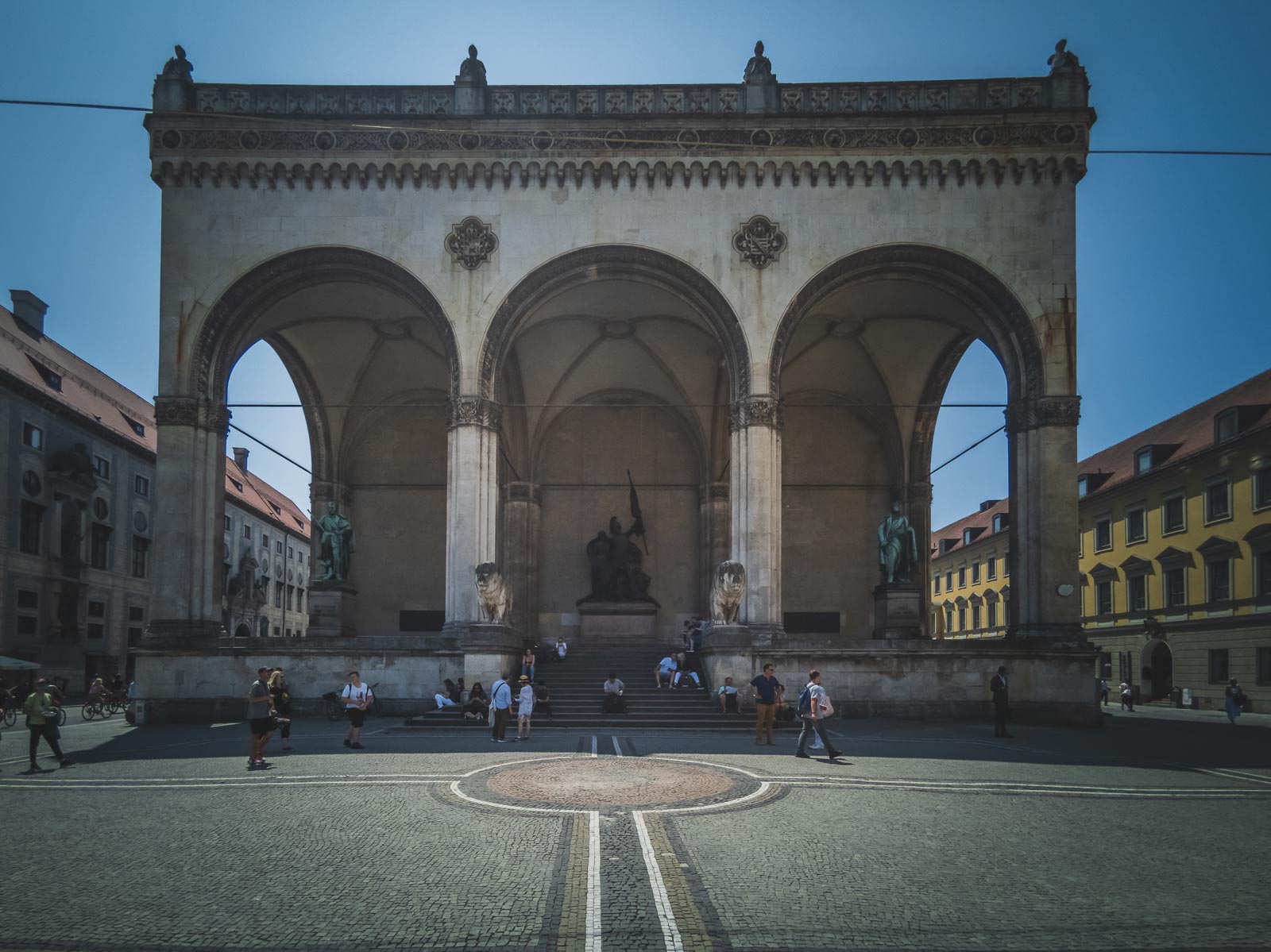
Another square that you must see in Munich is Odeonsplatz. King Ludwig I modeled the square after the squares of Italy. The Roman-inspired neoclassical buildings make you feel as if you are in a little slice of Rome.
In the square, you’ll see Feldherrnhalle (Field Marshalls’ Hall), a monument dedicated to the Bavarian army by Ludwig I Residence on one side, and Theatinerkirche (Theatine Church) dedicated to the birth of Prince Max Emanuel in 1662.
13. Memorial Alley
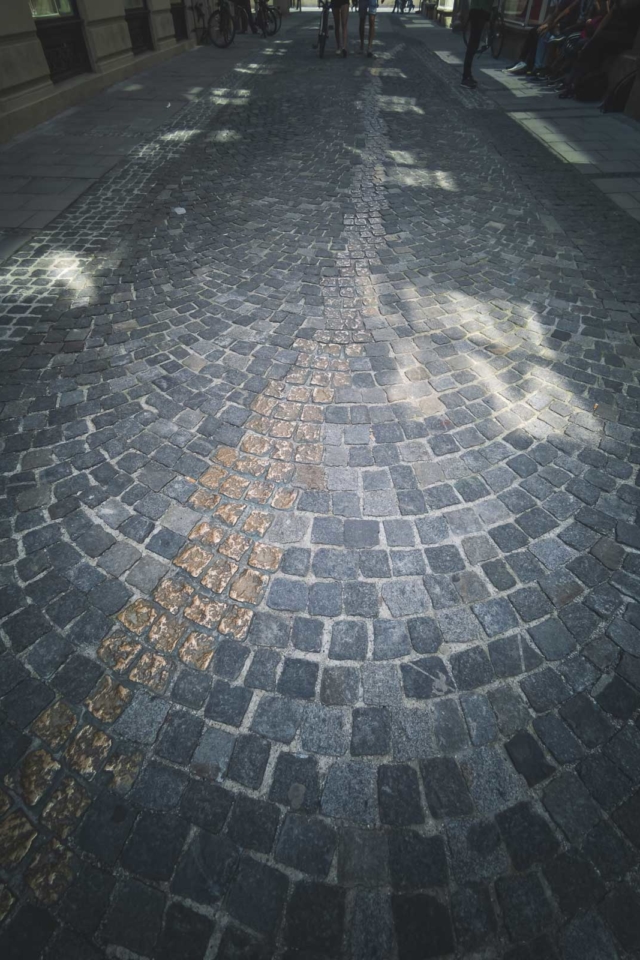
When visiting Odeonsplatz, be sure to talk a walk around the corner in search of the Golden cobblestones. This unassuming monument pays tribute to those who defied the Third Reich. This alley is located in front of what was at the time the headquarters of the Third Reich and people were required to give the Nazi salute when walking by.
People avoided walking in front of the building by taking a shortcut through this alleyway and when the Reich caught on to what was happening, they killed those who dared to defy Hitler. This memorial pays tribute to those who paid the ultimate price.
14. Documentation Centre
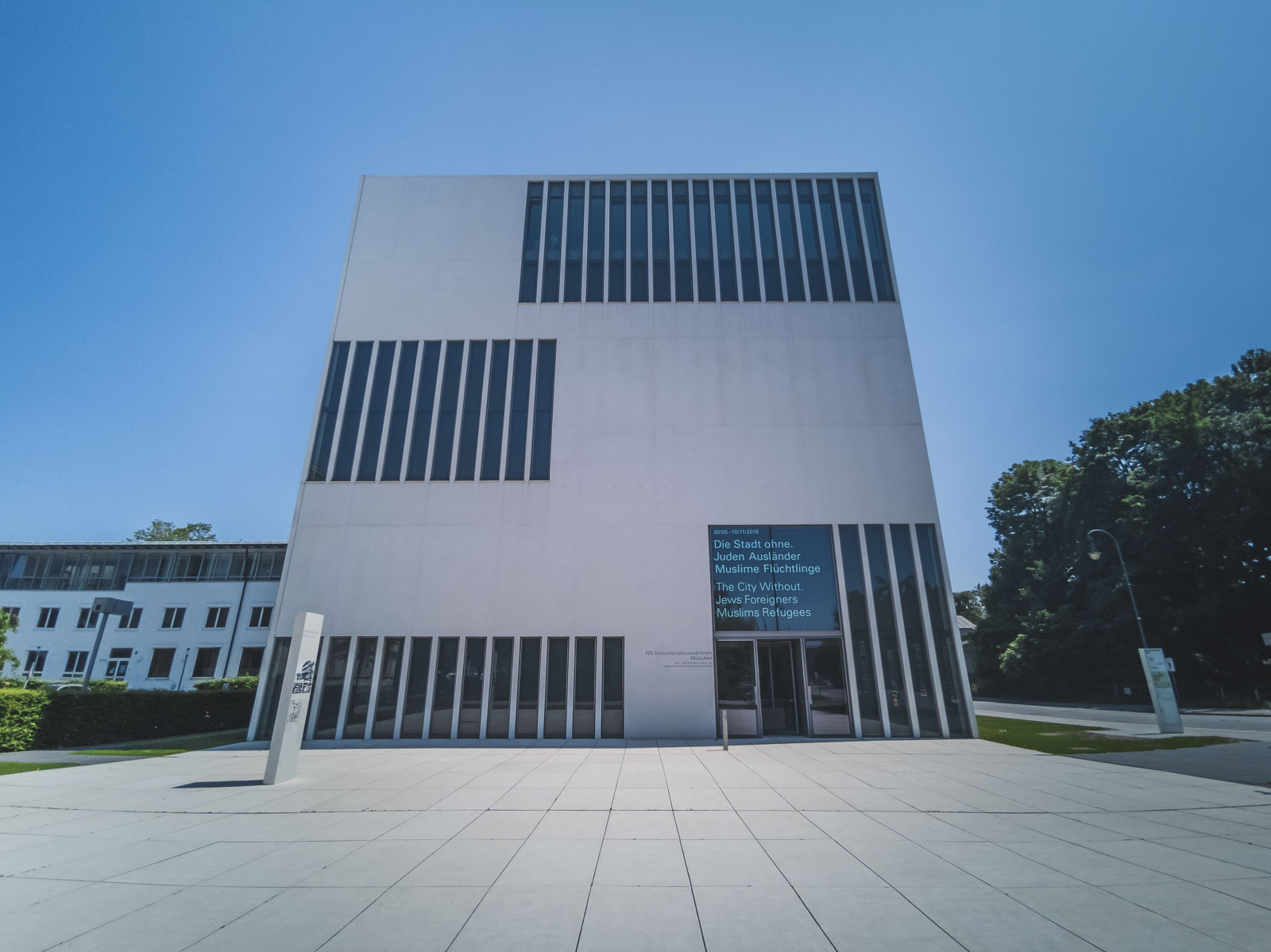
It is not the most uplifting of things to do in Munich, but we feel that it is important. The Documentation Centre is a museum and memorial of remembrance that documents and addresses the crimes of the Nazi dictatorship.
We must learn from the past and the people of Munich and Germany do not shy away from the past and instead learn from it. The Centre sits on the Former nazi headquarters that were either demolished or left empty.
15. Hoffbrauhaus
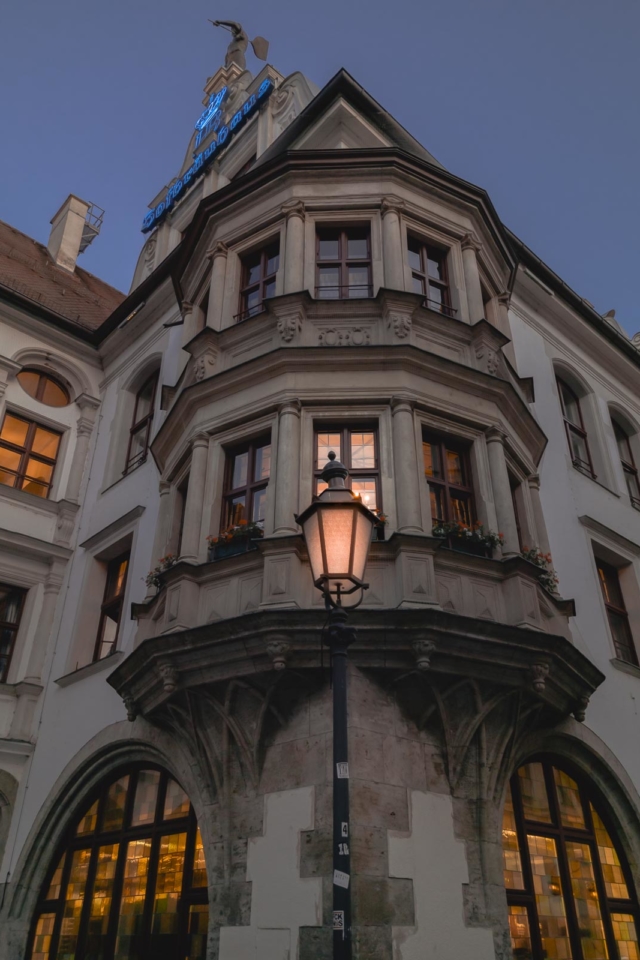
One of Munich’s top draws is definitely its beer halls and Hofbraeuhaus Beer Hall is its most famous. It may be touristy and it may be busy, but if you have one beer in Munich, you must go to Hofbraeuhaus.
Hofbraeuhaus is one of the most famous taverns in the world, and no trip to Munich would be complete without going inside to feel its energy and fun! Enjoy Bavarian entertainment, pretzels, and a massive pint of Bavarian beer.
This Munich Beer and Food Tour takes you to Hofbraeuhaus Beer Hall and other Bavarian Beer halls to immerse in beer culture and Bavarian bar snacks. The tour also includes Alte Hackerhaus”, where we enjoy our bavarian traditional dinner. Beer and Oktoberfest Museum Experience Munich’s nightlife with a local guide. Book it here, easy refund within 24 hours of experience.
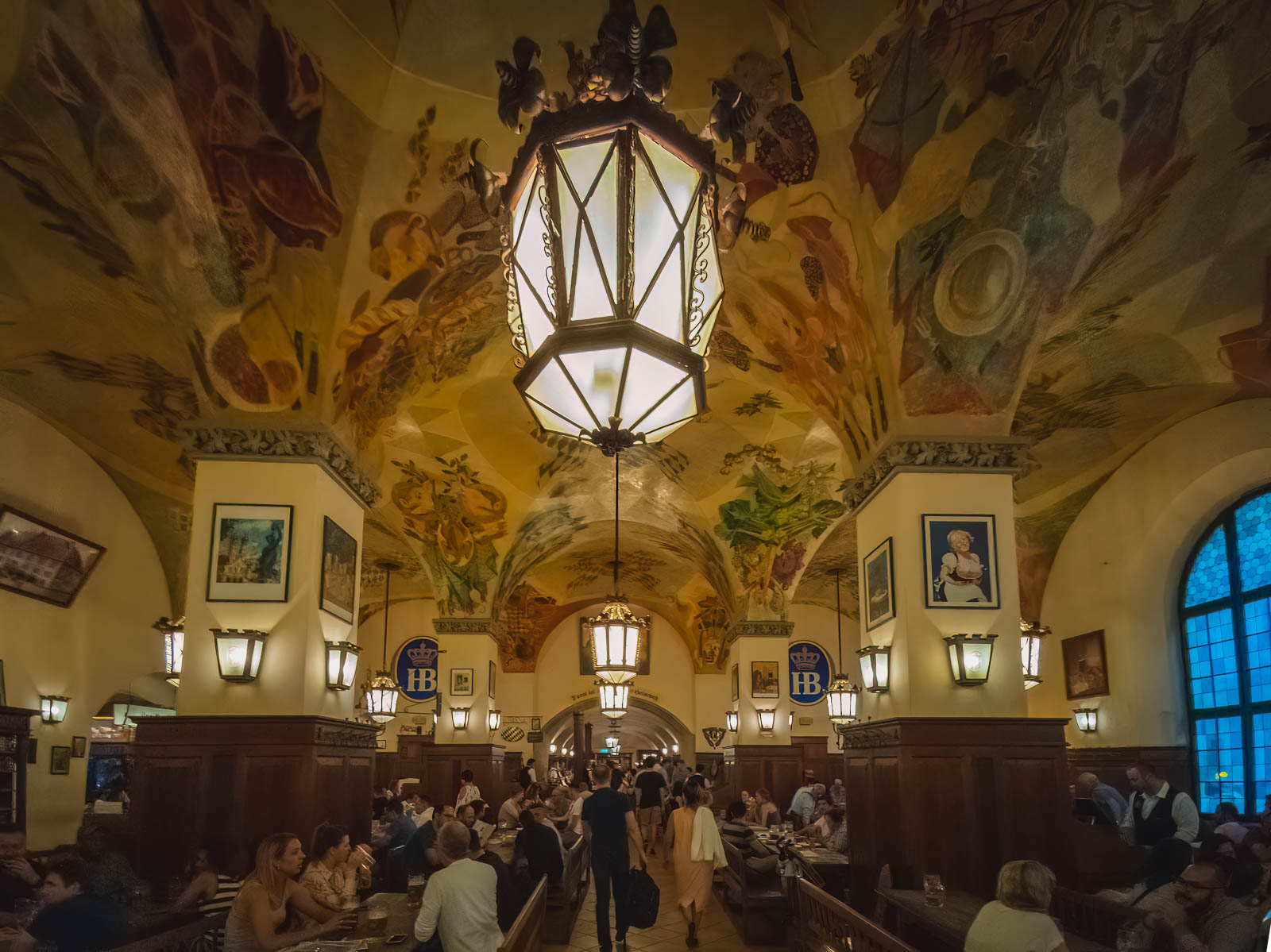
The standard-size beer is served in a 1-liter mug! This 500-year-old tavern was founded in 1589 by Wilhelm V, the Duke of Bavaria, and sits in the heart of Munich.
It has been a gathering place for centuries and it feels as if you have stepped back in time to a wild Bavarian party. Servers are dressed in traditional Bavarian Lederhosen, and Bavarian bands are playing as crowds sit in lines along the wooden tables.
16. Oktoberfest
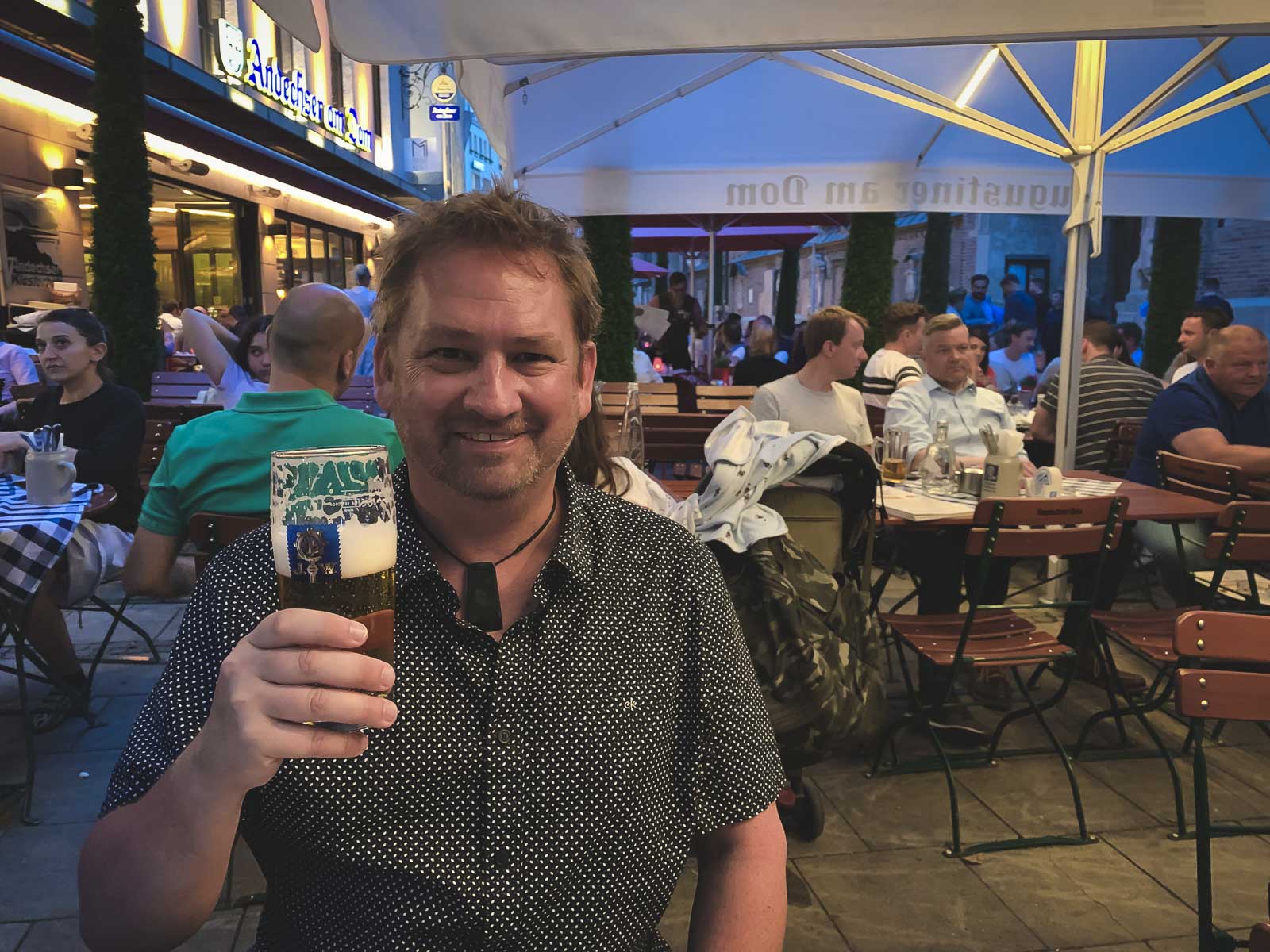
Speaking of beer, Munich is famed for its beer celebrations. If you are lucky enough to visit in September, you can take part in Oktoberfest, the world’s largest beer festival. Oktoberfest was started by King Ludwik I in 1810. He was the first king of Bavaria and as a gift to his wife, he invited the people of Bavaria to come and celebrate.
They had horse races, dancing, performances, and celebrations. Oh, and beer. Lots of beer. The tradition continued and Oktoberfest was born. It has grown into an 18-day festival attracting 6 million visitors a year.
17. Oktoberfest Museum
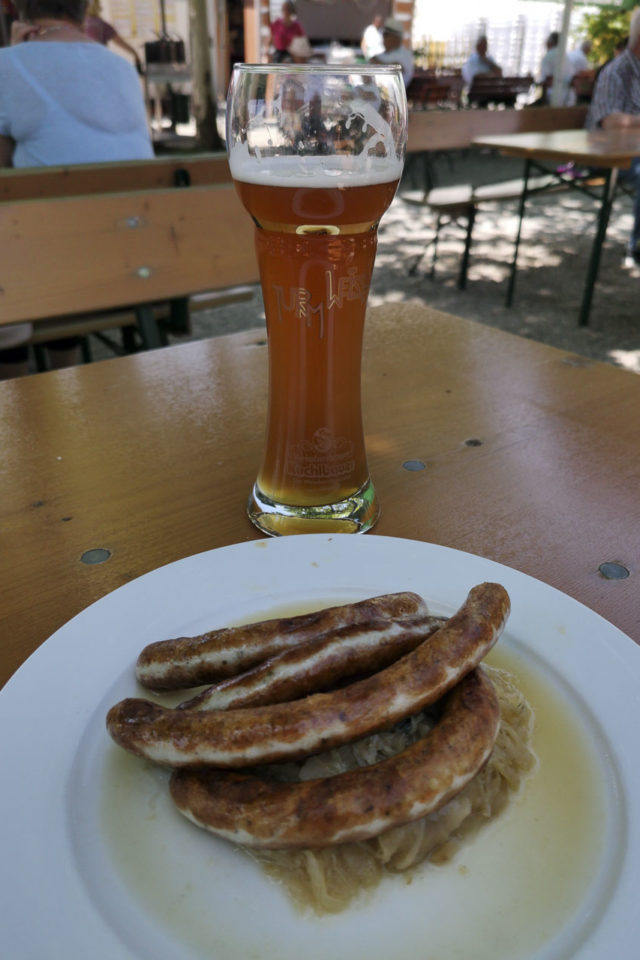
If you want to learn more about Oktoberfest (and not visiting during the festival) you can check out the Oktoberfest Museum located in Munich’s oldest townhouse at #2 Sterneckerstrasse.
The museum features exhibits and displays that highlight the history of Oktoberfest, including its origins, traditions, and evolution over the years. Visitors can learn about the history of beer-making in Bavaria, as well as the unique culture and customs that have developed around the festival.
The museum also features an extensive collection of memorabilia and artifacts related to Oktoberfest, including old beer steins, posters, and other historical objects. Visitors can see how the festival has changed over the years, from its early days as a small local celebration to the massive international event it is today.
18. Beer Gardens
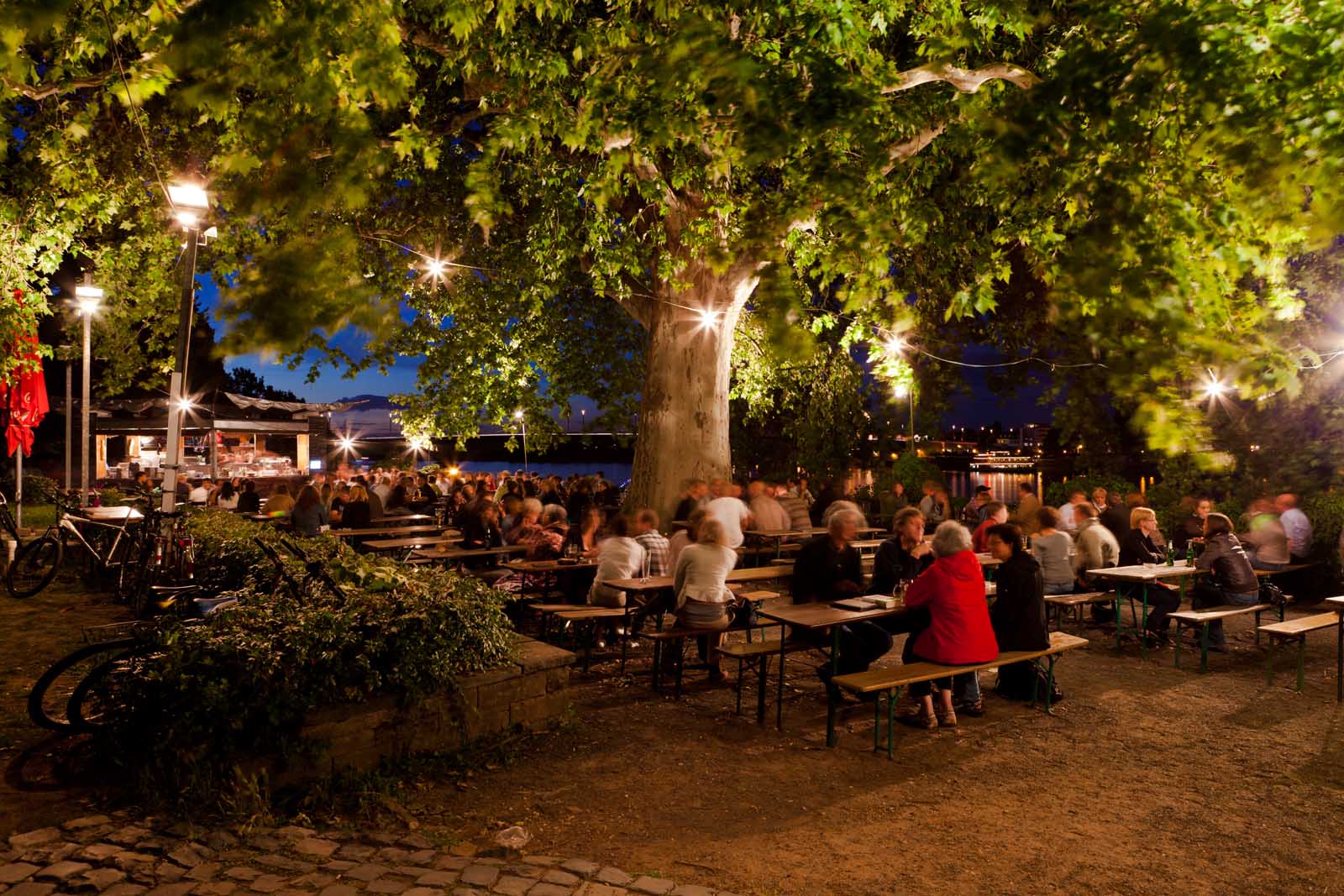
If you are not in Munich during Oktoberfest, never fear, beer is still a large part of the culture. Two of the world’s largest beer gardens are located in Munich. The beer garden was born in Munich out of necessity. Beer was originally brewed underground to keep the casks warm.
White gravel was then placed above the tunnels to reflect the sun and Chesnut trees were planted to create shade. Their low root system was suitable to not destroy the underground storage as the roots wouldn’t penetrate too deeply. Back in the day, the only things served were beer, pretzels, and radishes. Today, you can bring your own food as long as you purchase a beer.
19. Chinese Tower (Chinesischen Turm)
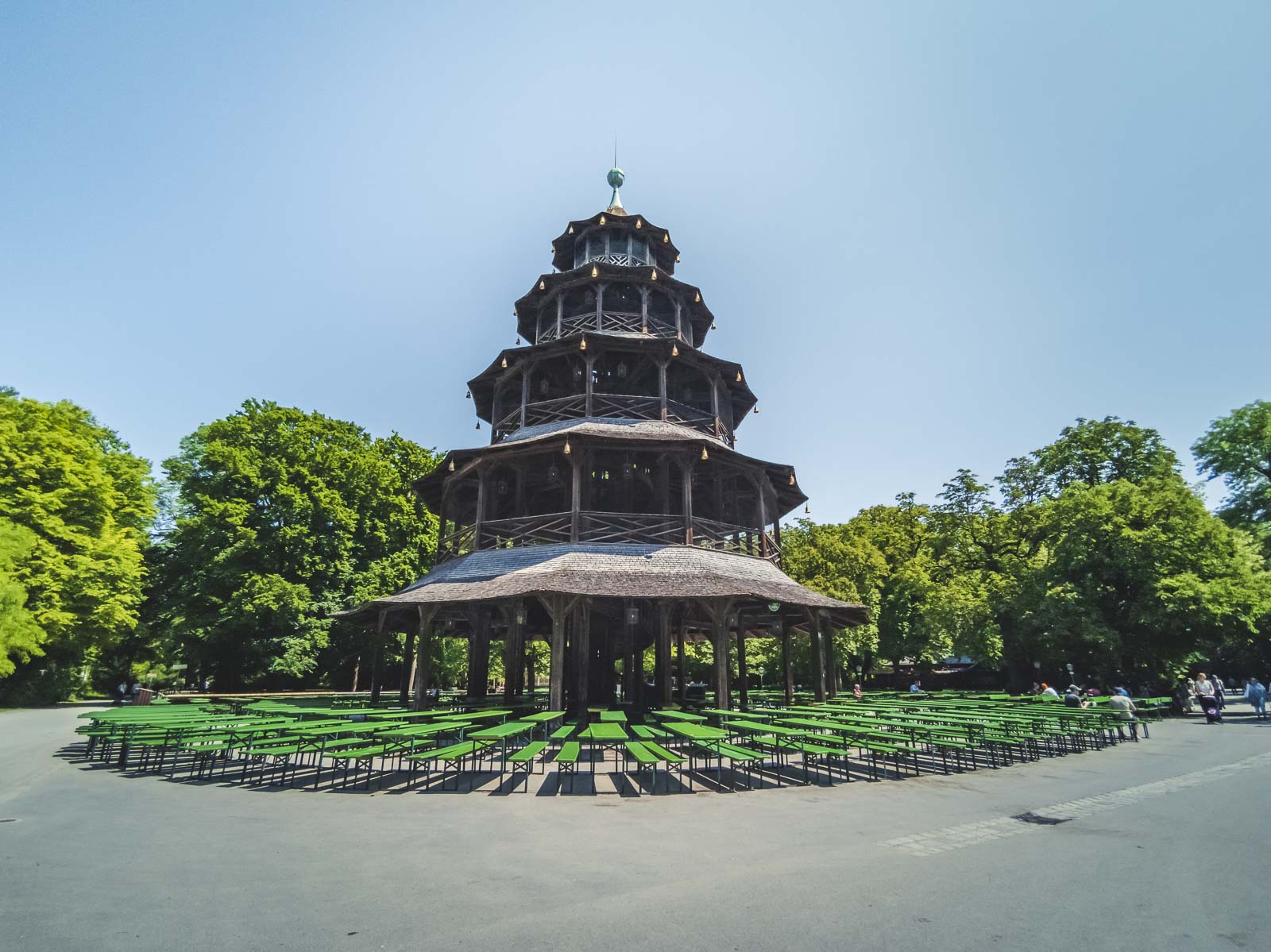
Chinesischen Turm (The Chinese Tower) is the second-largest beer garden located in the English Gardens. This is a great place to stop for a pint as you sit under the shade of its chestnut trees. Modeled after a Chinese pagoda, this is a really cool place to go for a pint.
If you are wondering what the largest beer garden in the world is, it is Hirschgarten also located in Munich. Hirschgarten is the largest beer garden in Munich with 8000+ seats and it is popular with the locals.
20. Frauenkirch
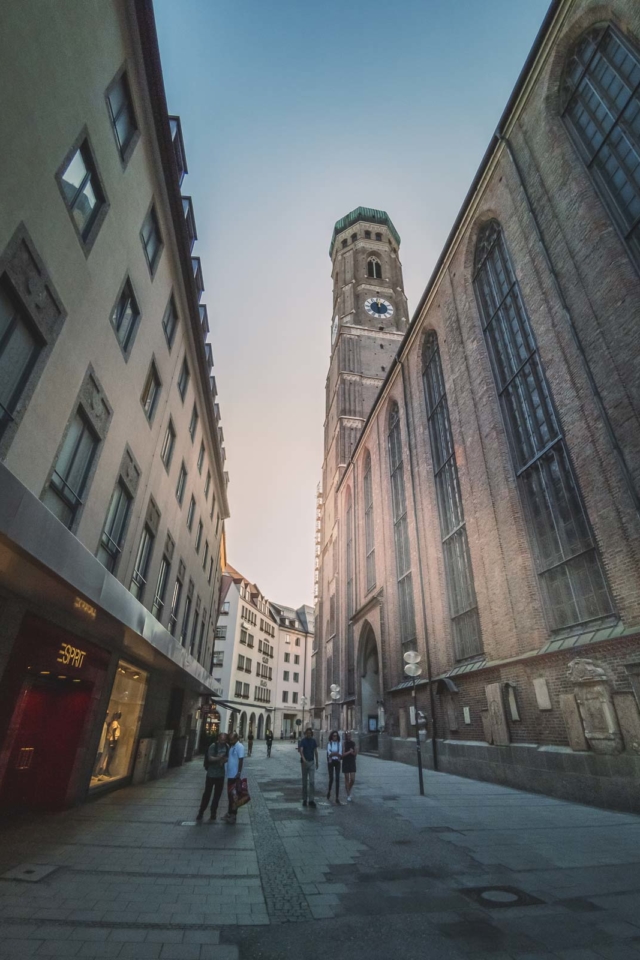
You can’t miss seeing Frauenkirche – the Cathedral Church of Our Lady. Its high spires tower over Munich’s Old Town. These towers actually survived regular bombings of WWII and still stand today thanks to the fact that no highrises can be built around it. Visitors can climb up to the top of the towers for a bird’s eye view of Munich.
When you do go inside, be sure to keep an eye out for The Devil’s footprint. It was believed that the devil stomped his foot at the entrance after becoming annoyed with yet another building that was made in God’s name.
21. Viktualienmarkt
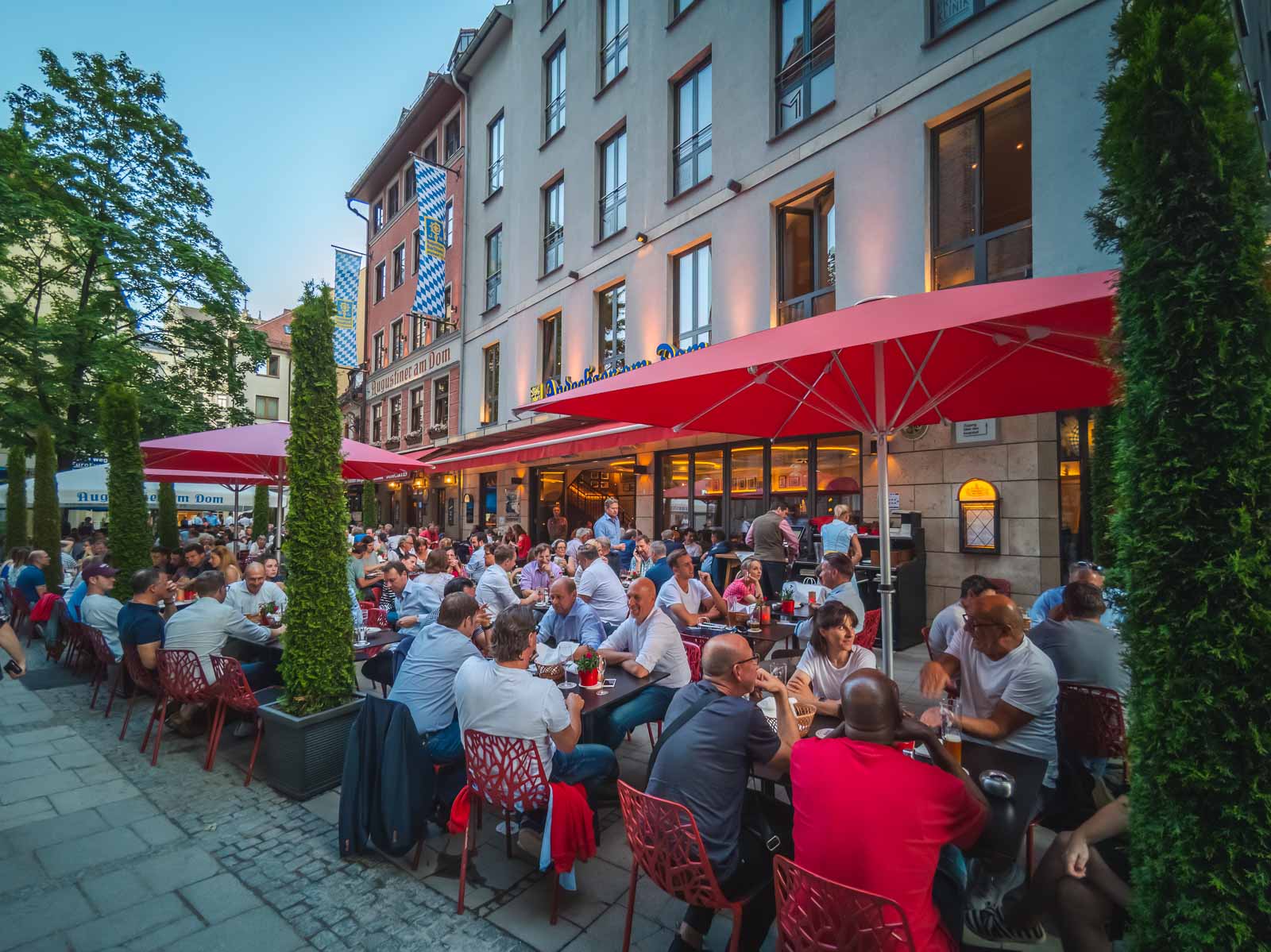
Even Munich’s farmers market has a beer garden. Viktualienmarkt is Munich’s main food market with more than 100 vendors selling fruit and vegetables, a butchers’ hall, a fish hall, and flower shops. When the market grew too big in Marienplatz, King Maximilian I moved the market in 1807. It has expanded and grown over the centuries and is Munich’s favorite shopping and gathering place.
22. Asam Church
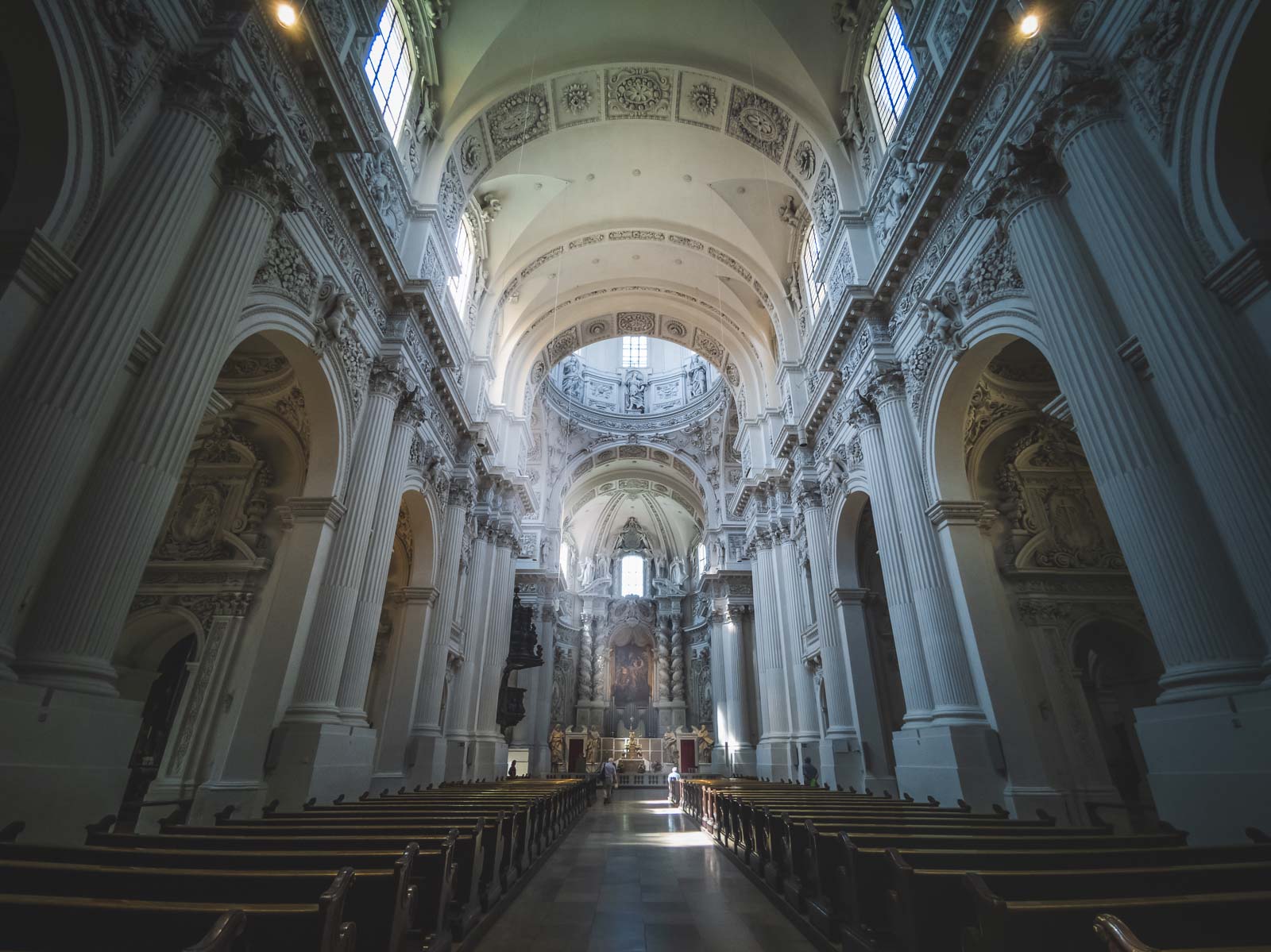
While Frauenkirch may be the largest and most imposing church in Munich, Asam Church is the most interesting church to visit in Munich. The Rococo Asam Church was designed by the famous Asam Brothers in 1746. They were a painter and a sculptor who modeled it in the Baroque style.
Its ornate facade attracts visitors, but once inside is when you truly see the work of art. Its ornate gold finishings and paintings make it one of the must-see things in Munich.
23. St. Peter’s Church
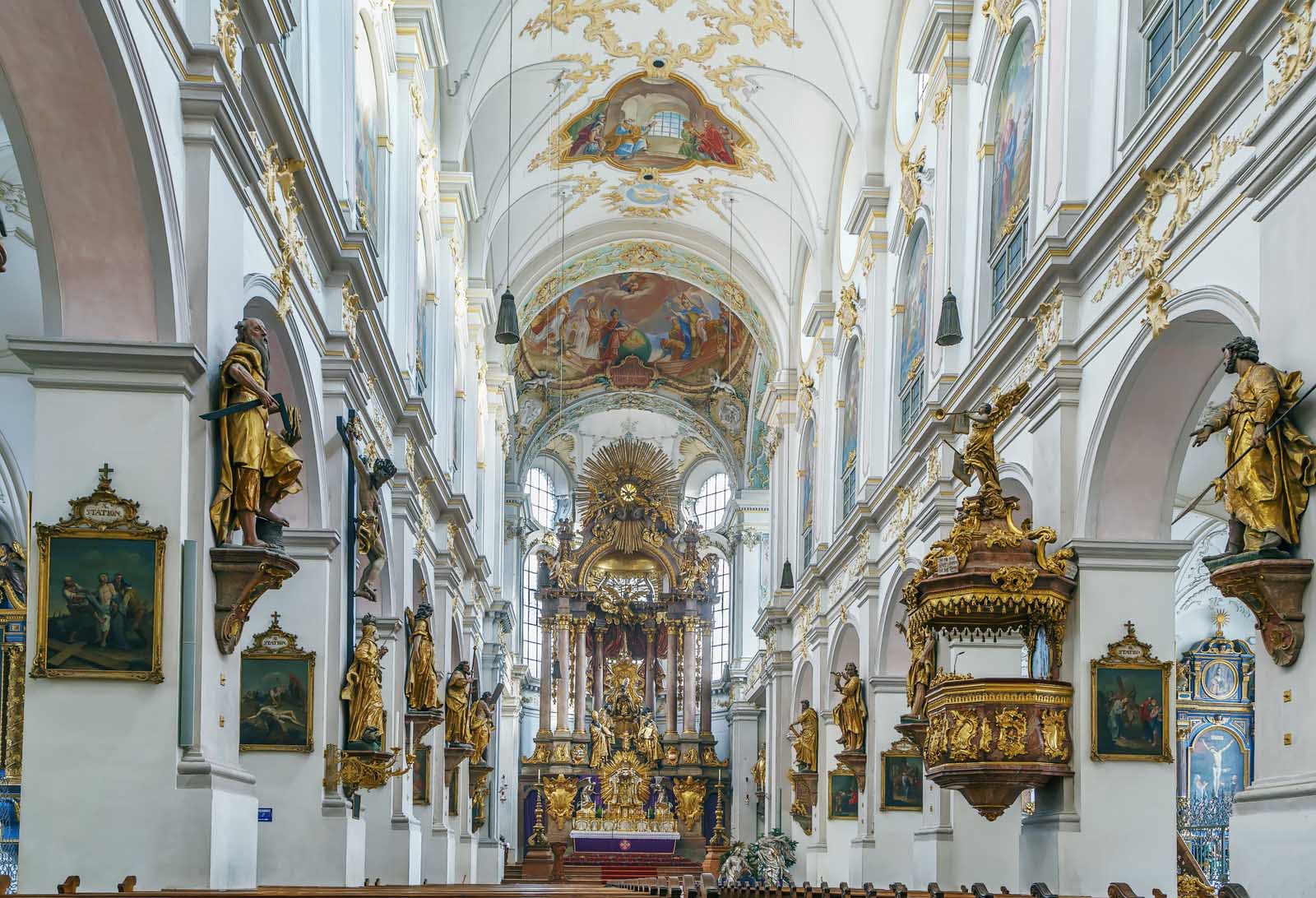
St. Peter’s Church is the oldest church in Munich housing the oldest bells in Munich in its clocktowers. Located in the heart of the city’s historic district, St. Peter’s Church dates back to the 12th century.
The church has a distinct Baroque style and features beautiful frescoes, ornate altars, and intricate stucco work. Inside the church, visitors can see the ornate high altar, which dates back to the 18th century and features a stunning sculpture of St. Peter.
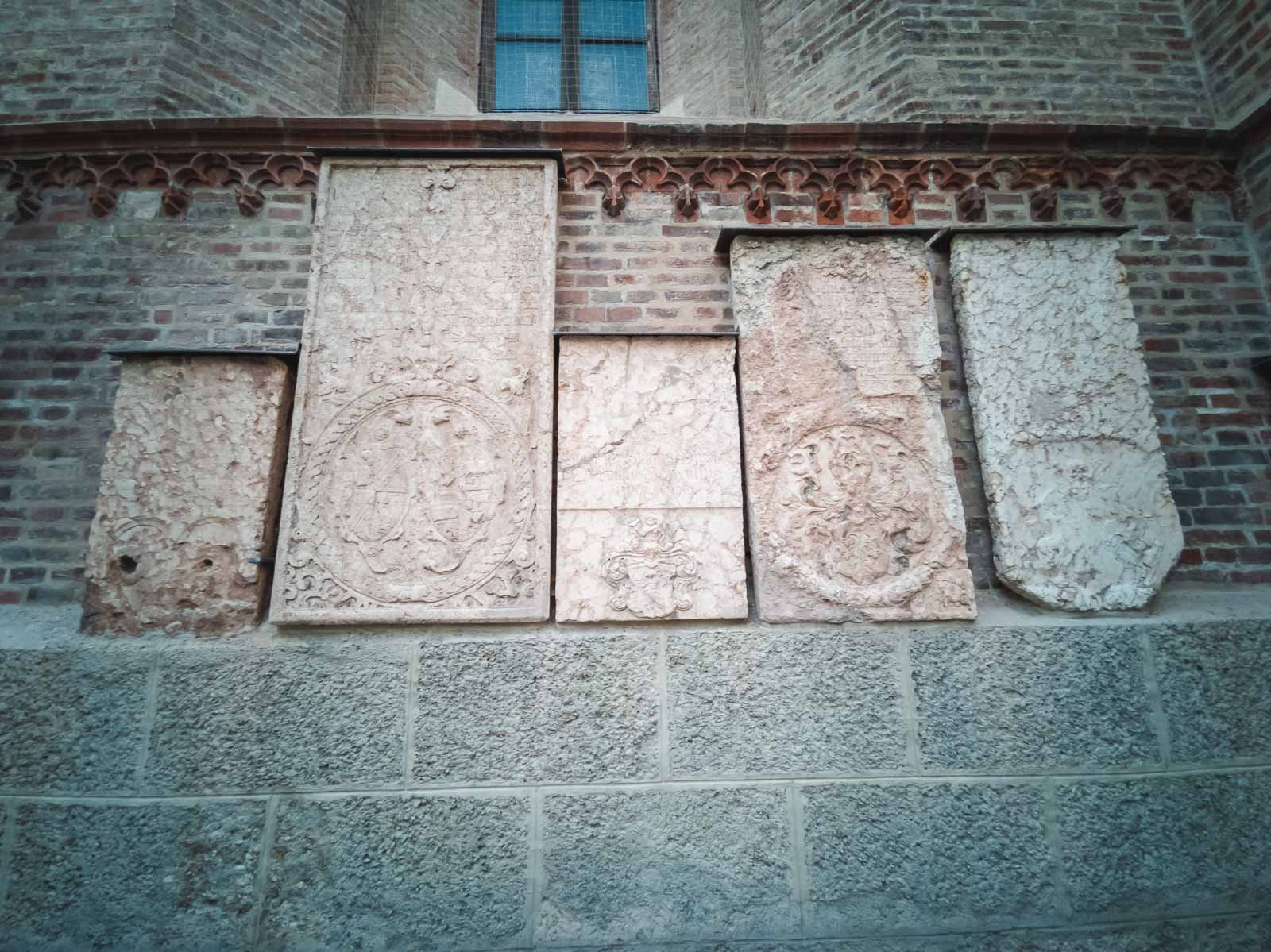
Take a walk along its outside to see the old graves on the walls and make sure to walk up to the top of its 56-meter-high viewing platform for views of Marienplatz (Munich’s Central Square) and City Hall (New Rathaus) plus Frauenkirche (Church of Our Lady) and panoramic vistas of Old Munich.
The tower of St. Peter’s Church is accessible via a narrow spiral staircase and is definitely worth the climb for the panoramic views. St. Peter’s Church has one of the best views of Munich and offers that iconic scene that is you know from so many guide books.
St. Peter’s Church is still an active place of worship and holds daily services for the local community. Visitors are welcome to attend these services or to simply explore the church and its beautiful architecture and artwork. The church also offers guided tours, which provide visitors with more information about its history and significance.
- Opening Hours: 7.30 AM – 7.00 PM
24. Bayerische Staatsoper (Bavarian State Opera)
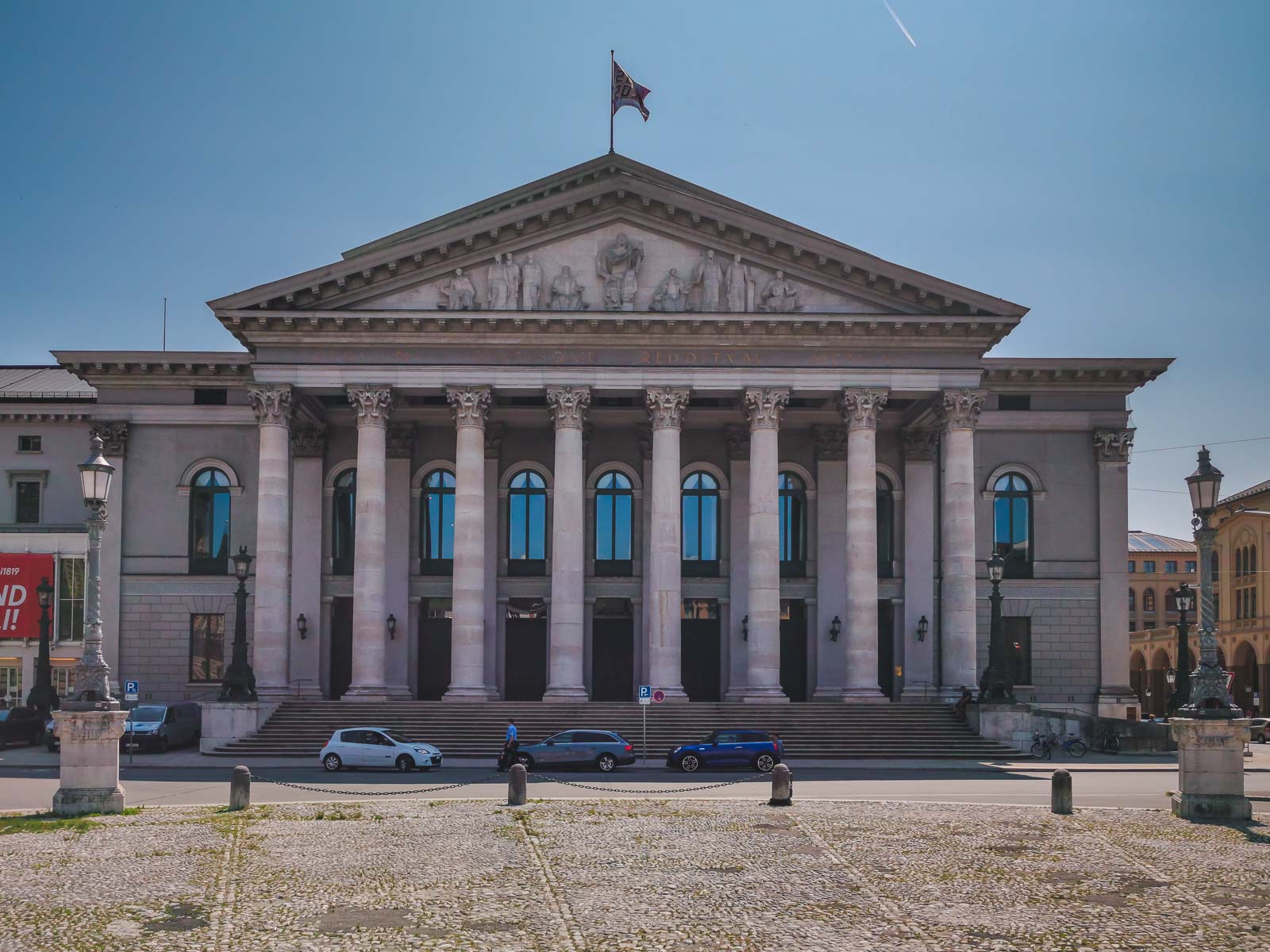
The Bayerische Staatsoper (Bavarian State Opera) is one of the world’s leading opera companies and is located in Munich, Germany. The company was founded in 1653 and is located in the National Theatre.
If you are looking for things to do in Munich at night, the company performs a wide range of operas from the classic repertoire, as well as contemporary works and new productions. The Bayerische Staatsoper also hosts ballet performances and concerts throughout the year.
Bayerische Staatsoper in Munich offers guided tours of its facilities, including the National Theatre, where the opera company is based. The tours provide visitors with a behind-the-scenes look at the theater, including the stage, the orchestra pit, the costume and makeup rooms, and other areas not normally accessible to the public. The tours are available in several languages and are led by knowledgeable guides who can answer questions and provide insight into the world of opera.
25. Olympic Park
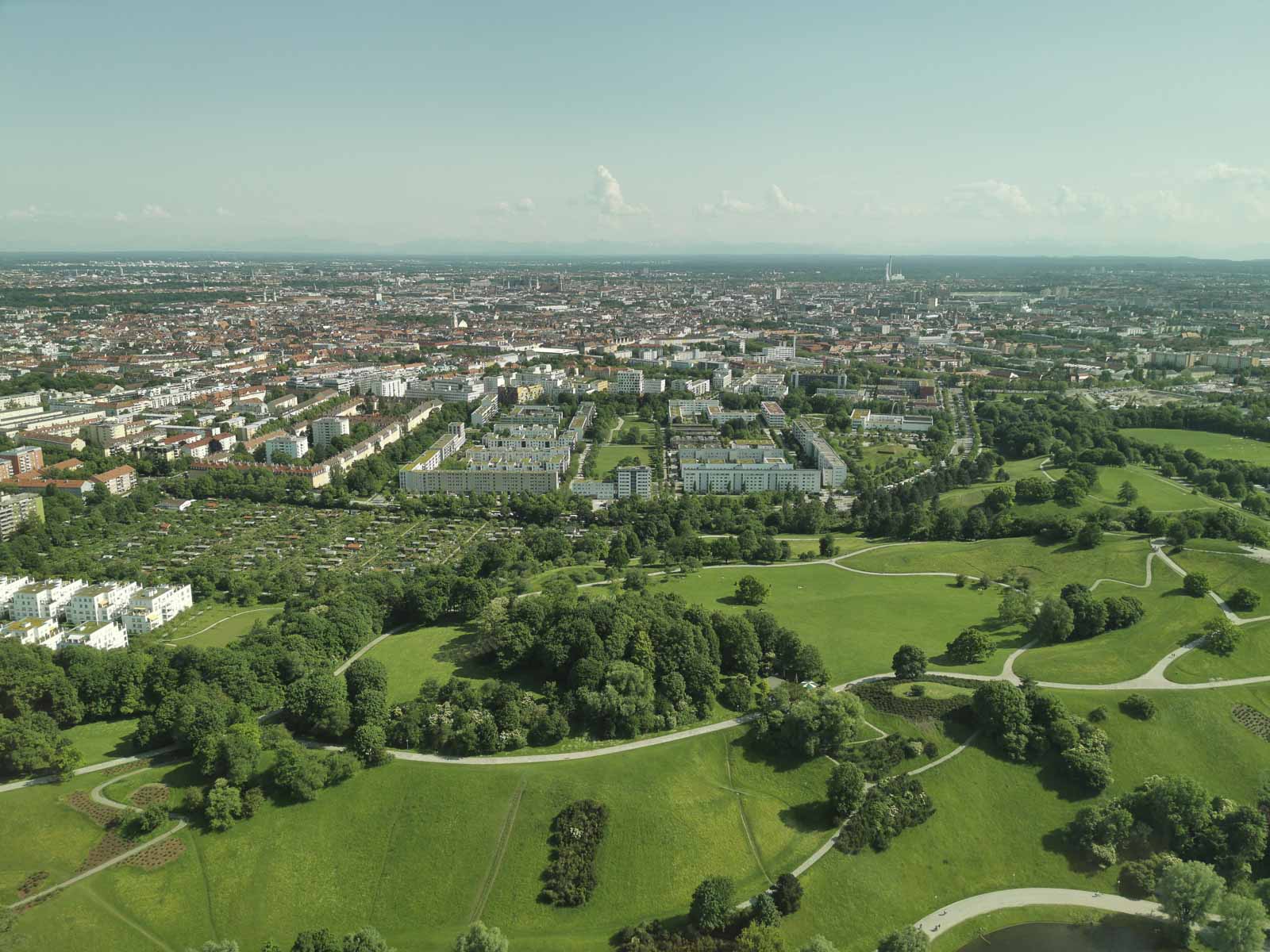
Located outside of town, Olympic Park is not to be missed when visiting Munich. Munich was host to the 1972 Olympics and this beautiful park is an amazing way to spend the afternoon. There are parks, waterways, lakes, and the Olympic stadium.
We drove out to Olympic Park, but the hop on hop off bus goes here and you can take the The U-Bahn (subway) line U3 runs directly to the Olympic Park, with stops at Olympiazentrum and Olympiapark.
There are many things to do in Olympic Park and here are a few of our choices.
26. Olympia Tower
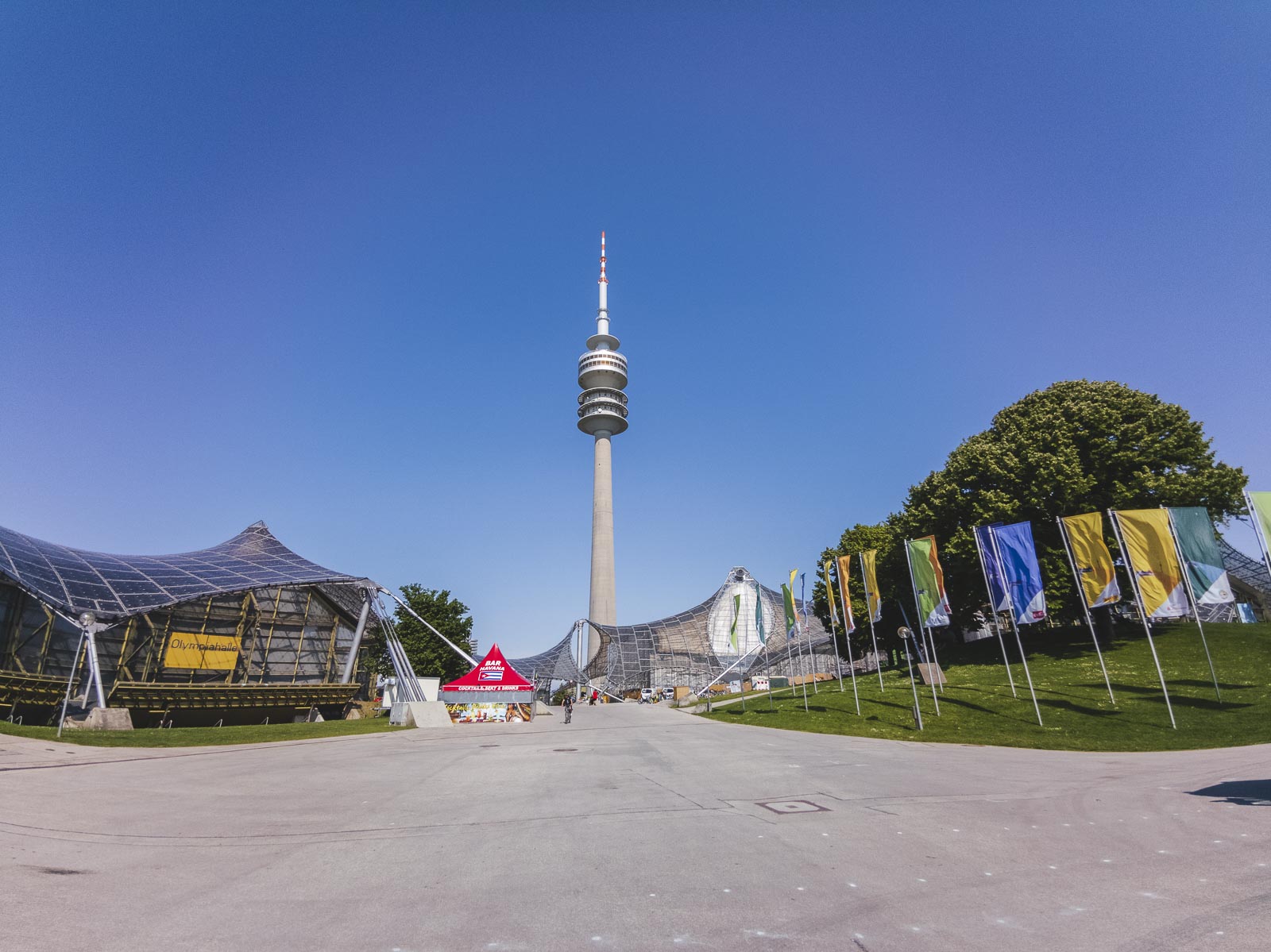
A highlight for us was going up Olympia Tower. It has one of the most beautiful views in Munich with a 360-degree vista of Munich and the Alps. It is the highest viewpoint in all of Munich and when you are up there, you’ll not only see views but there is a museum that showcases the acts that have performed at Olympic Stadium over the years, a restaurant.
27. BMW Museum – The BMW Welt
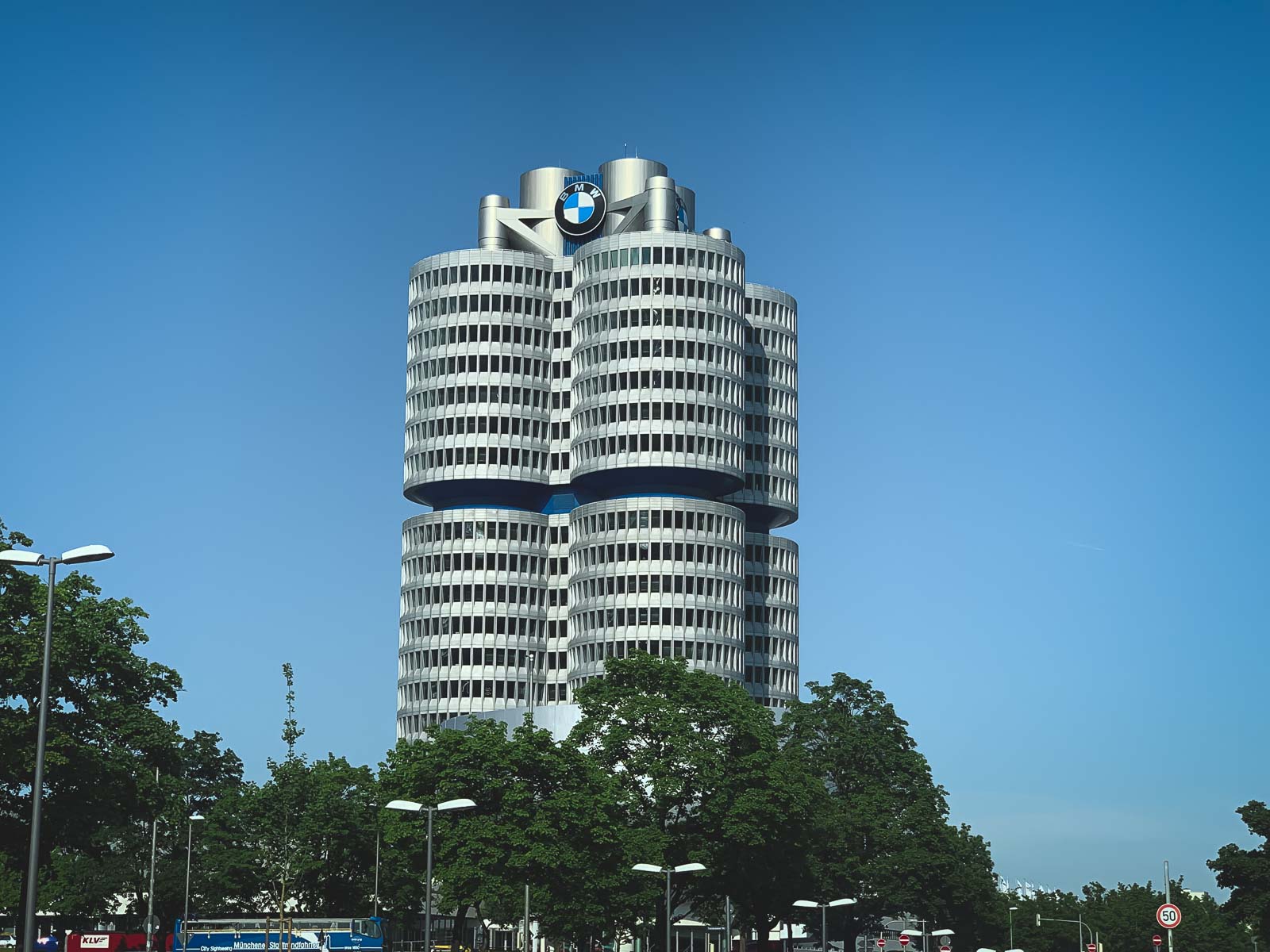
While you are out at Olympic Park be sure to stop in at the BMW Museum. Located at the BMW factory and headquarters, the BMW Welt is not only a museum, it is an architectural wonder. There are 125 makes and models of BMW automobiles and motorcycles spanning the massive complex.
28. Michael Jackon’s Memorial
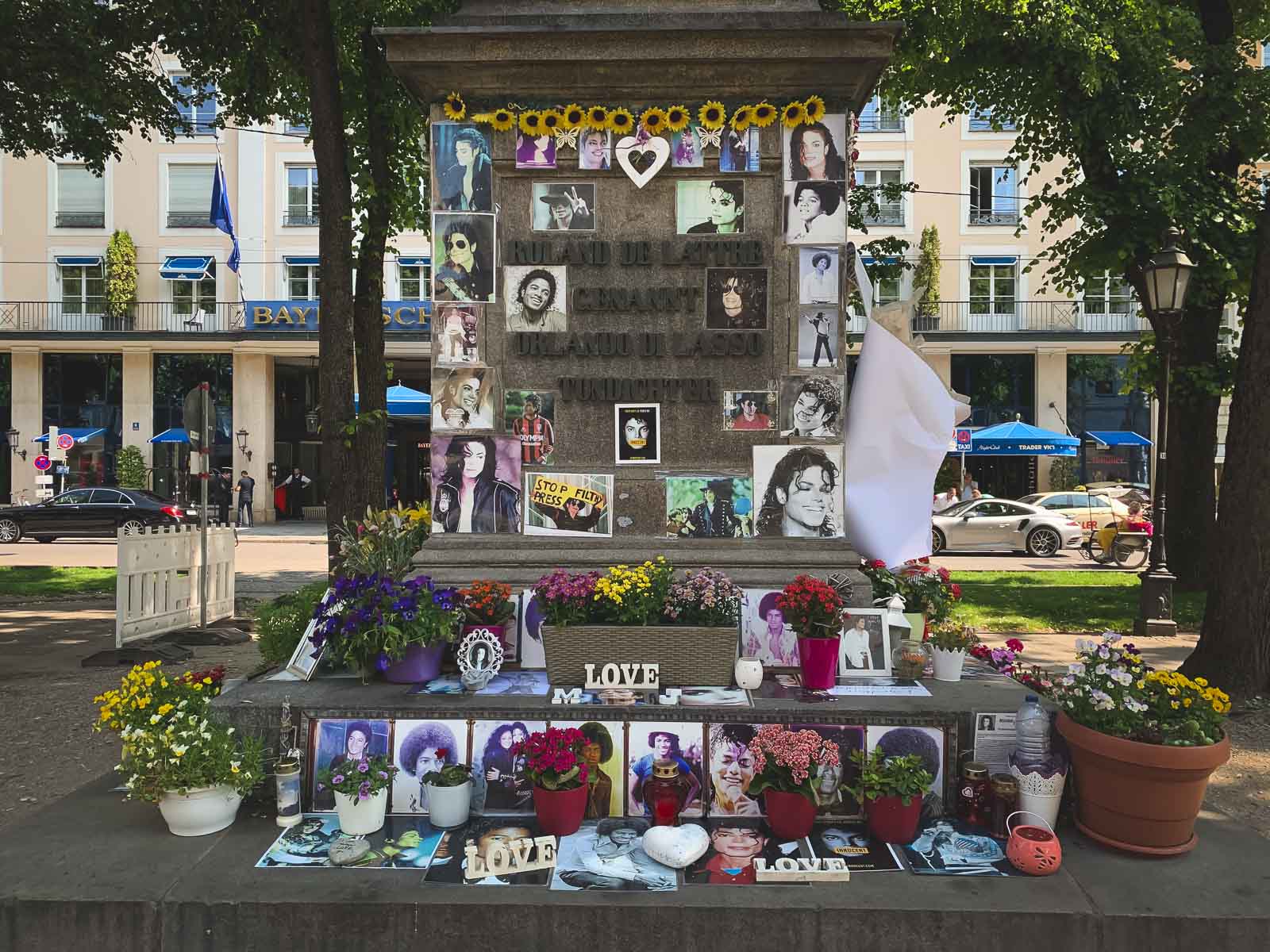
If you are looking for something quirky to see in Munich, check out the Michael Jackson Memorial. Michael Jackson frequented Munich and in front of his favorite hotel the five-star hotel Bayerischer Hof.
There is a makeshift memorial to Jackson on the Orlando de Lace monument. His statue has been taken over by Michael Jackson memorabilia left by adoring fans. Address: Promenadepl. 2-6, 80333 München
29. Museums in Munich
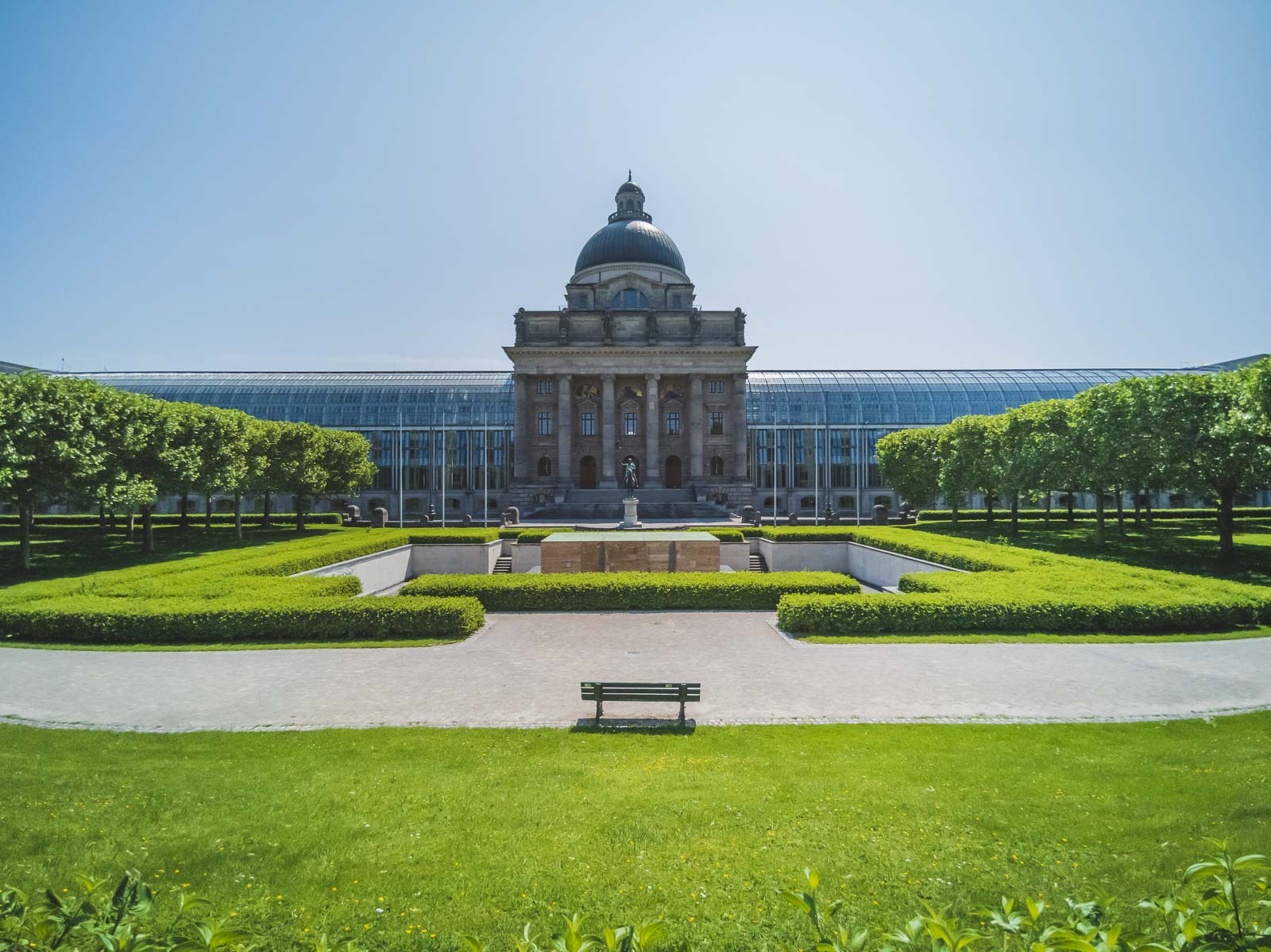
One could spend weeks exploring all of Munich’s museums and art galleries. In fact, there are 126 museums in Munich. There are art museums, history museums, modern museums, and science. Munich museums that are not to be missed are Alte Pinakothek (Old Picture Gallery), the Neue Pinakothek (New Picture Gallery), The Pinakothek der Moderne (Modern Art Museum), the Museum Brandhorst and the Sammlung Schack.
30. Oldest Museum in Munich
The Glyptothek is the oldest museum in Munich and is worth checking out. We mentioned King Ludwig’s love for Italy above and this museum houses his collection of classical Greek and Roman sculptures. It dates back to 1830.
31. Bavarian National Museum
No trip to Munich would be complete without a visit to the Bavarian National Museum. Founded by King Maximilian II in 1855 it is one of the most important museums in Bavaria showcasing its cultural history and art and artifacts dating back to prehistoric times.
32. Deutsches Museum
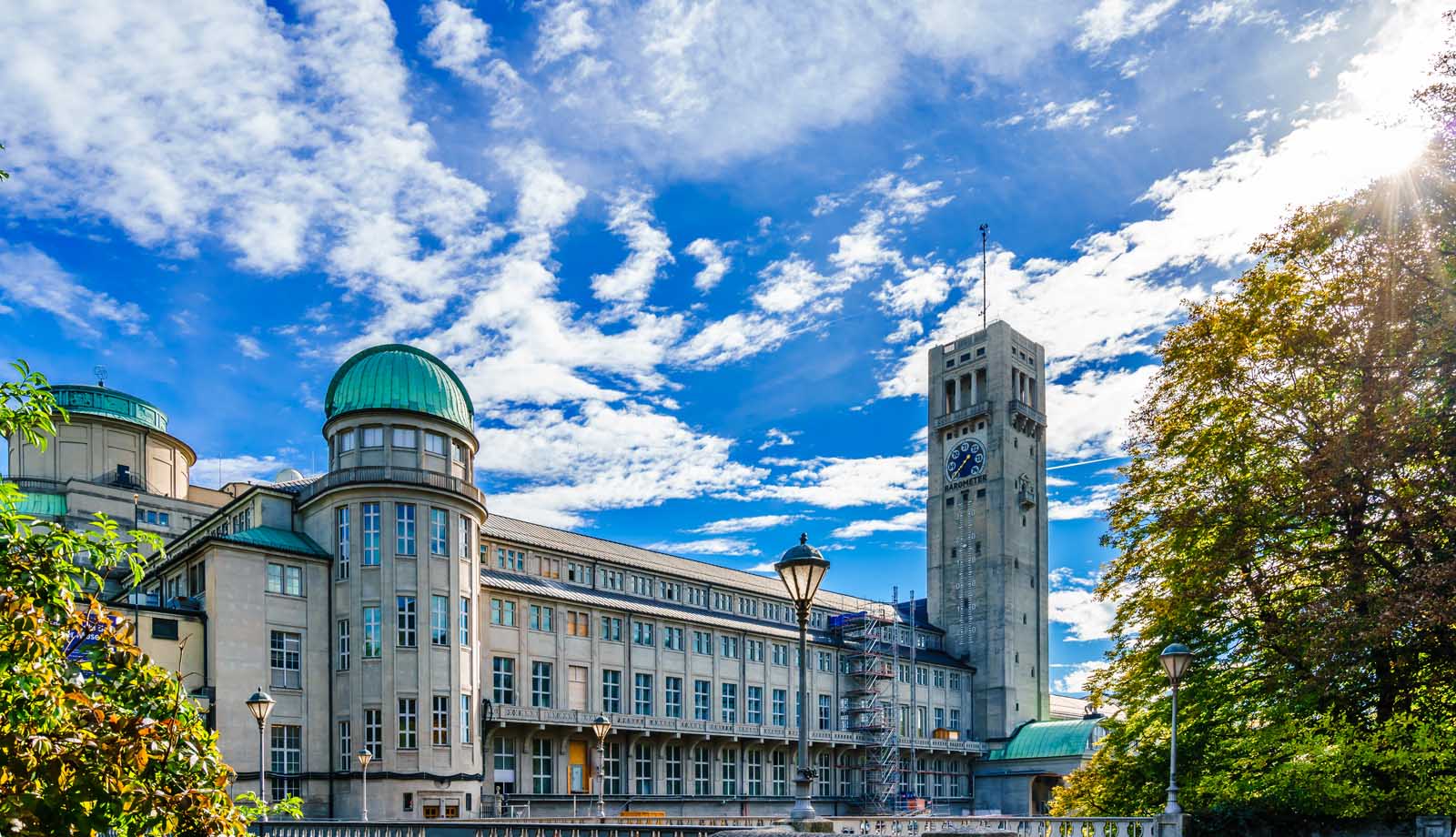
Choosing museums to see in Munich can be overwhelming with so many of them, but the Deutsches Museum is a cool place to visit in Museum to take a walk through time. This Museum of technology is the world’s largest museum of science and technology taking you from early innovations to the high-tech world of today. One cool thing to see in Deutsches Museum is a replica of the Red Baron’s plane from WWI.
Hot Tip: Every Sunday, some museums cost €1: Museums include the Alte Pinakothek, the Pinakothek der Moderne or the Brandhorst Museum, the Bavarian National Museum, and the Museum of Man and Nature and many more. Check the official website to see what museums offer €1 entry.
33. Alte Pinakothek (Old Picture Gallery)
The Alte Pinakothek is one of the oldest and most important art galleries in the world. The museum houses a vast collection of European art from the Middle Ages to the end of the Rococo period, with a focus on German, Flemish, Dutch, Italian, and Spanish artists.
It was founded in 1836 by King Ludwig I of Bavaria, who was a great lover and patron of the arts. The museum’s collection includes masterpieces by some of the greatest artists in history, such as Albrecht Dürer, Rembrandt, Peter Paul Rubens, Raphael, and Leonardo da Vinci.
Some of the most famous paintings in the collection include Dürer’s “Four Apostles,” Rubens’ “The Last Judgment,” and Caravaggio’s “The Crowning with Thorns.”
34. Nymphenburg Palace (Schloss Nymphenburg)
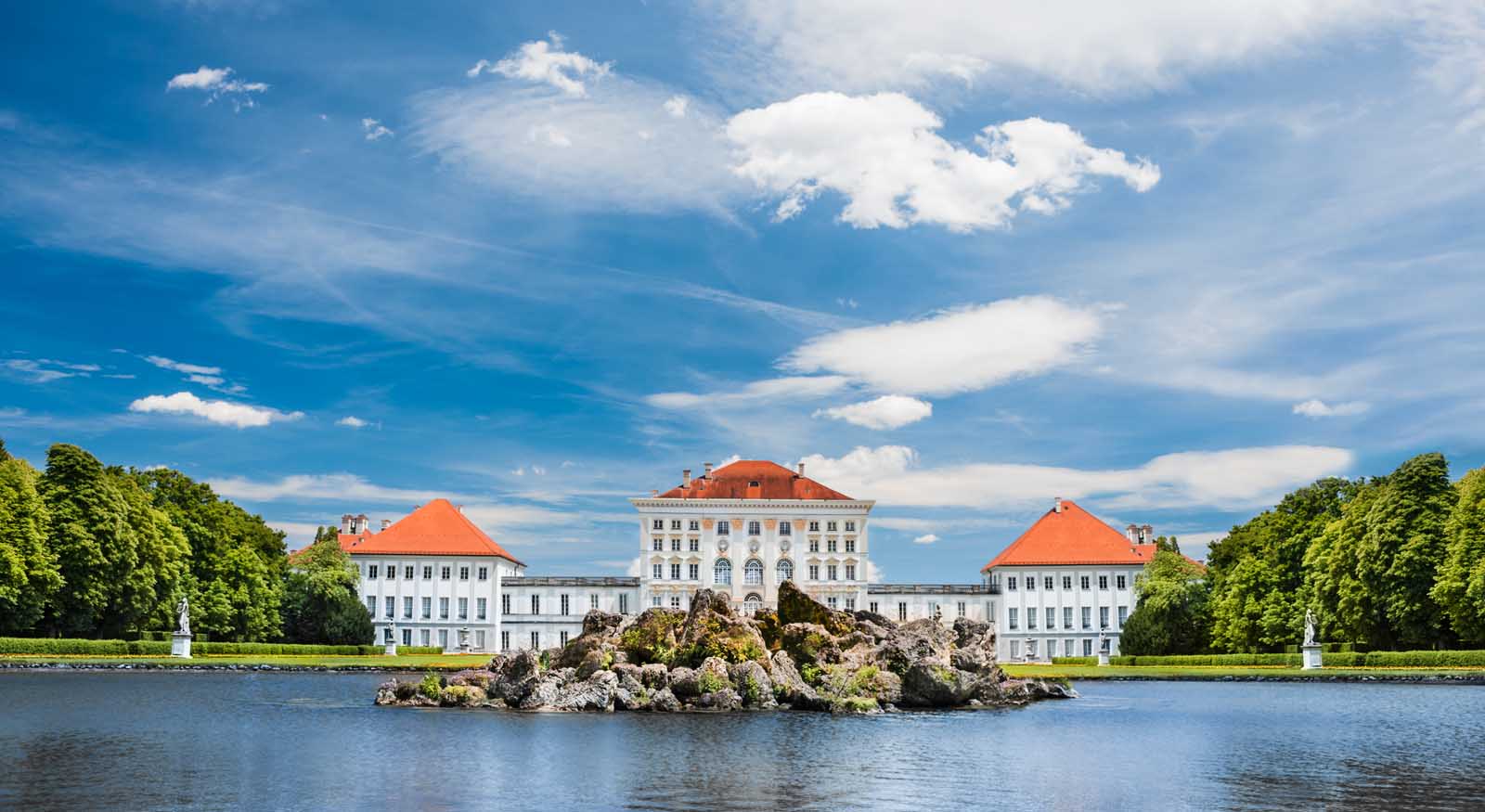
Nymphenburg Palace is a beautiful sprawling palace that was used as the main summer residence for the former rulers of Bavaria of the House of Wittelsbach. Places of note to see are The Hall of Mirrors, Grand Hall, Carriage House, and the Royal Hunting Lodge.
Schloss Nymphenburg is located 30 minutes outside the city center and you can get there by tram. Or Nymphenburg Palaces is a stop on the hop on hop off bus that makes it easy to get around the city to see the top places to visit in Munich at your own pace. You can then book a guided tou r to see inside Nymphenburg Palace complex as you learn about the history of the cancel.
Best Day Trips from Munich
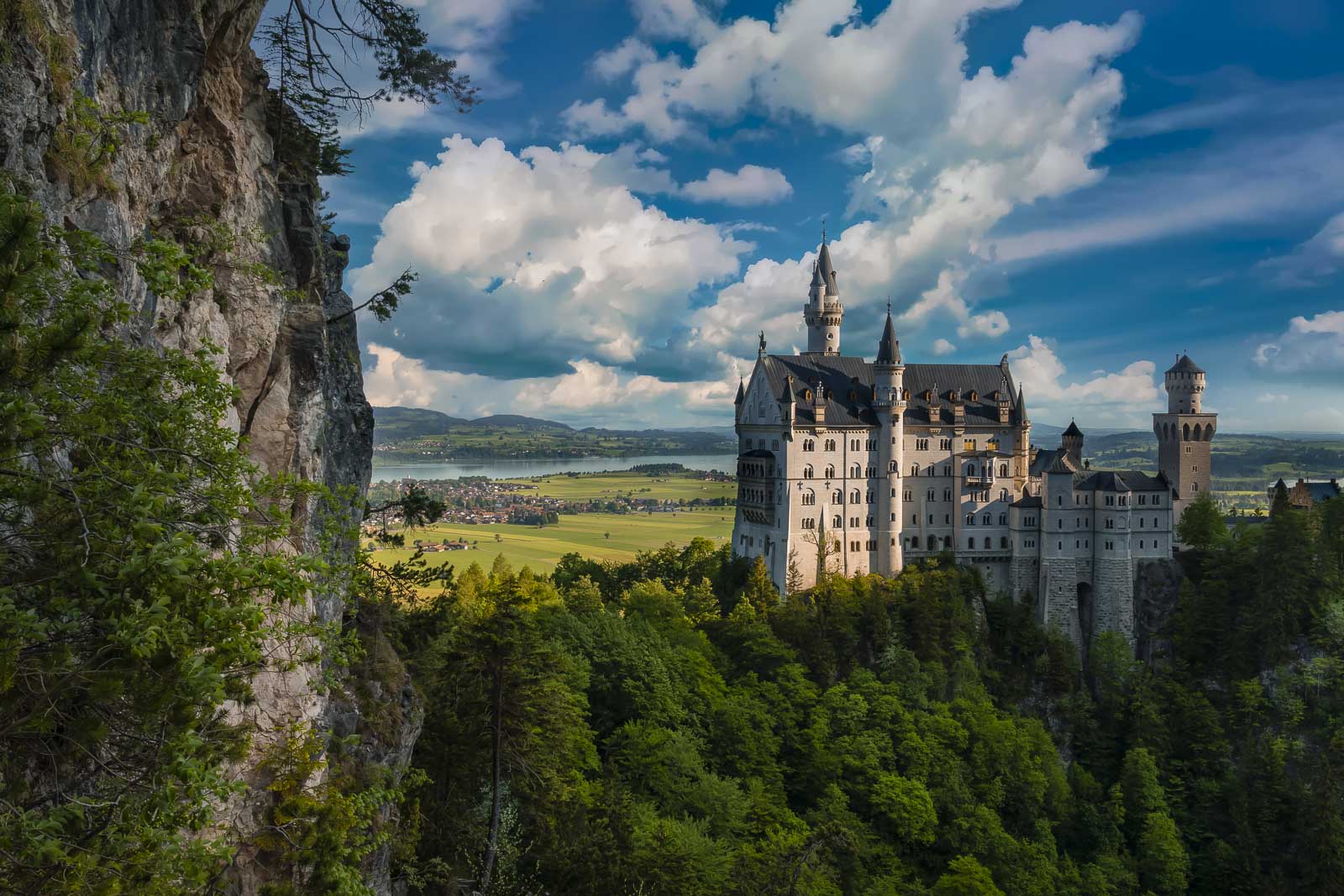
When visiting Munich, you must not forget to explore Bavaria. This is one of the best places in Germany for outdoor adventures, beautiful fairytale castles , and fascinating history. While you need weeks to really explore it, some of the best day trips from Munich are just a short drive away.
35. Neuschwanstein Castle
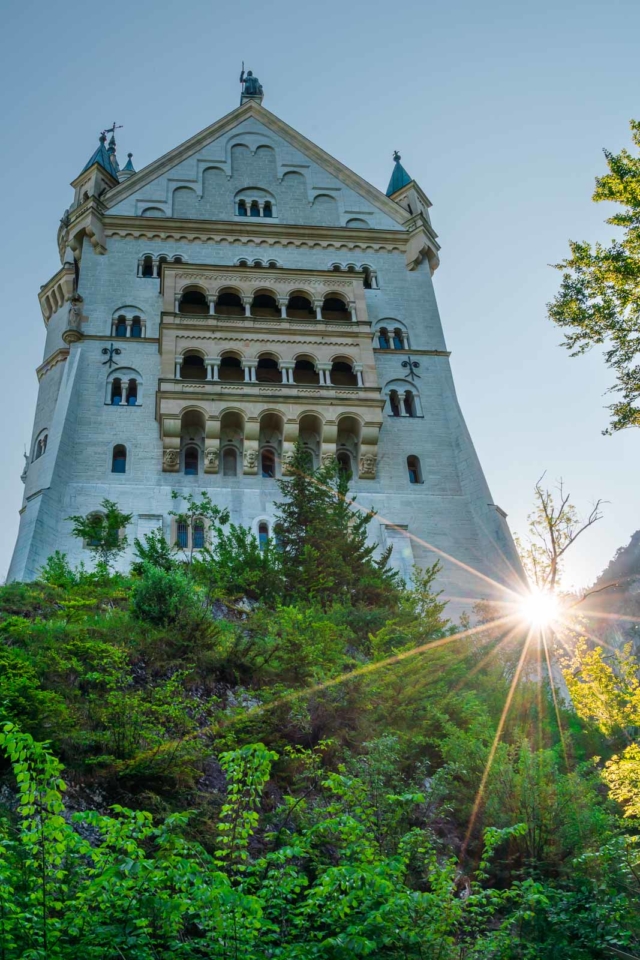
Neuschwanstein Castle is the epitome of the fairytale castles one comes to expect from Europe. In fact, Walt Disney modeled Cinderella’s castle after Neuschwanstein Castle. Located just 90 minutes from Munich, this is the castle is not to be missed.
This full day tour from Munich takes you from Munich to see two of Bavaria’s most famous castles, Neuschwanstein and Linderhof. You’ll also enjoy lunch in the town of Hohenschwangau and travel to Oberammergau.
36. Linderhof Palace
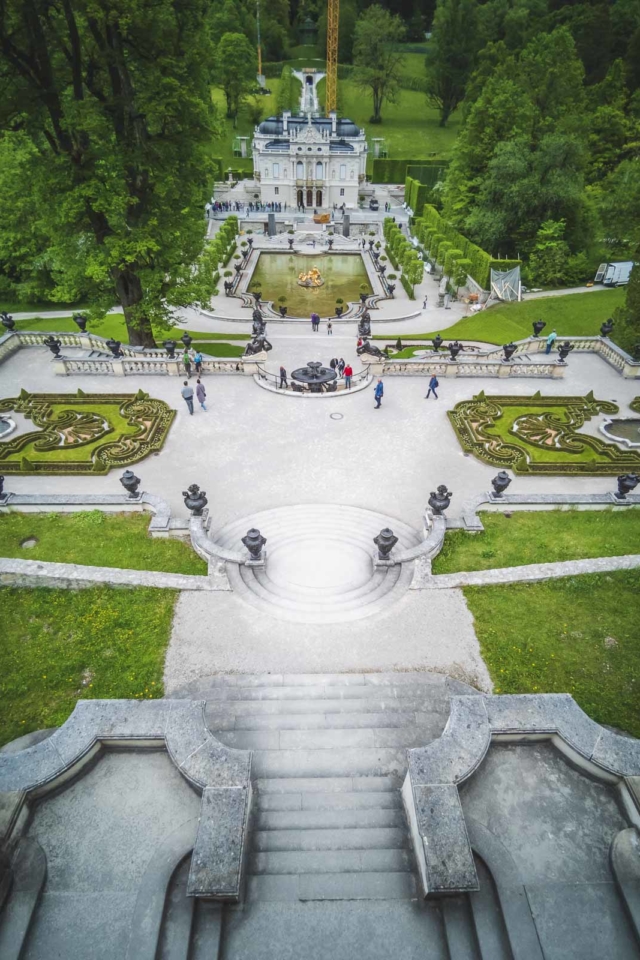
Set within the rolling Bavarian countryside Linderhof Palace is one of three separate country palaces commissioned by King Ludwig II. The palace contains sculptures and statues, a fountain that reaches 25 meters high from pressure alone and gardens. This is a beautiful palace modeled after the Palace of Versailles in France.
This full day tour is recommended and takes Neuschwanstein and Linderhof. two of Bavaria’s most famous castles, Neuschwanstein and Linderhof. You’ll also enjoy lunch in the town of Hohenschwangau and travel to Oberammergau.
37. Dachau Memorial Site
The Dachau Concentration Camp is a somber memorial to those who died during the Nazi Regime. It was the first concentration camp built by Nazi Germany and serves as a reminder of the atrocities that were committed by the regime. This is a historic site that is to be respected when visiting to honor those who suffered greatly during World War II.
You can book a guided tour to visit the Dachau Concentration Camp Memorial, a place of memory and of education. The guides are trained to convey often difficult and disturbing material to you with sensitivity, with dignity, with respect for the victims,
38. Salzburg
Want to pop into Austria? Make sure to visit the city of Salzburg if you have the time. We always love adding a country to our list when traveling and this is an easy day trip from Munich. Salzburg is the birthplace of Mozart and is significantly known for its Baroque architecture. In fact, because of this, it is a UNESCO World Heritage Site.
And these are the best things to do in Munich Germany. Munich is one of Germany’s most exciting cities. It took us several visits to Germany before visiting Munich and we wish we did it sooner. It has easily turned shot to the top of our list of the best cities in Europe to visit in your lifetime.
Getting Around Munich
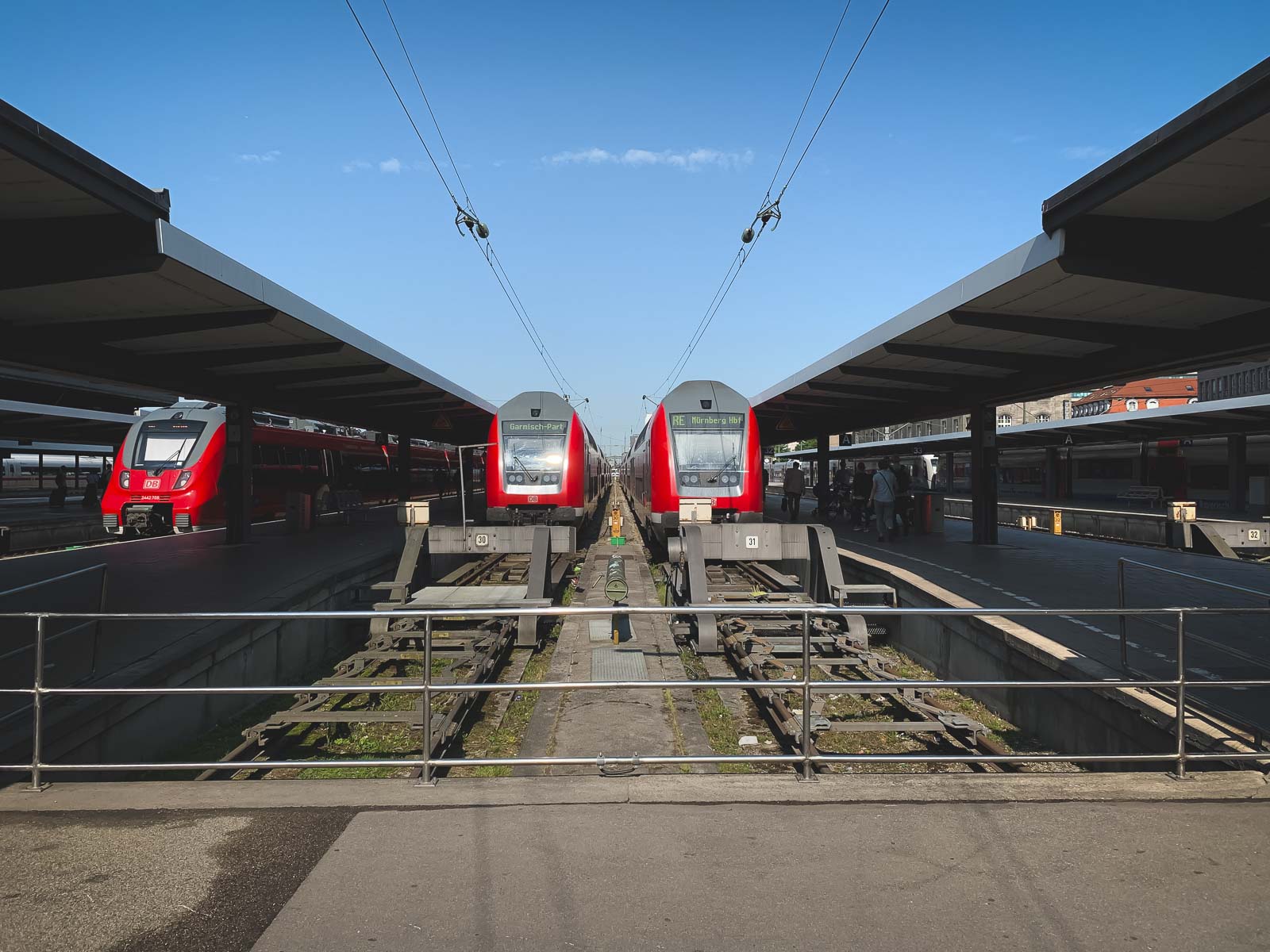
It is easy to get around Munich with public transport. Their public transit system goes everywhere, really economical. You can easily interchange from one mode of transportation to another with a valid ticket. Note: make sure to validate your ticket before getting on the train
- The U-Bahn (underground railway) is fast and efficient avoiding traffic and congestion.
- Straßenbahn ( tram) – This is an excellent mode of transportation in Munich with many stops.
- S-Bahn (aboveground railway) – similar to the U-Bahn but it runs above ground.
Walking – Downtown Munich is a very walkable city and you can see a lot of the top attractions in Munich by foot.
Cycling – Cycling is definitely our favourite way to get around Munich when the weather is nice. With 1,200 kilometers of cycling trails, Munich is definitely a bike-friendly city.
For exploring Bavaria , we rented a car and this really was the best way to get around this beautiful section of Germany. See CarRentals.com for price comparisons
Where to Stay in Munich
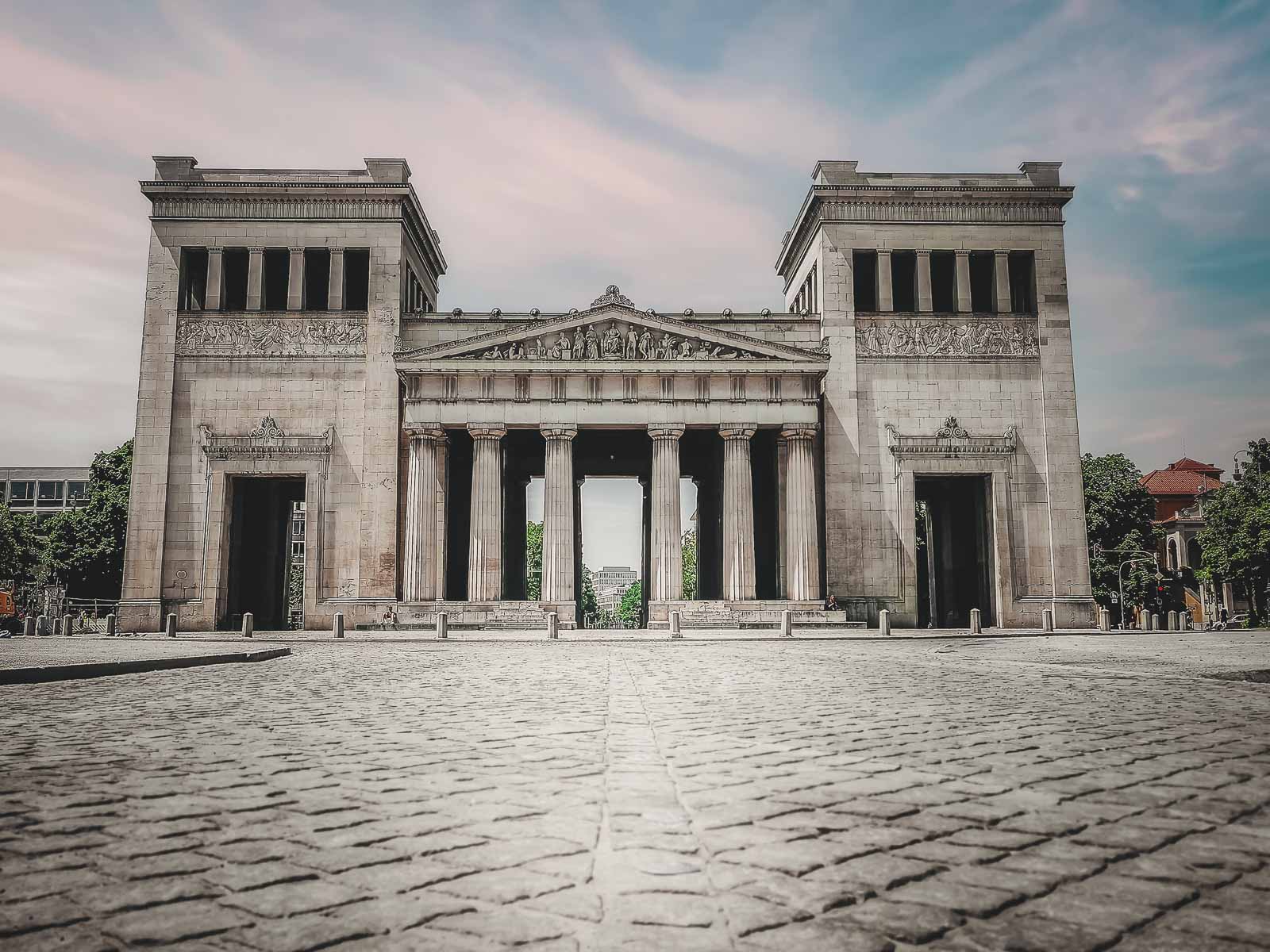
We stayed at the Hilton Garden Inn at Munich City West. It is close to the metro and is just two stops from the main square in the city center. But there are many great places to stay in Munich to make the most of your time in the city that are closer to the top Munich attractions.
Altstadt – This is Munich’s historic center and is a great choice for visitors who want to be close to the city’s main attractions, such as Marienplatz, the Viktualienmarkt, and the Hofbräuhaus. Hotels in this area can be a bit more expensive, but the convenience is worth it for many travelers.
The Mandarin Oriental – The Mandarin Oriental is the premiere luxury hotel in Munich Altstadt. It’s 5-minute walk from Marienplatz Square and near Maximilianstraße. Convenient location with 5 star luxury.
Maxvorstadt – This trendy neighborhood is home to many of Munich’s best museums, galleries, and universities. It’s a great choice for culture vultures who want to be close to the action and experience the city’s vibrant art scene.
Rocco Fort the Charles Hotel – This luxury hotel is 5-star luxury with an indoor pool, spa and sauna. It’s located near the Old Botanical Garden.
Schwabing – This bohemian neighborhood is known for its laid-back vibe, colorful street art, and charming cafes and bars. It’s a great choice for travelers who want to experience Munich’s more offbeat side.
Andaz Munich Schwabinger Tor – We love an Andaz Hotel and this 5-star hotel is located between the Olympic Stadium and the English Garden making it the perfect location for outdoor lovers. It features a rooftop bar, spa and pool.
Haidhausen – This historic neighborhood is located just across the river from the Altstadt and is known for its picturesque streets and charming architecture. It’s a great choice for travelers who want to experience Munich’s quieter side while still being close to the city center.
MOMA1890 – Beautiful boutique hotel in the heart of the artist district Haidhausen.
And there you have it, the best places to visit in Germany. From exploring the city’s famous landmarks like the Marienplatz and Frauenkirche to enjoying a cold beer at one of its traditional Bavarian beer gardens, there are endless opportunities to explore and discover in Munich. With so many things to do in Munich, the city is a must-visit destination for anyone looking to experience the best of Germany.
Plan Your Next Trip to Germany With These Resources
- 20 of The Best Things to do in Bavaria
- Things to do in Garmisch Partenkirchen, Germany
- Top 16 Fun Facts About Germany That You Probably Didn’t Know
- The Best Places to Visit in Berlin, Germany
Travel Planning Resources
Looking to book your next trip? Why not use these resources that are tried and tested by yours truly.
Flights: Start planning your trip by finding the best flight deals on Skyscanner
Book your Hotel: Find the best prices on hotels with these two providers. If you are located in Europe use Booking.com and if you are anywhere else use TripAdvisor
Find Apartment Rentals: You will find the cheapest prices on apartment rentals with VRBO .
Travel Insurance: Don't leave home without it. Here is what we recommend:
- Allianz - Occasional Travelers.
- Medjet - Global air medical transport and travel security.
Need more help planning your trip? Make sure to check out our Resources Page where we highlight all the great companies that we trust when we are traveling.
You May Also Like
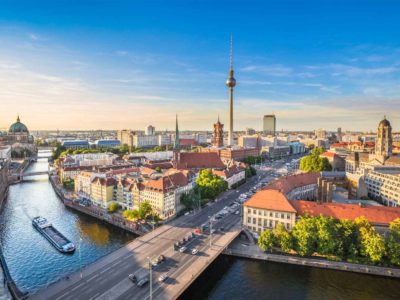
Where To Stay in Berlin In 2024: Best Areas And Places
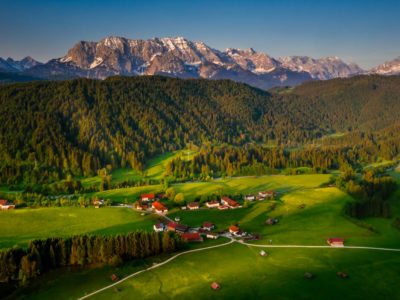
17 Best Day Trips from Munich in 2024
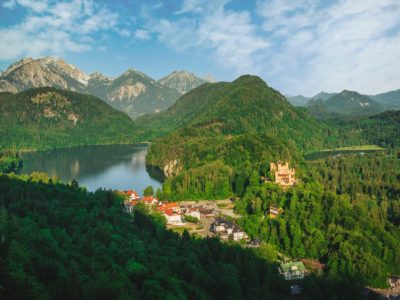
17 Best Castles in Germany To Visit in 2024
About The Planet D
Dave Bouskill and Debra Corbeil are the owners and founders of The Planet D. After traveling to 115 countries, on all 7 continents over the past 13 years they have become one of the foremost experts in travel. Being recognized as top travel bloggers and influencers by the likes of Forbes Magazine , the Society of American Travel Writers and USA Today has allowed them to become leaders in their field.
Join thousands of others who get our monthly updates!
Leave a comment cancel reply.
Save my name, email, and website in this browser for the next time I comment.
4 thoughts on “37 Of The Best Things to Do in Munich, Germany”
We just got back from our trip to Germany and Austria. I wanted to thank you for pointing out the Documentation Centre. It really made an impact on us. I think we would have missed it if I hadn’t read this article. Keep sharing your adventures!
Nice content! Thank you for sharing the post.
Great tips, Munich is beautiful!
Great read! Thank you for posting this! I’ve been to Munich a couple of times growing up (twice with my family, and once with a couple of friends when I was 14) – but we’ve always just used the city as a starting base to visit the day trip areas listed.
I didn’t realize that there were so many other great places within the city to explore! I’ll definitely be adding this to my bucket list of things to do the next time I visit Munich!
Munich Travel Guide

Courtesy of Michael Fellner | Getty Images

Why Go To Munich
Despite its reputation as one of Germany's most expensive cities, Munich attracts visitors in droves who are charmed by its blend of tradition and modernity. As well as hosting the iconic 200-year-old Oktoberfest, the city also serves as a European hub for publishing and technology. Nuzzling the Bavarian Alps and situated beside the River Isar, Munich boasts natural beauty as well as bustling streets lined with designer shops and shiny BMWs. In short, you should visit the Bavarian capital for both its provincial charm and progressive spirit.
Find Flight and Hotel Deals
Navigate forward to interact with the calendar and select a date. Press the question mark key to get the keyboard shortcuts for changing dates.
Navigate backward to interact with the calendar and select a date. Press the question mark key to get the keyboard shortcuts for changing dates.
- # 2 in Best Places to Visit in Germany
- # 8 in Best Places to Visit in March 2024
- # 17 in Best Christmas Vacations
Best of Munich
Best hotels in munich.
- # 1 in The Charles Hotel, a Rocco Forte Hotel
- # 2 in Andaz Munich Schwabinger Tor - a concept by Hyatt
- # 3 in Mandarin Oriental, Munich

Best Things to Do in Munich
- # 1 in Marienplatz
- # 2 in English Garden (Englischer Garten)
- # 3 in Munich Residence (Residenz München)

Popular Tours

Neuschwanstein Castle and Linderhof Palace Day Tour from Munich
(6195 reviews)
from $ 79.61

Neuschwanstein Castle and Linderhof VIP All-Inc Tour from Munich
(1528 reviews)
from $ 214.51

Neuschwanstein Castle and Linderhof Palace Day Trip from Munich
(781 reviews)
from $ 76.29
Munich Travel Tips
Best months to visit.
The best time to visit Munich is from March to May: the Christmas market crowds have long since departed, summer’s peak season hasn’t yet hit, spring blossoms bring color to the streets and temperatures are comfortable, averaging between 40 and 60 degrees Fahrenheit. In the summertime, temperatures linger in the 70s – ideal beer garden weather – but consider bringing a light sweater for Munich's slightly cooler evenings. If you’re one of the millions who want to party at Oktoberfest during the fall, you’ll need to pack a jacket. Winter, except for the holiday months of December and the beginning of January, is mostly this city's low season. Temperatures drop, so opt for a warm coat and layers.
Weather in Munich
Data sourced from the National Climatic Data Center
What You Need to Know
Munich’s beer is strong German beer has a higher alcohol content than American brews; U.S. visitors should pace themselves. Also, note that at Oktoberfest, beer is sold in liter quantities (also for certain beers at beer halls and beer gardens).
Munich is expensive Keep in mind that Munich's vibrant culture and high quality of life come with a price tag, so budget accordingly for your visit to this beautiful city.
Münchners speak German Many speak English, too, but do be polite to locals and begin your conversation with " Sprechen Sie Englisch ?" (“Do you speak English?)
How to Save Money in Munich
Bring your own food You can BYOF to many beer gardens (if you buy drinks there), so head to the market and buy your picnic wholesale.
Take public transit Because the city's systems are so efficient, a rental car is unnecessary. If you’re traveling elsewhere in Bavaria or Germany, the regional and long-distance train networks are easy to navigate and good value, particularly if you book in advance.
Visit museums on Sundays Admission to many of the city’s museums is only 1 euro (about $1.10) on Sundays.
Culture & Customs
Part of a culture that values planning and formalities, Germans are generally reserved. Punctuality is greatly prized. Rules are extremely important to Germans. Do not jaywalk or litter, as you may be subject to a fine.
Although many people speak English in large cities like Munich, it is helpful to learn a few German phrases. Remember to say bitte (“please” and “you're welcome”), as well as danke (“thank you”), and you'll make a good impression.
You should also be mindful of your mannerisms. Whistling at the end of or during a performance is considered a sign of displeasure. When interacting with people one-on-one, remember that touching during conversation or standing less than an arm's length apart on the first meeting is considered an invasion of privacy.
Munich's official currency is the euro. Since the euro to U.S. dollar exchange rate fluctuates, be sure to check what the current exchange rate is before you go. Major credit cards are accepted at some restaurants and shops, but cash is still king in Germany, so be sure to always have some with you.
What to Eat
Bavarian fare is extremely hearty — think roast pork, sausages and piles of potatoes and dumplings. However, there’s also a wide range of international restaurants in Munich. To sample the city’s variety of cuisines, plan to visit the train station quarter (Bahnhofsviertel) for everything from Croatian to Uyghur dishes. For a traditional Bavarian breakfast, order a Weißwurstfrühstück (literally “white sausage breakfast”) – veal sausages with a pretzel, sweet mustard and a glass of wheat beer (Weißbier).
Some say Munich is so safe, it borders on being boring. Still, there are a few things travelers should be aware of – namely jaywalking (it’s illegal) and walking along bike paths, which sidle many of the roads or take up part of sidewalks and are for bikers only. Cyclists are pretty territorial about them, so stick to the footpaths only. And if you're traveling to Munich during Oktoberfest, you might encounter some drunken revelry. Munich may be Germany’s safest city, but it’s still a major one, so keep an eye on your bags and pockets on public transport and touristy areas, and take care in quiet areas after dark if you’re on your own.
Getting Around Munich
The best way to get around Munich is on foot since many of the top things to do are located close to one another. If your feet grow weary, make use of the city's excellent public transportation – the underground train (U-Bahn), local rail service (S-Bahn), tram or bus. The S1 and S8 S-Bahn trains run frequently from Munich International Airport, also known as Franz Josef Strauss Airport (MUC), located just about 20 miles northeast of the downtown area, right into the center of the city. Taxis are available from the airport, too, but these are expensive. If you're on a budget, opt for the S-Bahn.
Entry & Exit Requirements
You will need a passport that is valid for at least three months beyond your planned date of departure. Those who wish to stay in Germany longer than 90 days must contact an embassy or consulate before leaving the U.S. For more information on entry and exit requirements, visit the U.S. Department of State's website .
Munich is home to multiple Christmas markets around the holidays.
Explore More of Munich

Things To Do
Best hotels.

You might also like

# 1 in Best Places to Visit in Germany

# 6 in Best Christmas Vacations

# 9 in Best Winter Vacations in Europe
If you make a purchase from our site, we may earn a commission. This does not affect the quality or independence of our editorial content.
Recommended
The 28 Best Water Parks in the U.S. for 2024
Holly Johnson|Timothy J. Forster May 8, 2024

The 18 Best Napa Valley Wineries to Visit in 2024
Lyn Mettler|Sharael Kolberg April 23, 2024

The 25 Best Beaches on the East Coast for 2024
Timothy J. Forster|Sharael Kolberg April 19, 2024

The 50 Best Hotels in the USA 2024
Christina Maggitas February 6, 2024

The 32 Most Famous Landmarks in the World
Gwen Pratesi|Timothy J. Forster February 1, 2024


9 Top All-Inclusive Resorts in Florida for 2024
Gwen Pratesi|Amanda Norcross January 5, 2024

24 Top All-Inclusive Resorts in the U.S. for 2024
Erin Evans January 4, 2024

26 Top Adults-Only All-Inclusive Resorts for 2024
Zach Watson December 28, 2023

Solo Vacations: The 36 Best Places to Travel Alone in 2024
Lyn Mettler|Erin Vasta December 22, 2023

26 Cheap Beach Vacations for Travelers on a Budget
Kyle McCarthy|Sharael Kolberg December 4, 2023

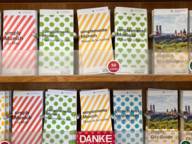
Munich tourist information
The tourist information office is the place to go for anyone who wants to explore the city of Munich easily and in comfort. We not only offer expert personalised advice, but also have many helpful leaflets, brochures and flyers to browse.
Whatever you want to see in Munich, our information materials and personalised advice are sure to help you get an in-depth insight into the city’s artistic, cultural and leisure offerings. So why not call in to see us on Marienplatz or at Hauptbahnhof train station? We look forward to answering any questions you may have about your stay in Munich.
Tourist information at Marienplatz
The Tourist Information on Marienplatz is open again. We are looking forward to your visit!
Tourist information at the main station
The tourist info of Munich Tourism is located one minute from the main station in Luisenstraße 1, close to the exit Arnulfstraße.
Our brochures
City map, tips for cycling in Munich and the current city guide of Munich Tourism: here you can find brochures and leaflets about the city of Munich for download.
Book now and simply discover Munich!
To explore Munich with its wide range of offers in a simple way, we introduce two new official visitor cards. All the benefits at a glance!
Our tips for your trip to Munich
Stopover, short trip, long weekend or a whole week: here are some ideas for your visit to Munich.
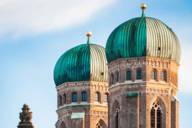
Frauenkirche: Visit of the South Tower
Book a visit to the observation deck of Munich's Frauenkirche and enjoy a 360-degree panoramic view of the city.

Viktualienmarkt Tasting Tour
Discover the most delicious delicacies of the city and learn all kinds of interesting facts about Munich's most famous food market.
Discover the most delicious delicacies of the city and learn all kinds of interesting historical facts about Munich's most famous food market.
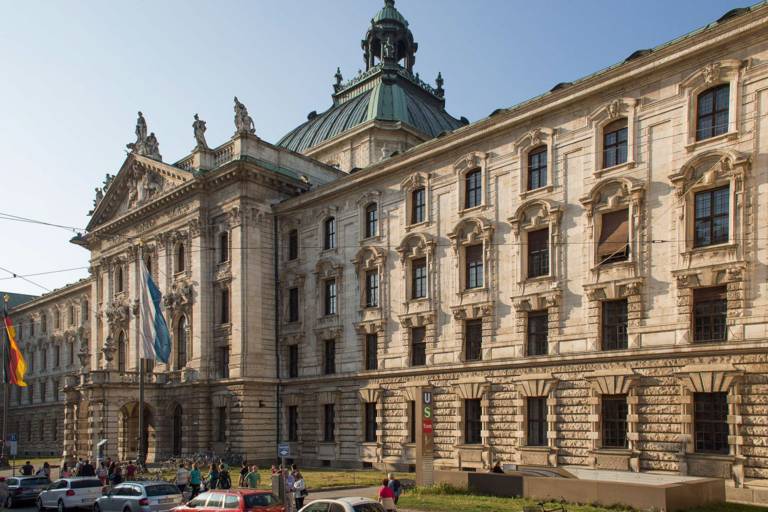
Justizpalast Tour
During the guided tour of the present-day seat of the Bavarian State Ministry of Justice, you will learn everything about the history and significance of the neo-baroque court and administrative building.
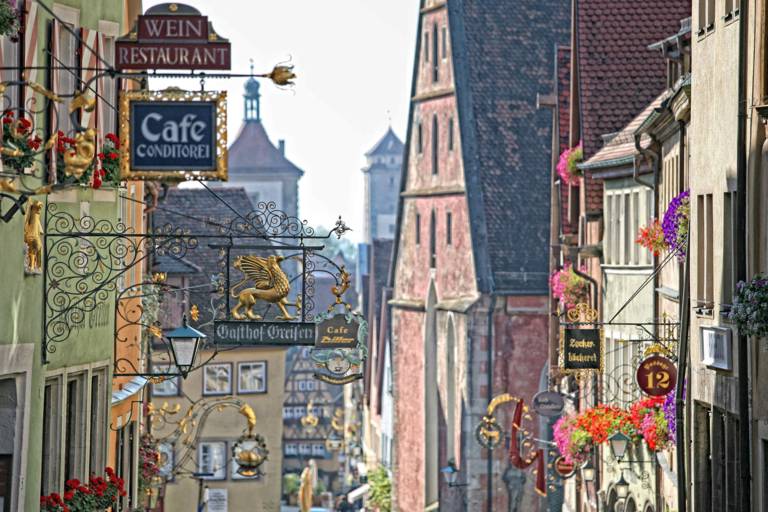
Romantic Road: Rothenburg and Harburg
Hop on and be whisked away by one of the world's most beautiful stretches of street: the Romantic Road to Rothenburg and Harburg.
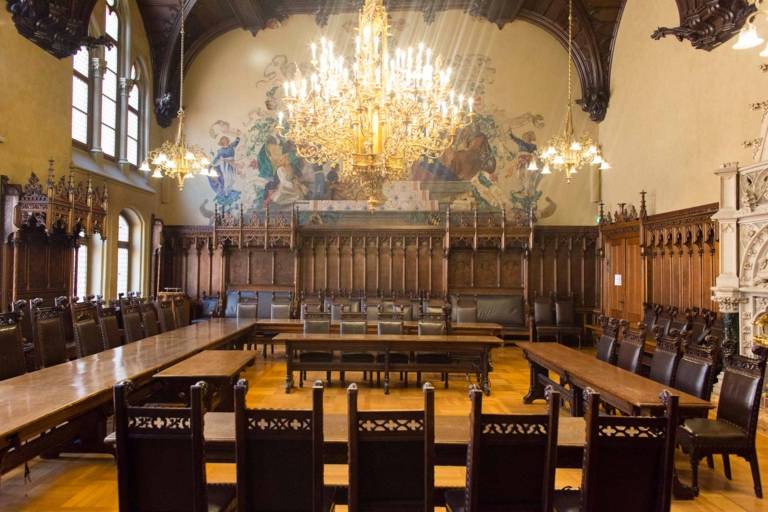
New Town Hall Tour
Explore the Neue Rathaus on Marienplatz with an official City of Munich tour guide. A visit of the famous law library is also included!
Explore the Neue Rathaus on Marienplatz with an official tour guide. A visit of the famous law library is also included!
Magistrates, Monachia and magnificent celebrations: explore the Neue Rathaus on Marienplatz with an official City of Munich tour guide. A visit of the famous law library is also included!
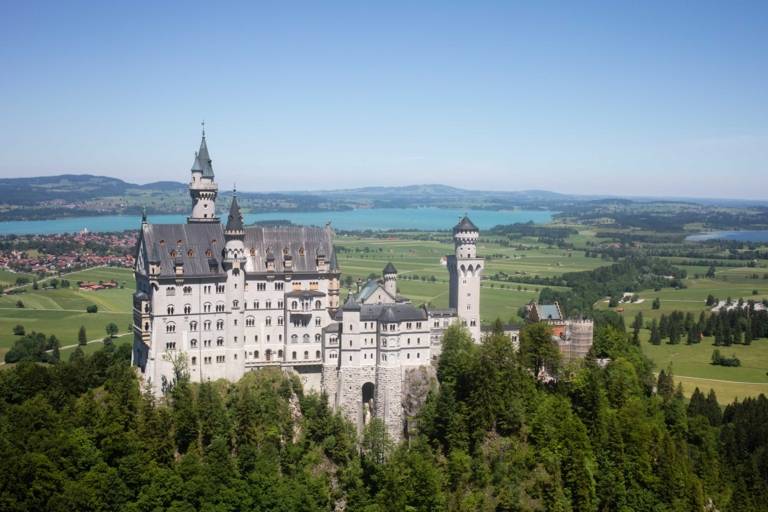
Dream castles Neuschwanstein & Linderhof
Immerse yourself in the world of the fairytale king!
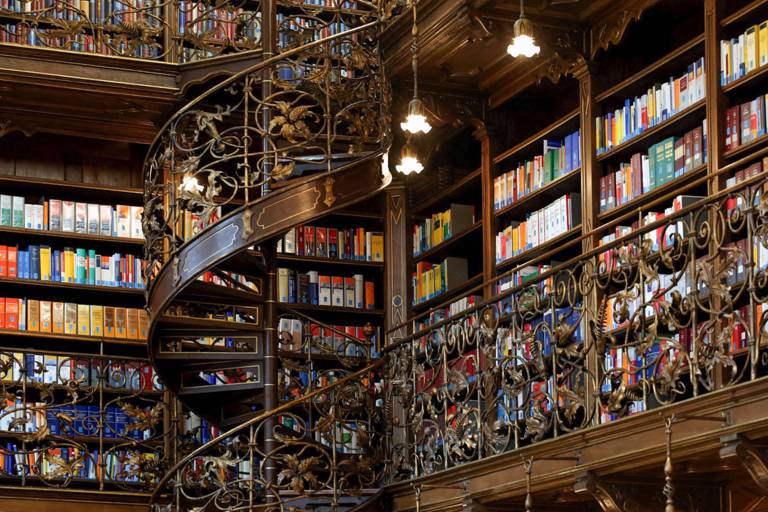
Visit of the Law Library: Juristische Bibliothek
Impressive architecture and unique ambience: discover the Law Library in the New Town Hall.
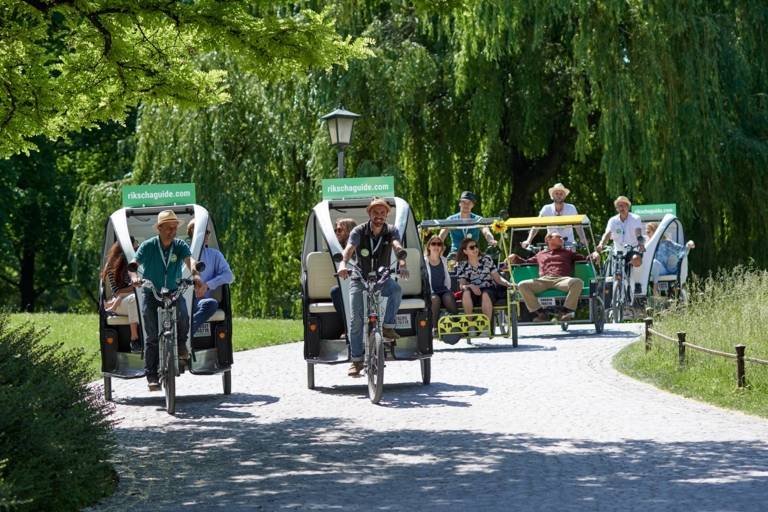
Pedicab tour through the old town and nature
Enjoy this special tour and pedicap ride past all the famous sights of Munich's old town and into the Englischer Garten.
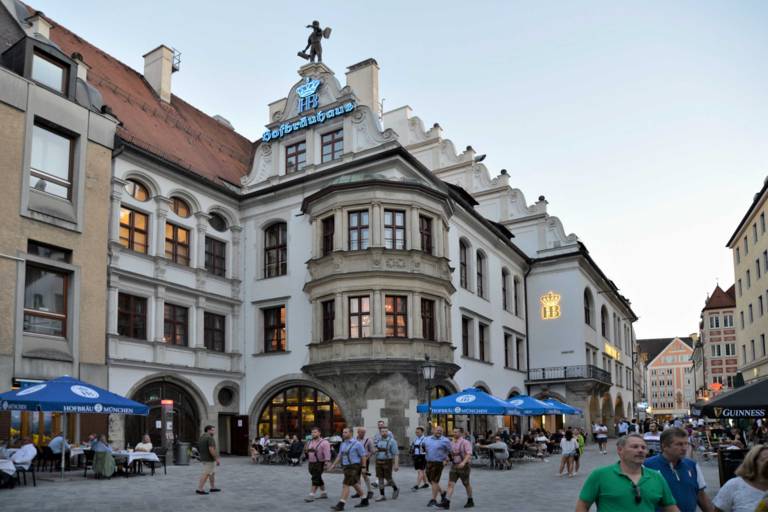
Hofbräuhaus Tour
Discover the most famous beer hall in the world with an official guide of the city of Munich and enjoy a fresh Mass of beer afterward!
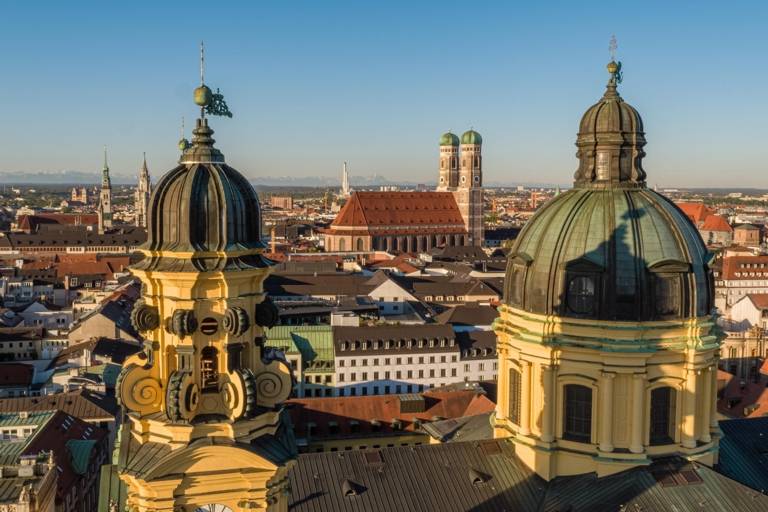
City trip incl. Munich Card and Tower Ascent
We look forward to seeing you again in Munich. Our tip: the exclusive travel package with Munich Card and Tower Ascent.
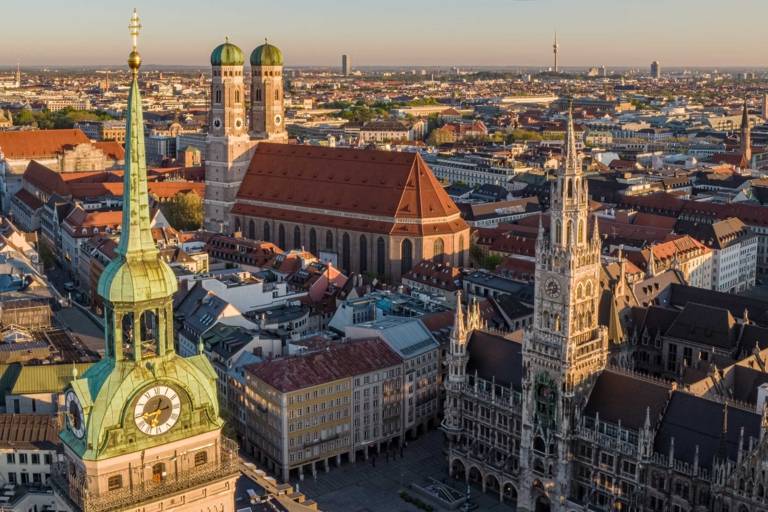
Old Town Tour
The city walk for everyone who wants to become acquainted with the most beautiful parts of Munich's city centre.
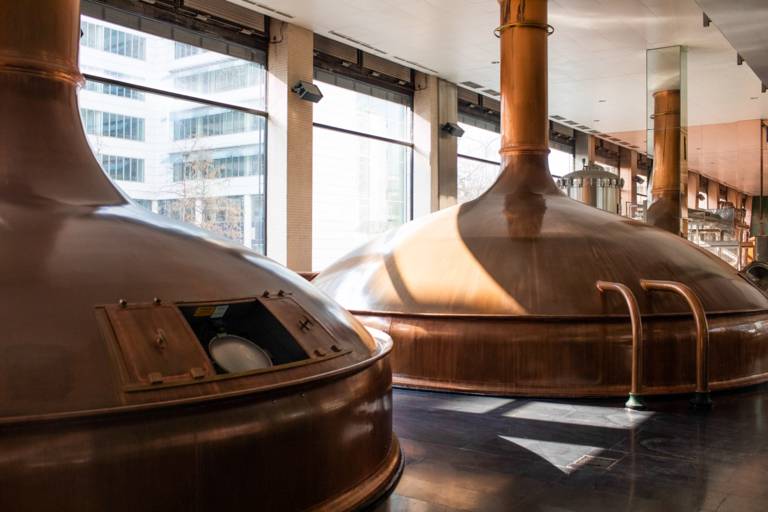
Spaten Brewery Tour
Experience a brewery tour at Spaten with a look behind the scenes, interesting facts about the company history and beer tasting in the brewery tower.
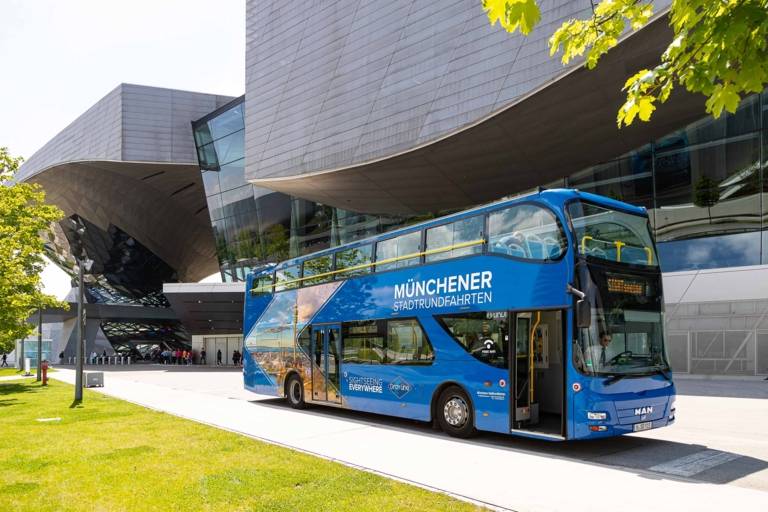
Hop-On Hop-Off city bus tours Gray Line
The hop-on hop-off city bus tours of Gray Line will let you collect unforgettable impressions of Munich.

Buy now vouchers for your visit in Munich. The ideal gift! Guided tours, guest cards and more...
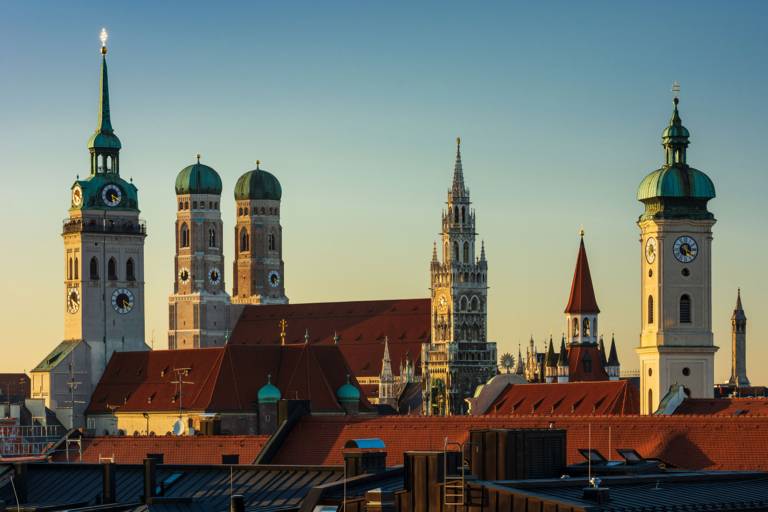
Private guided tour through Munich's Old Town
Exclusive and safe: Discover the most beautiful sights and corners of Munich's city centre with your official personal guide.
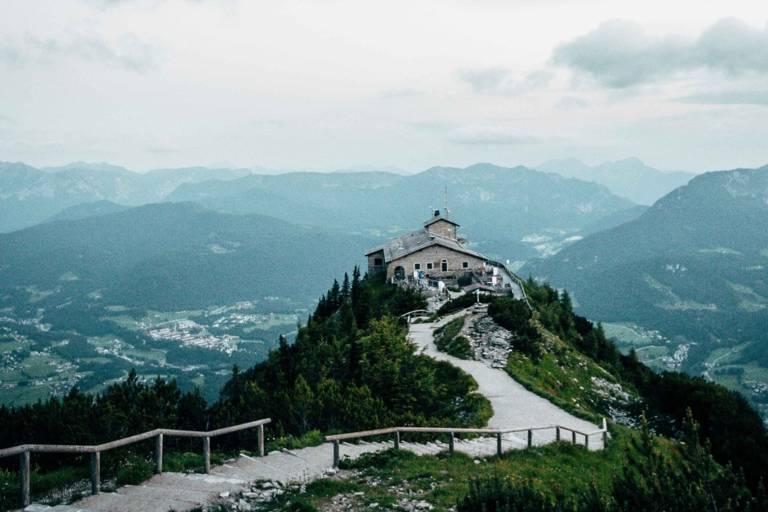
Berchtesgaden area and Eagle's Nest
The day trip takes you along the Alpine Road to Berchtesgaden area with its dreamlike scenery.
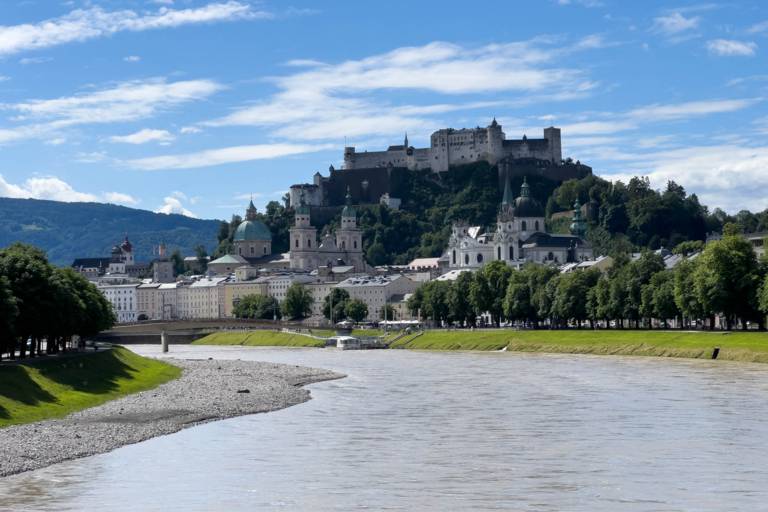
Salzburg and the Lake District
Visit the birthplace of Wolfgang Amadeus Mozart and relax on the journey to beautiful Lake Wolfgang.
Visit the birthplace of composer extraordinaire Wolfgang Amadeus Mozart, stroll through the Baroque old town and then relax on the journey to beautiful Lake Wolfgang.
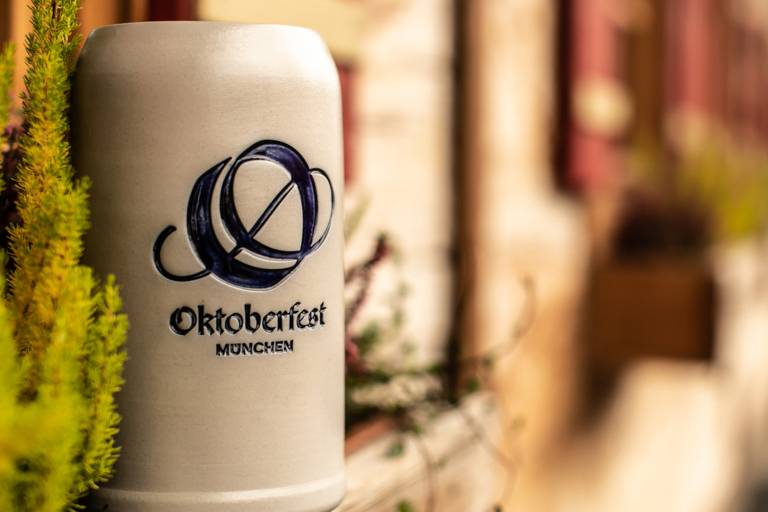
Oktoberfest Shop
Bring a piece of Oktoberfest home: Purchase official souvenirs such as the Wiesn poster or the Oktoberfest beer stein in the official Oktoberfest shop.
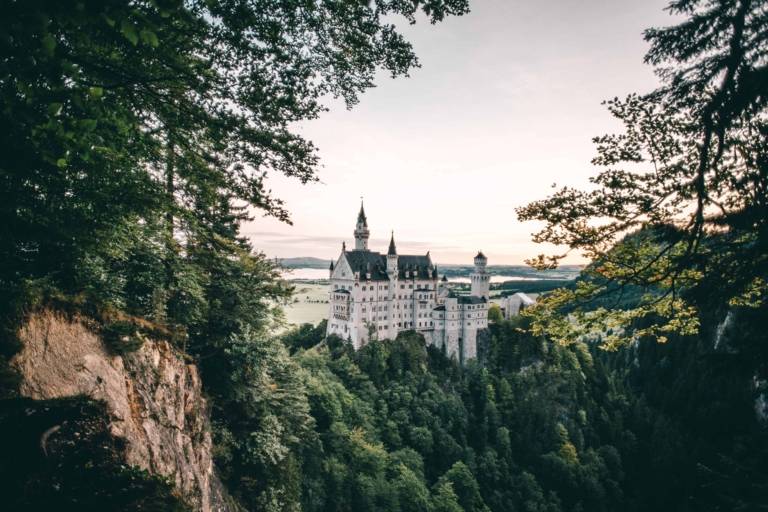
Dream castles Neuschwanstein & Linderhof VIP
As VIP in the footsteps of King Ludwig II. On this day tour in the luxurious long-distance coach of Gray Line Sightseeing you can visit both dream castles of the fairytale king.
A day tour in the luxurious long-distance coach of Gray Line Sightseeing.
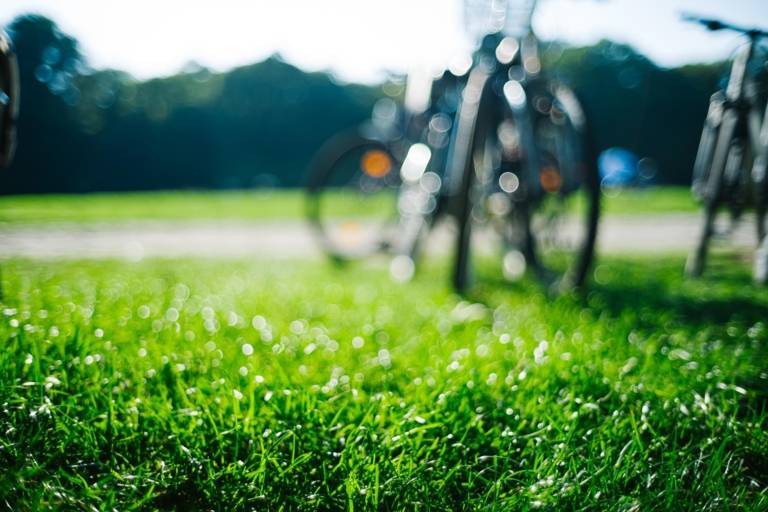
Rental bike 1 day
With a rental bike, you can experience Munich at your own personal pace. Discover hidden alleys and charming districts off the beaten track.
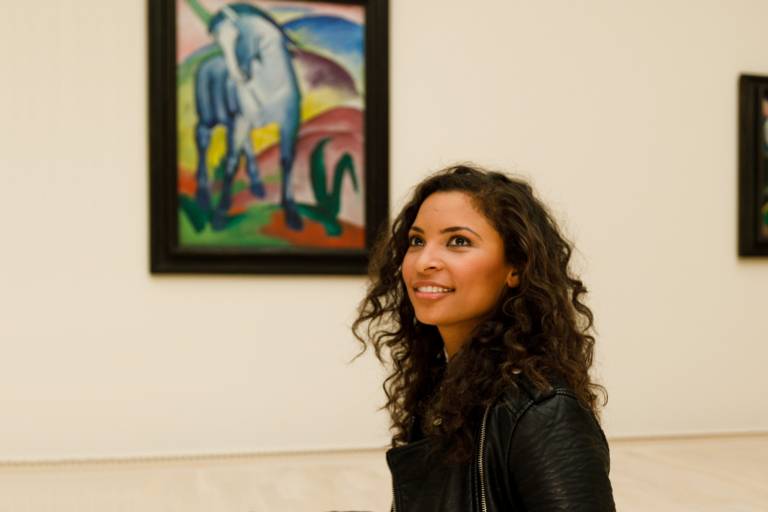
Discovery trip incl. City Pass
2 nights in your selected hotel and - thanks to the City Pass - free admission to 45 museums, sights and attractions: our travel package for explorers.

Experience Munich at first hand
Exclusive guided tours for individual guests through Munich at a glance.
- Book excursions
- Book the Munich-Card
- Book guided tours
Find your hotel now
Travel date

Munich Travel Guide
Last Updated: August 31, 2023
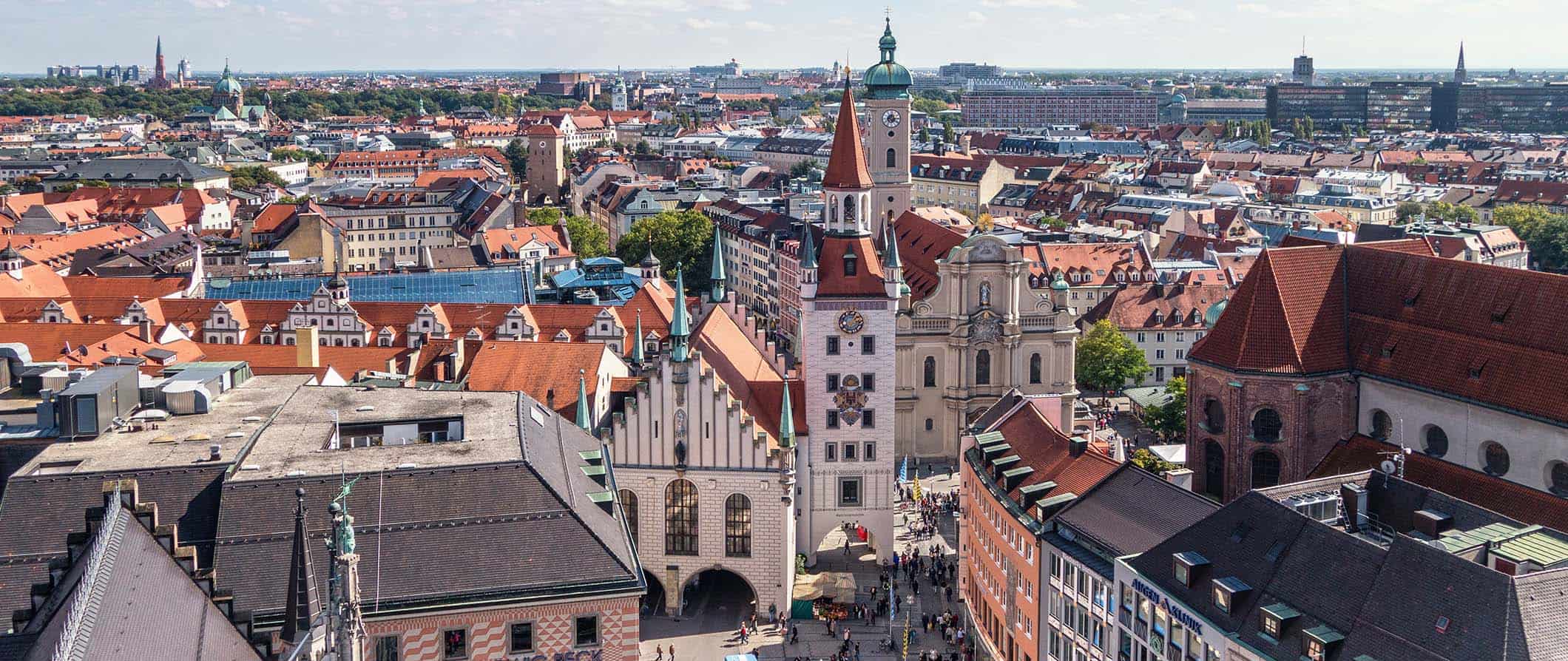
Munich, the largest city in southern Germany and the capital of Bavaria, is famous for its annual beer festival, Oktoberfest. But there’s a lot more to visiting Munich than drinking steins of beer.
The city is host to a beautiful historic city center, an old castle, large parks and gardens, hearty German food, and beer halls galore. There is also Munich’s famous clock, a detailed history museum, and the famous English Garden. In short, the city has something for everyone.
While settlements in the area date back to the Bronze Age, Munich as we know it today traces its roots back to 1158. Over the centuries, the city grew into an important cultural and economic hub. After World War I, it was here where the Nazi party took root (their first concentration camp was nearby in Dachau). The city was heavily bombed during the war, though it was completely rebuilt in the post-war era following the same grid pattern.
Today, Munich is a place of beauty, art, and history. I love traveling there. The city has a lot to offer travelers and is also an incredible base for visiting other places in Bavaria. It may lack the youthful edge of Berlin but, to me, that’s a benefit!
This travel guide to Munich can help you plan your trip, get off the beaten path, and help you make the most of your visit!
Table of Contents
- Things to See and Do
- Typical Costs
- Suggested Budget
- Money-Saving Tips
- Where to Stay
- How to Get Around
- How to Stay Safe
- Best Places to Book Your Trip
- Related Blogs on Munich
Top 5 Things to See and Do in Munich
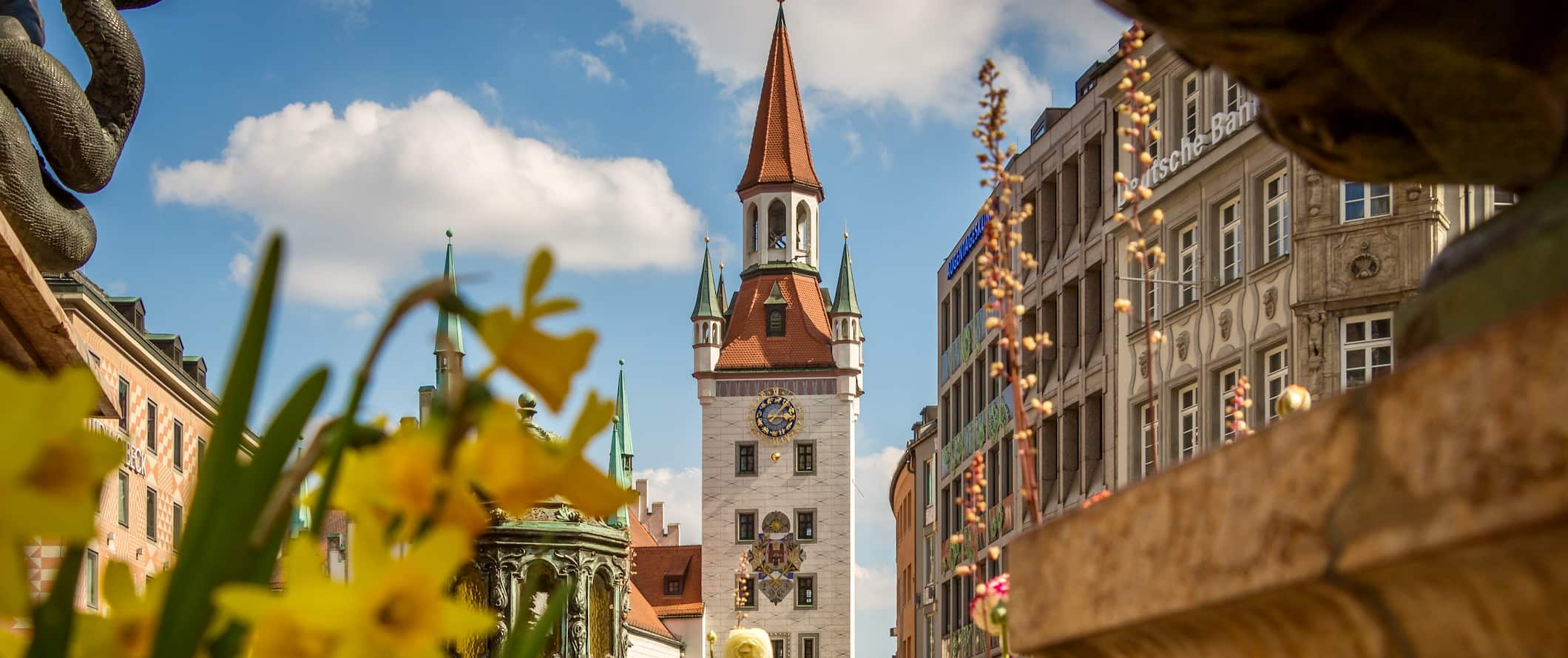
1. See Alte Pinakothek
This important art museum is home to over 800 works from 14th-18th century German masters. It features one of the world’s largest exhibits of Rubens’ paintings as well as works by Titian, Frans Hals, Altdorfer, Albrecht Dürer, and others. Admission is 7 EUR (1 EUR on Sundays).
2. Stroll the English Garden
With nearly 80 kilometers (50 miles) of trails, the English Garden is a massive park that offers numerous places to picnic, hike, and relax. Near the entrance is a river where people can “surf” as the water flows out under the bridge. There’s also a great beer garden in the center too with a Chinese tower (a wooden building resembling a pagoda).
3. Experience Oktoberfest
Oktoberfest is a two-week-long drinking festival that occurs at the end of September. Every year, an estimated 6 million people descend on the city to spend the time dressed in Bavarian clothes, drink huge liter-sized beers called Maß, and eat roasted chicken and massive pretzels. It’s a huge, huge party. Here’s an example .
4. Tour the Dachau Concentration Camp
Dachau was the site of Germany’s first Nazi concentration camp, opening in 1933. You can come and bear witness to this tragic episode in human history. There are over 30,000 documented deaths in the camp, though the number is likely much, much higher. It is a very sad place to visit but one that everyone should see. It’s located 16 kilometers (10 miles) outside the city and takes a full day to see. Entry is free.
5. Visit the Nymphenburg Palace
This Baroque palace was the summer residence of Bavaria’s royalty. It features a lavishly decorated interior, a breathtaking banquet hall, and is surrounded by extensive gardens. Two of its most famous features include the “Gallery of Beauties” and the former bedroom of King Ludwig II (1845-1886). It’s a nice place to wander around enormous gardens and the locals often picnic here.
Other Things to See and Do in Munich
1. visit the church of st peter.
Munich’s oldest parish church features art dating back six centuries, including ceiling frescoes and a giant gilded altar. You can also climb the 299 steps for lovely views of the city from the tower. On a clear day, you can see all the way to the Alps. Admission is 5 EUR.
2. Tour the BMW Museum & BMW Welt Munich
The BMW Museum is housed next to BMW’s head office in northern Munich. The company was founded in 1916 and the museum features exhibits about the history of BMW cars and motorcycles, with historic vehicles and prototypes, plus displays on alternative fuel and traffic management. It’s a bit out of the city but if you’re a car lover, I highly recommend a visit. Admission is 10 EUR.
3. Hang out at the Hofbräuhaus
The world’s most famous beer hall is one of Munich’s top attractions and a visit here is a must if you love beer. The Hofbräuhaus was built in 1607 and was originally used as a brewery, with the restaurant portion opening in 1828. Beer was produced here until 1896, at which point, the brewery outgrew its original home and beer production moved to a new, bigger site in the suburbs. While much of the beer hall was damaged or destroyed during World War II, reconstruction in 1958 restored the building in its original style. More than 100 active groups of regulars visit Hofbräuhaus, and the oldest regulars have held their table for 70 years. It’s the most popular beer hall during Octoberfest too and regularly hosts year-round events and live music.
4. Shop at the Viktualienmarkt
This food market in the middle of the city has been operating for over 200 years. With over 100 vendors, this popular local shopping spot is a great choice of fresh fruit and vegetables, cheese, and antipasti. It’s not very expensive either so stock up here if you are cooking for yourself. The market is open Monday-Saturday from 8am-8pm, though some stalls close earlier than the official closing time. Some stands are also closed on Mondays.
5. Visit the Deutsches Museum
One of the largest technical museums in the world, this museum is host to a huge array of exhibits focused on science and technology. For anyone interested in construction, engineering, aerospace, and the natural sciences, this is a great attraction. There are sailing ships, windmills, space probes, robots, lifeboats, submarines, interactive exhibits, and more! It’s a great place to visit if you’re traveling with kids. Admission is 15 EUR.
6. Partake in Maibaumaufstellung
The first of May is a public holiday in Germany, and every year, maypoles are erected all over the country amidst many festivities. May Day is especially important in Bavaria, with many traditions particular to the region. Small villages go head-to-head, attempting to steal the maypole of rival villages. If one is stolen, it must be “purchased” back with beer and food. Another Bavarian tradition involves a competition in which climbers try to scramble up a Maypole that’s been slicked down with soap. Whoever reaches the top gets the prize of pretzels and sausages hanging there. As the capital of Bavaria, Munich always has an interesting array of activities on this day, including plenty of music and dancing. A giant maypole depicting Munich’s traditions and culture is erected in Viktualienmarkt each year as well.
7. Shop at Kaufingerstrasse
This pedestrian-exclusive shopping area stretches for several blocks between Marienplatz and Karlsplatz. There is a mix of independent boutiques and large-scale department stores to peruse, as well as a slew of restaurants, bars, cafes, and beer gardens to enjoy. Wander down the side alleys for some interesting specialty shops and great people-watching.
8. Bayerische Staatsoper
This is one of the best opera companies in the world and as such, is considered one of the top attractions not just in Munich but all of Bavaria. The company was formed in the 1650s and performs today in the Neoclassical Munich National Theatre. The pieces put on here are primarily composed by Mozart, Wagner, and Strauss. Prices vary depending on the show, dates, and seats, with tickets ranging from 10-200 EUR.
If you want to save money and you don’t mind being less comfortable, you can purchase standing tickets in the upper levels for a hugely discounted price. There are often breaks so if you’d like to get the opera experience without blowing your budget try this option. Be sure to dress up as you’ll see everyone in Munich has put on their best clothes for the opera house.
9. Attend a “Blade Night”
Since 1999, every Monday from May to September is “Blade Night Munich,” which is basically code for a giant street party on rollerblades/roller skates. While these nights started informally, now they’re highly organized events with thousands of participants at each one. Over the course of 1.5-2 hours, the massive group skates together along various pre-determined routes ranging from 12-24 kilometers (7.5-14 miles). There are even “bladeguards” who help any skaters that need assistance. The routes vary each time to keep things interesting too. You can usually rent skate and protective gear for a few euros.
10. Visit Munich Residenz
From 1508 to 1918, the Munich Residenz was the seat of government and residence of the Bavarian dukes, electors, and kings. What started out as a 14th-century castle for the Wittelsbach monarchs has since been converted into a museum. The complex, like much of Munich, was significantly damaged in World War II but was restored in the 1980s. It is the largest city palace in Germany, with ten courtyards and 130 rooms, all offering something different to see. You can visit the opulent royal apartments, serene court chapel and gardens, grand halls, and gilded staterooms, as well as see the art collections from the Renaissance, Baroque, Rococo, and Neoclassic periods. Make sure you see the Italian Renaissance Grotto Courtyard and the Baroque Ancestral Gallery. Tickets for the Residence Museum and Treasury are 9 EUR each.
11. See the Glockenspiel
Munich’s town hall (the Neues Rathaus) in Marienplatz was completed in 1874 and is now the focal point of the city. Its main attraction is the Glockenspiel (a clock), which chimes each day at 11am, 12pm, and 5pm. 32 life-sized figurines tell 16th-century stories about Munich’s history, twirling around in a fun show each time the clock chimes (like a giant cuckoo clock). Shows last around 12-15 minutes depending on the story. The clock contains 43 bells and is solar-powered.
12. See the Asam Church
The Asam Church, built between 1733-1746, is named for its 18th-century designers, the Asam brothers (one was a sculptor and the other a painter). Its Late Baroque interior is extravagant and considered to be one of the best examples of this period. The stuccowork along the church’s naive as well as the colorful frescoes make for some fantastic photography. The church is quite small but the brothers made use of every inch of the interior, covering the confined space in allegorical statues and paintings. The exterior is magnificent as well, with a huge wooden door, multi-story windows, intricately carved reliefs, and golden, star-shaped ornaments. The brothers originally intended to keep the church for their own personal use, but heavy pushback forced them to open it to the public and it was inaugurated in 1746. Admission is free.
13. Bavarian National Museum
The Bavarian National Museum is one of the largest art museums in Germany and one of the most important decorative arts museums in all of Europe. Inaugurated by King Maximilian II in 1855, much of the collection comes from the Wittelsbach family, who ruled Bavaria for centuries. The 40+ rooms showcase items dating from Late Antiquity through the Art Nouveau period, including weapons, armor, porcelain, oil paintings, musical instruments, and more. Their Bollert Collection has an impressive collection of Late Gothic and Renaissance sculpture and the folklore department on the lowest floor hosts a collection of Alpine nativity scenes from the 18th-20th centuries. Admission is 7 EUR and 10 EUR for special exhibitions.
14. Take a Bavarian food tour
Munich Walk Tours offers several specialized tours of the city, with their Bavarian Food and Market Tour being the most delicious. Over the course of 2.5 hours, guides lead you through the historic district, making seven stops to sample and share the history behind Bavarian delicacies. The food you’ll get depends on the season but might include homemade sausages, cheese, pastries, fresh bread with spreads, and pretzels. Tickets are 35 EUR and include the food.
15. Day trip to Neuschwanstein Castle
This 19th-century Neo-Romantic palace is a must on any Germany travel itinerary. It was the model for the Disney castle and is one of the most popular tourist attractions in Europe, with over 1.5 million visitors each year. Perched on a rugged hill in Bavaria near the town of Füssen, the palace was commissioned by “crazy” Ludwig II of Bavaria as a retreat and homage to Richard Wagner. Visitors can walk around outside and admire the stunning exterior for free, but the interior is only accessible by guided tour at specific times, which must be booked in advance. While the palace is 6,000 square meters (65,000 square feet) in size, only 14 of those rooms were ever finished. Interestingly, the majestic rooms were fitted with very modern technology for the time, including central heating, hot and cold running water, automatic flush toilets, and telephones. Admission is 17.50 EUR.
16. Day trip to Zugspitze
Many people don’t realize that just outside of Munich, Bavaria offers stunning mountains and glacial lakes, including Germany’s highest peak, Zugspitze. You can reach this incredible 2,962-meter-tall plateau by taking public transport to Garmisch-Parkinkirchen and getting the Zugspitzbahn train. This incredible scenic journey takes you via Grainau to reach Eibsee, a stunning turquoise Alpine lake. From here the cable car takes you up to the summit for a breathtaking 360° panoramic view at the Panorama 2962 restaurant. Tickets are 63 EUR return and are only available in summer.
17. Day trip to Tegernsee
An hour’s train ride outside of Munich lies the beautiful postcard-worthy Bavarian lakeside village of Tegernsee. The traditional Bavarian homes have colorful flowers cascading from the balconies and the lake itself is surrounded by lush mountains. Anywhere you sit you will have beautiful views of the water. If you’re a beer lover, try one of the local Tegernsee beers at the Herzogliches Schloss Tegernsee brewhouse.
18. Experience the Winter or Summer Tollwood Festival
The Tollwood Festival takes place twice a year during the December Christmas market season at Theresienwiese (where Oktoberfest is held) and in the summer at Munich’s Olympiapark. Unlike Oktoberfest and other local festivals that honor Bavarian tradition, this modern festival is a unique artistic mix of food from all over the world, live music, handmade eclectic crafts, and activities. The Christmas Tollwood is a giant Christmas market with both outdoor places to grab a glühwein (mulled wine) and tasty snacks as well as huge tents inside where you can warm yourself and admire the changing art themes and decorations every year. The summer Tollwood (held in June/July) has live bands and activities where you can enjoy the summer sun sitting outside enjoying Bavaria’s best beer.
19. Hang out like a local by the river Isar
Munich is not known for its cheap bars, so if you want to do what the locals do, pick up some food and beers at the Reichenbachbrücke Kiosk and enjoy the view down by the Isar river. There aren’t any tables or chairs, so bring something to sit on and people-watch at one of Munich’s most popular hangouts.
20. Day trip to Regensburg
Located about 1.5 hours away from Munich, Regensburg is a UNESCO-listed medieval town that’s recently become increasingly popular as a tourist destination. Major sites include St. Peter’s Cathedral, a Gothic cathedral with a treasury featuring relics and reliquaries; the 13th-century stone bridge which was once the only way to cross the Danube in this area; and Porta Praetoria, a Roman gate dating from 179 CE. Train tickets from Munich are 19-26 EUR one way.
For more information on other cities in Germany, check out these guides:
- Berlin Travel Guide
- Cologne Travel Guide
- Frankfurt Travel Guide
Munich Travel Costs
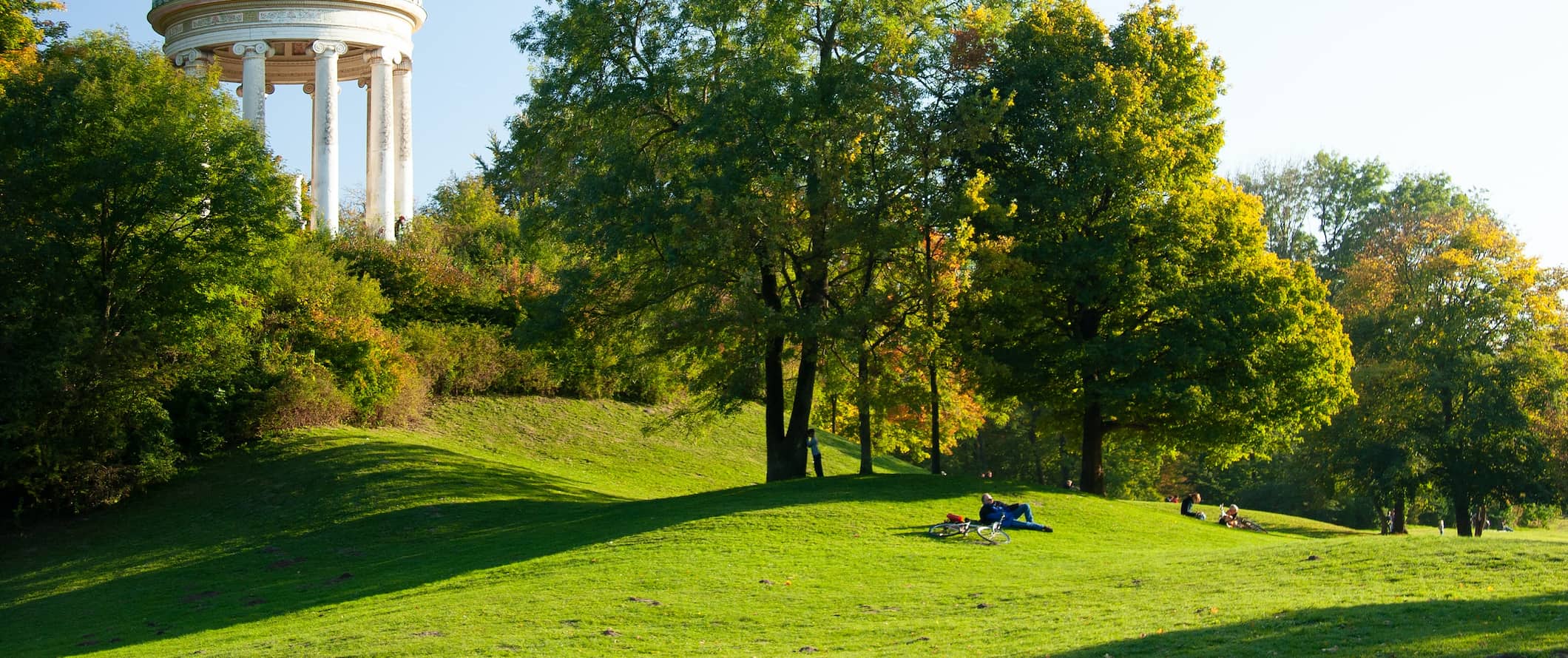
Hostel prices – A bed in a 4-6-bed dorm costs 35-43 EUR per night, while a bed in an 8-12-bed dorm costs 18-22 EUR per night. You can usually find cheaper prices during the winter. Private double rooms cost 70-100 EUR. Free Wi-Fi is standard, and a few hostels also include free breakfast. Self-catering facilities are not too common in the city’s hostels, so if you need a kitchen for your stay be sure to double-check before you book.
Be aware that prices double or triple during Oktoberfest, so book several months ahead if you’re planning on visiting during this time.
The cheapest option during Oktoberfest is The Tent, which is basically one huge communal accommodation with cots but during Oktoberfest cheapest is usually around 50 EUR a person. If you can’t find anything cheap in Munich during that time, consider staying in one of the neighboring cities that are around one hour away, such as Nuremberg, Regensburg, Garmisch, Mittenwald, or Tegernsee. The last trains back to these towns are around 11pm-12am depending on location.
(Be sure to check this before heading into town for Oktoberfest so you don’t end up hanging out at the station until the first trains start around 5am.)
For those traveling with a tent, there are a handful of campgrounds outside the city. They offer basic facilities and prices range from 5-10 EUR per night for a basic plot for two without electricity.
Budget hotel prices – Budget hotels cost around 50-75 EUR per night for a double or twin room. Wi-Fi is generally included, and in many cases, free breakfast as well. If you plan on booking a hotel for Oktoberfest, book well in advance (as in several months ahead) as hotels sell out fast.
There are a lot of Airbnb listings in Munich (though they are more expensive than in other parts of Germany), with private rooms starting at 40 EUR per night. Entire homes/apartments begin at around 85 EUR per night. Prices double when not booked in advance, however, so book early no matter when you visit.
Food – Food in Germany is very cheap (and hearty). Meat is a staple of most meals, especially sausages; there are over 1,500 different kinds of sausages in Germany (sausages here are known as “wurst”). Stews are also a popular traditional choice, as are potato dumplings and sauerkraut. Breakfast is usually composed of bread, cold cuts, cheese, and boiled eggs or Bavaria’s favorite weisswurst and soft pretzels.
Munich is not the cheapest city when it comes to food, but it doesn’t have to break the bank if you’re smart about it. There’s a good variety of street food, from snack bars to food trucks, offering hot dogs, sausages, falafel, and kebab for around 3-6 EUR. A pastry is around 1-2 EUR, which can make a good cheap grab-and-go breakfast.
McDonald’s and other fast-food places cost around 8-10 EUR for a combo meal. Local fast-casual spots offer burgers for around 6-10 EUR and sandwiches for 4-7 EUR.
International eateries, like the many Turkish, Thai, or Vietnamese restaurants, offer affordable fare, with main dishes costing 6-9 EUR.
For German sit-down restaurants, you can generally eat for under 16-18 EUR (the beer halls provide the best value). A homemade sausage dish is around 10-12 while a larger dish such as wiener schnitzel or spätzle (German noodles) is 15-17 EUR. Traditional soups are 5-7 EUR while a huge Bavarian pretzel is 3-5 EUR. I really enjoy eating at the beer hall Augustiner Bräustuben.
For drinks, a pint of beer starts at 4 EUR, a glass of wine is around 4.50 EUR, and a soft drink is 3 EUR. A cappuccino is generally around 3.40 EUR.
Many restaurants also have a “Mittagsmenü” (special prices for lunch on a working day), where you usually pay about 7-12 EUR, choosing from select dishes. This is a great deal and usually quite hearty.
For higher-end dining, a three-course menu starts at 65 EUR per person and goes up from there.
If you plan on cooking for yourself, a week’s worth of groceries including basic items like pasta, rice, seasonal produce, and some meat costs between 50-55 EUR. To save money, go to grocery store chains like Aldi, Lidl, Netto, and Penny.
Munich Suggested Budgets
On a backpacker budget, expect to pay around 65 EUR per day. This covers staying in a hostel dorm, cooking all of your meals, using public transportation to get around, limiting your drinking, and sticking to free activities like free walking tours and enjoying the parks.
For a mid-range budget of 130 EUR per day, you can stay in a private Airbnb, eat out for most meals at cheap restaurants and food stalls, enjoy a few drinks, take the occasional taxi to get around, and do more paid activities such as museum visits or a day trip.
On a “luxury” budget of 235 EUR or more per day, you can stay in a hotel, drink as much as you want, rent a car for day trips, eat out for all your meals, and do whatever tours and activities you want. This is just the ground floor for luxury though. The sky is the limit!
You can use the chart below to get some idea of how much you need to budget daily, depending on your travel style. Keep in mind these are daily averages — some days you’ll spend more, some days you’ll spend less (you might spend less every day). We just want to give you a general idea of how to make your budget. Prices are in EUR.
Munich Travel Guide: Money-Saving Tips
There are plenty of ways to save money in Munich, especially if you skip some of the fancier hotels and more luxurious meals the city has to offer. Here are my tips on saving money in Munich:
- Visit museums on cheap and free days – On Sundays, many museums in Munich offer 1 EUR admission, including the Bavarian Museum, Alte Pinakothek, Pinakothek der Moderne, Museum Brandhorst, and Sammlung Schack, among others. The Haus der Kunst offers free admissions on the first Thursday of the month and the Villa Stuck offers free admission on the first Friday evening of the month. Visit Munich’s tourism website for a full list of museum offers.
- Get a Munich City Card or Pass If you don’t want to worry about visiting museums on specific days, get a Munich City Card or Pass. Both offer free unlimited rides on all forms of public transport, while the Card offers discounts on museums and the Pass offers free admission to all the main attractions. The Card starts at 13.90 for a 1-day pass, while the Pass is 47.90 for a 1-day pass.
- Eat cheap – The quick sausage stands and shawarma places offer a chance to eat for only 3-5 EUR. Food near the central train station is also inexpensive and quick.
- See a cheap movie – On Tuesday, it’s “Cinema-Day” and movie tickets are cheaper (the big cinema at Stachus only is only 7-10 EUR). Munich Opera and ballet tickets for people under 30 years old are only 10 EUR with proof of ID and go on sale at the end of each month for the next month if you can plan ahead.
- Cook your own meals – Eating at restaurants for every meal can really destroy your budget very quickly in Munich. Try and cook some of your meals to save yourself some cash. It’s not fancy, but it’s affordable!
- Avoid bars and beer gardens Beer gardens are fun but expensive. To save money, buy your drinks at the supermarkets and kiosks in Munich and sit outside if the weather is nice. Sit outside like the locals do and have a picnic. Head to English Garden, Isar River by Isartor, Frauenhoferstrasse, and Thalkirchen (by the Zoo).
- Embrace free walking tours – Free walking tours are a great way to explore the city on a budget while learning about its history and culture. Sandeman’s New Europe Munich tour is a good one to start with. Best of all, they are free! Just be sure to tip your guide at the end.
- Stay with a local – The best way to save money on accommodation is to stay with a local via Couchsurfing. Not only will you save a few bucks but you’ll get insider access to the city itself. This is the best way to discover all the hidden gems Munich has to offer!
- Bring a water bottle – The tap water here is safe to drink as it comes from the foothills of the Bavarian Alps, so bring a reusable water bottle to save money and reduce your plastic use. LifeStraw is my go-to brand as their bottles have built-in filters to ensure your water is always clean and safe.
Where to Stay in Munich
Munich has plenty of fun and affordable hostels. Here are my suggested places to stay:
- Euro Youth Hostel
- Jaeger’s Munich
- The 4You Hostel Munich
How to Get Around Munich
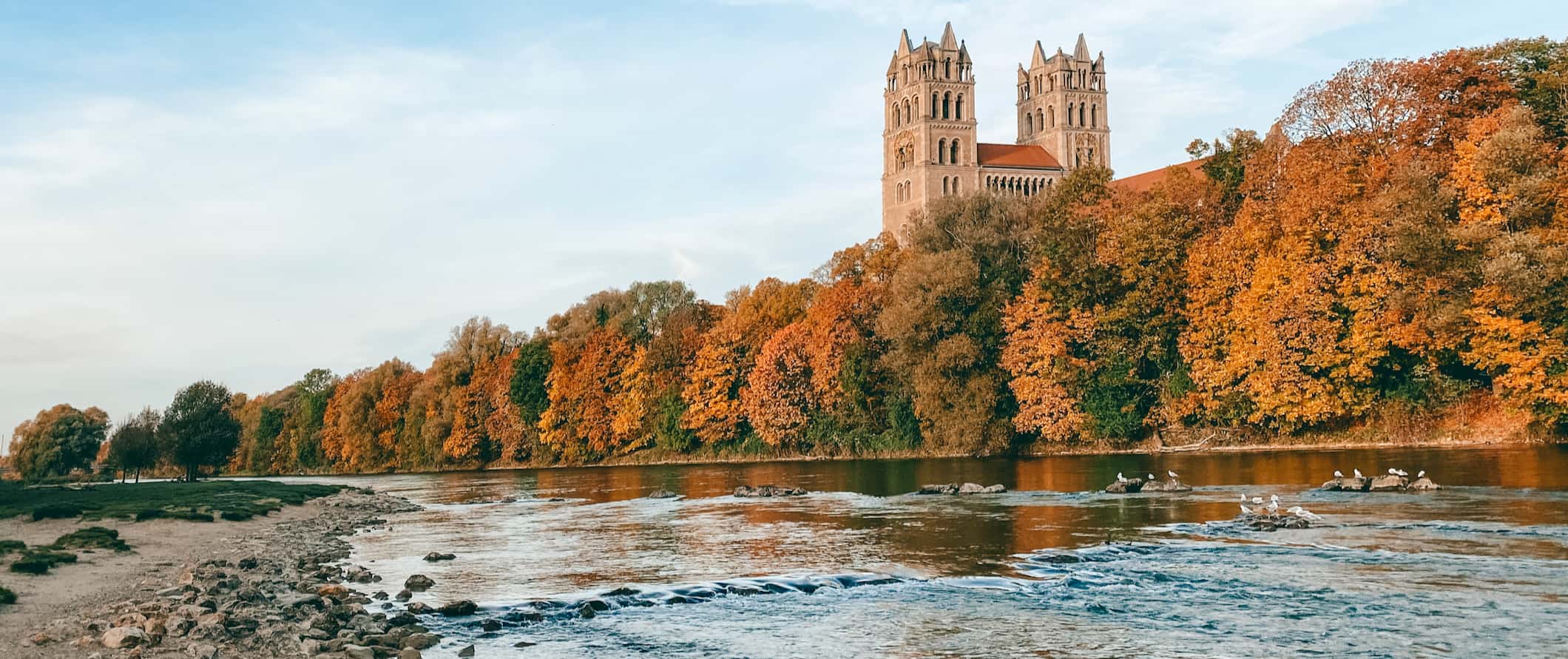
Public transportation – Public transportation in Munich is fast, reliable, and safe. One ticket can be used on all the public transportation options: the U-Bahn (underground), S-Bahn (above ground, also goes outside of the city), tram, and buses.
A one-way fare is 3.70 EUR, while a short-trip ticket (valid for 1 hour) is 1.90 EUR. A one-day unlimited pass is 8.80 EUR, which is by far the best deal. You can also get a week-long pass for 18.60 EUR. If you’re in town for 3-4 days, this deal is cheaper than buying day passes.
If you have to switch from the tram to the subway in one journey, you can do so with a single ticket. Just keep in mind that the fare increases the more zones you travel through.
Bicycle – Munich is incredibly bike-friendly. In fact, it’s considered the cycling capital of Germany. You can rent bicycles starting around 16 EUR per day.
If you want more than just a rental, check out Fat Tire Tours . They offer insightful and fun bike tours all around the city. They’re perfect if you want to see a lot of sights and chat with an expert local guide.
Taxi – Taxis aren’t cheap in Munich, with some of the highest tariffs in Germany. The base rate is 5.50 EUR plus an additional 2.30 EUR per kilometer. I’d skip them if you can!
Ridesharing – Uber is available here, but it’s not any cheaper than taxis. In short, stick to public transportation if you’re on a budget.
Car rental – Car rentals can be found for as little as 40 EUR per day for a multi-day rental. You won’t need one to get around the city, though it would be helpful to have one if you plan on exploring Bavaria and doing some day trips. Renters need to be at least 21 years of age.
When to Go to Munich
Munich has so much happening year-round that it’s always a good time to visit. Spring is nice because flea markets are opening and there are several festivals that take place during this time (such as Wannda, an arts festival). However, the weather can sometimes be cold and rainy. Pack some layers and rain gear.
Summer tends to be the most popular time to visit. Temperatures are hot and everyone’s outdoors enjoying the sunshine. People flock to beer gardens or to the nearby lakes for some swimming. This is also the peak season when accommodation prices are much higher. During this time, temperatures are usually around 24°C (75°F) or higher.
Thanks to the famous Oktoberfest, autumn is also a very popular time to visit. From the end of September to early October, millions of people flock here from all over the world to enjoy the most epic beer-drinking festival in the world. The weather during this time is usually just as pleasant as in summer. If you’re planning on attending Oktoberfest, book your accommodations in advance. Way, way in advance. If you want to avoid the chaos, come in early September or late October.
Winter in Munich can be cold, with temperatures as low as -5°C (23°F), but Germany is known for its Christmas spirit and the markets in Munich are no exception. The weather is more unpredictable, and you should prepare for snowfall, but there are plenty of places around the city for sledding and skiing. Accommodation prices are a lot cheaper during this time.
How to Stay Safe in Munich
Munich is a safe city and violent attacks against travelers here are incredibly rare. As in any major city, theft and pickpocketing can still occur so always keep your valuables secure and out of sight (especially in busy tourist areas, at markets, and on crowded public transportation).
Solo female travelers here should generally feel safe, though the standard precautions apply (don’t leave your drink unattended at the bar, never walk home alone intoxicated, etc.)
While scams here are rare, you can read about common travel scams to avoid if you’re concerned.
If you experience an emergency, dial 112 for assistance.
The most important piece of advice I can offer is to purchase good travel insurance. Travel insurance will protect you against illness, injury, theft, and cancellations. It’s comprehensive protection in case anything goes wrong. I never go on a trip without it as I’ve had to use it many times in the past.
Munich Travel Guide: The Best Booking Resources
These are my favorite companies to use when I travel. They consistently have the best deals, offer world-class customer service and great value, and overall, are better than their competitors. They are the companies I use the most and are always the starting point in my search for travel deals.
- Skyscanner – Skyscanner is my favorite flight search engine. They search small websites and budget airlines that larger search sites tend to miss. They are hands down the number one place to start.
- Hostelworld – This is the best hostel accommodation site out there with the largest inventory, best search interface, and widest availability.
- Booking.com – The best all around booking site that constantly provides the cheapest and lowest rates. They have the widest selection of budget accommodation. In all my tests, they’ve always had the cheapest rates out of all the booking websites.
- HostelPass – This new card gives you up to 20% off hostels throughout Europe. It’s a great way to save money. They’re constantly adding new hostels too. I’ve always wanted something like this and glad it finallt exists.
- Get Your Guide – Get Your Guide is a huge online marketplace for tours and excursions. They have tons of tour options available in cities all around the world, including everything from cooking classes, walking tours, street art lessons, and more!
- The Man in Seat 61 – This website is the ultimate guide to train travel anywhere in the world. They have the most comprehensive information on routes, times, prices, and train conditions. If you are planning a long train journey or some epic train trip, consult this site.
- Rome2Rio – This website allows you to see how to get from point A to point B the best and cheapest way possible. It will give you all the bus, train, plane, or boat routes that can get you there as well as how much they cost.
- FlixBus – Flixbus has routes between 20 European countries with prices starting as low 5 EUR! Their buses include WiFi, electrical outlets, a free checked bag.
- SafetyWing – Safety Wing offers convenient and affordable plans tailored to digital nomads and long-term travelers. They have cheap monthly plans, great customer service, and an easy-to-use claims process that makes it perfect for those on the road.
- LifeStraw – My go-to company for reusable water bottles with built-in filters so you can ensure your drinking water is always clean and safe.
- Unbound Merino – They make lightweight, durable, easy-to-clean travel clothing.
- Top Travel Credit Cards – Points are the best way to cut down travel expenses. Here’s my favorite point earning credit cards so you can get free travel!
- Fat Tire Tours – For bike tours, use this company! They have fun, interactive tours led by expert local guides. You’ll get to see all the main sights without breaking the bank!
- BlaBlaCar – BlaBlaCar is a ridesharing website that lets you share rides with vetted local drivers by pitching in for gas. You simply request a seat, they approve, and off you go! It’s a cheaper and more interesting way to travel than by bus or train!
Munich Travel Guide: Related Articles
Want more info? Check out all the articles I’ve written about travel in Europe to continue planning your trip:

The 7 Best Hotels in London

10 Scotland Road Trip Tips You Need to Know Before You Go

The Perfect 7-Day Croatia Itinerary

The 6 Best Hotels in Copenhagen

The 6 Best Hotels in Florence

The 7 Best Hotels in Madrid
Get your free travel starter kit.
Enter your email and get planning cheatsheets including a step by step checklist, packing list, tips cheat sheet, and more so you can plan like a pro!

- Where To Stay
- Transportation
- Booking Resources
- Related Blogs

Ultimate Munich Itinerary You Need From 1 to 7 Days
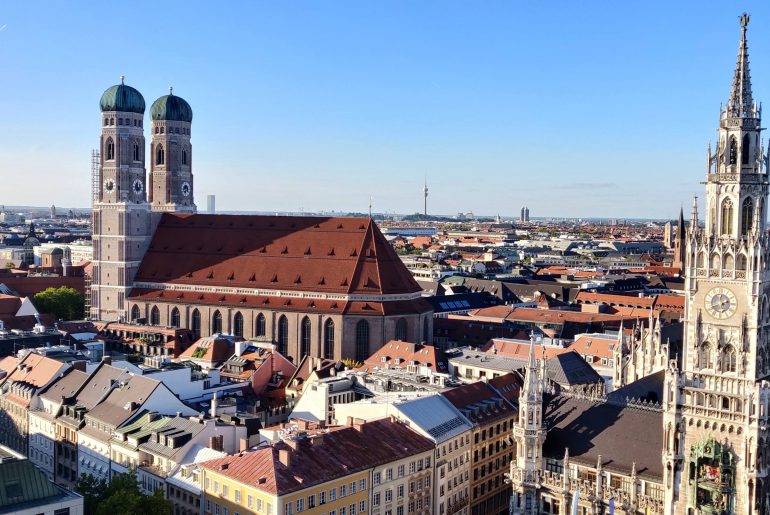
Looking for Munich Itinerary? Well, it can look easy to figure out, but it isn’t once you start getting into the details!
Because the capital of Bavaria is distinct in every sense and there are plenty of things to do and see in this gorgeous city.
Whether you want to spend 3 days in Munich or 5 days in Munich, I have you covered.
You can refer to later sections in this Munich travel blog even if you spend less than 2 days or even one day in Munich.
Let me tell you some things first before moving to the Munich itinerary. Munich is probably one of the most underrated cities in the world.
Of course, beer lovers remember this city at the time of Oktoberfest but come on; the town deserves more!
Even in Germany, the capital Berlin hogs most of the limelight as the cool, suave, and bustling hipster city, which is true, but Munich is different.
Munich is where you can find how ancient Germany is, a world completely different from today.
Munich is one of the wealthiest cities in Germany and Europe. Of course, the rich historic past blends with the modern buildings and both exist harmoniously.
But it is the history of the city that makes it unique and special. The old town of Munich has been the centre of world-changing movements from medieval to modern times.
So grab a cuppa now, and start scrolling through to read the possible itineraries, whether you want to spend a day in Munich or a week in Munich!
SUGGESTED MUNICH ITINERARY
One day in munich, quick munich 1 day itinerary.
- Munich Old Town(Munich Residenz), Viktualienmarkt, English Garden, Hofbräuhaus
What to do in Munich in one day? Believe it or not, you will cover a lot of places to visit and things to do in Munich in one day.
Starting early, you can make the most of one day in Munich by centring first around the most popular attractions in and around the historic Old town or Altstadt, followed by a walking tour of the English garden with the Chinese Tower Beer Garden.
You can join one of the free walking tours or self-guided tours. You can only join one of these historical guided tours too.
Munich Old Town
The old town in Munich was the centre stage for many world-changing historical events, and all the sights will give you insights into these events.
It is one of the top things to do in Munich. The old town has lots of points of interest for travelers, especially those that enjoy history.
If you are wondering what to see in Munich in one day, follow this Munich one day itinerary step by step and be amazed at the number of sights you will explore in 1 day in Munich!
Note: Plan in such a way as to be at Marienplatz at noon sharp(you will know why in a later section below)
Odeonsplatz
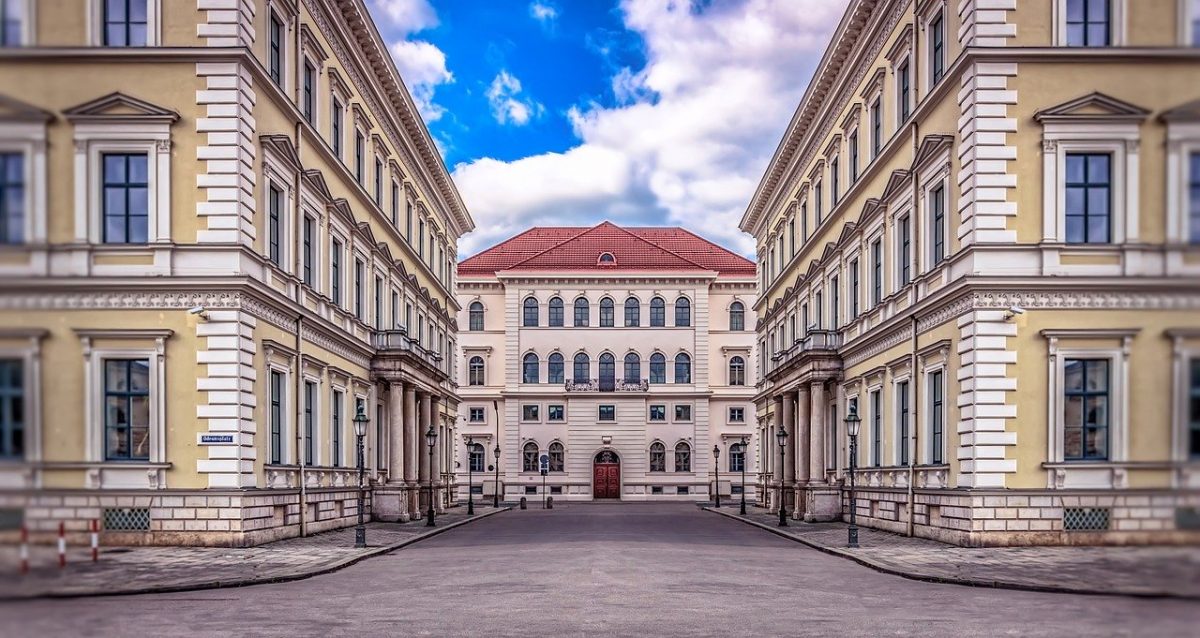
Begin the first day of your Munich itinerary at Odeonsplatz to the north of the old town, home to many medieval structures, one of the most notable ones being Theatine Church (Theatinerkirche).
This bright yellow building stands out in the square, known for its beautiful interiors. It took 16 years to build this Church, which got completed in 1676.
✅I highly recommend this Munich: Old Town & Viktualienmarkt City Walk in German (4.8/5 1000+ reviews🤩), where you discover Munich’s inner city and its highlights. See the cathedral, the Frauenkirche and the famous Staatliches Hofbräuhaus (Royal Brewery). Finally, enjoy the special atmosphere at Viktualienmarkt.
Munich Residenz Palace
Walk further from Theatine to Munich Residenz Palace, built as a retreat for the Royal family of Wittelsbachs at the end of the 14th century to defend against the rebellion.
Called also Neueste Castle, the Wittelsbachs eventually moved there in 1508 and were their administrative centre and royal residence for 400 years until 1918.
It is one of the most opulent palaces in the World. This colossal palace consists of interiors decorated with grand sculptures, murals and intricately painted ceilings.
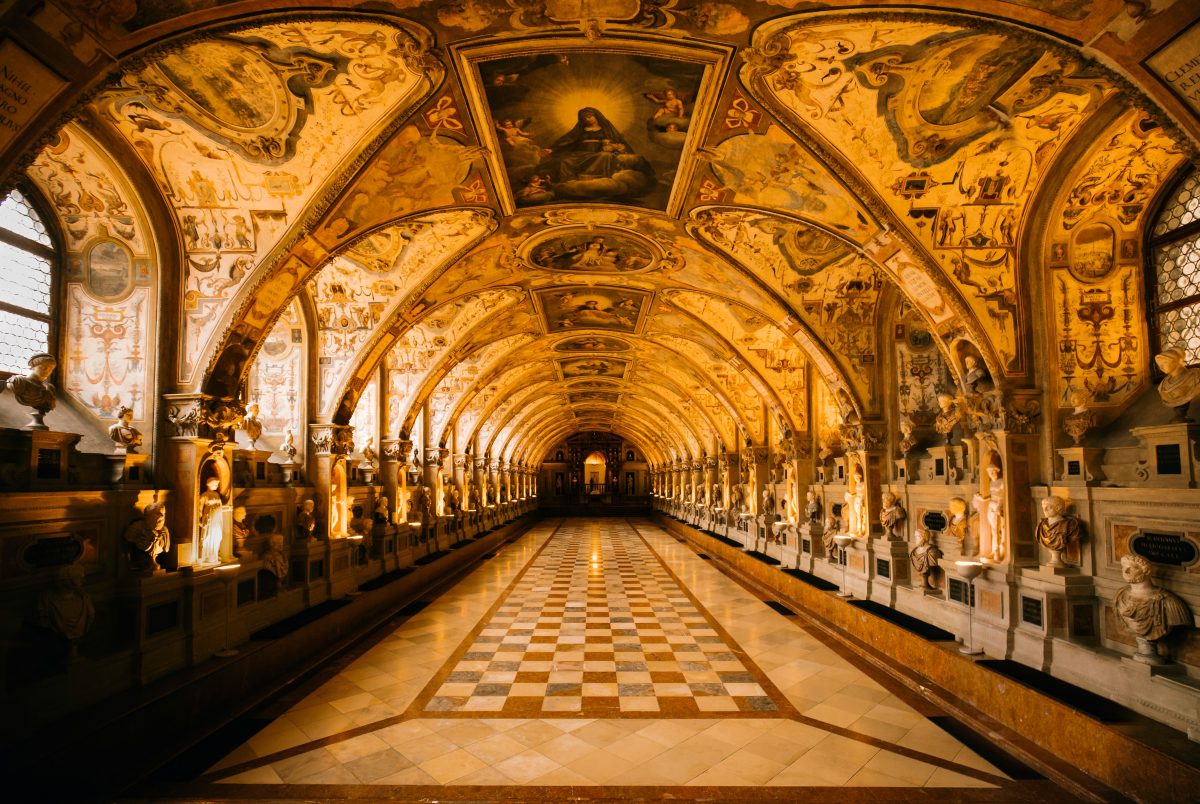
Don’t forget to stop at the most beautiful part and the popular Cuvilliés-Theater or Residence Theatre , a stunning, grand royal theatre.
The Treasury consists of over 1200 works of art, including the symbol of the Bavarian Kings and the Queens, which gives a peek into the royal life of Bavarian kingdoms.
The other essential sections worth seeing in the Castle include the Residenz Museum, which consists of stone rooms, ornate rooms, gothic cellars, medieval fountains, Medusa and Shell, Gallery of old paintings.
✅ I highly recommend this Munich Residenz Concert (4.6/5 200+ reviews 🤩 ) , where you can enjoy a classical concert in the Hofkapelle, where Mozart himself used to play, then enjoy a dinner or beer and wine tasting.
Munich Residenz entry hours: Museum – 9€, Treasury – 9€, Theatre – 5€
Opening hours – 9 AM to 5 PM. Check admission regulations & other details on their website here .
Marienplatz
Next, it is time to head to the most famous spot in Munich, Marienplatz or Market Square. Also called Schrannenplatz, the square is the oldest part of the city, dating back to the 700s.
The medieval market was the trade centre of everything from salt to meat to household appliances. It was and is the centre of the Christmas Market.
The most iconic landmark in Marienplatz is the elegant New Town Hall in the backdrop with the Virgin Mary Column in the front, because of which the square is called Mary’s Square.
The Mary column was built in the 1340s. Mary was recognized as the new patron and protector of the city averting Swedish invasion, curing Bubonic Plague and other calamities daunting Munich.
This sacred column is still the dominant figure in the town, whose medieval-style architecture is evident in the column consisting of four statutes and the intricate top portion.
✅ Join this 2.5 hours Munich City: Marienplatz and English Garden Walking Tour (5/5 1000+ reviews 🤩 ) , to siscover the cosmopolitan and charming city of Munich on this walking tour of its historic heart, and take a break in its beautiful English Garden.
New Town Hall ( Neues Rathaus)
The New Town Hall is one of the most photographed landmarks of Munich. The beautiful monument is the heart of Munich.
It has been the backdrop for many revolutionary times in Europe’s history, including being the venue for Nazi assemblies during the pre-WII times.
Constructed in 1867(took 40 years), this magnificent Gothic-style structure consists of over 400 rooms and more than six courtyards.
Its beauty is augmented by the 280-foot-tall central clock tower topped by a Child Monk statue, the Munich symbol.
The jewel of this tower is the dominating Glockenspiel, the manually operated medieval clock with over 40 bells, which has figures 28 feet high! It is one of the most stunning medieval pieces of art.
Every day, these figures re-enact numerous events in Munich’s history for about 15 minutes that occur twice a day at 11 AM and Noon and at 5 PM during the Summer.
The best way to get the most of your time is to take this guided tour of Munich New Town Hall, Munich: Guided Tour of New Town Hall
St.Peter’s Church (Alter Peterskirche )
Now it’s time to see the panoramic bird views of Munich. Walk opposite the New Town Hall, and on the left ahead, you will find St. Peter’s Church, which is older than the city of Munich itself.
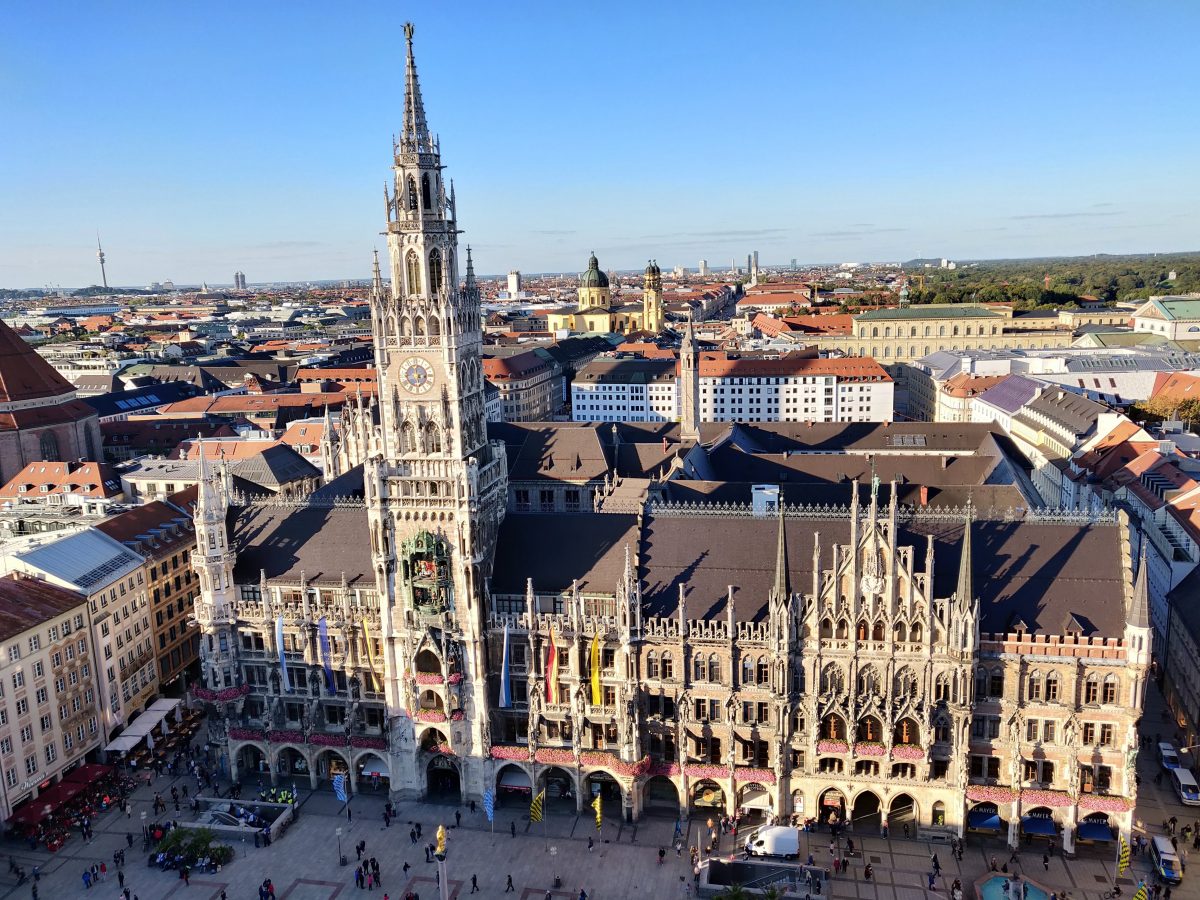
The Church was built by a group of Benedictine monks, or Mönch, in the 700s. They later founded the town München in the 1100s , which means the settlement of monks.
The original wooden Church got burnt many times, and the present was built in the 13th century, parts of which survived WWII bombings.
The gothic architecture is evident within the lovely ceiling decorated with paintings. There are over a hundred relics, including bones and skulls.
This is the best spot for travellers visiting Munich to witness the 360-degree stunning views of the old town and the modern Munich encircling it. But to be rewarded with these views, you must climb the 300+ Alter Peter tower.
✅Join this Munich: Old Town Highlights Private Walking Tour , lasting between 2 to 6 hours where you visit the top attractions in Munich’s Old Town on a private guided tour. Explore Marienplatz, Asamkirche, Frauenkirche, Theatine Church, the Residenz, and many more historic landmarks.
Opening hours – 9 AM to 6 PM; Free entry to the Church; Tower top – 3€
Old Town Hall (Altes Rathaus)
The Old Town Hall is your next stop in your walking tour around the old town of Munich. The old town hall, constructed in 1175, had watchtowers and entrance gates.
It now consists of a Dance house, a Toy Museum, medieval statues and a Watch Tower Valley Fort, among other things.
It will take 5 to 6 hours on average to cover these highlights in the old town, which may increase or decrease depending on your preferences.
There are also many stops on the street leading to Karlsplatz, but I wouldn’t recommend them if you visit Munich in a day.
Lunch at Victuals Market ( Viktualienmarkt)
All the walking would probably famish you, so it’s time to rest your legs and fill your belly. Head next to Victuals Market, which is close to Marienplatz.
Viktualienmarkt is Munich’s outdoor food market and is one of the best places in the city to try Bavarian cuisines, with over 100 stalls and lovely outdoor seating.
You have plenty of options to choose from: salads, fruits, and many pretzels. Some must-try items apart from sausages and pretzels are goulash soup and sauerkraut.
Enjoy your Bavarian stein or beer and lunch in one of the many Biergartens with outdoor seating options. There are many cafes too.
You can even book a food tour of the market if you want to dive deep with a local expert.
If you are traveling in Munich in winter, head to Ratskeller below the Old Town Hall, as many of the Biergartens remain closed now.
✅ Join this Mystic Munich: Legends of the Old Town , where you will walk through the old town of Munich, mystical creatures, hidden traces, and spectacular places. Hear about amazing legends, see mysterious places and experience the town’s history from a completely new perspective.
English Garden ( Englischer Garten)
After lunch, it is time for more beer(I am not kidding!) Okay, you can skip the beer for now if you had one too many, but next, head to the sprawling English Garden, which is one of the best places to visit in Munich.
It is not just a garden but one of the World’s largest urban public parks. It gets the name due to the informal style of the park, which is common in England.

It is the city’s first and oldest public park and one of the most popular places for locals in Munich who spend their summers picnicking.
If you visit Munich in the Summer or during the fall, you will fall in love with the colours of flowers and foliage at both times.
✅ Discover the cosmopolitan and charming city of Munich on this walking tour of its historic heart, and take a break in its beautiful English Garden. Check out more here – Munich City: Marienplatz and English Garden Walking Tour (5/5 1000+ reviews 🤩 )
To check out a few attractions, visit the Japanese teahouse, Stone bench (Steinerne Bank) and the Monopteros temple. In the Schönfeldwiese area, you can do nude sunbathing.
The pristine Kleinhesseloher Lake and the wooden pagoda – Chinese Tower are other stops worth checking.
If you want to surf, head to Eisbach River, which is not a river but an artificial stream famous for surfing in the Summer.

You can simply walk amidst the greenery and soak in the fresh breeze. You can also relax and people-watch if you don’t wish to do these.
Coming to more beer, I was talking about, close to the Chinese tower is the lovely Chinese Tower Biergarten, an excellent place to spend the evening trying some brew.
You will notice how it is crowded, which is the case almost constantly, especially in Summer and spring. Note that this garden is closed during the winter months.
Drinks & Dinner at Hofbräuhaus (Royal Beer Hall)
After a long, fulfilling day in Munich, stop at the Royal Beer Hall, more popularly known as Hofbräuhaus in the old town.
This 3-storey beer hall is the most famous Biergarten in Munich, and everything about it – decor, beer, food, music and the crowd- represents the city’s character.
This Biergarten has been around since medieval times, since 1607, to be precise. It is not yet another Biergarten; it is THE Biergarten! It can occupy up to 3500 people.
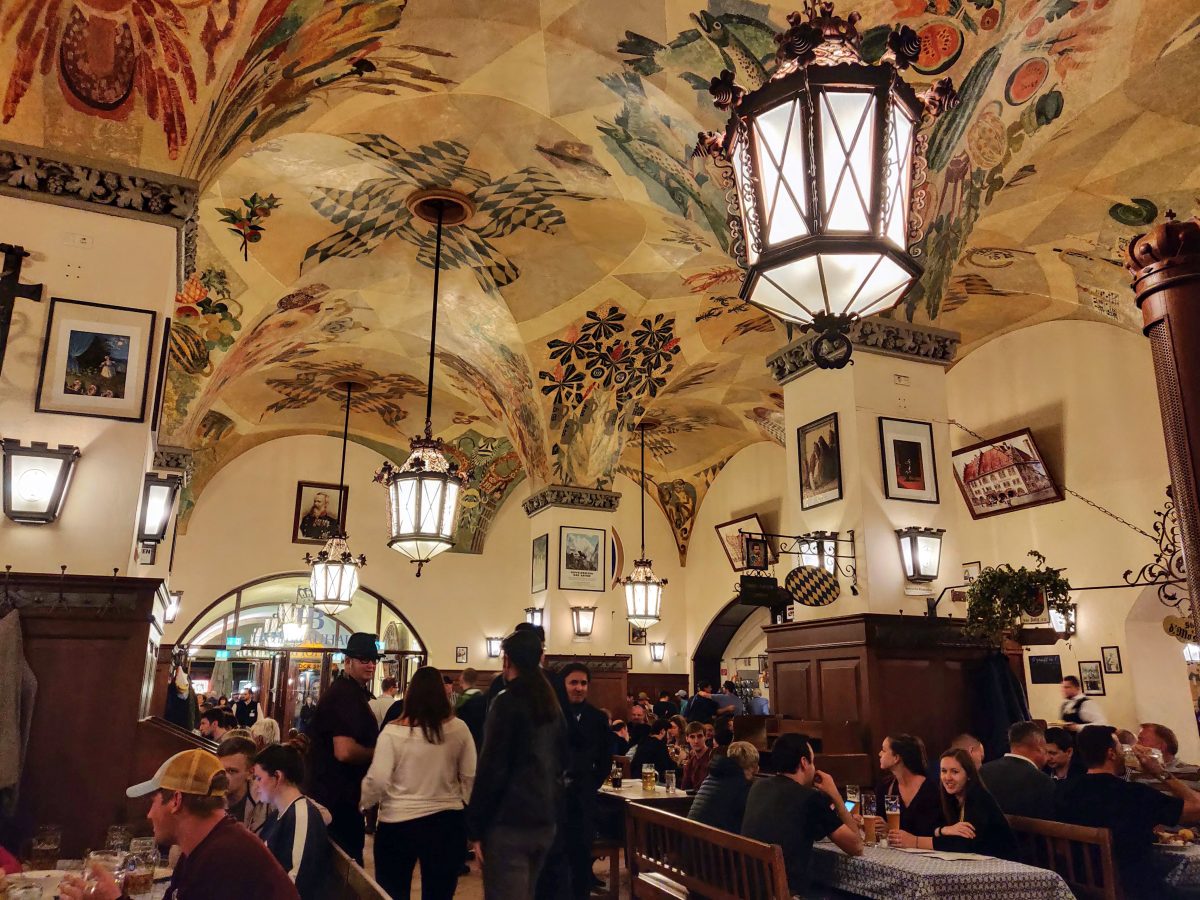
You can take a table in the open garden, at the Grand Hall on the first, the most vibrant ground floor – And yes, it is full of tourists, but that’s what makes it unique, of course, apart from 1-litre Beer glasses, excellent food, ancient music and the medieval atmosphere.
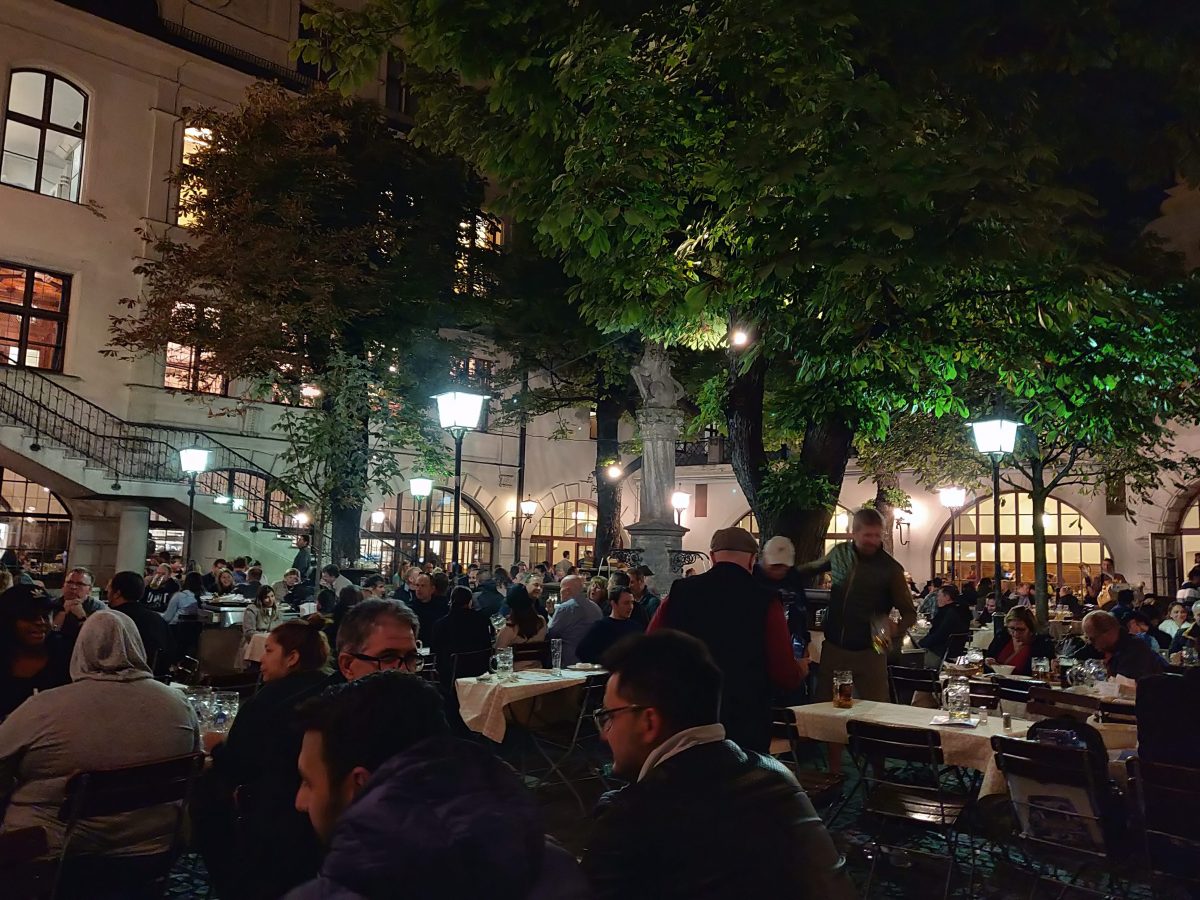
If you are in large groups, it is best to make a reservation. Otherwise, walk-in is okay. If you are a solo traveler like me, don’t be afraid to go alone.
You can share a table with people and make friends(Yes, that’s what I did).
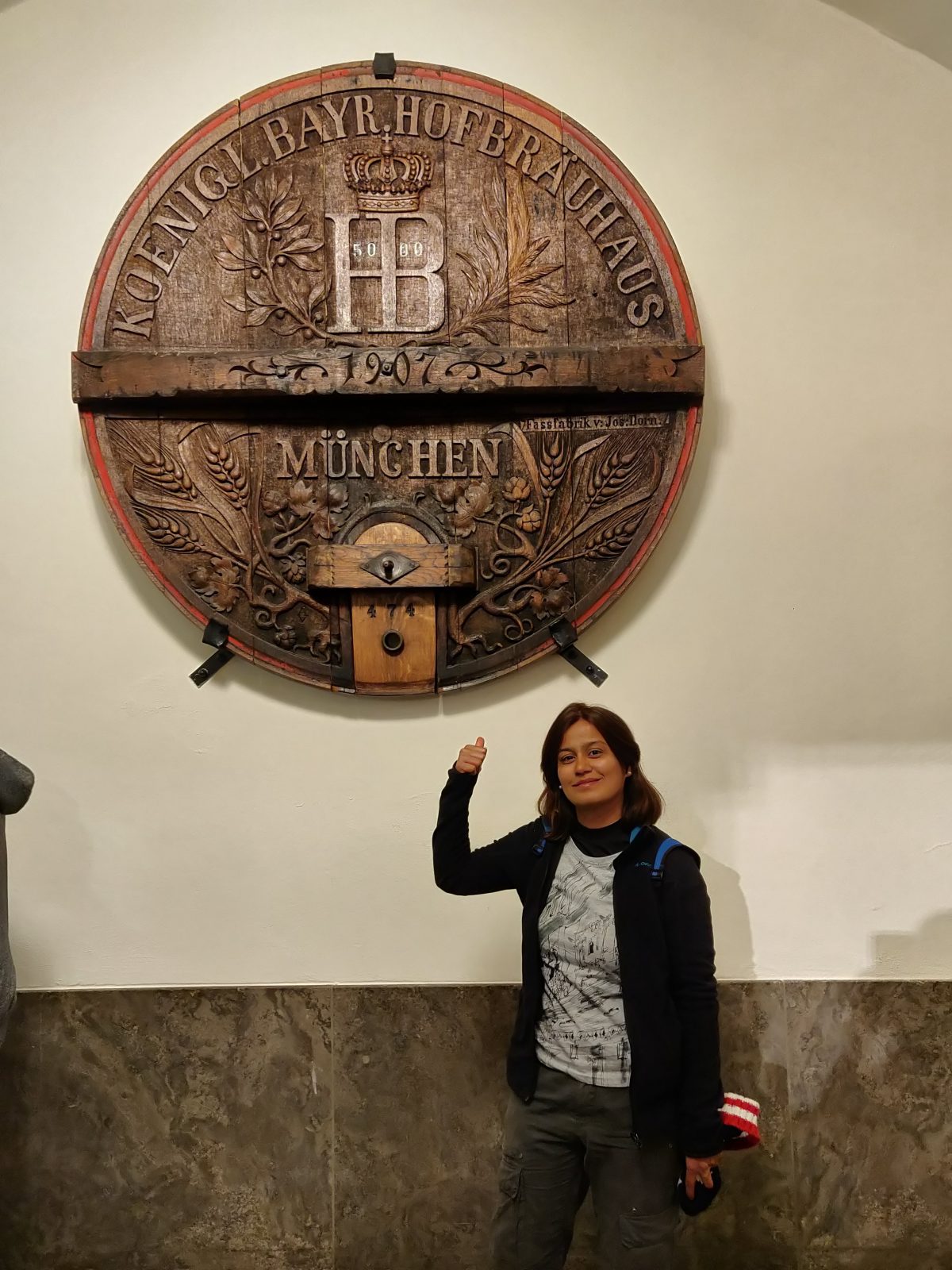
Recommended: Munich: Hofbräuhaus Tour
And it’s a wrap if you have one day in Munich. But believe me, this is an excellent Munich itinerary to do in a day – to get to know the city and relax.
If you are tempted to spend more days in Munich(Yay!), or you already have many days to afford to explore the city, keep scrolling, it gets better and better!
2 DAYS IN MUNICH ITINERARY
Munich in 2 days in a glance.
- Day 1 – Munich Old Town, Munich Residenz, English Garden, Hofbräuhaus
- Day 2 – Third Reich Tour, Nymphenburg Palace, Viktualienmarkt, Olympiapark, Augustiner Beer Garden
If you have 2 days in Munich, you will have a chance to pick a few attractions and play around.
One of the options in Munich 2 day itinerary is to go ahead with the above itinerary on your first day and top it up the next day with a day trip, preferably to Neuschwanstein Castle .
✅ If you are looking for a comfortable day trip with a local expert, this is a very popular tour that you should check(4.8/5 6000+ reviews🤩). Discover the splendid castles of Ludwig II, King of Bavaria. Visit fairytale Neuschwanstein, intimate Linderhof and scenic Hohenschwangau, before traveling through the little town of Oberammergau.
For other suggested itineraries for Munich, you can choose below, which will give you many options.
But, I’d recommend you to keep your two days in Munich restricted to explore the city itself, as there are a lot of amazing things to do and see.
DAY 1 in Munich: Munich Old Town, Munich Residenz, English Garden, Hofbräuhaus
Make the most of your first day of two days in Munich by starting the day early. Begin exploring the attractions in the old town, covering Munich Residenz and arrive at New Town Hall at noon to witness the performance.
Grab a bite at one of the many outlets in the old town and spend the afternoon in English garden surfing, walking, chilling and having a beer at Chinese tower Biergarten.
Wrap up the first day at Hofbräuhaus amidst music, beer, food and making new friends.
DAY 2: Third Reich Tour, Nymphenburg Palace, Viktualienmarkt, Olympiapark, Augustiner Keller Beer Garden
Third Reich Tour
Start your day early, and get ready to know about the events that shaped the modern history of Munich after you get a snapshot of medieval history on day 1.
Adolf Hitler was 23 years old when he came to Munich after he attempted to become an artist in his hometown Vienna failed.
It is the city where got posted as a soldier in WWI. Munich is where he rose to the ranks to become the Chancellor of Germany over a decade later after leading revolts to catapult the government.
Many know the importance of the capital Berlin and its influence on the city, but Munich is where Hitler, the leader, his SS officers, and the infamous Nazi regime were born. All the atrocities of WWII were first planned here.
Third Reich Tour will unveil these dark pasts of the city, and gory scars of WWII. It is best to join one of the guided walking tours where very knowledgeable local guides will take you back in time. The tour will last about 2 to 3 hours.
Recommended: Berlin: A Third Reich Walking Tour
Nymphenburg Palace
Nymphenburg Palace is one of the best places to visit in Munich to learn the history and life of Bavarian royalty.
It was the royal residence of Bavarian rulers of the Wittelsbachs family, whose successive kings expanded the palatial buildings to suit their preferences in their stay of 400+ years.
Nymphenburg Palace represents baroque-style architecture with hundreds of rooms and sprawling gardens, making it worth a visit.
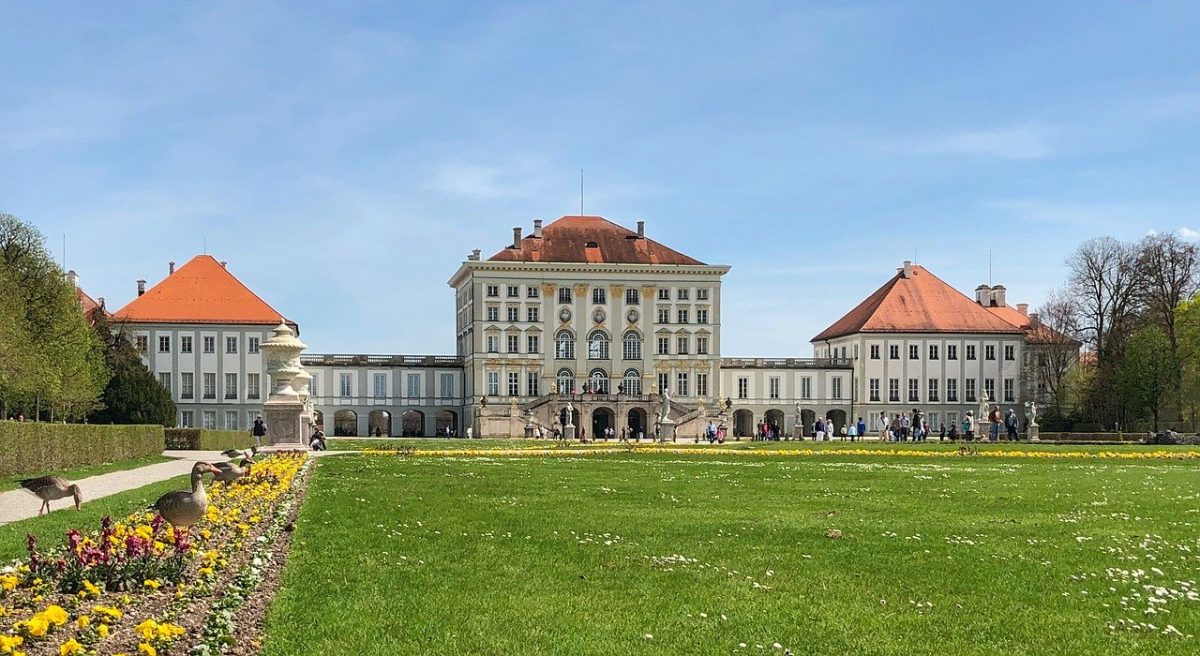
Explore the grandeur of the Stone Hall (Steinerner Saal) and scores of royal Pavillion Halls, notably the beautiful Hall of Mirrors, and other rooms depicting royal life, including where King Ludwig was born. The Carriage Museum is excellent, especially if visiting with kids.
The garden is one of the most beautiful attractions of visiting Nymphenburg Palace. It is a HUGE garden with many artificial lakes, an incredible botanical garden, ponds and Amalienburg, Brandenburg, Pagodenburg, and Magdalenenklause – four palaces too!
Recommended: Munich: Mystical Nymphenburg Palace
Opening hours: 9 AM to 6 PM; Entry fees: Full ticket(all places) 15€; Palace – 8€, Museum – 6€
How to get there – From the city centre or the old town, you can take Bus 180, which stops 500 metres close to Nymphenburg.
Next, head to Viktualienmarkt for lunch in the outdoor Biergarten.
Olympiapark

The Olympiapark, or the Olympic Park, was constructed in 1972 when Munich hosted the Olympics. It is a large park with many attractions to keep you occupied for a few hours. Visit Bird’s Nest Soccer Stadium, which has stunning architecture.
Take a walk in the Olympiazentrum tower and reach the Olympic tower top. The views of the skyline of Munich, the stadium and the park from the top are fantastic.
How to get there: The Olympiapark is located in Oberwiesenfeld, and the best way to reach it is to take the subway U-Bahn line 3, which has a direct stop at the park.
Where to head for dinner
Next, head to one of the best Beirgartens in Munich, Augustiner Keller Beer Garden, for drinks and dinner. It is one of the renowned Biergartens known for its large hall, beer and delicious Bavarian cuisines. You can also try others from their international menu, which is very good.
That’s 2 days Munich itinerary for you! If you don’t want to explore the city any further, alternatively, you can also take a day trip to Neuschwanstein Castle. See the details below.
Recommended: Munich: 4 Hour City Sightseeing Guided E-Bike Tour
3 DAYS IN MUNICH ITINERARY
A glance at munich itinerary 3 days :.
- Day 1 – Munich Old Town, Munich Residenz, Viktualienmarkt, English Garden, Hofbräuhaus
- Day 2 – Nymphenburg Palace, Bavarian National Museum, Olympiapark, Augustiner-Keller Beer Garden
- Day 3 – Day trip to Neuschwanstein Castle
If you choose to spend 3 days in Munich, it is a fabulous choice as you will get to see the city a bit leisurely. You can cover plenty of places to visit in Munich in 3 days. The best thing about a 3-day itinerary for Munich is that you can spread your old town sights and also spend a little more time in the museums.
DAY 1: Munich Old Town, Munich Residenz, Viktualienmarkt, English Garden, Hofbräuhaus
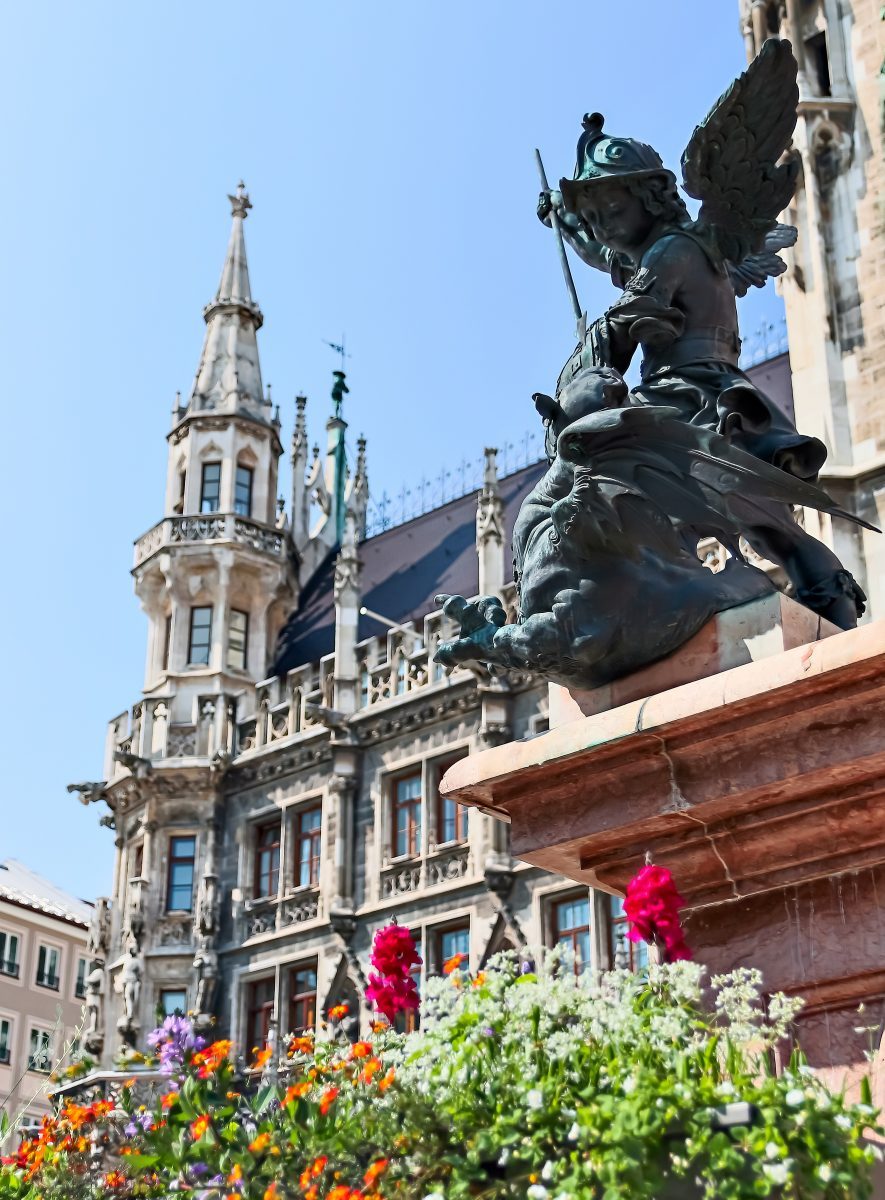
Start your Munich in 3 days itinerary spending your first day in the old town, which is the best place to begin to know about the city. Soak in the tales of the Medieval past as you pass through historical monuments, get a peek int Bavaria’s Royal life and watch the iconic clock sing for you at New town hall.
Grab a fulfilling lunch at Victual Market, stroll in the English Garden and sign off by spending a fabulous evening of beer and Bavarian food at Hofbräuhaus.
DAY 2: Nymphenburg Palace, Bavarian National Museum, Olympiapark, Augustiner-Keller Beer Garden
Start your day early and explore Nymphenburg Palace(Bus 180), the summer residence of Bavarian kings and queens.
Bavarian National Museum (Bayerische Nationalmuseum)
Get back to Munich city centre and head to Bavarian National Museum, home to extensive collections of Bavarian art, precious jewels, murals and royal possessions from 13th to 19th centuries.
Opening hours: 9 AM to 5 PM; Entry fees : 12€
How to get there: It is at a walking distance from Marienplatz.
After this Museum, grab lunch at Chinese tower Beer Garden or any quick bites at one of the local eateries.
Next, take the U-Bahn 3 and head to Olympia Park to relax, take a walk, and watch the splendid sunset views from the Olympia Tower.
Head to Augustiner-Keller Beer Garden for beer, music, food and fun!
DAY 3: Day trip to Neuschwanstein Castle
One of the best things about Munich itinerary 3 days would be a day trip to Neuschwanstein, which will undoubtedly be a fantastic experience!
Neuschwanstein Castle is one of the most beautiful fairytale castles in the World. Surrounded by immense natural beauty comprising of lakes, forests and waterfalls, it is one of the must-visit attractions if you are visiting Munich.
The Mad King Ludwig built it, and he spent most of his years alone here. A UNESCO heritage site, Neuschwanstein Castle inspired Walt Disney to make this their snow castle and is also called Disney Castle.
It takes 2 hours from Munich to Neuschwanstein by train. It is one of the most beautiful train journies where you will witness the beautiful Bavarian countryside, with glimpses of snow-capped Alps, rolling green hills, meadows and lakes.
You need a whole day to visit this Castle. Close to it is Hohenschwangau Castle, which can be combined. The best way to make this day trip to Neuschwanstein and around is to take a guided tour of Neuschwanstein Castle.
The benefits are you will save the hassle of switching between public transport, and you will get skip-the-line tickets to the interiors of the castles, which is hard to obtain otherwise given the immense popularity. Also, some tours cover another lovely fairytale castle Schloss Linderhof.
You can take private or group tours, and there are other combos and variations to these tours that you can pick based on your preferences.
Here are some of the recommended tours with excellent reviews.
- Bus tour to Neuschwanstein castle
- Private group tour
- UNESCO World Heritage site Church of the Wies + Neuschwanstein castle combination tour
- Recommended: From Munich: Neuschwanstein & Linderhof Castle Full-Day Trip
Dinner at Taxisgarten
After returning to Munich, wrap your fabulous day by having dinner and drinks at Taxisgarten, a beautiful Biergarten known for canteen-style Bavarian dining.
Alternative Munich Itinerary for 3 days – There are many things to see in Munich itself if you want to skip the day trip to Neuschwanstein.
You can visit the Third Reich Tour and Deutsche Museum, BMW world, BMW Museum, and Augustiner Schützengarten. See below for more details on these attractions and other options.
MUNICH ITINERARY FOR 4 DAYS
A quick look at munich 4 day itinerary.
- Day 1 – Munich Old Town, Munich Residenz, English Garden, Hofbräuhaus
- Day 2 – Nymphenburg Palace, Bavarian National Museum, Olympiapark, Augustiner Beer Garden
- Day 3 – Day trip to Neuschwanstein Castle, Taxis Garten
- Day 4 – Day trip to Dachau Concentration Camp, Viktualienmarkt
4 days in Munich is the perfect time to spend in the city. If you are wondering what to do in Munich for that long, well, it is not a lot of time. The pros of spending four days in Munich are that you can see Munich’s Old Town and the many attractions leisurely, without getting burnt out.
You can even afford to start a day late or choose between the plenty of day trip options in this region. Instead of two day trips on day 3 and day 4, you can spend one of these days in Munich itself (check below for options)
DAY 1: Munich Old Town, Munich Residenz, English Garden, Hofbräuhaus
Keep your first day in Munich to get used to the city, by checking out its most visited attractions, aka the Old town and around.
The second half of your first day is less taxing and more relaxing as you stroll in the garden and taste different brews in lovely Beirgartens.
Your first half of the second day in Munich itinerary will cover everything about the Bavarian empire. It gets more comfortable and relaxing post-lunch as you take the fresh breeze and beautiful views at Olypmiapark and wrap up at Augustiner-Keller Biergarten for dinner.
DAY 3 : Day trip to Neuschwanstein Castle, Taxis Garten
On your third day in Munich, plan a day trip to Neuschwanstein Castle, and spend the evening relaxing at one of the Biergartens, Taxis Garten.
DAY 4: Day trip to Dachau, Viktualienmarkt
Today, plan a day trip to Dachau. Dachau is a pretty village in the suburbs of Munich, known as the Dachau Concentration camp. It was the oldest concentration camp built under Hitler’s Nazi regime, and it is one of the saddest places that uncover the darkest sides of the Third Reich.
Initially, plenty of officers and officials strong enough to resist the party’s atrocities were imprisoned here before torturing them to death.
In the years leading to World War II, Dachau got expanded to turn into a full-fledged concentration camp, where thousands of people, mostly Jews, political prisoners, and revolts were brought to be put to suffering and eventually killed in masses in Gas chambers.
You can take a train from Munich Central Station to Dachau, which takes about 25 minutes. From there, buses are available, which stop in front of the Dachau concentration memorial site. The entrance is free, and for a minimum cost, you can get the audio guide to explore the sections on the site.
I’d recommend you take the guided tour here to understand the past and the site better. The place is huge, and you will need 5 to 6 hours to walk through the sections. There is plenty of documentation where inmates describe the routine, horrors, and processes followed in the camp. You can find the walls and rooms with imprints and scribbles of the inmates sharing their thoughts.
A lot of photographs showcase the horrendous plight of the inmates, including the cramped cells, death chambers, and crematoriums. It is one of the saddest places to be, and maybe not recommended if you have very young kids. But it is one of the places that travelers should visit to get glimpses of the horrors of wars on the lives of people.
For a convenient trip, book a guided day trip tour to Dachau from Munich, which will include transport and pick up.
After returning to Munich, shop in the streets close to Marienplatz if you have energy left. And then head to Viktualienmarkt or Victual Market for drinks and dinner.
Alternative Day 3/4 – If you want to make only one of these day trips or want more options in exploring around the city, then follow this – Start with the Third Reich Tour, then visit Deutsche Museum, lunch, BMW world, and BMW Museum.
5 – 6 DAYS IN MUNICH ITINERARY
A glance of munich itinerary 5 days/6 days.
- Day 1 – Munich Old Town, Munich Residenz, Hofbräuhaus
- Day 2 – Nymphenburg Palace, Viktualienmarkt, Olympiapark, Augustiner-Keller Beer Garden
- Day 3 – Day trip to Neuschwanstein Castle, Taxisgarten
- Day 4 – Day trip to Dachau, English Garden
- Day 5 – Day trip to Salzburg, Haxnbauer
- Day 6 – Third Reich Tour, Museum Quarter, BMW world, BMW Museum
If you have 5 days in Munich or 6 days in Munich, you will get plenty of time to cover all things to do leisurely, along with possibility of making multiple day trips or going more in-depth, away from the touristy attractions in the city,
Also, many people plan 5 to 7 days in Bavaria, and in that case, it is an excellent idea to base yourself in Munich and go on day trips around. If you opt for day trips, you can add a third one too and even stay overnight in Salzburg or Nuremberg, come back and continue your Munich vacation.
DAY 1: Munich Old Town, Munich Residenz, Hofbräuhaus
Walk around in the old town of Munich, covering the city’s top attractions. You will get an entire day to leisurely explore the old part of Munich.
Visit Munich Residenz, New and Old Town Halls, witness the bird’s view of the town from Alte Peter, and wrap up the day at Hofbräuhaus with beer and Bavarian dinner.
DAY 2: Nymphenburg Palace, Viktualienmarkt, Olympiapark, Augustiner-Keller Beer Garden
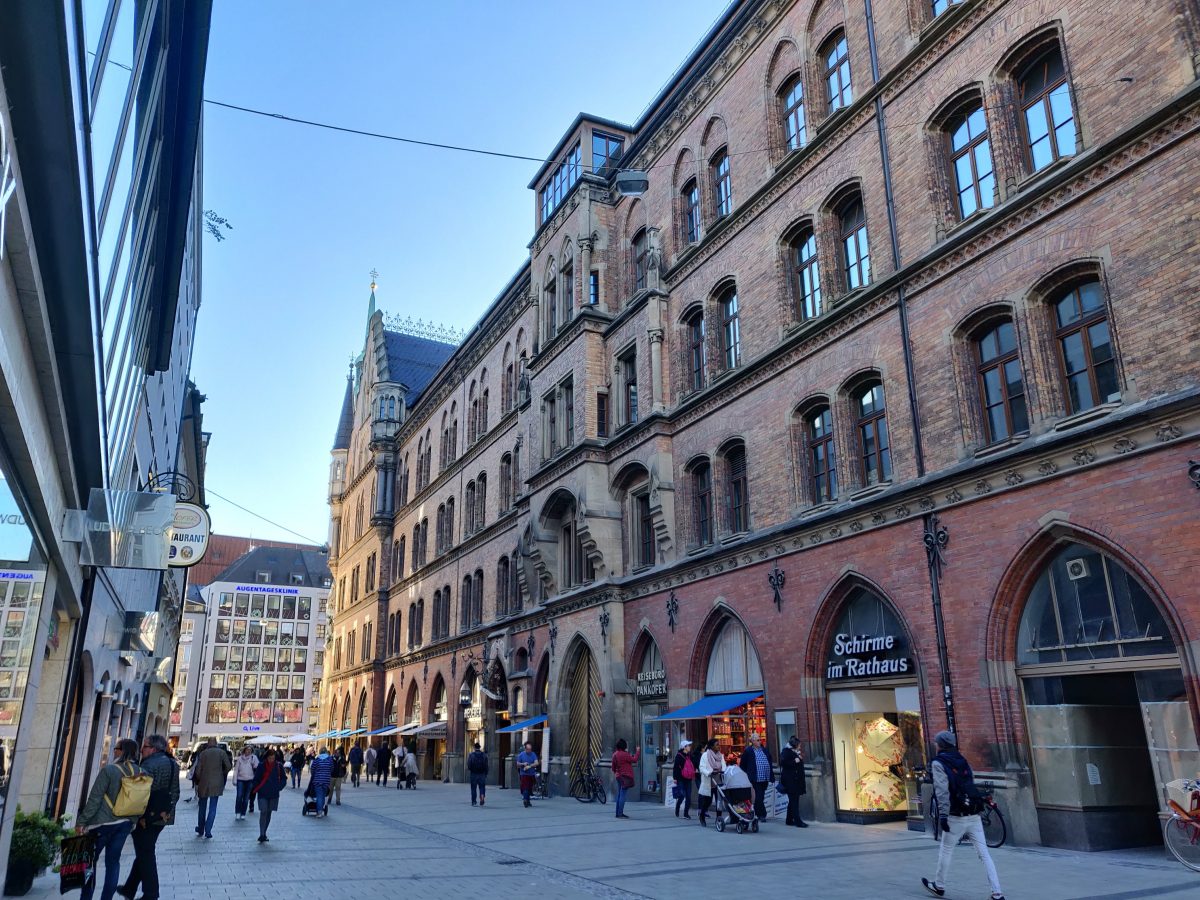
Visit Nymphenburg Palace in the morning and then head to Viktualienmarkt for lunch. Explore Olympiapark, enjoy the bird views from the Olympic Tower in the evening, and end the day by a slow dinner along with beer at Augustiner-Keller Biergarten.
DAY 3: Day trip to Neuschwanstein Castle, Taxisgarten
On your fourth day in Munich, plan a day trip to Neuschwanstein Castle, and spend the evening relaxing at one of the Biergartens, Taxisgarten. They specialize in canteen-style Bavarian dining, along with tasty beer.
DAY 4: Day trip to Dachau, English Garden
Visit the district of Dachau and check out the Dachau Concentration Camp in the first half of the day. Return to the city centre and spend the second half of the day relaxing in the English garden(You can go surfing, walk in the park or have beer and food at Chinese Tower Beer Garden).
DAY 5: Day trip to Salzburg, Haxnbauer Biergarten
Keep this day of Munich itinerary to hop to neighbouring Austria, to the lovely town of Salzburg .
Salzburg, the pretty town in neighbouring Austria, is just 2 hours away from Munich and is one of the day trips that you can plan. Salzburg needs at least 2 days or more, but you can still squeeze in the highlights of this beautiful town within a day, especially if you join one of the guided tours.
Again I’d favour guided tours over independent travel if you plan a day trip to Salzburg from Munich. One of the significant benefits is sorting transportation, lunch and skip-the-line tickets to attractions, which will save the hassle.
Recommended: From Munich: Salzburg Day Trip by Train
Dinner at Haxnbauer – If you are back early in Munich from Salzburg, you can dine at Haxnbauer Biergarten, a part of the historical building of the Scholastikahaus. This 14th-century Bee hall is one of Munich’s well-preserved ancient Beer gardens worth checking out.
DAY 6: Third Reich Tour, Museum Quarter, BMW world, BMW Museum
Start the day with the walking tour, the Third Reich tour , which will unveil the city’s dark past.
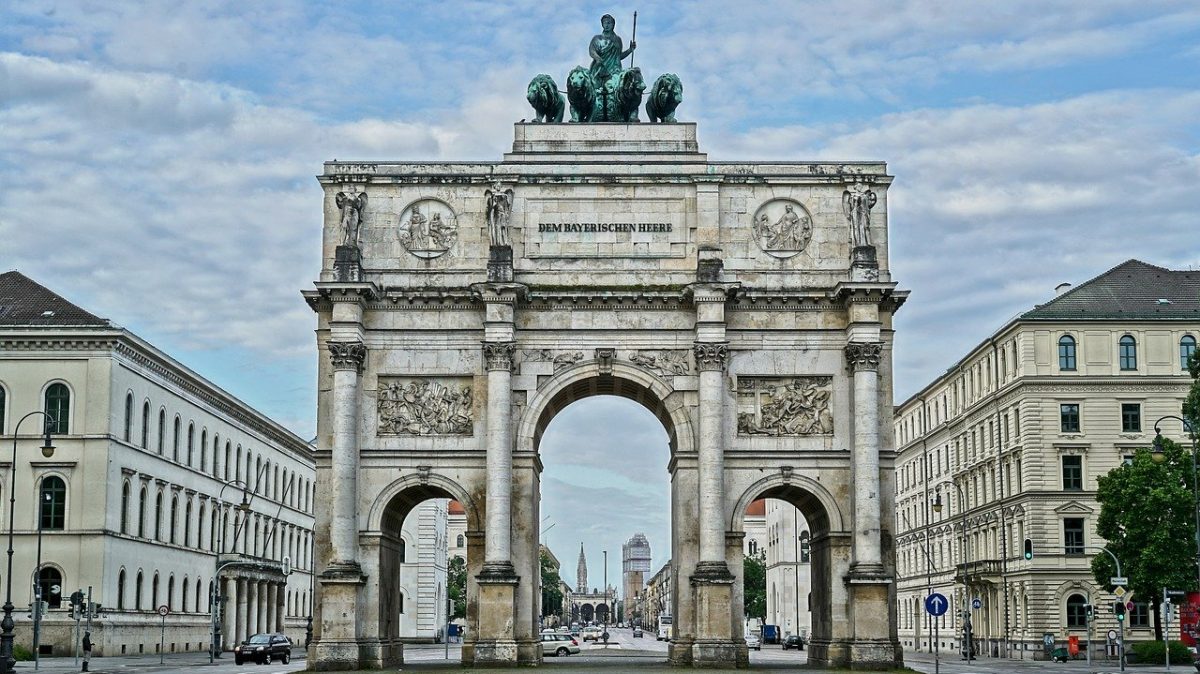
Museum Quarter
Then head to Museum Quarter in the Kunstareal district, home to over 18 Museums and 4 universities. You can’t visit all of them in less than a day, of course, but check out these two most famous museums visited by travelers. Since you have 5 to 6 days, you can add a few more to your Munich Itinerary if you love Museums.
The Alte Pinakothek – Home to hundreds of artworks of Classic artists from the medieval period(13th to 17th), Alte Pinakothek is worth visiting if you like classic art and paintings of the Renaissance times.
Opening hours: 10 AM to 6 PM; Entry fees – 7 Euro
The Neue Pinakothek – If you are a modern art lover, you will enjoy the Neue Pinakothek, which has hundreds of works by contemporary artists worldwide. Note that it has been currently closed for renovation(until the end of 2020)
How to get to Museum Quarter: You have many public transport options to reach these museums. Take Tram No 27 to Pinakotheken, or U-Bahn U2, U3 and U4. Bus no 100 museum line also stops at Pinakotheken.
BMW World & BMW Museum
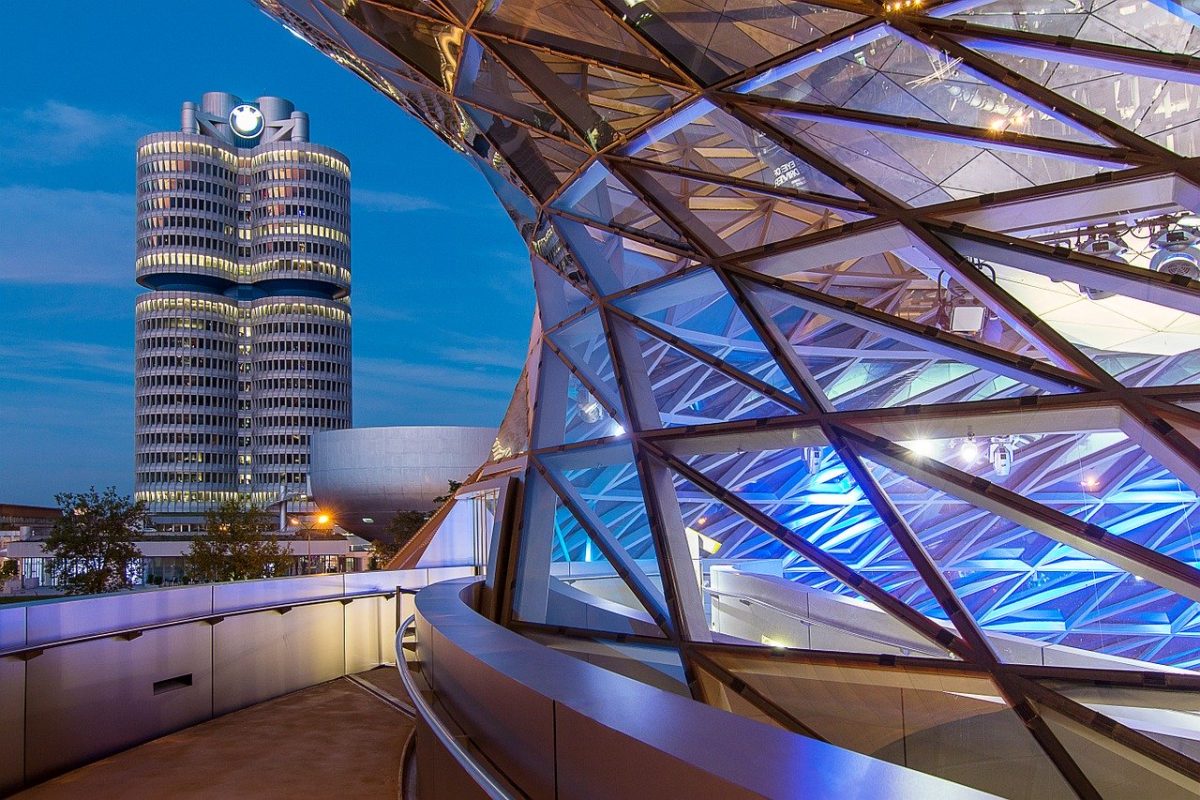
Next, after the Museum Quarter, get back to the city and grab a quick lunch near the old town.
Head next to BMW World and Museum. If you are a car lover, this will be one of the best places to visit in Munich. The Carmaker company BWM has its headquarters here in Munich, which is as swankier as the cars they produce! You can even spend a day here learning everything about making a car.

Be awed by the latest beasts on the market, which are on display. Some are brand-new(and you will see them before they are on the road). The museum has artefacts, photographs and various other documentation from the birth of these cars to the latest technology, which is very interesting.
How to get there: You can take the same route you made for Olypmiapark. It is better to combine both of these as they are close to each other.
Dinner at Löwenbräukeller Das Original – Your Munich sightseeing is not complete until you visit at least one Biergarten per day! Today, check out Löwenbräukeller, another early 19th-century, Bavarian-style garden.
You can make variations in this 6-day Munich itinerary depending on your preferences.
ONE WEEK IN MUNICH ITINERARY
Munich 7-day itinerary at a glance.
- Day 1 – Munich Old Town, Munich Residenz, Third Reich Tour, Hofbräuhaus
- Day 2 – Nymphenburg Palace, Viktualienmarkt, Museum Quarter, Augustiner-Keller Beer Garden
- Day 3 – Day trip to Neuschwanstein Castle, Taxisgarten
- Day 4 – BMW world, BMW Museum, Olympiapark, Bavarian State Opera, Augustiner Schützengarten
- Day 5 – Day trip to Salzburg
- Day 6 – Day trip to Dachau, English Garden
- Day 7 – Deutsche Museum, Bavarian National Museum, Allianz Arena, Shopping, Hirschau Biergarten
Got a week in Munich? You are awesome. You can spend 7 days in Munich city if you wish as there are so many things to do there. Of course, covering a few day trips makes sense because there are at least over twenty-day trips from Munich.
So the idea is to balance out both if you have a week. I once spent around 9.5 days in Munich, made two-day trips and spent the rest checking out attractions – There are so many museums(60+) ranging from arts to automobiles, all equally appealing.
You can spend overnight in Salzburg as the distance from Munich to Salzburg can be done under 2 hours, or if you pick Nuremberg or other cities too, you can extend the day trip by spending the night there and making your way back to continue Munich vacation.
Plus, you have so many splendid beer gardens in Munich that you can keep trying them!
The below itinerary has three day trips and around four days to explore the city, which balances both. And of course, I have added one Biergarten at night for you, wherever possible.
DAY 1: Munich Old Town, Munich Residenz, Third Reich Tour, Hofbräuhaus
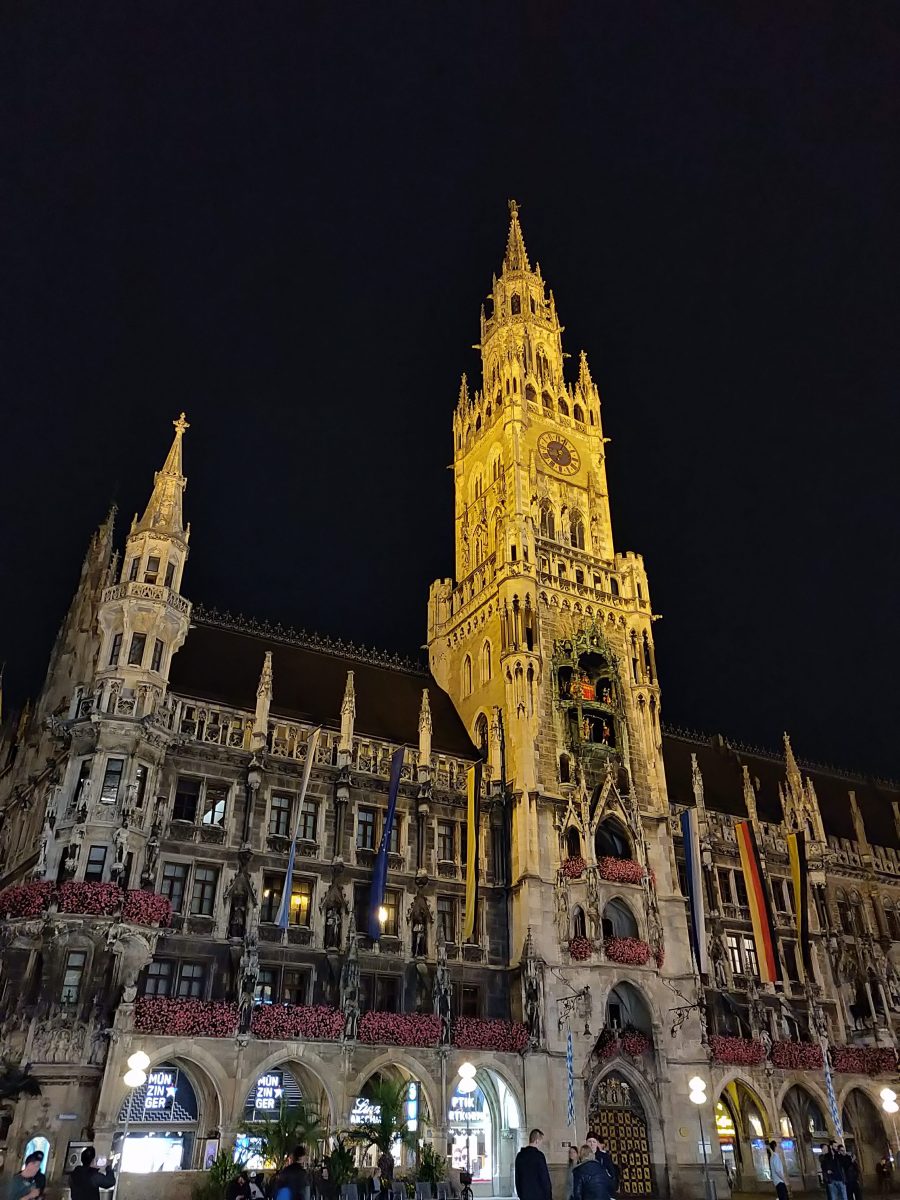
Walk around in the old town of Munich, covering the top attractions of the city. You will get an entire day to explore the ancient and modern history of Munich.
Let’s talk about the old history of Munich first. Visit Munich Residenz, New and Old Town Halls, witness the bird view of the town from Alte Peter .
Grab a quick lunch next and start the Third Reich Tour, which you can do by yourself or best with a guided tour. You will get to know the dark history of the city on this tour.
Dinner at Hofbräuhaus – Wrap up the day at the beautiful Hofbräuhaus with beer and Bavarian dinner.
DAY 2: Nymphenburg Palace, Viktualienmarkt, Museum Quarter, Augustiner-Keller Beer Garden
Starting your day early today will give you more time today for the museums to explore later. Visit Nymphenburg Palace in the morning, and then head to Viktualienmarkt for lunch.
You might want to finish your lunch quickly as you have museums to explore at the Museum Quarter next. You can plan your time depending on how many of them you intend to visit. I’d recommend the Alte Pinakothek for the classical art enthusiasts.
Dinner at Augustiner – End another fabulous day in Munich with a slow dinner plus beer at Augustiner-Keller Biergarten.
DAY 3: Day trip to Neuschwanstein Castle, Taxisgartern
It’s time to plan one of your days with one of Munich day trips today. Start with the best one by making a day trip to Neuschwanstein Castle, and spend the evening relaxing at one of the Biergartens, Taxisgarten. They specialize in canteen-style Bavarian dining, along with tasty beer.
DAY 4: Day trip to Nuremberg, Augustiner Schützengarten
You can plan another day trip to neighbouring Nuremberg, which can be reached from Munich under 2 hours by train, and end the day at Augustiner Schützengarten Biergarten.
BMW world, BMW Museum, Olympiapark, Bavarian State Opera, Augustiner Schützengarten
If you want to continue checking out Munich points of interest, there are a handful of them that you can plan today.
Start with BMW World by taking the subway, and spend time getting to know about the famous cars, their origin and other incredible things at the BMW Museum.
Next, move further to explore Olympiapark, enjoy the bird views from the Olympic Tower in the evening.
Bavarian State Opera (Bayerische Staatsoper)
Arrive at the state opera after Olympiapark. It is best if you book tickets ahead of time as it gets filled soon. Not many know, but Munich is home to one of the best Opera houses in the world. There are amazing performances(related to Bavarian culture) at night at Bavarian State Opera located in Old Munich.
You can also choose from one of the guided tours to the Opera House.
Dinner at Augustiner Schützengarten – Wrap your day with dinner and beer at Augustiner Schützengarten after a lovely Opera evening.
DAY 5: Day trip to Salzburg, Haxnbauer Biergarten
Plan a day trip to Salzburg today, enjoy the beautiful town, and if you are back early in Munich the same evening, check out Haxnbauer beer garden.
If you want to stay overnight, you can do so, because Day 6 has only two stops so you can arrive early next day and continue another day trip to Dachau.
DAY 6: Day trip to Dachau Camp, English Garden
Visit the district of Dachau and check the Dachau Concentration Camp in the first half of the day. Return to the city centre and spend the second half of the day relaxing at the English garden(You can go surfing, walk in the park or have beer and food at Chinese Tower Beer Garden).
DAY 7: Deutsche Museum, Bavarian National Museum, Allianz Arena, Hirschau Biergarten
Your last day in Munich can be planned depending on the time you have.
If you have less than one full day(if you are flying out or reaching another city the same day), then I’d recommend you visit one among Allianz arena, Deutsche Museum, or Bavarian National Museum. Keep the remaining hours for shopping or visiting one last beer garden in the city(Haxnbauer or Hirschau).
If you have a full day though, start early and check out the two famous museums in the city first.
Deutsche Museum – Deutsche Museum is the largest technological Museum in the world. If science and technology fascinate you, you will be mind-blown by the exhausting collections, artefacts and displays. You can easily spend a day here if you have time or prefer.
Opening hours: 9 AM to 5 PM
Entry fees : 14€ Musuem only. Combined ticket 21 € (Deutsches Museum + Verkehrszentrum + Flugwerft Schleissheim – no time limit)
How to get there: You can reach by tram lines 16, 17, 18 or all on Isartor S-Bahn train line stop at the Museum.

Next, check out Bavarian National Museum, to know about the rich history of the Bavarian kingdom and the lives of the queens and kings.
If you have time, check out Allianz Arena or end your day at either Haxnbauer or Hirschau Biergartens.
Recommended: Munich: City Tour & FC Bayern Munich Soccer Arena Tour
OTHER THINGS TO KNOW ABOUT VISITING MUNICH
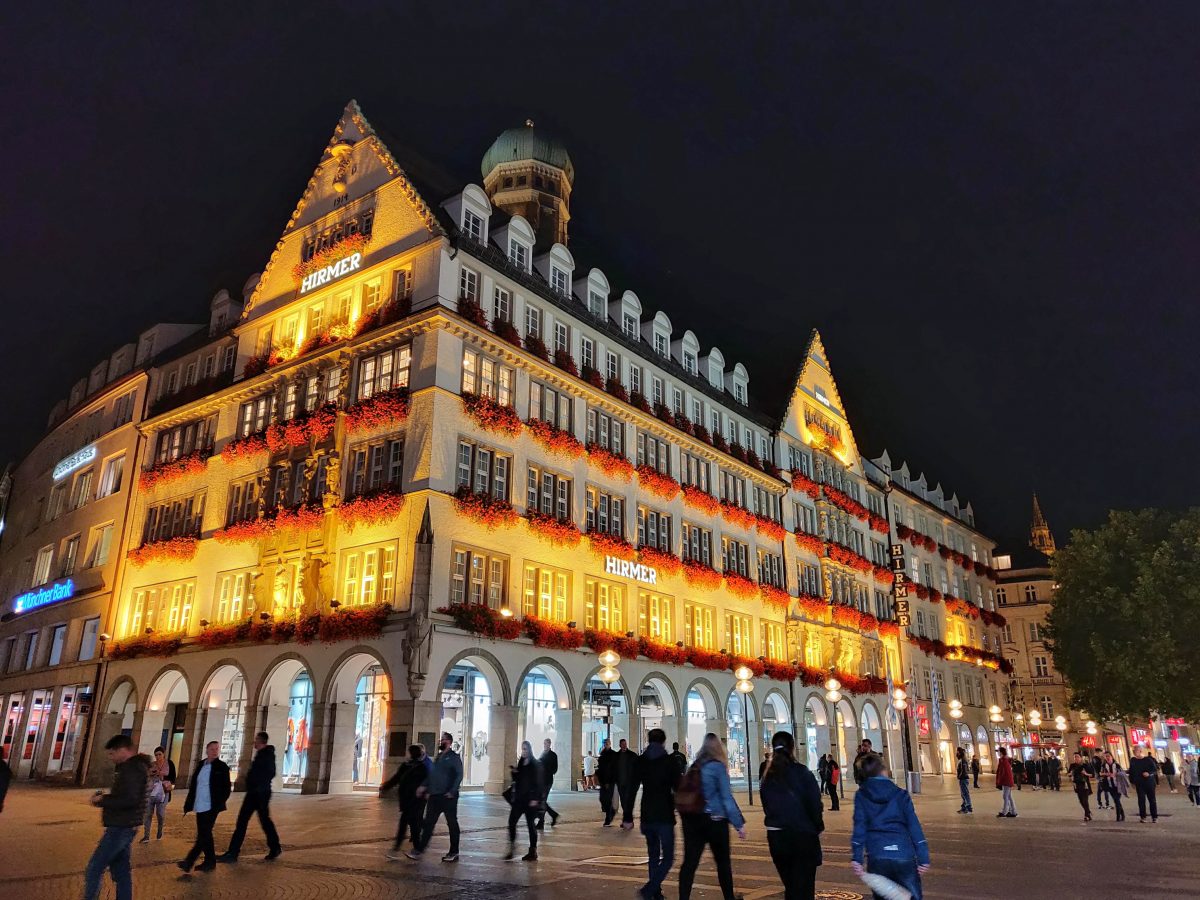
HOW MANY DAYS TO SPEND IN MUNICH?
Now that you have got complete details on Munich itineraries, you might be wondering how many days in Munich? The answer depends on your time and budget, but ideally, I’d suggest you spend at least 4 days in Munich. It will give you time to cover the highlights of the city in three days, allowing you to take up one of the day trips from Munich on the fourth day.
If you want to skip Munich day trips, it is still recommended to spend 3 days in Munich minimum. I spent ten days in Munich and always felt that I had more time as I thought that there was so much to see yet!
BEST TIME TO VISIT MUNICH
Summer months are the most popular times to visit Munich. While the upside is the pleasant weather, the downsides of visiting during summer are expensive rates of hotels, restaurants and flights, along with a lot of tourists everywhere.
The fall months are when the chilly weather sets in, and the nights get colder. It rains frequently, and I wouldn’t recommend fall if you don’t like the gloomy ambience. If you can manage the drizzles and the chill weather, you can enjoy the lovely foliage of autumn with fewer tourists and lower prices.
Winter months receive few tourists, thanks to the mind-numbing sub-zero temperatures, and occasional rains and damp weather. However, visiting Munich in winter has plenty of other advantages, one of them being the vibrant Christmas markets.
So ideally, the best time to visit Munich is during the spring or early autumn when tourists are fewer, the weather would be beginning to soften, and the prices are relatively lower.
WHERE TO STAY?
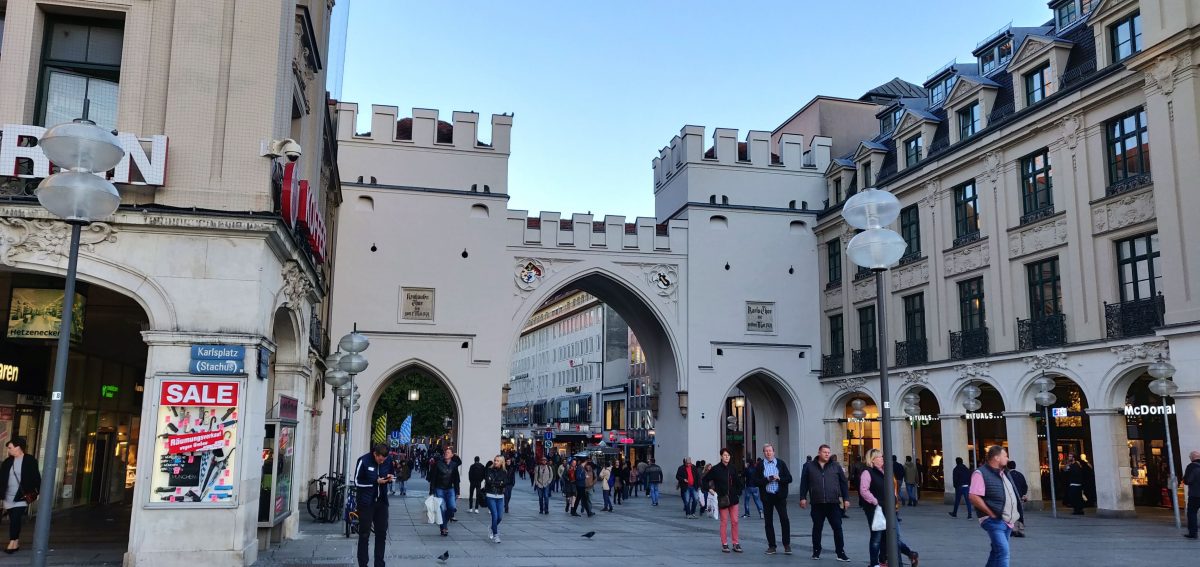
Munich is huge(It is the second-largest city in Germany), so you will have plenty of places to choose if you are wondering where to stay in Munich. The hotels in Munich are spread throughout the city. As a rule of thumb, one of the best areas would be close to the city centre, but note that the prices can be slightly high.
In general, the more the accommodation is in the centre, the higher is the price. So it depends on your budget and your convenience. If you prefer quieter places to stay and don’t mind spending on trams and subway to get around the city, then pick a place far away from the city centre.
If you want to save a few bucks on transportation or prefer staying closer to some attractions, pick downtown Munich or somewhere close to the old town.
Here are some excellent hostels in Munich that I would recommend:
Some excellent mid-range hotels and apartments in the city are:
If you don’t mind spending on accommodation, here are some special stays in Munich
GETTING TO MUNICH
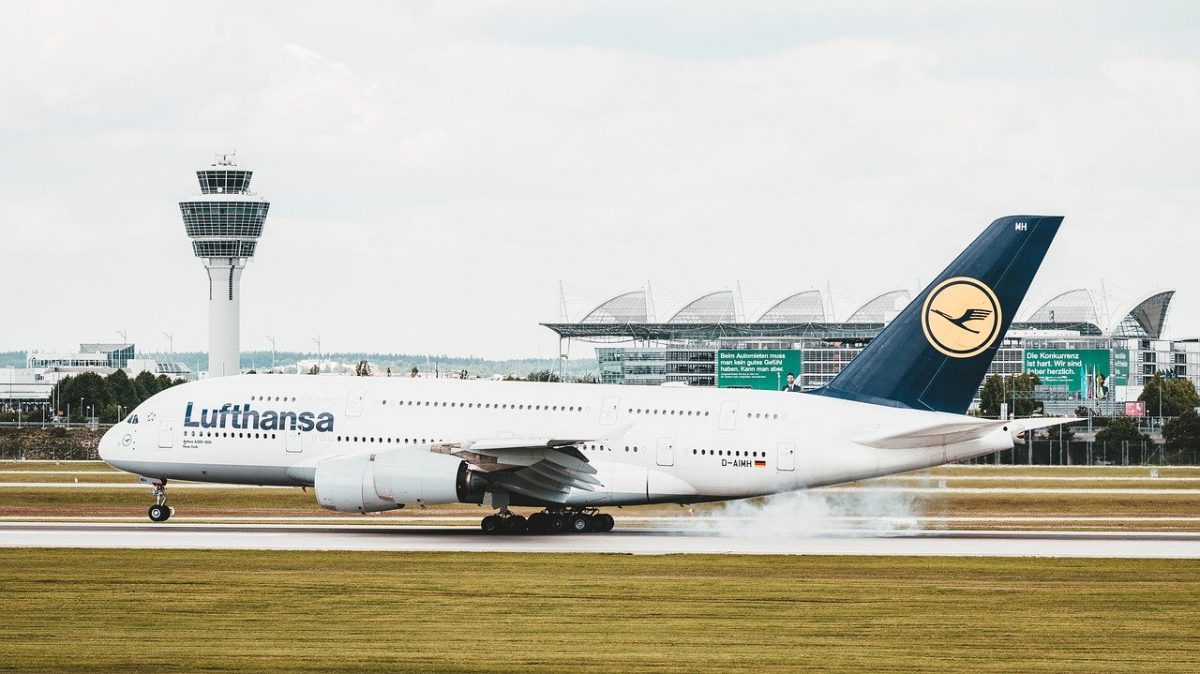
Munich is connected excellently to almost all cities in Europe and major cities around the world. Munich International Airport connects major cities of Europe and other destinations outside and is one of the busiest airports in the world.
Getting From Munich Airport to city centre or vice versa:
From Munich airport, you should take either the S-1 or the S-8 Bahn to reach the city centre or Hauptbahnhof (Munich Central Station). One way ticket costs about 13.00 €. You can also take the Lufthansa Bus from Airport to Munich central station, which costs 10.50€.
If you are travelling from other cities in Germany, you can book the Deutsche Bahn, which offers great deals if you book early. If you have the Euro rail pass, you can get discounted prices.
You can arrive in Munich from the cities of neighbouring countries by train too.
Bus is the cheapest way to get to Munich by road if you are traveling from other cities. Flixbus offers very low prices to buses across Germany.
Recommended: Munich: Airport Transfer by Bus
GETTING AROUND MUNICH
You can explore a part of the city on foot, especially around Marienplatz. Otherwise, the city has an excellent public transport system. You can rely on subways, trams and buses to get around Munich.
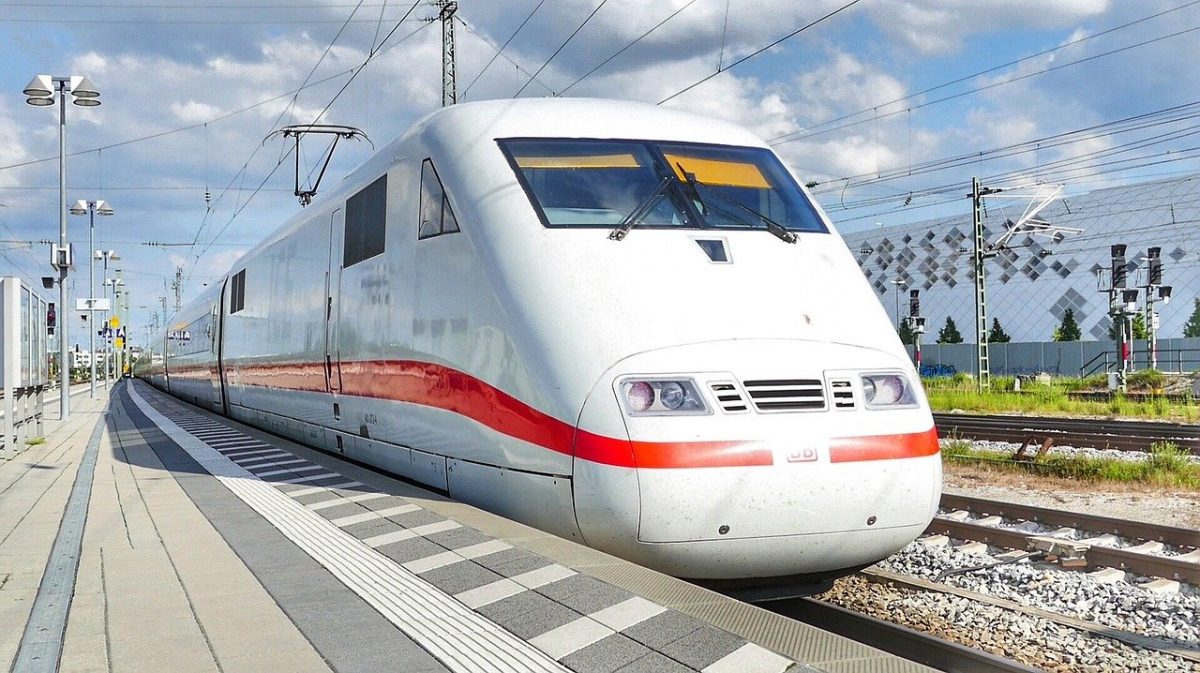
Munich transport passes
There are plenty of types of passes available to get around Munich without burying deep in your pockets. All of them include unlimited transport within the city of Munich(called the zone M). There are additional zones 1 to 6 beyond Zone M, which connects the city to other districts around. Munich airport is in Zone 5.
München Card – The München Card is an economical option for your Munich sightseeing. It provides a day ticket for public transport within the selected area of the MVV network. Additionally, you also get discounts of up to 70% at numerous sights, attractions, tours, shopping and gastronomy partners.
You can either buy Zone M(urban area of Munich and some municipalities outside of Munich) or Zone M – 6. 1 Day price of these starts at 11.90 € and 17.90 € respectively.
Single Day and Group Day tickets allow unlimited travel on S-Bahn lines, U-Bahn lines, Bus and Tram within the city in 24 hours. The price within Zone M is 7,80 €, and an additional 7,80 € if you want to include further zones.
Recommended: Munich: Private Airport Transfer to or from the City Center
Airport City Day Ticket
The Airport-City-Day-Ticket is a day ticket which includes the journey to/from the airport and the city area of Munich (validity zone M – 5). The Airport-City-Day-Ticket is available as a single ticket or as a group ticket for up to 5 people. A single ticket costs 13.00 €.
Munich City Tour Card – Transport + attractions
The CityTourCard includes a day ticket for use on public transport in the MVV network within the selected area of validity, as well as discounts for more than 80 tourist attractions in Munich and the surrounding area.
The CityTourCard is available as a Single or Group Ticket for a group of up to 5 adults, whereby any two children between 6 and 14 years of age count as one adult.
You can either buy Zone M(urban area of Munich and some municipalities outside of Munich) or Zone M – 6. 1 Day price of these starts at 13.90 € and 23.50 € respectively.
No matter what your pass type is, remember to get the ticket validated before you board the train on the platform. Your ticket is invalid if you don’t do this, and will be fined!
- Recent Posts
- Backpacking in the USA: Top Tips to Know - May 26, 2024
- Exploring the Mystical Land of Ladakh - May 26, 2024
- Your Ultimate Guide to the Best Things To Do in Krakow, Poland - April 12, 2024
Related Posts

15 Most Beautiful Cities in Germany That You Should Visit
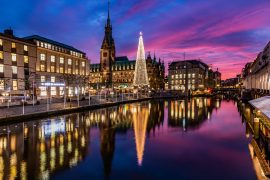
20 Enchanting Christmas Markets in Germany For Your Bucket List

16 Beautiful Day Trips From Munich That You Should Check Out!
Write a comment cancel reply.
Save my name, email, and website in this browser for the next time I comment.
- SOLO TRAVEL
- ARUNACHAL PRADESH
- HIMACHAL PRADESH
- UTTARAKHAND
- THE PHILIPPINES
- UNITED STATES
- TRAVEL FACTS AND TRIVIA
- WORK WITH ME
Type above and press Enter to search. Press Esc to cancel.

Touropia Travel
Discover the World
20 Top Tourist Attractions in Munich
By Carl Austin · Last updated on May 4, 2024
Munich is a glorious city that shrugs off the coldness and sternness of buildings that are so prevalent elsewhere in Germany. Sure, it has a few of these buildings, but in the old city visitors will find attractive historic buildings and monuments. Munich has a good public transportation system (bus and subway) that makes it convenient to move around the city.
Munich makes a good base for day trips to outlying areas, such as the Nazi concentration camp at Dachau or scenic Salzburg , but there is plenty to keep visitors in the city too. Here’s a look at the top tourist attractions in Munich :
Map of Munich
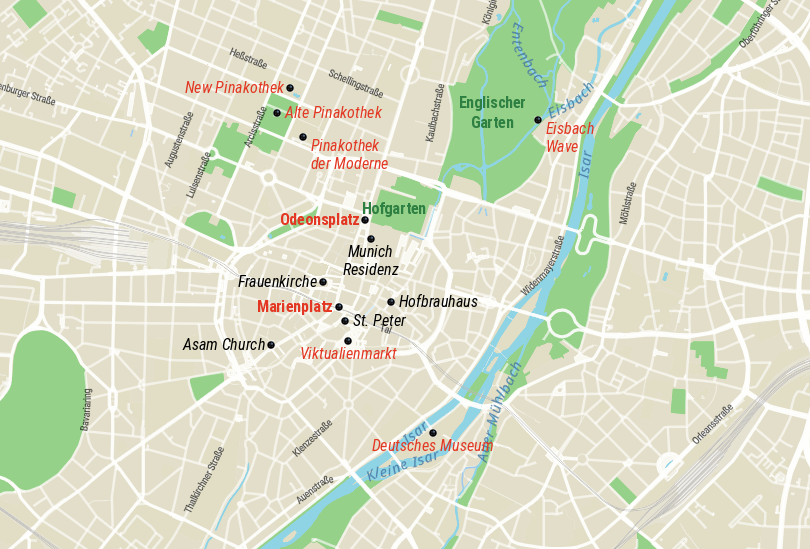
20. Hofgarten
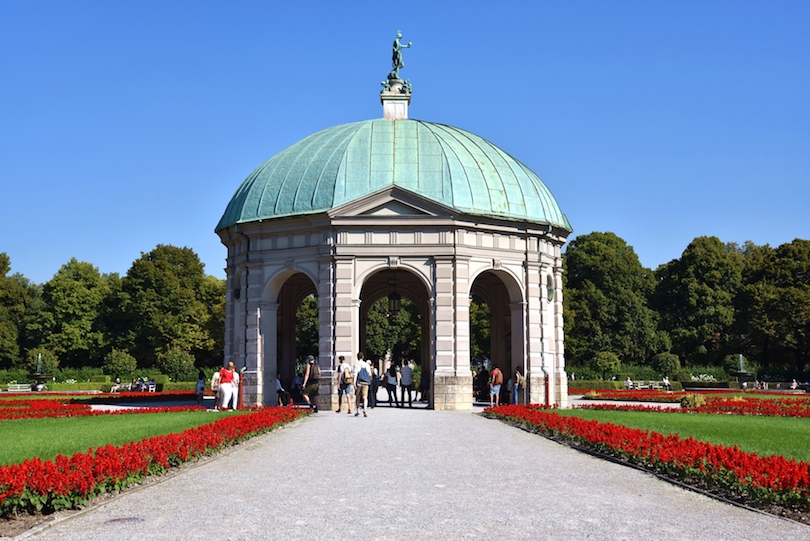
Located between the famed Residenz and the Englischer Garten is the Hofgarten, a beautiful garden built at the beginning of the 17th century in the style of an Italian Renaissance garden. The Hofgarten is open to the public from dawn to dusk, and it is the perfect spot for a stroll.
Check out the gazebo in the center of the garden, or just admire the beautifully manicured gardens. Many visitors grab some food and enjoy a picnic in the Hofgarten, and there are plenty of benches throughout the area where you can sit, rest and enjoy the view.
19. Pinakothek der Moderne
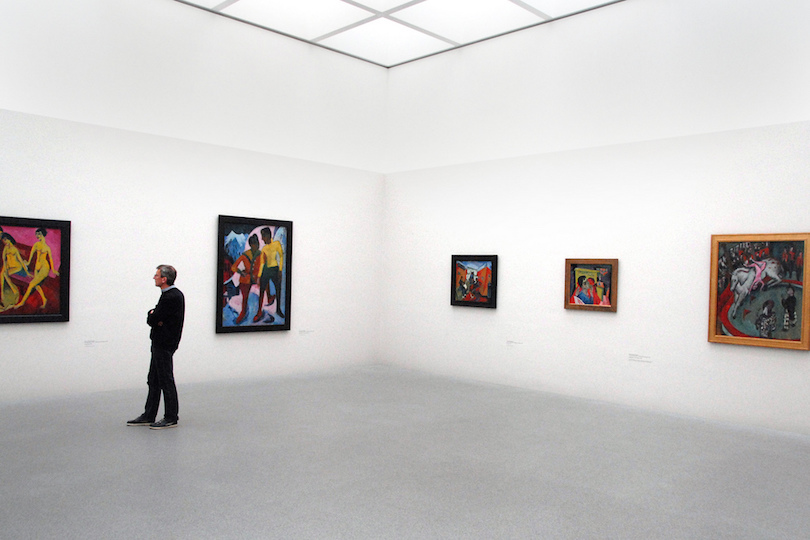
There are three major art museums in Munich that combine to create what is known as the Kunstareal in the area of Maxvorstadt. The newest is the Pinakothek der Moderne. This is where you’ll find the best contemporary art in the city, and arguably even in all of Europe.
The building that houses the collection is a strikingly modern structure built in the International Style. The Pinakothek der Moderne is divided into four sections, each of which is devoted to either art, architecture, design or works on paper.
Some of the most noteworthy artists whose works are on display include Andy Warhol, Salvador Dalí and Pablo Picasso.
18. Olympiapark
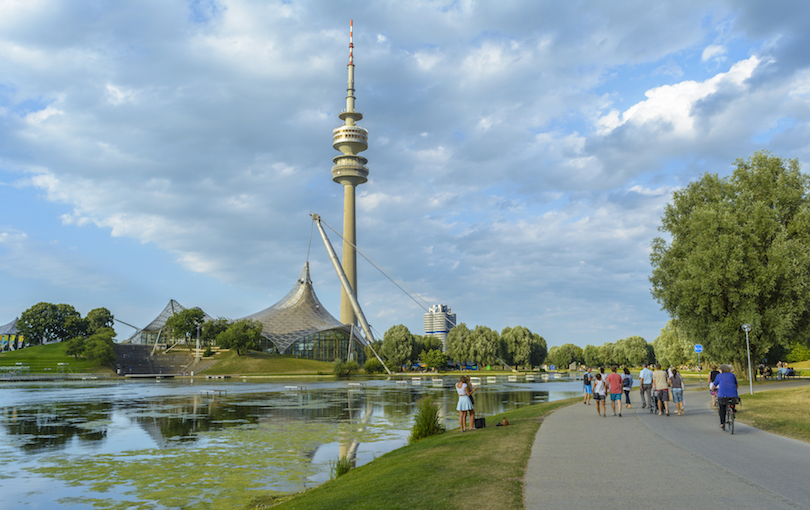
The 1972 Olympic Games were held in Munich, and many of the venues created for the event are located in what is now known as the Olympiapark. Munich is recognized globally for its success in turning the Olympic venues into spaces that continue to be used and generate income for the city.
If you’re visiting Munich, you might watch a concert or attend a festival in the Olympic Stadium. At the Olympic Lake, you can rent a boat and paddle around. If you want to soak in the views of the Olympiapark, grab a meal at the revolving restaurant at the top of the Olympic Tower.
17. St. Peter’s Church
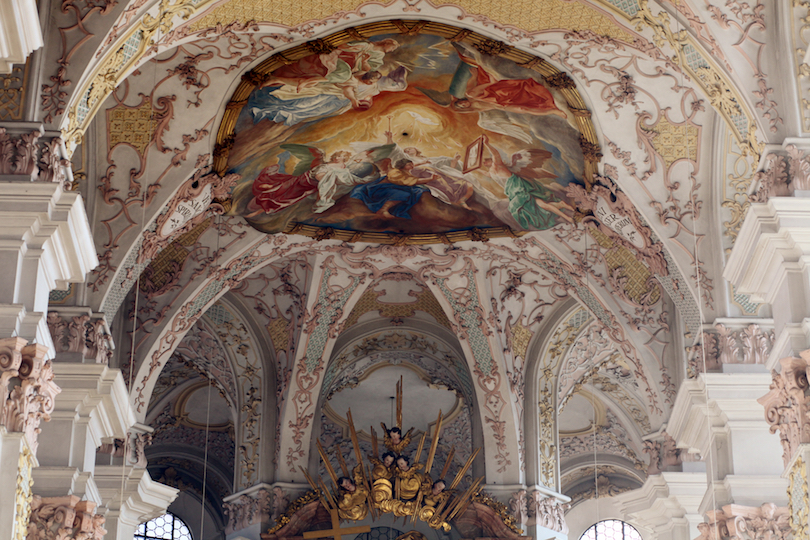
Peterskirche, or St. Peter’s Church, is a Catholic church located in Munich’s city center, or Altstadt. St. Peter’s Church was started in the 12th century and is the city’s oldest church, although fires and lighting strikes have damaged part of the structure over the centuries.
The Romanesque-style church hosts services several times each day, and it’s well worth attending one to admire the interior of the building. You can also climb Alte Peter, a tower accessible via more than 300 steps. The climb is worth the effort, however, because you’ll get a stunning view over Munich from the top.
16. Allianz Arena Stadium
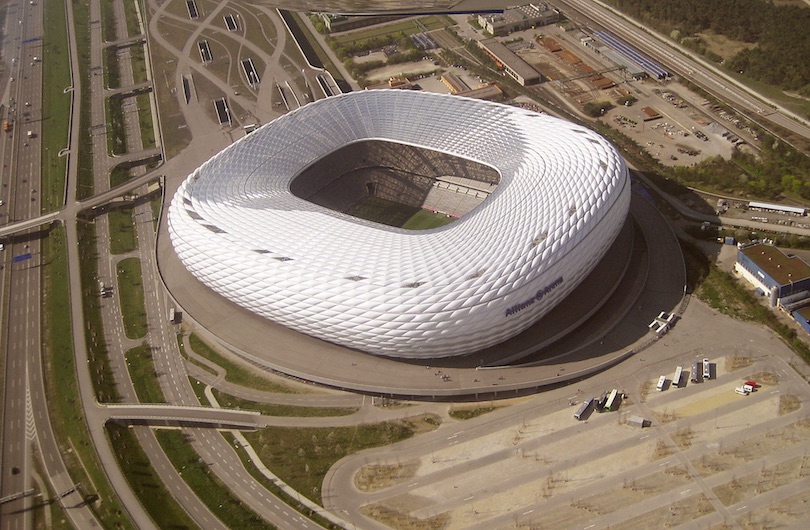
Sports fans who’ve ever wondered if football (soccer) is popular in Munich need only visit Allianz Arena Stadium, which seats more than 75,000 spectators who want to see one of the city’s two teams take the field.
The stadium replaced the city’s Olympic stadium beginning with the 2005-2006 season. The stadium, which hosted the World Cup finals in 2006, is known for its panels that change colors, depending on which team is playing and the type of match, i.e., local or national, being played.
15. New Pinakothek
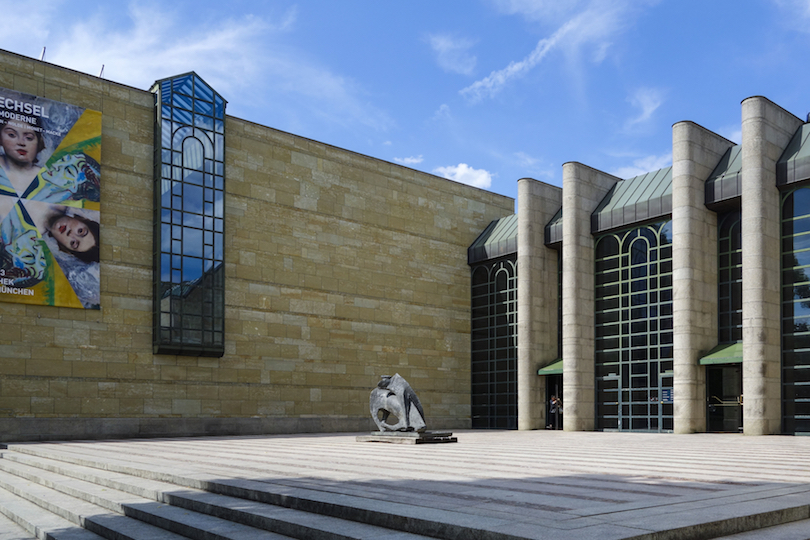
The second art museum in the Kunstareal is the New Pinakothek. Here, you’ll find an impressive collection of impressionist and expressionist art dating from the 19th and 20th centuries. The collection is housed in a relatively new postmodern building that was constructed in 1981.
The New Pinakothek is the place to go if you’re drawn to works by painters such as Francisco de Goya, John Constable, Eugène Delacroix or Claude Monet. There are also several interesting sculptures on display like the Crouching Woman by Auguste Rodin.
14. Eisbach Wave
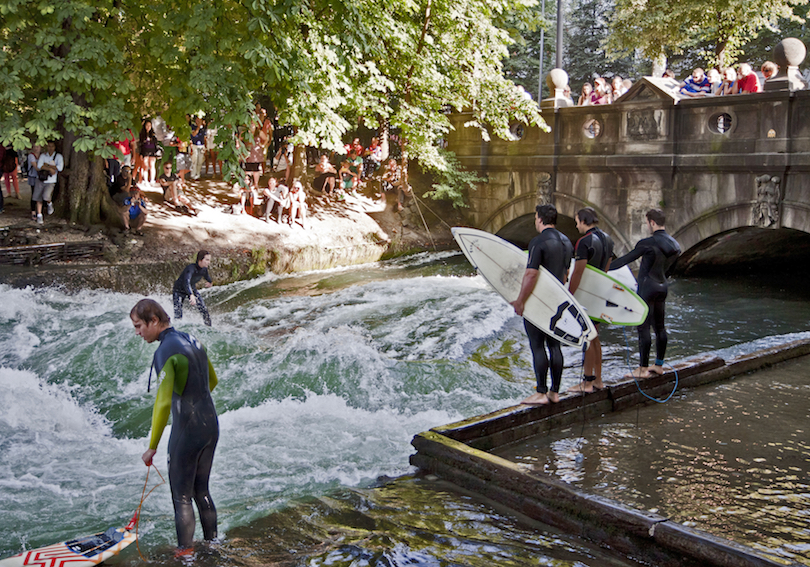
The Eisbach Wave is one of the more unexpected attractions located in the heart of Munich. It’s part of the Eisbach River, a man-made body of water that is just over a mile long. The Eisbach River flows through the Englischer Garten.
At one point in the river, there is a standing wave that is just three feet high. It is here that city dwellers have the chance to go surfing or even kayaking right in the heart of Munich.
It is common to see visitors standing next to the Eisbach Wave and watching surfers try to maintain their balance on the wave for as long as possible.
13. Odeonsplatz
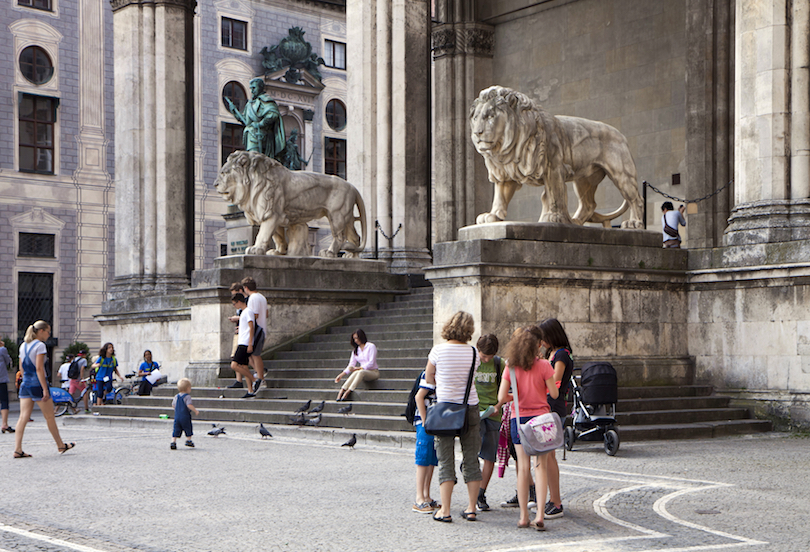
If you’re planning to spend any time in the Altstadt, then you’ll want to visit the Odeonsplatz. This central plaza is a major landmark in the city, and it is packed with interesting and historically significant attractions.
Both Ludwigstraße and Briennerstraße, two major thoroughfares through Munich, begin at the Odeonsplatz. The plaza is also home to the Theatinerkirche, a beautiful Italian-Baroque church, and the Field Marshals’ Hall, also known as the Feldherrnhalle.
The highlight of the Odeonsplatz is the Residenz, a palace that is now open to the public and home to a collection of royal jewels, crowns and family portraits.
12. Asam Church
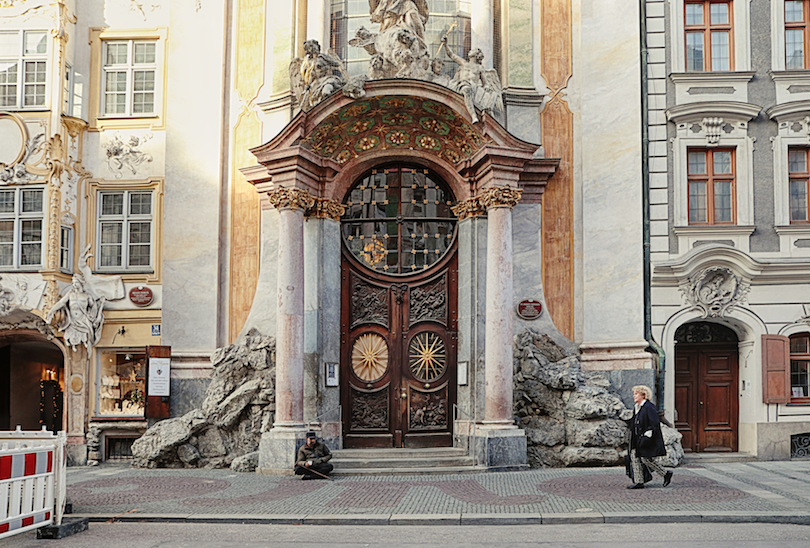
Asamkirche was built in the middle of the 18th century by brothers Egid Quirin Asam and Cosmas Damian Asam. Egid Quirin was the architect and sculptor, and Cosmas Damian painted the frescoes.
Built in the late Baroque style, this beautiful church was intended to be a private place of worship for the brothers. Due to public unrest, however, it was opened to the residents of the city.
The Asam Church can be toured, and make sure you look up to admire the stunning works of art on the ceiling. If you’re in Munich over the holiday season, the Christmas Eve service at Asam Church is a memorable experience, since the church looks especially beautiful in candlelight.
11. Neues Rathaus
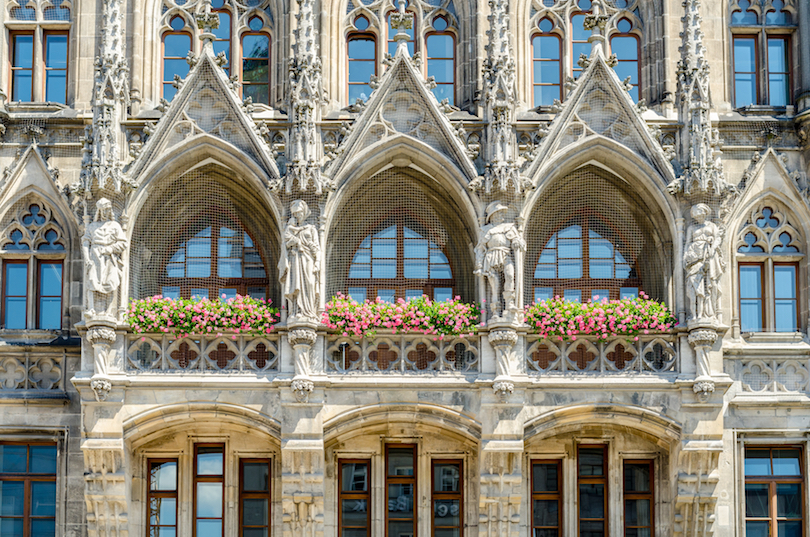
If you’re a fan of architecture, then don’t miss a chance to see the Neues Rathaus in Munich. The New City Hall was built in the neo-Gothic style, and it is a major attraction in the Marienplatz. The building is enormous and boasts six courtyards, a beautiful spiral staircase and plenty of stained glass windows.
Many people come to see the Neues Rathaus just for its clock, which has 43 bells and goes off three times each day. Carved figures emerge from the Glockenspiel and revolve around the clock in time with the bells, and it’s well worth seeing for yourself in person.
10. Viktualienmarkt
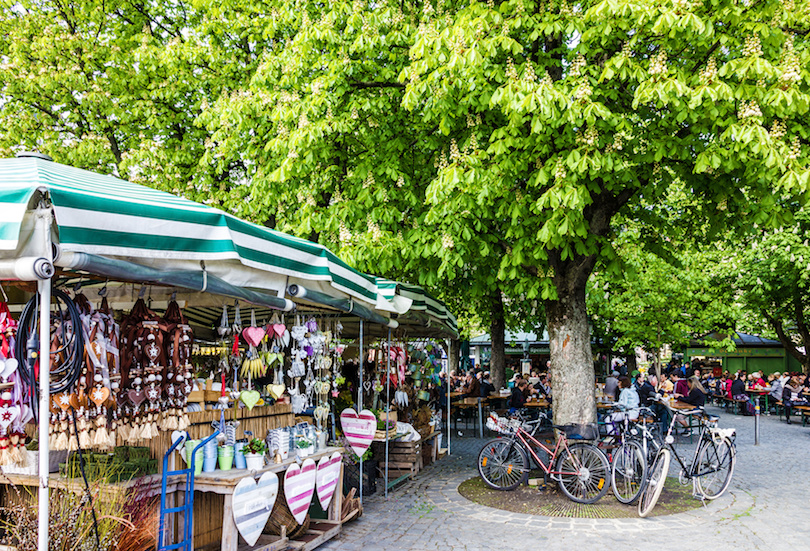
Next to the Marienplatz in the city center of Munich is the Viktualienmarkt, a large outdoor market with generations of history. Many of the vendors at the market have a family history at the Viktualienmarkt, making it a longstanding tradition to shop there.
Many locals head to the market on the way to or from work and pick up fresh produce. You can also find some homemade baked goods, premade soups, nuts and herbs for sale.
It’s a popular place for foodies, because many of the items for sale are upscale, gourmet or otherwise exotic ingredients. You’ll also find a few restaurants and a biergarten where you can stay for a drink or two.
9. Alte Pinakothek
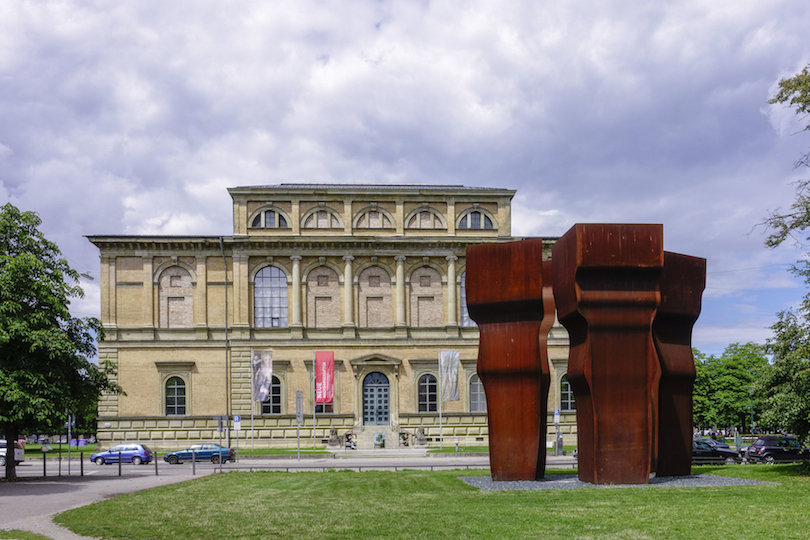
The third of the Kunstareal art museums in Munich is the Alte Pinakothek. This is one of the oldest art galleries in the world, and it is a must-see destination for classical art fans.
When it was ordered built in 1826 by King Ludwig I, the Old Pinakothek was the largest museum in the world; its neo-renaissance exterior soon became the model for museums located throughout Europe. The works of art displayed in the Arte Pinakothek come from the 14th through the 18th centuries.
The most celebrated works come from the Old Masters, including artists like Rembrandt van Rijn, Frans Hals and Leonardo da Vinci. There is a heavy emphasis on German painters, so look for works by Albrecht Dürer and Matthias Grünewald, among many others.
8. Deutsches Museum
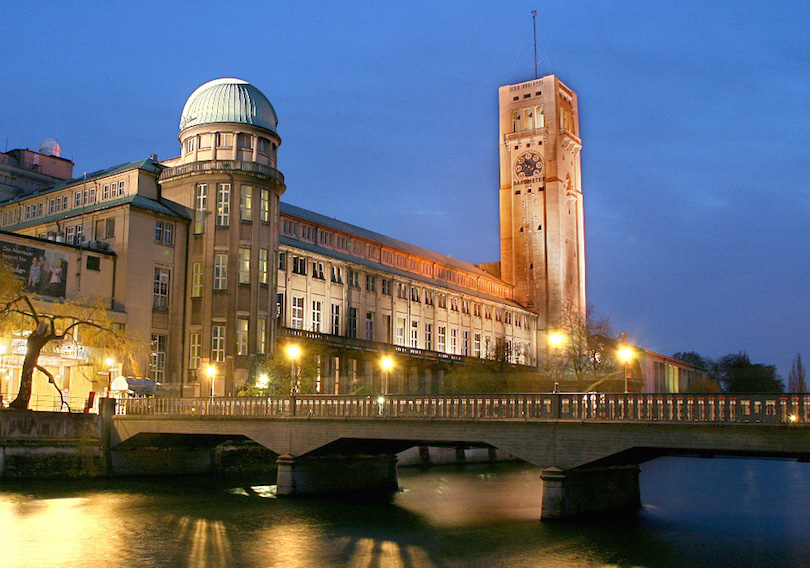
The Deutsches Museum is a world class science and technology museum that appeals to visitors of all ages, even those who profess not to be interested in such subject matter. Visitors can take free guided tours (conducted only in German though) through the museum’s 50 exhibit areas, view demonstrations on subjects ranging from electricity to musical instruments, and participate in a wide variety of hands-on activities.
The museum has a huge collection of more than 100,000 science- and technology-related objects from the Stone Age to today. The museum is family friendly, with 1,000 activities for kids 3-8 offered in Kids Kingdom.
7. Munich Residenz
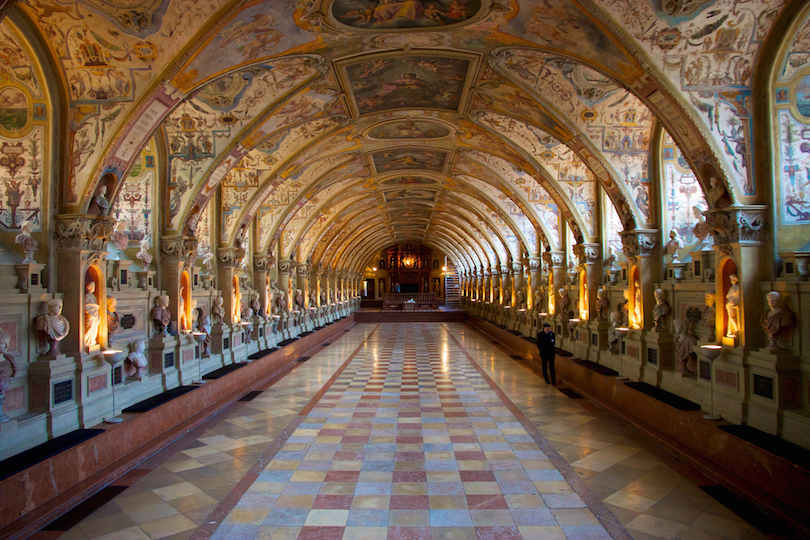
The Munich Residenz was home to Bavarian rulers, the Wittelsbachs, for centuries before it was opened to the public in 1920. Its art collections and various architectural styles became symbols of the royal family’s power. The residence sustained heavy damage in World War II, but has since been restored as much as possible.
Today, it is considered one of the finest palace museums in Europe. The Wittelsbachs collected fine art and objects for centuries, so visitors will be able to see outstanding collections of porcelain, paintings, silver objects, rare furniture, chandeliers and sculptures.
6. BMW Welt & Museum
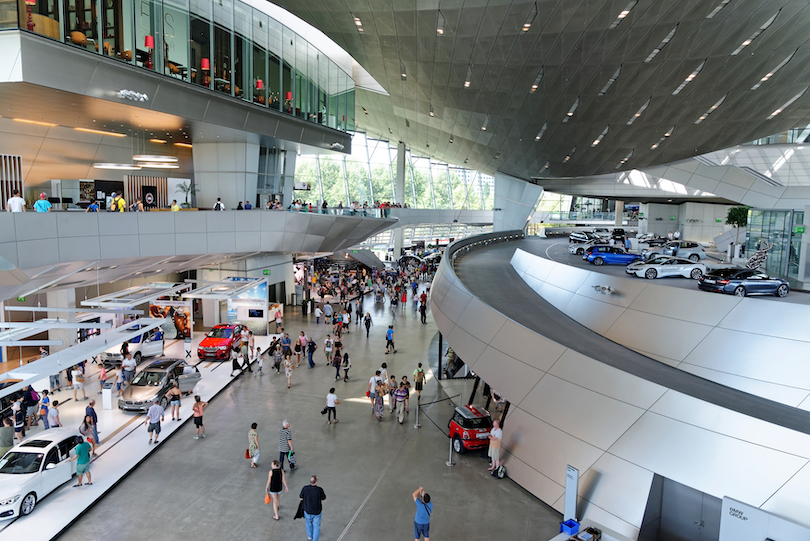
BMW is known for its fast cars and motorcycles; what better place to learn more about them than BMW Welt and the BMW museum. BMW Welt is a place to see and gain knowledge of the company’s latest product offerings.
BMW Welt also sells auxiliary accessories and parts for their vehicles, and hosts exhibitions of their latest models. It’s located near Olympic Park; park ticket holders can get a discount on BMW Welt admission.
The nearby BMW Museum has exhibits tracing the history of these famous two- and four-wheeled vehicles. Many old cars and motorcycles are on display along a spiral ramp that curls along the inside of the bowl-shaped building.
5. Nymphenburg Palace
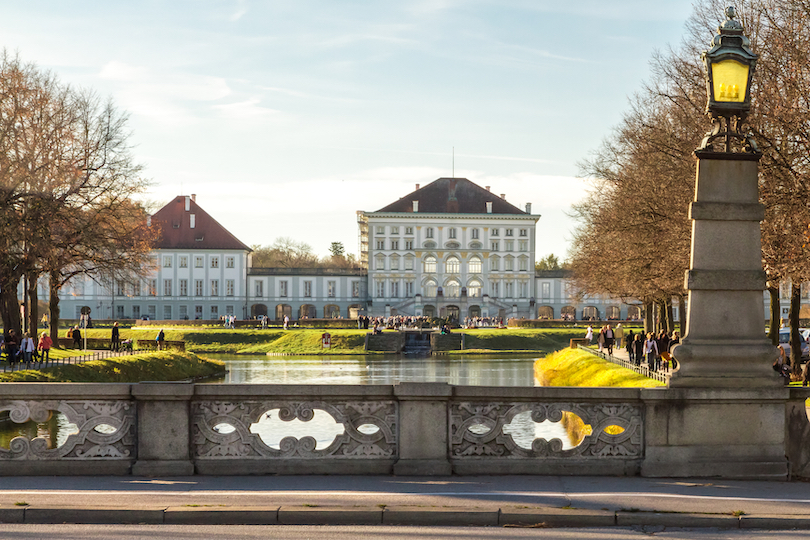
The Nymphenburg Palace celebrates the birth of an heir to the Bavarian throne, ordered built by the parents of Maximillian II Emanuel in 1664. The palace served as the summer residence of Bavarian rulers.
When he inherited the throne, Max Emanuel significantly enlarged the palace. Today this baroque palace is one of Munich’s more popular tourist attractions, even though sections are closed to the public since it also serves as the home for the current Duke of Bavaria.
Original baroque ceilings, some with frescoes, survive to this day, as do King Ludwig I’s Galleries of Beauties that portray 36 beautiful Munich women.
4. Munich Frauenkirche
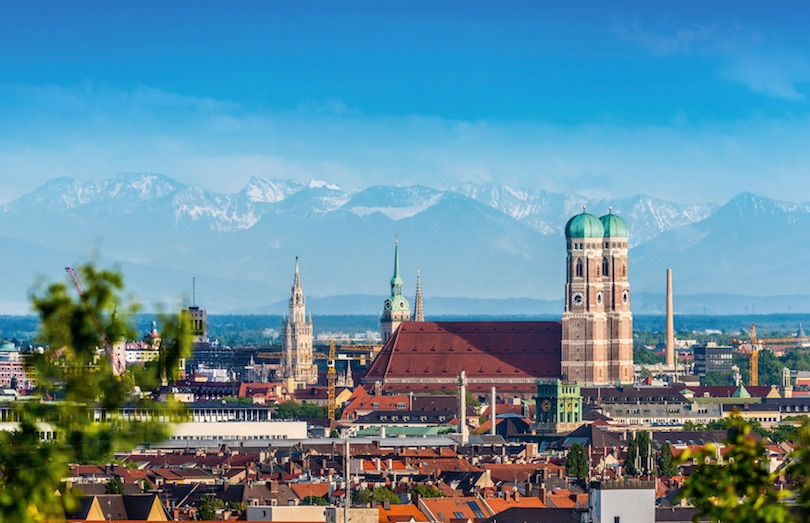
The Munich Frauenkirche is another famous Munich landmark that towers over the rest of the city. It dates back to the 15th century when it was built in an astounding 20 years’ time, though completion of some features was postponed due to lack of money.
The Munich Frauenkirche serves as the cathedral for the Archdiocese of Munich and is home to the archbishop. The Gothic cathedral is capable of holding 20,000 worshipers. The cathedral was damaged during World War II, but has been restored It is famous for its bells and as the final resting place for the Dukes of Bavaria.
3. Hofbrauhaus
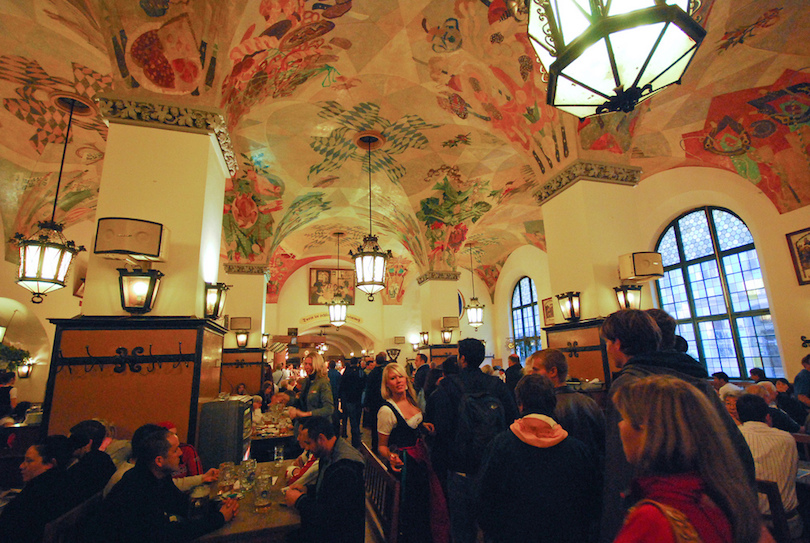
Munich residents do love their beer, celebrating it annually at Oktoberfest. Travelers who won’t be here then can still sip the suds at the Hofbrauhaus, one of the oldest breweries in town.
The Hofbrauhaus dates back to 1589 when it was founded by Wilhelm V, Duke of Bavaria, when it served as the official brewery for Munich’s royalty. Even back then, the beer had an international reputation, with Swedish invaders agreeing not to sack Munich in exchange for 600,000 barrels of beer.
The brewery and the beer hall are among the most popular tourist attraction in Munich today.
2. Englischer Garten
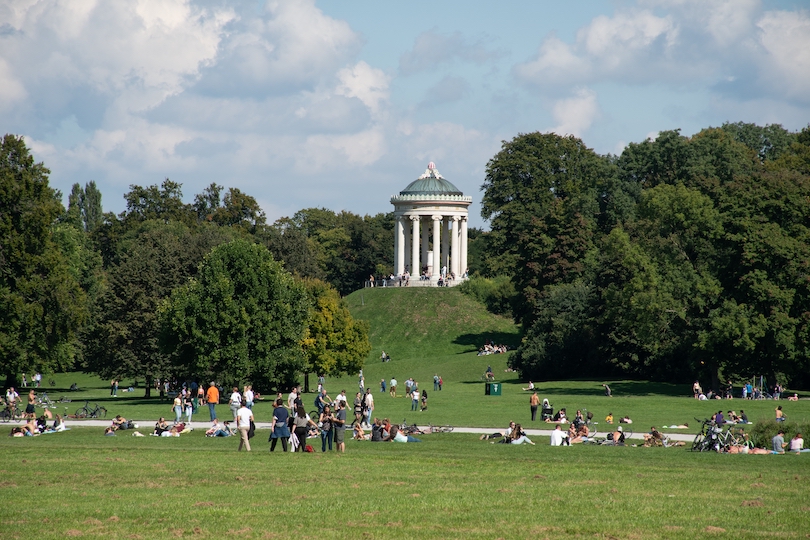
The size of New York City’s Central Park pales in comparison to Munich’s Englischer Garten, one of the world’s largest urban parks. The park, which stretches from the city center to northeast Munich, was established in 1789, but has been enlarged over the centuries.
It takes its name from the traditional English gardens that were popular in the 18th and early 19th centuries. It was built by soldiers during times of peace to teach them agricultural skills. The garden contains a Japanese teahouse, a meadow where nude sunbathing is permitted and an artificial wave used by surfboarders.
1. Marienplatz
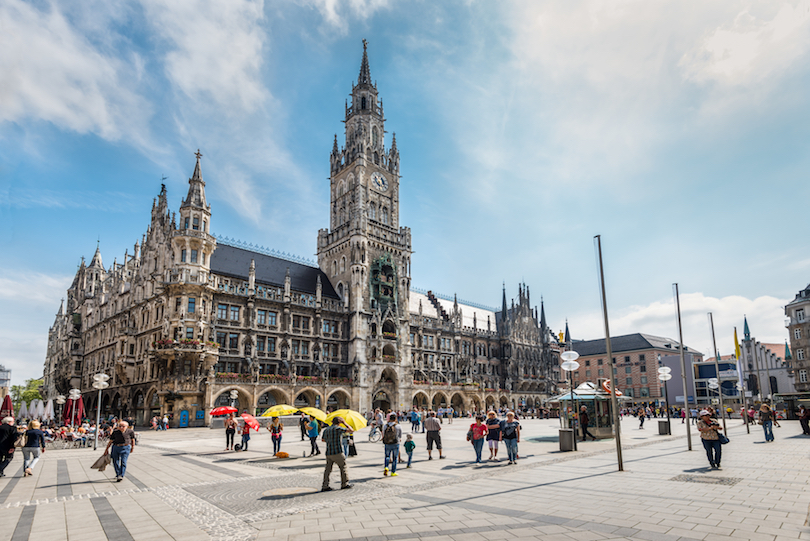
Marienplatz is the most famous square in Munich, drawing thousands of tourists every day who come to see the New Town Hall that dates back to 1874. The city hall was built in the Gothic Revival style, and features most of the Wittelsbach rulers on the main façade while statues of four Bavarian kings are on a lower level.
This highly ornate building is a tourist magnet in itself, but what really draws the tourists to Marienplatz is the thrice-daily performance of the Glockenspiel. The famous Ratskeller restaurant is in the basement.
Share this post:
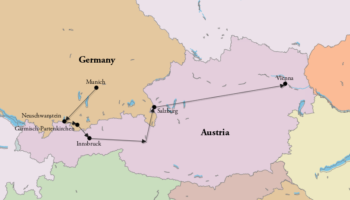
How to Travel from Munich to Vienna
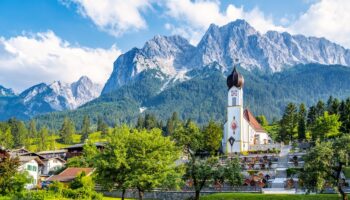
10 Best Day Trips from Munich
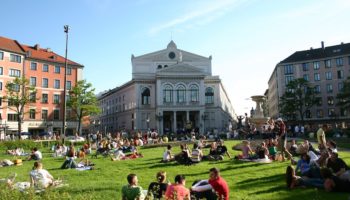
Where to stay in Munich: 7 Best Neighborhoods
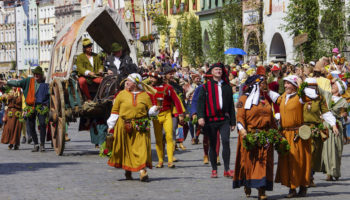
17 Best Places to Visit in Bavaria, Germany
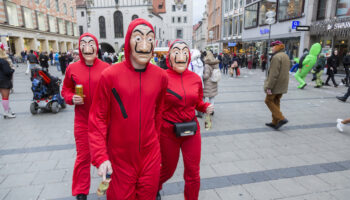
Best Time to Visit Munich: Month-by-Month Guide
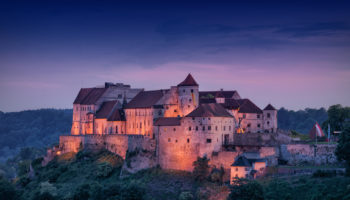
8 Most Beautiful Castles Near Munich
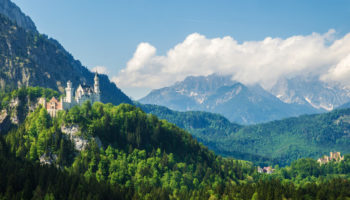
10 Top Destinations in Southern Germany
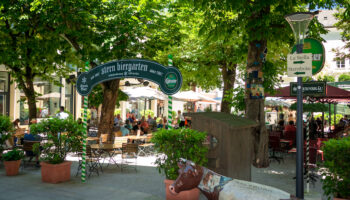
A Picture Perfect Day Trip to Salzburg from Munich
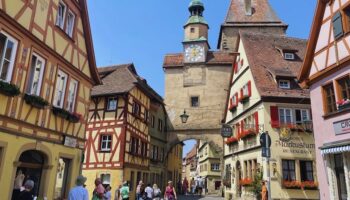
7 Things to do in Rothenburg: Day Trip from Munich
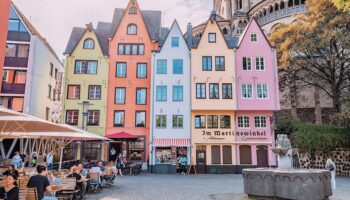
23 Top Tourist Attractions in Cologne
Reader interactions, leave a reply cancel reply.
Your email address will not be published. Required fields are marked *
This site uses Akismet to reduce spam. Learn how your comment data is processed .
City tours, guided tours, events
Tourist Information Munich: The most important info points and tips for tourists
The Munich tourist board and the tourist information office are your primary source of information. They will be pleased to make your stay in Munich as pleasant as possible. Staff are happy to help you find accomodation and to inform you about entertainment and cultural events in the city.
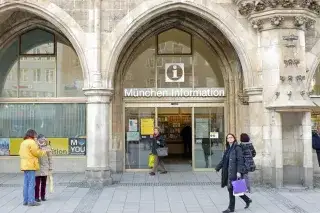
More actions
- Share on Facebook
- Share via WhatsApp
Tourist Information in the City Hall at Marienplatz
- Competent advice daily in several languages
- Mediation of hotel rooms
- Tips for an unforgettable stay in Munich
- Service documents
- Tickets for sightseeing tours and city walks
- Tickets for excursions into the surrounding countryside and to Bavarian castles and lakes
- Tickets for the tower ascent in the New City Hall
- Sale of the official guest cards: Munich Card and City Pass
Address Marienplatz 8 80331 München
Tourist Information at the Central Station
- Tickets for excursions to the surrounding countryside and Bavarian castles and lakes
- Sale of the official guest cards: Munich Card and City Pass
Address Luisenstraße 1 80333 München
Infopoint - Museums & Castles in Bavaria
- Up-to-date information on Bavaria's approximately 1,300 museums and palaces.
- Advice and brochures on collections, exhibitions, events, how to get there, opening hours.
Alter Hof 1, 80331 Munich Phone: 089/ 210 140 50
Opening hours:
- Monday - Saturday 10 am - 6 pm
- Closed on sundays and holidays
Further information
Munich Tourist Board Herzog-Wilhelm-Str. 15, 80331 München Tel.: +49 (0)89 233 96 500 Fax: +49 (0)89 233 30 233 [email protected]
Privacy settings
Here you will find an overview of the types of cookies used on the website. You can set your consent for each category individually. Further information can be found in the privacy policy .
- Essential Cookies For the use of the website with all functions (e.g. user settings, watch lists, etc.)
- Statistics Statistics Cookies collect information anonymously. This information helps us to understand how our visitors use our website.
- Marketing In order to provide you with the best possible offer in cooperation with our partners, we use marketing tools. For example, in order to use our chatbot, you must activate this setting.
- External contents Required for viewing external media and third-party content. The provider may set cookies for its part. The respective data protection regulations of the provider apply.
- Inspiring Germany
- Cities & Culture
- Nature & Outdoor Activities
- Royal Palaces & Castles
- Experience & Enjoy
- Current highlights
- Sustainable travel
- Barrier-free travel
- Easy language
- Federal states
The German National Tourist Board
On behalf of the German federal government, the GNTB has been working internationally to promote Germany as a travel destination for more than 60 years. It communicates the diverse appeal of the country to a worldwide market, thereby promoting a strong and attractive brand – 'Destination Germany'.
The GNTB plays an important role in the promotion of Germany as a travel destination on the international market. Its activities include the development of new marketing strategies and concepts based on specific themes, events and attractions and also bringing together and optimising the diverse marketing activities of partners in the German travel industry. It also takes an active role in the form of far-ranging sales activities in new growth markets. In this respect, the GNTB relies on its close collaboration with the German travel industry, partners from commerce and trade associations.
Training and working at the GNTB
The German National Tourist Board (GNTB) is the central organisation for marketing Germany as a travel destination. We aim to communicate the beauty, diversity, romance and vibrancy of the country to people of all ages in Germany and abroad. Germany is currently one of the most popular international travel destinations. Below you can find detailed information about training, work placements and jobs at the GNTB.
Cooperation agreements and partners
The idea of public-private partnership, in other words combining private and public interests in both a conceptual and commercial sense, has been one of the GNTB's guiding principles from the outset.
Discover more
Standard Terms and Public Procurement
You would like to work with the German National Tourism Board promoting Germany as a travel destination on the international market.

The 20 Most Fun and Interesting Germany Facts You Didn’t Know
G ermany is a gorgeous country in Europe that boasts vast forest land and the infamous Alps. Countless unique characteristics of Germany make it stand out from other European countries. Whether you’re looking to visit or planning a permanent move, here are the 20 most fun and interesting facts about Germany.
1. There Are Around 48,000 Animal Species in Germany
There are around 48,000 animal species in Germany — many of which are insects and birds.
2. The Largest Train Station in Europe Is Located in Germany
Leipzig, Berlin, Germany is home to the largest train station in all of Europe (measured by floor area): Leipzig Hauptbahnhof, or Leipzig Central Station. The station opened in 1915 and is 83,460 square meters .
3. One-Third of Germany’s Land Area Is Forests
That’s right — around 33% of Germany consists of forests and wooded areas. For reference, that’s around 11.4 million hectares of land.
4. Germany Is the Largest Economy in the European Union (EU)
Not only is Germany the fourth largest economy in the world , but it is also the No. 1 largest in all of the EU.
5. Oktoberfest Originated in Munich, Germany
The first Oktoberfest took place in Munich, Germany in the year 1810. Since then, it has become a worldwide celebration and beer festival.
6. Germany Is Home to the Narrowest Street in the World
The narrowest street in the world is located in Reutlingen, Germany. Originally named “Spreuerhofstrasse,” the street measures 31 cm (1 ft 0.2 in) at its narrowest point and 50 cm at its widest.
7. The “Christmas Tree” Tradition Started in Germany
Have you ever wondered where the tradition of putting up a Christmas tree during the holiday season originated? Well, it turns out this custom started in Germany during the 16th century.
8. It Is Legal to Escape Prison in Germany
If you escape prison in Germany, you cannot be punished for it, as it is considered human nature to crave freedom. Of course, you will be on the hook for any damages or violence you commit during or after the fact.
9. Germany Contains the Most Castles in the World
Germany is known for its gorgeous, expansive castles. In fact, experts estimate that there are around 25,000 castles — possibly more — throughout the country.
10. Germany Has Over 3,000 Types of Bread
According to experts, there are over 3,000 types of bread in Germany. Just like beer is a major part of Germany’s culture, bread (and other baked goods) is a staple in the country.
11. Germany Was the First Country to Adopt Daylight Saving Time
In 1916, Germany became the first country in the world to observe daylight savings. It started as a way to conserve energy resources during World War I and was eventually adopted by more countries during World War II.
12. Germany Has Banned Certain Baby Names
Many countries have bans on certain baby names, but Germany tends to be on the stricter side. For instance, the country has banned the use of last names, object names, product names, and names that could negatively impact the child’s mental health (e.g. would cause humiliation) as first names. In the past, you couldn’t even use gender-neutral names in Germany, but that restriction is said to have become looser in recent years.
13. Germany Is “The Land of Poets and Thinkers”
Many people use the phrase “Das Land der Dichter und Denker” to describe Germany, which translates to “The Land of Poets and Thinkers.” This name can be attributed to Germany’s significant progressions in and contributions to art, literature, and philosophy.
14. Beer Is a Staple ‘Food’ in Germany
Germany refers to its beer as “liquid bread,” treating it like its own food item. In fact, the country is infamous for its beer culture and abundance of breweries.
15. There Are Around 90 Billon Trees in Germany
As mentioned earlier, much of Germany is made up of forests and woodland. Consequently, the country has around 90 billion trees in total.
16. There Are Over 1,200 Types of Sausages in Germany
Another staple food item in Germany is sausage. In fact, the country boasts around 1,200 different kinds of sausages.
17. Some of Germany’s Autobahn Have No Speed Limits
Did you know that over half of Germany’s autobahn has no speed limit? Even so, it is still recommended drivers do not exceed 80 mph.
18. Most of Germany’s Taxis Are Mercedes
If you’re taking a taxi in Germany, you will be traveling in style, as most of the taxis in the country are Mercedes.
19. Germany Borders Nine Countries
You read that right — Germany borders a whopping nine neighbors, including Denmark , Netherlands , Belgium , Luxembourg , France , Switzerland , Austria , Czech Republic , and Poland .
20. Germany Is a Country of Readers
Germany is a country filled with avid bookworms. Furthermore, the reading culture in this European country is advanced, and tourists will often see residents with open books while commuting to work or even sitting at the cafe.
Love Animals as much as we do? Make sure to Follow and Like us on MSN. Have feedback? Add a comment below!
- How Big Is Germany? Compare Its Size in Miles, Acres, Kilometers, and More!
- 50+ Fun Facts Everyone Should Know About Mexico
- 17 Mind-Blowingly Fun Facts About Japan You Won't Believe
The post The 20 Most Fun and Interesting Germany Facts You Didn’t Know appeared first on A-Z Animals .

MORE SECTIONS
- Competitions
- Fan Network

Can fans drink alcohol at Euro 2024 stadiums? England and Scotland warned about German beer strength
- Joe Brophy , Senior SEO Writer
- Published : 15:00, 28 May 2024
- Updated : 14:39, 29 May 2024
- Published : Invalid Date,
British football fans travelling to Euro 2024 this summer will relish Germany's love of beer.
England supporters largely remained sober for the 2022 World Cup in strict Qatar but are now back in a familiar European setting.

However, the Foreign Office have warned England and Scotland fans that beer in Germany can be stronger than pints in the UK.
"Beer can be stronger than in the UK, so drink responsibly, know your limits and respect local laws," it said.
"You may not be let into the stadium if you drink too much."
Can fans drink beer at stadiums?
Germany supporters typically are permitted to consume alcohol in their seats at matches, a practice banned in the UK.
Read more on Euro 2024

England and Scotland fans warned by Foreign Office about German beer ahead of Euro 2024

Grealish reveals Man City banter over Euro 2024 and talks up 'frightening' England
This saw Jamie Carragher join Borussia Dortmund fans in downing lager for the club's 1-0 win over Paris Saint-Germain at the Signal Iduna Park in May.
However, alcohol bans have been introduced for certain Bundesliga matches that are viewed as high-risk so a similar practice will be expected in some Euro 2024 games.
It is yet to be confirmed whether England fans will be served at the Veltins Arena for the Three Lions' opening game against Serbia.

Bitburger beers are one of the main sponsors of Euro 2024 and will be available exclusively in all stadiums.
The German brewer will also be sold in the official fan zones and events in the host cities.
Bitburger is about 4.8 per cent Alcohol By Volume in strength, which is more than the 4.4 for the average lager and ale in the UK.

What are the prices?
England's opening game against Serbia takes place in Gelsenkirchen, where a beer at a restaurant or pub is expected to be between £3-£4.
Frankfurt, the host city for the Three Lions' next stop, has similar prices before fans can enjoy a slight price cut in Cologne.
An imported beer at a restaurant in England's third group-stage game could be as cheap as £2.50, with table wine at £5.98.
A disclaimer for fans is that while alcohol may be cheaper in supermarkets, the prices are likely to be ramped up inside stadiums.
Most read in Euro 2024

Trippier says England can win Euro 2024 and picks teammate who 'surprised' him

Five England players ruled out of Bosnia clash as Southgate names new captain for friendly

Euro 2024 LIVE: Stones and Saka to miss England's first friendly, Dykes out, Ronaldo news

Everything you need to know about Euro 2024 from fixture schedule to stadiums
Euro 2024 odds (with talksport bet).
To lift the trophy:
- England - 3/1
- France - 7/2
- Germany - 5/1
- Portugal - 8/1
- Spain - 9/1
- Italy - 18/1
- Netherlands - 18/1
- Belgium - 18/1
*odds subject to change
Unsure who to back? Take a spin on the Lucky Dip wheel and get a random team at 20/1 to win the tournament.
You could get England at a massive price! - spin here . 18+ gambleaware.org
- England Football
- Scotland football team
- Gareth Southgate
This sunny German city should top your summer travel list
In the verdant forests of Baden-Württemberg, the carefree city of Karlsruhe brims with eye-catching architecture, cruisy cycleways, countless green spaces, trendy cafes, bars and beer gardens. This summer, soak up the sun in one of Germany’s warmest cities.

Founded in 1715, Karlsruhe in southwest Germany is somewhat young by European standards. On the upper plain of the Rhine River, this neo-classical city is set amid the Vosges Mountains, the Palatinate Forest and the Black Forest in the state of Baden-Württemberg. Karlsruhe is a centre for technology, science and media, and the seat of German law — the German Federal Court of Justice. Arts and outdoor living dominate daily life in the city, while the natural playground of Baden-Württemberg is just a stone’s throw away, where epic hiking, cycling and outdoor adventuring awaits. Here's how to explore the city at its best this summer.

One of Germany’s most sun-soaked cities, Karlsruhe enjoys average temperatures of 20C in the summer and around 140 days of sunshine each year. With its pleasant weather and wealth of green spaces, the city lends itself perfectly to exploration on foot. Start in the city's cultural and geographic heart at Karlsruhe Palace with a stroll around the ‘princely pleasure gardens’. For the more inquisitive, the history of Germany is told at the Badisches Landesmuseum (State Museum of Baden) located inside the palace, or for the best view of Karlsruhe’s neo-classical design, climb the palace’s central tower.
From the city's palatial centrepiece, 32 streets and avenues spread out precisely in the shape of a fan, giving Karlsruhe its nickname, fächerstadt or ‘fan city’. The beautiful layout impressed former US president Thomas Jefferson so much that he used it as inspiration for the design of the city of Washington, DC. Pick the central avenue of Karlsruhe's 'fan' and wander south through the beautifully landscaped Schlossplatz, where locals gather on balmy evenings to raise an Aperol spritz. From mid-August until mid-September, Schlossplatz plays host to the spectacular Schlosslichtspiele Light Festival that turns the palace and square into a vast canvas for art and expression. At Platz der Grundrechte (the Square of Fundamental Rights) don’t mistake the myriad signs for German over-efficiency — they’re actually an art installation of musings on the notion of right and wrong.
Continue to Marktplatz, the central square, where colourful buildings vie for attention alongside the baroque-era Church of the Holy Ghost, the city hall and the Karlsruhe Pyramid, which was built over the tomb of the city’s founder, Karl Wilhelm III. Flowers spill from market stalls, their fragrance filling the square and lingering over the terraces of nearby cafes and restaurants.

Pull up a chair at a konditorei (pastry shop) to people-watch and refuel with a huge slice of Schwarzwälder kirschtorte , more commonly known as Black Forest gateau — the cherry liqueur-soaked dessert famed around the world. When the sun starts to set, head for the festoon lights twinkling over the terrace of Wilma Wunder and order a colourful unicorn cocktail decorated with rainbow sprinkles. Then take things upscale around the corner at Eigenart , where waiters pair the best German wines with Mediterranean-influenced dishes.
Make the most of the warm evenings at Parkdeckzehn P10 , a sand-floored beach bar built on the top floor of a car park. Strewn with deck chairs and strandkorb , classic German wicker beach seats, it pulses under party lights and lounge music — an Ibizan beach amid the rolling greens of Baden-Württemberg. Nearby, hidden in a vaulted cellar on Hirschstrasse, The Door will take you into the early hours with its creative menu of bird-themed cocktails and highballs.
As the sun rises, it’s in the green spaces that Karlsruhe really shines. Take a morning walk in the historical Karlsruhe Botanical Gardens , awash with exotic plants and a showcase for stately architecture, designed in the style of Georgian-era English gardens. The neo-classical Staatliche Kunsthalle (State Art Gallery) houses seven centuries of masterpieces from Dürer to Delacroix, but is most impressive when viewed from the outside in its garden setting. Just north, the forests of the Waldstadt stretch to the horizon.

For a different perspective, visit in July when Das Fest (The Festival) rolls into Günther-Klotz-Anlage Park, bringing with it a quarter of a million revellers for four days of fun. One of the state’s biggest open-air events, its line-up spans genres to attract the widest range of people, young and old, with music, performance, arts and even the German Skateboard Championships. If that isn’t enough, the organisers hold Das Fest Am See a week before, a sort of pre-festival festival on the shore of the park’s picturesque lake.
But perhaps the most fitting way to explore Karlsruhe is on two wheels — it was here, after all, that Baron Karl von Drais invented what would become the bicycle. The extensive network of cycleways that weave around the city reflect Karlsruhe’s love for cycling. Rent a bike or e-bike from one of the numerous KVV points and dip in and out of the widely signposted NaturRADtour at will. Or pedal past the city limits and follow a long-distance cycle route further into beautiful Baden-Württemberg, such as the Rhine Valley Way or the Black Forest Way .
Related Topics
- TRAVEL AND ADVENTURE
- SHORT TRIPS
- CITY BIKING
You May Also Like

A guide to Berlin, Germany's most creative city

How to spend a long weekend in Zagreb, Croatia

How to plan a weekend in southern Kosovo, where Europe's newest adventure scene is blossoming

An insider's guide to Denver, Colorado's wildly creative capital

10 best things to do in Switzerland
- Terms of Use
- Privacy Policy
- Your US State Privacy Rights
- Children's Online Privacy Policy
- Interest-Based Ads
- About Nielsen Measurement
- Do Not Sell or Share My Personal Information
- Nat Geo Home
- Attend a Live Event
- Book a Trip
- Inspire Your Kids
- Shop Nat Geo
- Visit the D.C. Museum
- Learn About Our Impact
- Support Our Mission
- Advertise With Us
- Customer Service
- Renew Subscription
- Manage Your Subscription
- Work at Nat Geo
- Sign Up for Our Newsletters
- Contribute to Protect the Planet
Copyright © 1996-2015 National Geographic Society Copyright © 2015-2024 National Geographic Partners, LLC. All rights reserved

IMAGES
VIDEO
COMMENTS
We look forward to seeing you again in Munich. Our tip: the exclusive travel package with Munich Card and Tower Ascent. Book now. 3 days from 218 € for 2 pers. Munich Card & City Pass. Discover Munich in a relaxed and uncomplicated way: discounts for the diverse range of art, culture and leisure activities with our guest cards.
The square is free to visit 24/7, though individual businesses operate their own hours. The Marienplatz square, accessible by a U-Bahn station of the same name, is considered the heart of Munich ...
Visit Munich: The ideal holiday destination. From lakes, parks and beer gardens to museums, historical sites and massive stores, there's something for everyone who visits Munich. If you seek the ...
1. Marienplatz. The New Town Hall on Marienplatz. Start your Munich tour at the heart of the city. The Marienplatz (Square of our Lady) with its imposing neo-gothic city hall (" Neues Rathaus ") is one of the best photography spots in the city. Every day at 11 a.m. and 5 p.m. the gigantic carillon comes to life.
4. Taste hearty Bavarian cuisine in Munich's beer halls. For some great local grub, head to one of Munich's many beer halls or Wirtshäuser (taverns). Arrive hungry and dig into pork knuckles, roast chicken, dumplings and large Brotzeit platters laden with cheese, cured meats and pickles.
Munich. Germany, Europe. Tall tankards and high-tech cars, edgy art and Lederhosen - Munich is where traditional and modern sit side by side like few places on earth. Best Time to Visit. Best Things to Do. 01 / Attractions.
See ways to experience (18) 5. BMW Museum. 10,041. Speciality Museums. Interactive automotive museum with a diverse display of classic and modern vehicles, including iconic and concept cars, engines, and a focus on technology's evolution in the industry. See ways to experience (4) 2023. 6.
A city with a big heart, as suave as it is easygoing, buzzing and yet tranquil. Munich is Germany's lifestyle capital. And on top of all this, it boasts one of the country's most beautiful squares: Marienplatz, at the heart of the city and home to the Old and New Town Halls. The famous town hall glockenspiel is as much a part of the city's ...
8. Peruse the outdoor markets. Munich's famous year-round produce market, the Viktualienmarkt, is where to head for fresh food and brews in a gigantic beer garden. All around the city, other ...
Address: Marienplatz, 80331 München. 2. Walk or Bike in the Englischer Garten (English Garden) Monopteros temple in the Englischer Garten (English Garden) Munich's English Garden is not only the largest city park in Germany - it covers an area of 910 acres - it's also one of the most beautiful.
Let's explore the best things to do in Munich: 1. Alte Pinakothek. Source: tichr / shutterstock. Alte Pinakothek. Dating to 1836, the Alte Pinakothek is one of the world's oldest art galleries. The museum's Neo-Renaissance design would be a model for galleries that sprouted in Brussels, Rome and St Petersburg.
Munich, Germany's third-largest metropolis, is a city of tankards and tech, artworks and eccentricity. It's generally a safe place to visit, and few travelers… Munich is the German city that everyone warms to, but it pays to be prepared before you travel.
For a detailed guide, read our article How to Visit Neuschwanstein Castle from Munich. Unless you are well planned in advance, getting at ticket to visit the inside without a tour or advanced reservation will be nearly impossible in the summer. Opening hours of Neuschwanstein Castle. April to 15 October: 8 am-5 pm.
358,899. Explore Munich. Of course, beer lovers know Munich as the epicenter of Oktoberfest, a celebration of beer and Bavarian culture. Hofbrauhaus, Munich's most iconic beer hall, has been serving up brews since 1589, and the city's Bavarian tavern scene is unrivaled. But if you're looking to go deeper on Munich, there's so much to see, do ...
While the New City Hall may be the largest building in Marienplatz, the most famous attraction in Marienplatz (and perhaps all of Munich) is certainly the Glockenspiel. 4. Old Town Hall. The Old Town Hall, or Altes Rathaus can also be found in the area and is worth checking out.
Top must-see attractions in Munich . Experience Munich's highlights from castles to museums, churches or parks. ... UEFA EURO 2024 in Germany. All about the Host City Munich at the EURO
Best Hotels in Munich. #1. The Charles Hotel, a Rocco Forte Hotel. #2. Andaz Munich Schwabinger Tor - a concept by Hyatt. #3. Mandarin Oriental, Munich. See Full Ranking List.
Munich tourist information. The tourist information office is the place to go for anyone who wants to explore the city of Munich easily and in comfort. We not only offer expert personalised advice, but also have many helpful leaflets, brochures and flyers to browse. Whatever you want to see in Munich, our information materials and personalised ...
Munich Travel Guide. Munich, the largest city in southern Germany and the capital of Bavaria, is famous for its annual beer festival, Oktoberfest. But there's a lot more to visiting Munich than drinking steins of beer. The city is host to a beautiful historic city center, an old castle, large parks and gardens, hearty German food, and beer ...
A glance of Munich itinerary 5 days/6 days. Day 1 - Munich Old Town, Munich Residenz, Hofbräuhaus. Day 2 - Nymphenburg Palace, Viktualienmarkt, Olympiapark, Augustiner-Keller Beer Garden. Day 3 - Day trip to Neuschwanstein Castle, Taxisgarten.
The brewery and the beer hall are among the most popular tourist attraction in Munich today. 2. Englischer Garten. The size of New York City's Central Park pales in comparison to Munich's Englischer Garten, one of the world's largest urban parks.
Munich Tourist Board Herzog-Wilhelm-Str. 15, 80331 München Tel.: +49 (0)89 233 96 500 Fax: +49 (0)89 233 30 233 [email protected]. muenchen.de als Newsletter! Mit aktuellen Highlights, Tipps ...
About us. On behalf of the German federal government, the GNTB has been working internationally to promote Germany as a travel destination for more than 60 years. It communicates the diverse appeal of the country to a worldwide market, thereby promoting a strong and attractive brand - 'Destination Germany'. The GNTB plays an important role in ...
Germany Is Home to the Narrowest Street in the World. The narrowest street in the world is located in Reutlingen, Germany. Originally named "Spreuerhofstrasse," the street (1 ft 0.2 in) at its ...
British football fans travelling to Euro 2024 this summer will relish Germany's love of beer. England supporters largely remained sober for the 2022 World Cup in strict Qatar but are now back…
Founded in 1715, Karlsruhe in southwest Germany is somewhat young by European standards. On the upper plain of the Rhine River, this neo-classical city is set amid the Vosges Mountains, the ...